Gold breaks $400. Incredible.

P.S. And silver was $5.45!
The following was written by Frank.
Francis LeRoy Henning was a notorious counterfeiter of U.S. coins and currency based out of Erial, New Jersey. Henning began his counterfeiting career in the 1930s, when he printed $1 silver certificates. The Secret Service caught up to Henning and he was arrested in Boston in 1939. This would not be the last arrest for Henning.
Henning is more remembered for the hundreds of thousands of nickels that he counterfeited in the 1950s. Henning counterfeited Jefferson Nickels dated 1939, 1944, 1946, 1947, and 1953; these are referred to as Henning Nickels. In 1954, Henning purchased a large quantity of the alloy needed to make his counterfeit coins from the Scovill Manufacturing Company, which just so happened to be the same supplier of the U.S. Mint. Henning had rented a building in Erial, NJ where he used his DIY coin press to strike counterfeit nickels.
Henning would have likely gotten away with his scheme, except for a major blunder. In 1942, the U.S. Mint changed the composition of its nickels from a cupronickel alloy to a copper, silver, and manganese alloy as nickel was needed for wartime purposes. All of these new “silver nickels” have a large mintmark above Monticello on the reverse. Henning either neglected this key detail or was oblivious to it, as his 1944 dated nickels were not of the same composition, nor did they have a mintmark above Monticello. Another identifying factor for many Henning Nickels is the R in Pluribus on the reverse. Many Henning Nickels will have a hole in the lower left side of the R in Pluribus.




Image courtesy of Error-Ref.com
Henning claimed that he had deposited $5,000 worth of his nickels into various banks and posed as an owner of vending machines to not cause any suspicion. Henning must have caught wind that the authorities were after him, so he dumped approximately 200,000 nickels in Cooper’s Creek in New Jersey and another 200,000 nickels in the Schuylkill River in Pennsylvania. Just 40,000 of these nickels were recovered. These 40,000 nickels were melted down and coined into legitimate nickels by the Mint.
In October of 1955, Henning was arrested. He was sentenced to 3 years in jail and a $5,000 fine. But, when the judge found out that Henning had also planned to counterfeit $5 bills, he added an additional 3 years to his sentence.

Image courtesy of Newman Numismatic Portal
Henning nickels have grown in popularity and increased in price over recent years as more people are learning about this thrilling story.
Sources:
https://books.google.com/books?id=460uAAAAMAAJ&printsec=frontcover#v=onepage&q&f=false
https://www.winsociety.org/newsletter/vol-11/henning-nickel.html
https://www.error-ref.com/henning-counterfeit-nickel/
https://coinweek.com/a-collectible-counterfeit-the-story-of-henning-nickels/
https://blackcatmining.com/blogs/reference/henning-counterfeit-nickel
This year, I was able to procure a 1944 Henning nickel. Because it's a counterfeit coin is it legal to sell them or even own one? Inquiring minds want to know.
We do not actually know. That said, these trade regularly on eBay. Also, ICG certifies them. We are comfortable buying and selling them, since they are not being sold in an attempt to defraud anyone.
The following was written by Chris.
After calling the decision to host this year’s ANA in Oklahoma City perplexing (see my ANA show report at www.northeastcoin.com/servlet/DisplayBlogEntry?blogId=342), I thought about where I would like to see the ANA held. I miss the old days when it was in a different location each year.
I decided to do a top three list. I also asked the others here who travel to the shows (Tom, Brian, and Frank) where they would like to see the show held and why. And I decided I would rank our selections using the five C’s of coin show locations (I just made that up): Convenience, Cost, Coolness Factor, Collector Base, and Climate. Here are our entries:
Tom
Chicago (Rosemont)
“I would say Chicago on a semi regular basis something like every other year or two years in a row then go elsewhere. There is no real coolness factor but it checks off all the other boxes for convenience, cost & collector base.”
Boston
“Boston next choice it was 28 years between the last two ANA shows 1982 & 2010. Thats too long for a show that proved to be a popular choice among dealers & collectors . Sure it’s expensive but so are all cities. It’s also a major city with easier access for world dealers. It’s where it all started some 250 years ago! It also all started for us Northeast some 60 years ago also!! That should be good enough reason for this smart choice alone :-)”
Miami
“Miami as the next choice, it’s been something like 50 years since it was last held there.”
New York (I asked for three, but that’s okay, he’s the boss)
“Let’s go back to New York City, it’s been too long since an ANA (or any major show) has been held in this forever popular location. These two locations (see Miami above) certainly factor high in convenience, coolness factor (we are not talking climate here) & collector base. As for cost yes both are expensive for sure but again going into any major show this will be the case.”
Frank
Austin
“I would like to see an ANA show located in Austin, as it has been growing exponentially over recent years. Austin has seen an influx of young professionals in the tech industry as of recently.
Having the largest coin show of the year in Austin could help attract the younger crowd who may have some discretionary income to the Hobby of Kings: coin collecting. Austin is also relatively close to Dallas, San Antonio, and Houston. Having the largest coin show of the year in Austin would be quite fitting, as everything is bigger in Texas!”
Las Vegas
“I’d also like to see an ANA show in Las Vegas, Nevada. Vegas is an immensely popular tourist city for domestic and international travelers; this fact alone would attract those who may not typically travel to large coin shows. I’m sure that if the ANA decided to have a show in Vegas, the public turnout would be quite high compared to recent shows.”
Washington, D.C.
“My last pick for an ANA show would be Washington, D.C. This would be a prime location for the largest show of the year as D.C. is relatively close to other major east coast cities: Boston, New York City, Philadelphia, Baltimore, and Richmond, just to name a few.
While there is a show in Baltimore a few times a year, many collectors and dealers do not feel safe traveling to Baltimore.
Dealers and collectors would also have the opportunity to visit the Smithsonian’s numismatic exhibit which consists of many of the rarest coins and currency in existence. This would serve as a great educational opportunity for collectors and dealers alike.”
Brian (I don’t think he was very interested in participating in this)
Rosemont
“I really like Rosemont. Seems like shows seem to do quite well there.”
New York City
“Then I would like to see New York City. This could add a little excitement and a massive collector base.”
Dallas
“And I like Dallas as a 3rd choice for those reasons as well.”
Chris
New Orleans
Because it’s New Orleans.
San Diego
Partly because I’ve never been there as an adult and just want to see it again! The weather is perfect. I’m thinking it might have a decent collector draw. Being a major city, travel shouldn’t be too big of an issue, at least for U.S. based dealers. I realize this puts a burden on European dealers attending.
Charlotte
95% due to selfish reasons. I have a daughter that goes to school in the area, and other family nearby also. It’s painfully easy to get to for us, and probably not too difficult for most dealers. I would be curious as to the collector draw. It could be pretty decent. And if it was a very successful show, maybe the Baltimore show organizers would consider moving their show to Charlotte.
Okay, here are my five C ratings for everyone’s selections. One is bad, five is great.
Chicago/Rosemont
Convenience: 4
Cost: 4
Coolness Factor: 1
Collector Base: 4
Climate: 3
Boston
Convenience: 4
Cost: 1.5
Coolness Factor: 5 (Perhaps some bias here)
Collector Base: 4
Climate: 4
Miami
Convenience: 4
Cost: NS (I have no idea)
Coolness Factor: 4.5
Collector Base: 4
Climate: 2
New York
Convenience: 5
Cost: 1
Coolness Factor: 4
Collector Base: 5
Climate: 3
Austin
Convenience: 2
Cost: NS (I have no idea…possibly a 4?)
Coolness Factor: 4
Collector Base: 3
Climate: 2
Las Vegas:
Convenience: 4.5
Cost: 4
Coolness Factor: 3
Collector Base: 4
Climate: 1
Washington, D.C.
Convenience: 4.5
Cost: 3 (Kind of guessing)
Coolness Factor: 4.5
Collector Base: 4
Climate: 3
Dallas
Convenience: 5
Cost: 3
Coolness Factor: 2
Collector Base: 4.5
Climate: 2
New Orleans
Convenience: 2
Cost: 3.5
Coolness Factor: 10
Collector Base: 1.5 (Smallest city on the list with very little metro area)
Climate: 1
San Diego
Convenience: 3.5
Cost: NS (Probably high)
Coolness Factor: 4
Collector Base: 3.5
Climate: 5
Charlotte:
Convenience: 3.5
Cost: 4
Coolness Factor: 2.5
Collector Base: 3
Climate: 3.5
We welcome YOUR input! Where would you like to see the ANA held? And feel free to tell us why.
The following was written by Chris.
I’d like to write a memoriam for a friend of mine that passed away last year. At the summer 2024 ANA in Rosemont, I received a (admittedly not completely unexpected, but nevertheless devastating) phone call from the lovely wife of a long-time friend and colleague of mine. His name was Eric. Eric had battled an illness for a few years that eventually took his life.
I met Eric way back in 2002, when I first started working for Tom and Northeast Numismatics. Eric was a coin collector, and prior to my involvement with Northeast, he and Tom had met at a local coin show. They came up with an arrangement where Tom would work with Eric on his collection, and Eric would develop a web presence for the company at a steeply discounted rate.
Being diet tech-savvy, as soon as I started working for Northeast, I met and started working with Eric on Northeast’s website. Eric was a high-level developer. Our website was just a very simple side-project of his. He and I clicked immediately. As we started to develop the website from a static two-page site to something more robust, we were always on the same page with ideas. I honestly don’t know how he found the time to do his full-time job, raise three kids with his wife, AND work on our site.
Eric and I didn’t just click on a professional level, we became personal friends. I recall several late nights online gaming with each other (any of you gaming nerds remember Diablo?). He got me into the (somewhat expensive) hobby of RC cars and trucks. He had an incredible RC race track in his backyard. My wife and I would go visit Eric and his family on occasion for pool parties, and while the ladies were being grownups, Eric and I took to the race track.
As I mentioned, Eric was a coin collector. It was a true pleasure helping him build his collection over the years. We had pretty much the same eye/taste for coins, which made it even more fun. Occasionally he would come to the office to talk web work, then once done he’d peruse through our boxes of unlisted new purchases. As all collectors and dealers alike know, there’s nothing like getting first shot!
I recall when he mentioned to me many years ago that if anything happened to him, he wanted me to be involved in the dispersal of his coin collection. Tragically, that came to be. It’s hard to describe the sadness I felt when I was going through his coins with his wife. I am incredibly honored in the trust that Eric had and his wonderful wife has in me. Several of his coins have already found homes with other collectors, and I’m sure Eric would be very happy about that.
I miss you, my friend.
Well done, and very moving, Chris.
Thanks so much for reading this, Dave, and for the kind words.
Thanks for sharing the story Chris. That is one of the neat thing about coin collecting. It sounds like it was a perfect match.
The type of dealer you are helps a lot. I came across you over 13 years ago. I can still remember the time you were able to take a quick lunch break with me during a very busy show.
Keep doing what you are doing.
I really appreciate that, Tom. And thanks very much for reading.
The following was written by Chris.
We attended the annual ANA World’s Fair of Money in Oklahoma City last week. Ok, let me get this out of the way. The decision to host the biggest coin show of the year in a city that is relatively inaccessible from many major cities was perplexing. The airfare there was the most we have spent as a company…ever. And more importantly, there were significant increases in security concerns during the trip there and back due to having to make connections. The main hotel for the event was very expensive, though I will say that those of us (yours truly included) that stayed elsewhere got fairly reasonable rates.
I have almost zero input to provide for the city itself, as my time was limited to walks from my hotel to the convention center, and the time I spent in the convention center. Dinner every night was Grubhub to my hotel room. Good times. I regret not being able to see what OKC had to offer. I will say that that the walk from my hotel to the show was convenient and felt safe. The convention center itself was great. The Oklahoma heat was intense, but I spent the previous weekend in New Orleans (different heat, but still heat), so I dealt with it fine, particularly considering my walk to the show was very short and half of it through air-conditioned spaces.
Time to move on to the show itself. There were a couple of dealers with whom I do regular coin show business that did not attend due to the location. The world coin dealer attendance seemed soft to me, and it was probably because of the location and associated costs. As for the regular wholesalers and dealers that were there, I was definitely pleased with what I was able to buy from them. If you combine what Tom, Frank, and I bought at the show, it’s probably the biggest buying show we’ve had. As for sales, it was definitely the best show we’ve had in many years. I saw no weakness in the market in the areas in which we deal. Obviously, ugly/low-end coins sell at discounts, and pretty or PQ coins command strong premiums.
I’m not sure how public attendance turned out. It was definitely not overwhelming, although to be fair, I left Thursday night. Perhaps it picked up Friday and Saturday, as it’s easier for working folks to attend on those days. I did have the pleasure of seeing a couple of our regular customers, as well as meeting one of them for the first time (shout-out to Mike from Norman!).
Next year it’s back to Rosemont, IL. I like the location for the convenience, price, and restaurants in the area. I do wish they’d go back to having it in various cities every year. My issue with the location of this past show aside, it’s nice to see different places.
I said Rosemont in error for next year's ANA show. It is in Pittsburgh for 2026, then back to Rosemont in 2027.

Unless a last minute change was made, the 2026 WFM is in Pittsburgh.
You are correct, Doug. Correction noted, and thanks!
The heat in New Orleans is made so much worse by the high humidity. I swear it was so humid there that fish couldn't tell the difference between the river and land. Never go to NO in July or August. Yankees will suffer greatly.
Lol. Agreed. As a NOLA expat, I knew what I was getting into. Still didn't make it any more comfortable.
Glad to read that your visit to OKC was successful
Thank you!
The following was written by Frank.
My journey with Northeast Numismatics began in the Spring of 2019. I had recently turned 16 and wanted a part time job to keep me busy after school and during the summer. At 16, I had been passionate about collecting coins for quite some time, so I figured I’d try to land a job at a local coin shop. I Googled “coin shops near me” and Northeast Numismatics was the first result. I gave them a cold call, introduced myself, and explained my interest in working for them. Before I knew it, I had an interview with Tom and Chris.
We had arranged a “trial week” in April during school vacation, which went quite well. From there, I worked anytime I could after school and during the summers throughout high school. I was accepted into Bentley University, a business school here in Massachusetts and pursued a degree in business management along with a law minor. Throughout college, I spent much of my free time during the school week and summer at Northeast. During my last semester of college, I spent more time in the office than in the classroom.
I have also taken part in a few educational events about grading and the coin business. I was fortunate enough to earn a scholarship to the ANA Summer Seminar twice, where I took grading courses. (From Chris: Frank humbly did not mention the fact that he scored the highest in the class on the grading test!) I also attended Witter Coin U in San Francisco twice, which is similar to Summer Seminar, but geared towards young numismatists. We learned more about grading and the coin business, which I really enjoyed.
Stacks Bowers in Costa Mesa, California also had a similar educational event a couple summers ago. This seemed to be more of an advanced class about grading and conducting business properly. I gained new friends and business relationships with many people from these events, of which I am very grateful for.
I officially started here at Northeast on June 2nd, a couple weeks after graduation. I have enjoyed my 6 years at Northeast and look forward to many more!
Great story, Frank! I believe that things in life happen for a reason.
Best wishes and best of luck,
Paul
Thank you, Paul!
We are excited to announce that Frank Sawin, who has been with Northeast on a part-time basis for the last six years, has taken on a full-time position with us as a numismatist. He just graduated with a degree in business from Bentley University here in Massachusetts. Many of you know Frank from his Frankly Speaking blog posts, his social media presence, seeing him at local and major shows, or doing business with him here in our office in Concord.
Frank has become quite the seasoned numismatist in his years with Northeast, and is now one of our principal buyers. He will be attending all coin shows with us, and most likely will be traveling to some by himself to represent Northeast. We are thrilled to have him on board.
The Professional Numismatists Guild (PNG) held a dinner and awards banquet at the CSNS coin show this past April. Several awards are given out, including the Abe Kosoff Founders Award and the Harvey G. Stack Lifetime Achievement Award. As part of PNG’s mission to cultivate and expand the next generation of the numismatic industry, they give out a NexGen Future Star Numismatist Award. This is given to a young numismatist who evokes the most promise as a strong performer as a professional numismatist in the future. We are very proud to say that Frank was the recipient of that award this year. Congratulations, Frank! It is well-deserved.
We encourage you to welcome Frank on board as our newest full-time team member. He can be reached at frank@northeastcoin.com.

Congratulations!
The following was written by Chris.
In September of 2023, I posted a Long Beach Expo show report on our blog. If interested, you can read it here. My comments regarding the lack of dealer attendance were somewhat prophetic, I suppose. In January, we received the following email regarding the show.
Dear Long Beach Expo Community,
For over 60 years, the Long Beach Expo has been more than just a marketplace — it has been a gathering place for the numismatic and collectibles community. Together, we've celebrated our shared passions, made lasting connections, and enjoyed the thrill of discovery on the beautiful California coast.
As we all experienced, the COVID-19 pandemic reshaped how events are organized and attended. While our community rebounded with enthusiasm, the rising costs of hosting these events have created challenges. We've worked tirelessly to balance those costs without compromising your experience or passing along undue expenses. We deeply value the vibrant, loyal community that makes the Long Beach Expo so special.
After careful consideration, we have decided to pause the June and September shows for 2025 and focus our efforts on delivering an exceptional experience at the February event. This adjustment allows us to better support our community and realign with our parent company, PCGS, and its core mission: providing industry-leading grading and authentication services that advance the hobby we all love.
We are fortunate to have such a vibrant and loyal community, and we are excited about the opportunity to reassess how we can best serve you. We want to thank our dedicated community of dealers, vendors, sponsors, attendees, and friends who make this show such an amazing event. We also want to extend our gratitude to our long-standing official auctioneer of the Long Beach Expo - Heritage Auctions. Your world-renowned auctions are a staple of the numismatic auction calendar and we are fortunate to be able to host both your live auctions and lot viewings over the years.
We are grateful for your continued support and excited about the opportunities ahead. Thank you for being such an integral part of this journey.
We look forward to welcoming you next month for an unforgettable February Long Beach Expo!
It was a disappointing email to receive. I have been attending that show for close to 30 years, and it was always one of my favorites. Even as the show declined, I still enjoyed attending it. My experience there this past February was very similar to my experience I posted about previously, perhaps with even fewer dealers this time. I flew in Tuesday around noon and left Wednesday night, with maybe 2 1/2 boxes of new purchases. Tom attended this one also, and bought a box or two himself. It was still worth my time and the expense of going there.
Many folks are speculating, myself included, that this past show might be the last one ever. You'll note in the email above that they are pausing the June and September shows this year. I think canceling would have been the more appropriate word. I do hope that they are able to revive the Long Beach show to some extent. Maybe just host it two times a year? Anyway, we very well may be looking at the end of an era. : (
The following was written by Chris.
While I sometimes bet (and usually lose) on the New England Patriots, I’m not a big gambler. I suppose that changed a bit while I was at the most recent coin show. I was negotiating on a coin that a dealer had for sale. He wanted $4600, and I wanted to pay $4400. His response? “I’ll sell it for $4500, or we can flip for it.” If I win, I get the coin at $4400. If he wins, I have to pay $4600. So, I put $200 of my boss’ money on the line and shook his hand.
He came out from behind his table to flip the coin in the aisle. I was to call it while the coin was in the air, then let it hit the concrete bourse floor. I called heads, the coin hits the floor and bounces and rolls around and…HEADS! But here’s the kicker. It was an 1893-S Morgan! I kid you not. Fortunately, it was already damaged and scratched before the toss, but it was pretty wild to see an 1893-S intentionally bouncing around on the hard ground.
Here's the $4400 “prize.”

I just saw this and I believe I bought this coin and decided to keep it in my now tiny collection. It wasn’t always tiny and over the years Northeast has helped me divest myself of the majority of my coins. Even as recent as last week, being fortunate in many ways, I even purchased a pattern FE cent from NE while I was getting my last group of coins together to ship out. I think NE has taken as many as 600+ slabs from me to date. But I still purchased from them ongoing. A majority of the coins I am keeping came from NE. Buying or selling, I don’t gamble either. That’s why I have stuck with Chris and NE knowing I wouldn’t lose. Throw a Morgan King coin in the air, to have it fall on the floor, maybe not. Watch out as I still have a 2- headed Kennedy half I found in a box of error coins I bought for $20 when I was 10. Took all of my snow shoveling money for a whole winter on that deal. I may bring it to a negotiation with Chris, and call heads 1st. Problem is, I don’t cheat either.
Thank you for the post, Andrew!
The following was written by Frank.
The United States has a long history of striking coins for other nations across the world. In fact, the U.S. has struck coins for over 40 different countries and over 1,000 different types! The total amount of coins amasses to an impressive 11 billion coins across six different U.S. Mints - Philadelphia, Denver, San Francisco, New Orleans, West Point, and the Manila Mint located in the Philippines.
Congress first granted permission to the U.S. Mint to strike coins for foreign countries in 1874: “It shall be lawful for coinage to be executed at the mints of the United States for any foreign country… provided, that the manufacture of such coin shall not interfere with the required coinage of the United States" (Jan. 29, 1874, Ch. 19, 18 Stat. 6.). The very first coin struck for foreign commerce was the Venezuelan 2 ½ Centavos coin in 1876, of which 2 million coins were struck. The Mint struck coins for Venezuela up until 1959, an 83-year long stretch.
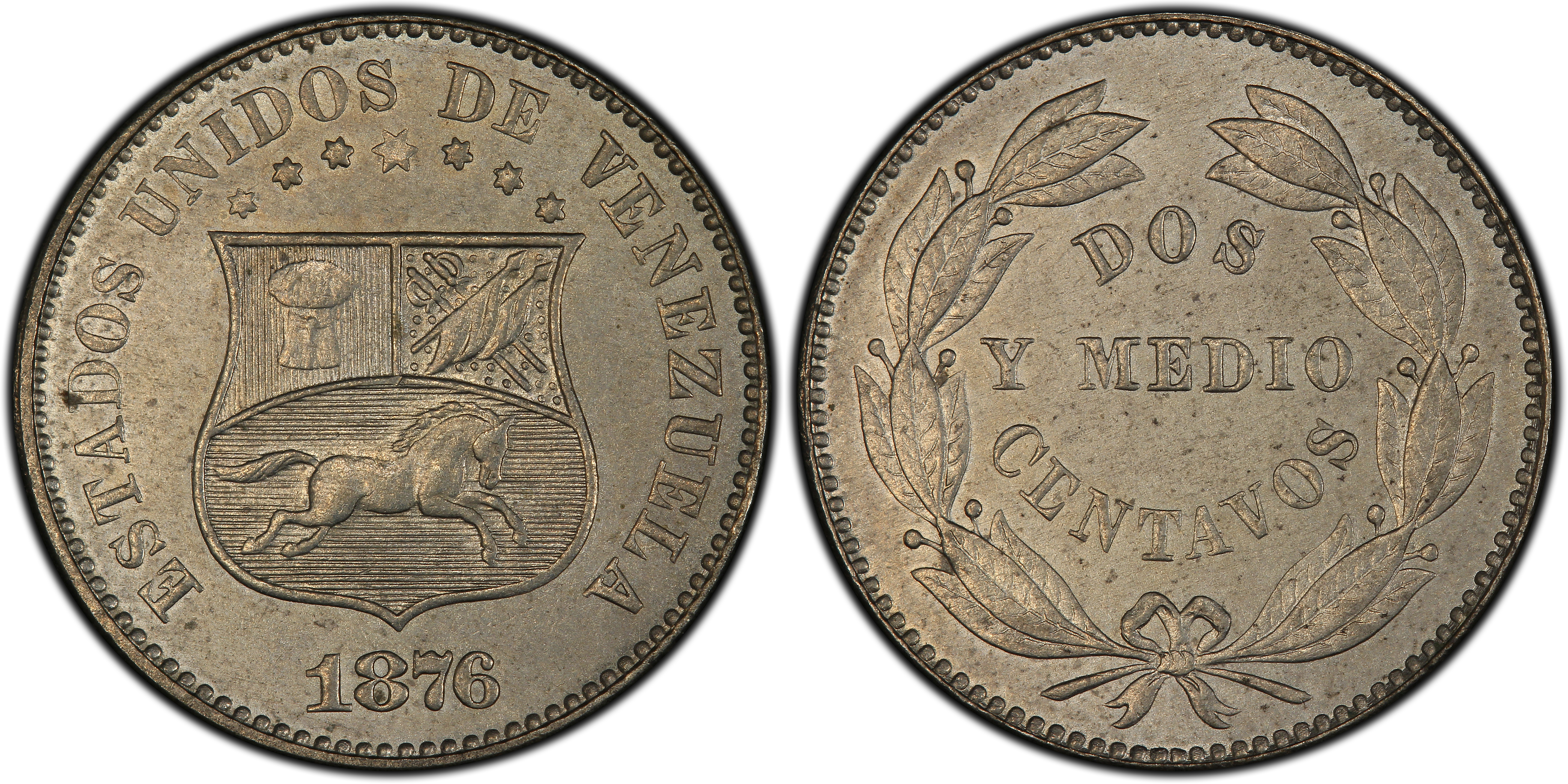
Image courtesy of PCGS.
One of the most interesting coins struck for another nation is the 1944 Belgian 2 Francs. These coins were struck by the Philadelphia Mint on surplus 1943 steel cent blank planchets. 25 million of these coins were struck during the Allied Occupation of Belgium, and are very affordable to obtain; raw coins are readily available for as little as $1. These 2 Francs are to blame for the U.S. 1944 Steel Cent mint errors, as some of these planchets were accidentally fed into machinery which were producing cents instead of 2 Francs.

Image courtesy of PCGS.
One of the most well-known countries which the United States produced coins for is the Philippines. The United States gained control of the Philippines because of the Spanish American war in 1898. Coins were struck by the Philadelphia, Denver, Manila, and San Francisco Mints from 1903 through 1965. The Manila Mint was in operation from 1920-1922 and 1925-1941. The Manila Mint remains as the only U.S. Mint located outside of the continental United States.
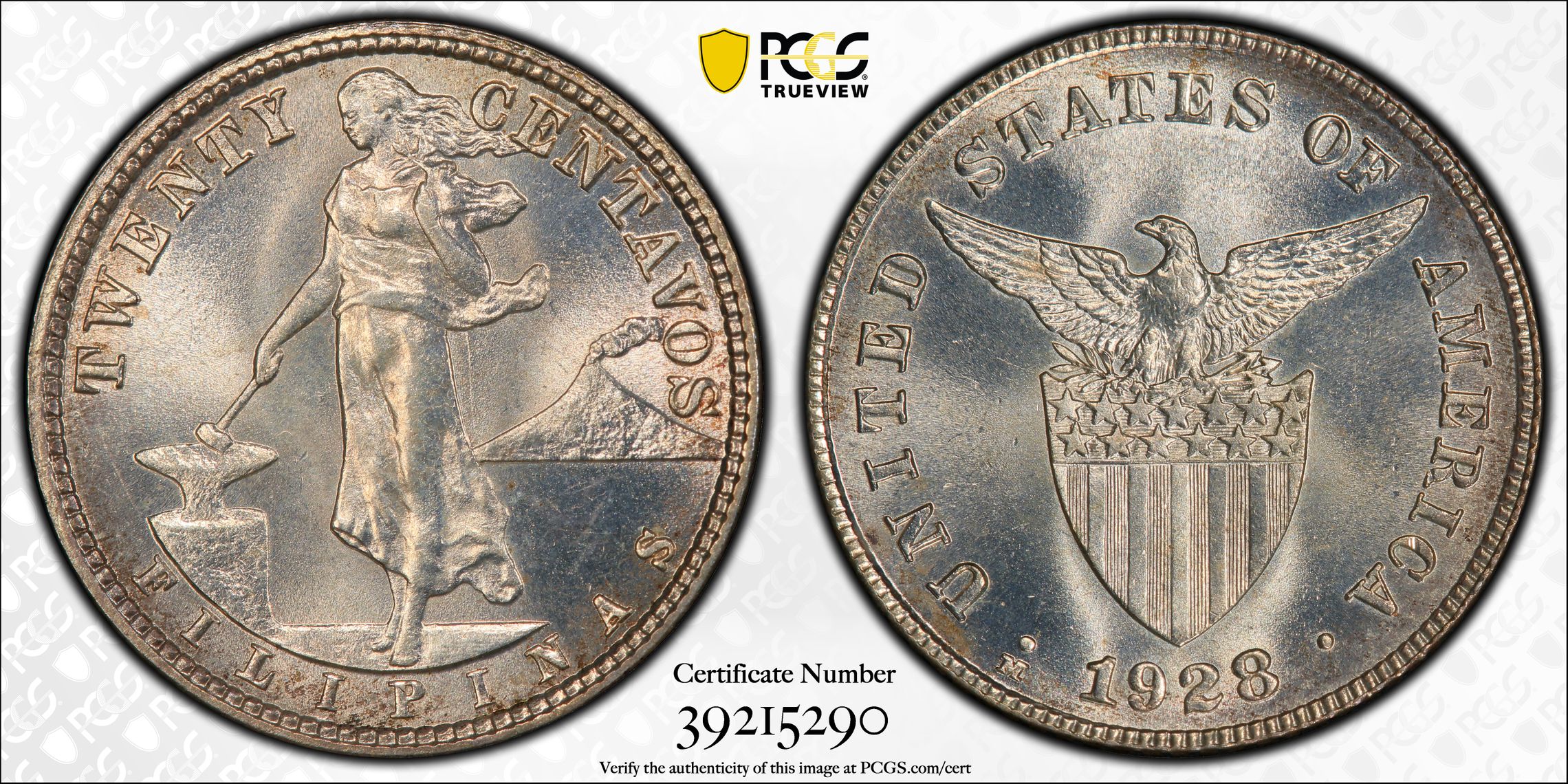
Image courtesy of PCGS.
Another popular series which was struck by the U.S. Mint is the 1883 Hawaiian Coinage series. The San Francisco Mint struck dimes, quarters, half dollars, and dollars for the Kingdom of Hawaii in 1883 and 1884, but all coins bear the 1883 date.
When most people think of the smallest coin struck by the U.S. Mint, they often think of the Type 1 gold dollar, which has a diameter of 12.7mm. But, the smallest coin which the U.S. Mint struck was the 1904 Panama 2 ½ Centesimos which has a diameter of just 10mm. This coin is properly nicknamed the “pill” because of its small size.

Image courtesy of PCGS.
The sole coin struck by the New Orleans Mint for a foreign nation was the Mexican 1907 20 Centavos. Only the coins with the Curved 7 variety were struck at the New Orleans Mint. Although they bear the Mexico City mint mark on the obverse, they were indeed struck in New Orleans. Once again, these coins are relatively affordable with certified pieces in low mint state grades available for $50-$100.

Image courtesy of PCGS.
The last coins struck for foreign nations by the U.S. Mint are 1983 Panamanian One Centesimo through the Half Balboa, struck in both 1983 and 1984. Both the Philadelphia and West Point Mints struck these issues. The Mint has not struck any coins for any foreign countries since 1984 and it doesn’t look like they will do so anytime soon.
Many collectors are unaware of just how many different types of coins the U.S. struck for other nations, which offers a unique collecting opportunity that fits in the budgets of all collectors. Many of the modern issues can be obtained for under $1, while many of the earlier coins fetch hundreds or thousands of dollars in high grades.
Sources:
https://www.pcgs.com/news/mexico-coin-made-in-the-new-orleans-mint
https://coins.www.collectors-society.com/wcm/CoinCustomSetView.aspx?s=13492
The following was written by Frank.
The United States has seen its fair number of gold rushes throughout its history. The first gold rush in our nation’s history was sparked in 1799 by a young boy named Conrad Reed in Cabarrus County, North Carolina. While skipping Sunday school, Conrad Reed discovered a 17 pound gold nugget in a creek on his family farm. Gold was not commonly seen in this part of the country, the Reeds had no idea what they had stumbled upon. So, instead of scrapping it or selling it, the Reeds put the nugget to practical use as a doorstop for 3 years. In 1802, the Reeds showed the gold nugget to a local jeweler who knew exactly what it was and bought it for a measly $3.50, which was one-tenth of one percent its true value (roughly $3,500). Talk about getting put through the wringer!
Conrad’s father, John Reed, soon realized that he had made a huge mistake by selling the gold nugget for such a small price. In 1803, John had built a partnership with some other men and began a gold expedition. During their search for gold, a 28 pound gold nugget was discovered by an enslaved boy named Peter. By 1824, the Reed Gold Mine had discovered over $100,000 in gold (over $2,000,000 in today’s dollars). Many other hopeful miners followed suit and were successful in their search for gold.

This massive discovery of gold in North Carolina eventually led to the formation of the Charlotte Mint. The Act of March 3, 1835 established three branch mints, the Charlotte and Dahlonega Mints for the minting of gold coinage and the New Orleans Mint for the minting of silver and gold coins. The construction of the Charlotte Mint began in 1835 and the first coins, 678 half eagles, were struck in March of 1838. The Charlotte Mint operated from 1838 through 1861 and struck coins in the denominations of one dollar, quarter eagle, and half eagle. North Carolina seceded from the Union on April 20, 1861 which geographically placed the Mint in a different nation. Some of the 1861-C half eagles were in fact struck under Confederate authority.
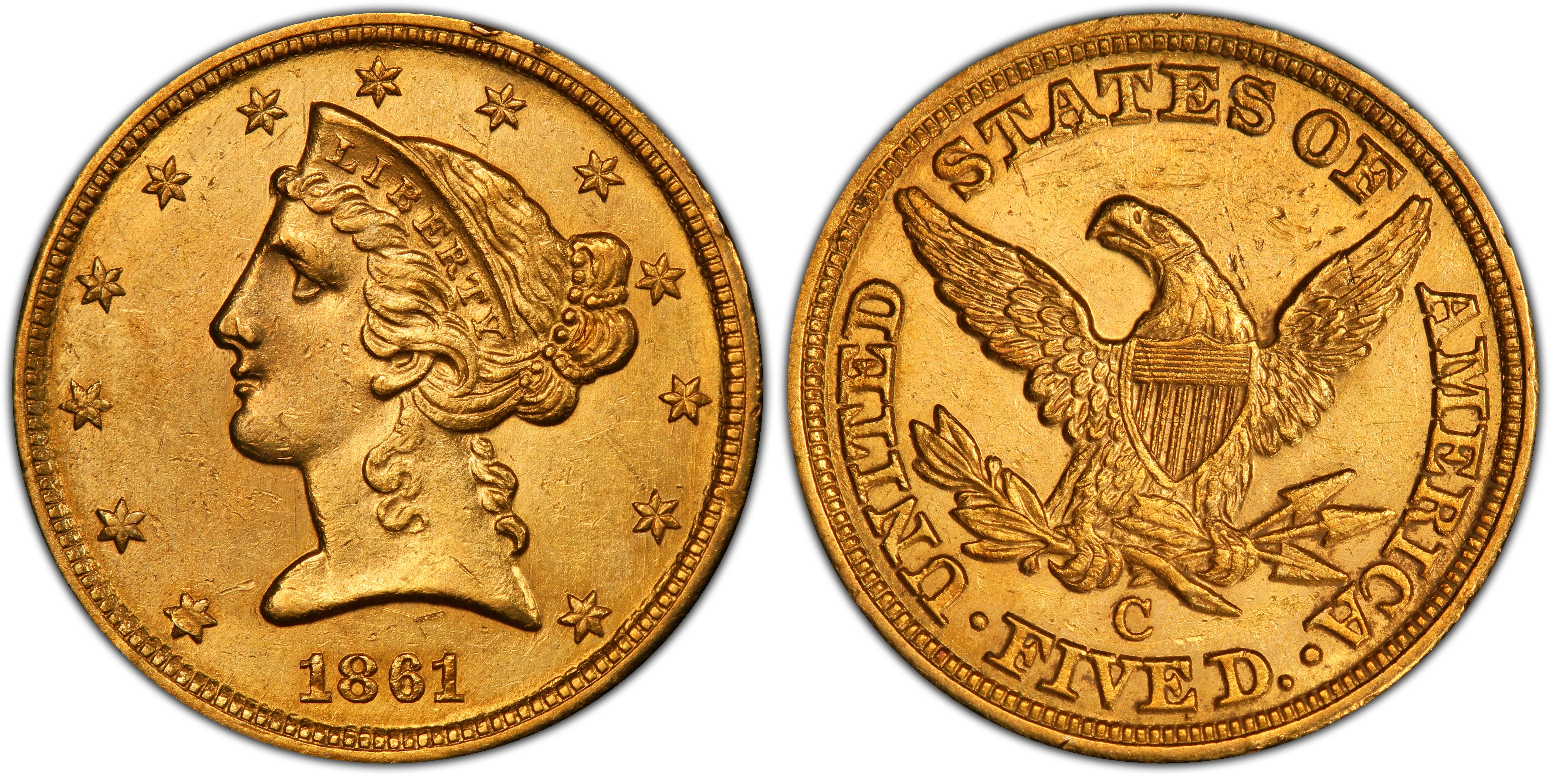
Image courtesy of PCGS
The first person credited with discovering gold in Georgia was Benjamin Parks in 1828, close to where the town of Dahlonega, Georgia would later be established. This discovery of gold sparked an influx of miners in hope of striking it rich. The sudden increase in population quickly turned the Dahlonega area into a boomtown. The town of Dahlonega got its name from the Cherokee word Dalonige which translates to “yellow” or “gold”.
Ten years after the initial discovery of gold in the Dahlonega area, the Mint officially opened its doors in 1838 and began striking coins on April 21, 1838. The first coins struck at the Dahlonega Mint were Classic Head half eagles. The Dahlonega Mint struck coins in the denominations of one dollar, quarter eagle, three dollars, and half eagle from 1838-1861, until the Confederate forces abruptly took over the Mint. There were several 1861-D gold dollars and half eagles that were struck by the Confederates.

Image courtesy of PCGS
Today, all coins that were struck at the Charlotte and Dahlonega Mints are highly sought after by collectors. The most affordable straight-graded coins can be attained for around $2,500. The background stories of the Charlotte and Dahlonega Mints are fascinating and packed with history.
Sources:
https://archive.org/details/charlottemintgold1987wint/page/n11/mode/2up?view=theater&q=reed
https://historicsites.nc.gov/all-sites/reed-gold-mine/history
https://archive.org/details/dahlonegamint2003wint/page/n31/mode/2up?view=theater&q=reed
The following was written by Chris.
We attended the annual FUN show in Orlando earlier this month. For the first time in some years, it was not held the first week of January. It was nice to be able to enjoy the New Year’s holiday with friends and family without having to pack up coins and fly out right away for a coin show. As with last year, it was Tom, Frank, Brian, and I in attendance.
Three of us stayed at the usual condo community which is near the convention center, and a good exercise walking distance to the concourse where the show was. Tom got the Hilton this time, also a very doable walk to the show. The weather was…cold. We checked the forecast before coming down, but it was still a bit of a surprise once we got in. It wasn’t much warmer than Boston!
I flew down early afternoon on Monday, as I had a buying appointment with a wholesale dealer in their hotel room. The rest of the guys flew down later that night. My jetBlue flight was on time. I usually dump on jetBlue for their on-time performance, but I have miraculously had five on-time trips in a row (ten flights!). If you hear a sound, that’s me banging on wood. Unfortunately, Brian, Tom, and Frank were not so lucky with their flight.
The FUN show organizers tried something a little different this year. They hosted a dealer day on Tuesday in one of the convention center rooms. There were no assigned tables, no guaranteed electricity, no show cases, and only two wrist bands for entry were allowed per company. I think perhaps the show was trying to improve safety for the dealers, so that they could do business in a single room with security present, rather than riding around in Ubers doing hotel business. I found this to be impractical, as the trading room didn’t open until 11 am (also, I like proper lights when viewing coins…I don’t know how people can look at coins in the dark). In order to get early shot on coins, I was Ubering to hotels before 8 am, and it stayed that way pretty much the whole day for me. Tom did some buying business in the trading room, while Frank was busy in the convention center hallway buying from his usual guys. Brian was working the whole day selling coins, mostly meeting dealers either in their hotel rooms or their own private rooms at the convention center.
The show itself started Wednesday at 2 pm. Dealers were so anxious to get in that there was an unsafe backlog of people trying to get in the doors as others were pouring down the escalators. Convention staff and even a Sheriff’s deputy were yelling at folks up top to stop piling onto the escalator. It got dicey there for a bit.
As with last year, there was a huge public presence on Thursday. It was pretty incredible. It definitely slowed down on Friday, but I would say overall it was a very well-attended show, both by dealers and the public. If you are located in the Orlando area (or even if not and you have to get on a plane), and you’ve never been to a coin show, perhaps consider next year’s FUN show. It’s easily the second largest show of the year, and is not that far behind the summer ANA show. You will likely be amazed by how big FUN is, and how many coins there are to see.
How was our FUN experience? Overall, a good show. Sales were a little disappointing but still decent. Dealers were certainly willing to look, and the dealers we spoke to said they had a very good show. We did have possibly the best buying show we’ve ever had. When all was said and done, I think we came home with/shipped eight double row boxes of newps. And we saw no softness whatsoever in the market.
Foodwise, there’s nothing too exciting to boast about. Brian and I got Grubhub every night but one at the condo. We did venture one night with a coin dealer friend to a great burger joint within walking distance called Beth’s Burger Bar. If you’re ever in the area, I recommend checking it out (www.bethsburgerbar.com). Beth was even there the night we went in. Frank was able to escape the condo a couple of night to enjoy some nice dinners.
Lastly, I was fortunate enough to be able to reconnect again with some buddies from Florida State, as I stayed until Sunday to have some fun. It’s always a treat when they are able to come down from Tallahassee. My flight home was…on time!
I’m looking forward to the summer FUN show in July. Maybe I’ll see you there!
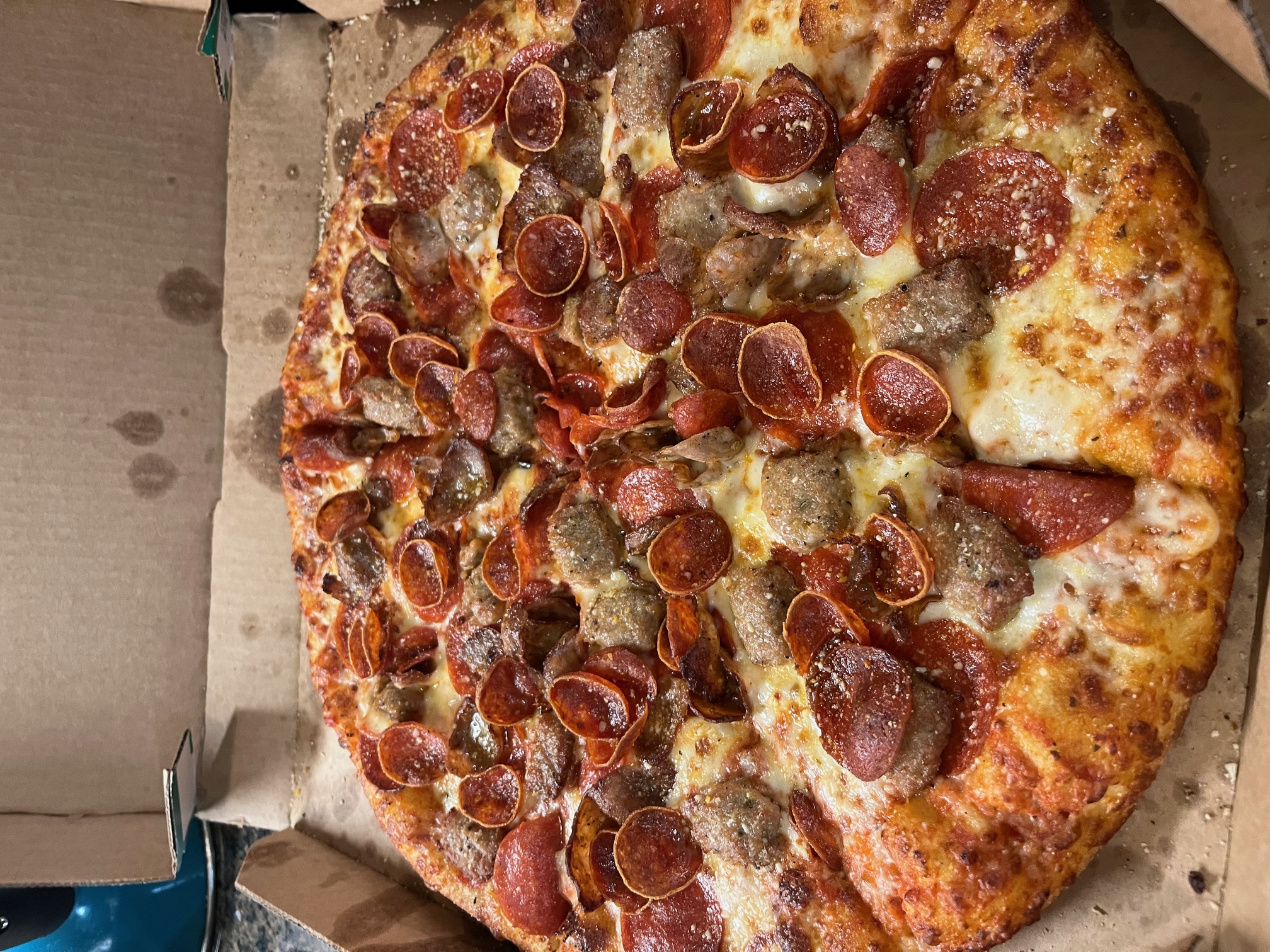
Delivery one night from a pretty darn good joint called NYPD Pizza (www.nypdpizzeria.com).
Yes, this clown is playing with his coins in the bathroom.
The following was posted by Chris.
Many of you have no doubt seen examples of NGC, PCGS, ANACS, etc. holders out there with custom inserts. We thought we'd take the opportunity to share some that we have.
We did this promotional insert when our state quarter came out.
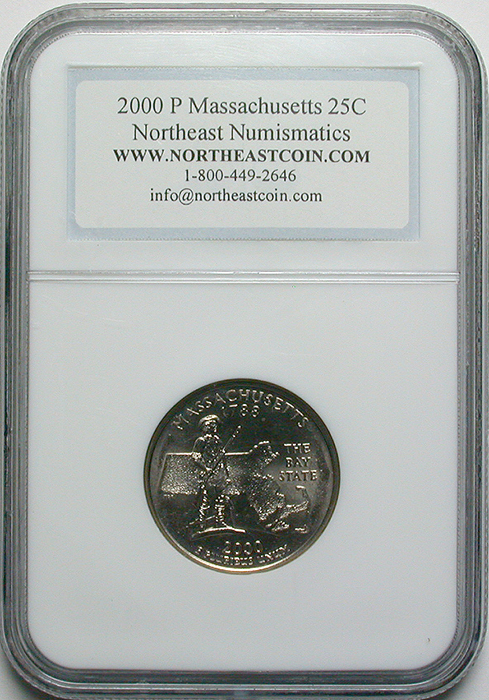
We did this one to commemorate Tom's 50 years in the coin business.

Tom had a custom insert created for his son Russell when he graduated high school. He had both Silver and Gold Eagles holdered. Keep in mind gold was less than $500/oz back then. Had he graduated today, not sure how many (if any) Gold Eagles would have been used!

This one I picked up many years ago. I was attending a coin show in Baltimore and was fortunate enough to be invited on a bus ride down to the Smithsonian to view part of the National Numismatic Collection. NGC had these holders done as a commemoration of an exhibit opening.
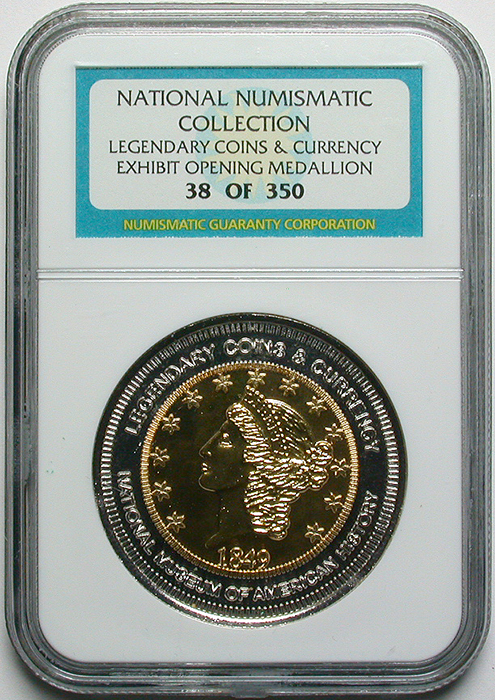
And lastly, this piece I received from a good friend, who happened to be my very first friend in the coin business, going all the way back to 1996! It commemorated his wedding.

Do you have any custom holders in your collection. If so, we'd love to see them! Please email them to chris@northeastcoin.com and I'll get them posted.
Our apologies for the lack of blog posts lately! We've let personal and business travel get in the way. The following was written by Frank.
My numismatic journey started in elementary school. I remember distinctively when I was 7 or 8, my father came home from work with a 1961 Washington silver quarter that he had found in his pocket change. He pulled it out of his pocket and showed it to me, explaining the significance of the coin; the coin was made of 90% silver, giving it a value of a few dollars. I was fascinated; it never occurred to me that a coin could be worth more than its face value. My dad gave me the coin, which remains the pinnacle of my personal collection to this day.


My dad must’ve seen how interested I was in the one coin he gave me, so he pulled out his coin collection from his teenage years. My dad explained to me that most of the coins in his collection were found in circulation. Like many families, we have a large container of loose change that accumulates over time. I went through the entirety of it, finding a few Lincoln wheat cents, including one from 1912, a coin nearly 100 years old at the time. Searching through change seemed to be the most cost effective way for me to add coins to my collection at such a young age.
I soon began begging my parents to take me to local banks to buy rolls of coins to go through. My order regularly consisted of $50 of pennies and $100 of nickels every other week; I always seemed to find at least one Buffalo nickel, or a silver war nickel in every $100 of nickels that I went through. Along with searching through rolls of coins, I started metal detecting. I received a Whites Coinmaster Pro on my birthday in elementary school and began digging up our property. My very first silver coin found metal detecting was an 1875-S Seated Liberty Dime found on our property. My mom and dad would also take me to a local coin shop on my birthday and give me $50 to spend on new coins for my collection. At some point, I received a Red Book, which I studied intensely, memorizing the key dates of different series.


My mom and dad also took me to many local coin shows. My favorite show of the year was located in Westford, MA right before Christmas. This show was super special because there was a dealer (Northeast Numismatics) who ran a great promotion, all children received a free handful of coins. I went to this show with my brother and friend, who also got a free handful of coins. When we all got home, we began researching and trading the coins with each other.
The 1961 Washington quarter that my dad gifted to me impacted my life on so many levels. It introduced me to the great hobby of numismatics and surely changed my career trajectory, which has led to many great relationships.
Very inspiring!
The following was written by Chris.
The annual ANA World’s Fair of Money was held last week in Rosemont, Illinois. In attendance from Northeast was Frank, Brian, Russell (Tom’s son who sometimes works shows with us), and me. Tom was unable to make the trip, the first ANA he missed after 52 straight years! See his blog post from earlier this month to learn why.
We flew to O’Hare Sunday evening. Our flight was delayed by two hours, though I think weather had something to do with it. For once it was not JetBlue’s fault! Business for us started Monday morning at Dealer Day. I got an early shot looking at coins at a few of my regular wholesalers. Sadly, I didn’t get to look as early as I would have liked, since apparently some dealers flew in Saturday to do business on Sunday. These shows just keep getting longer and longer!
We were all very busy at the show. One long-time coin friend of mine was just across the aisle from me, and I didn’t realize this until three days in to the show! She said I had my head down pretty much the entire time, and she was right. If I wasn’t looking through boxes to buy coins, I was pricing out coins that other dealers had pulled from our inventory.
Brian tried a somewhat different approach to sales at this show, and it seemed to pay off. We had a pretty strong selling show, which is great. Buying was just so-so. Frank and I each bought around two and a half double row boxes of coins. For large shows like this, I usually buy closer to four boxes. We still managed to come home with some cool coins.
Most of our meals were at Gibson’s restaurant, which is a very nice steak place. It’s right across the street from the convention center, so we did takeout from there. We often skip lunch at shows, so it was a nice treat to be able to eat every day!
Brian flew home a day early for family obligations. I stayed until around noon on Saturday, and Frank and Russell wrapped up the show and flew home Saturday night. My flight home was ON TIME. Of course, I was flying Delta for the return trip, so that’s why the plane left when it was supposed to.
For fun on Friday night, Russell, Frank, and I went bowling. We had a great time. I got my @ss handed to me every single game by both Russell and Frank. I’ll get em back next year!
I only got 5 coins (including 4x brand new 25c from the US-Mint vending machine)
And a fine time was had by all.
The following was written by Tom.
We have been busy in the office in recent days getting ready for this important annual convention. Preparing inventory, making arrangements to meet with clients looking to buy or sell, contacting dealers to view inventory early in the show as well as making arrangements for social engagements in the evenings. Never to be missed it has been 52 straight years that i personally have attended. Fresh out of business college in 1972 I still recall the New Orleans show, Boston the following year, & in the subsequent years to Los Angeles, Seattle, New York City & elsewhere around the country.
This year Northeast will be well represented with Chris Clements, Brian Alty, Frank Sawin, & Russell Caldwell in attendance. I however will be taking a break. I am preparing to have open heart surgery soon & air travel has been advised against by my doctors. Yes, the show camaraderie will be missed but Chris, Brian, Frank & Russell will be there to serve you. If you are at the show hope you stop by table 604 /606 to visit. You can also contact me anytime at tom@northeastcoin.com
Tom, what annual convention, and wishing you all the best as you face open heart surgery.
The ANA World's Fair of Money. And thank you for the well wishes, David!
Wishing you the best Tom. Godspeed.
Thanks very much, Dave!
Wishing you nothing but a positive outcome and better health. Here's to a speedy recovery. Remember that every day of post operative recovery is one more day of getting better.
Thanks so much!
The following was written by Helen (Chris' daughter). She is off to Elon University in the fall.
There are two questions a child is typically asked by an adult. The first is “what do your parents do?” I always loved watching adults' faces grow in confusion, and surprise, that a young child just used a big word like numismatist, a word that they didn’t even know. I would then go on to brag about how cool and unique of a job it is and how smart my daddy is. The second question would always be “what do you want to do when you grow up?” Now this question was always answered with a little more hesitation than the first; I look back now as a senior in high school bound for college and realize just how much influence my dad has had on the answer to this question.
Let’s begin by pondering what it is about being a numismatist that singles them out as a very special breed of people. Having grown up with one as my dad, I feel like I can bring an interesting approach to this discussion. For starters, if you are a numismatist you have to be very dedicated to the job. My dad is usually home at 7:00pm, but if I don’t see him, I never need to ask to know that he is still at the office working with coins. Secondly, they’re geeks. And I mean this in the kindest way possible! When my dad gets home from work, I always ask him how his day was and he tends to respond lengthily about either the goings on at the office or about a particularly exciting coin he either bought or sold. He loves to tell me all about the different coins he saw that day or the coins in his own personal collection. In fact, when I was a kid, he used to bring coins home from the large treasure box of mostly worthless but cool coins that they keep in their conference room for kids to grab for free. Thanks to this, at the age of ten I had a very impressive bag of collectables. Despite all his efforts, I never really got into numismatics, although I definitely developed an appreciation for it as I grew up hearing him geek out over his many findings.
The other thing to remember about numismatists is that they travel a lot, so they begin to develop professional critiquing skills about various airlines. I’m sure y’all have seen or heard the rants my dad has gone on about JetBlue’s inability to function properly. Now, imagine that Every Single Time he flies. And yet he still never switches airlines. In other words, along with being professional travel critics, numismatists are very loyal. Although I suppose I can’t complain too much since most of his traveling would lead to me getting a little something from either the airport or state he visited. I remember he brought home a stuffed alligator from a Florida coin show that I absolutely loved and still have today!
And finally, perhaps the most important thing to know about many numismatists (particularly my dad), is the work ethic many embody. One of my most prominent childhood memories is that of school snow days spent at his office and how this experience influenced me in two major ways. First, because of those days, it became very obvious to me how much my dad loves his job. I would be watching Dora on my iPad and look up to see him completely transfixed on his coins. The bright blinding light, the small magnifying glass, and box of coins nearby. That was the happiest I’d ever seen him next to when he is at home with me and my mom. Second, as I grew older snow days became a reason to put me to work when I came into the office. I would be set to filing grading submissions and invoices for Northeast. This was actually my first paying job. At first, I didn’t entirely understand why he was having me do this but I soon learned that this was to teach me about work ethic. He had spent so many late nights at the office processing coins and doing other numismatic things, and filing seemed like a way for him to teach me why.
Now, going into college, I can finally answer the question of what I want to do when I grow up. The simple answer is, I want to be an elementary school teacher. The long answer is that I want to do something that will make me happy and excited, something that makes me want to put my now strong, work ethic to use. With a major in elementary ed, I’m hoping that I will end up doing something that is as important to me as being a numismatist is to my dad.
A very heartwarming story, surely to make dad proud! good luck at Elon!
Thank you, Dave!
helen this was just lovely. being married to a girl whose dad is a numismatist too (!) it almost brought a tear to my eye.
rachel has always been full of nostalgic stories about working at trade shows and all the characters she met there. It's such a meaningful world for the families that are involved in it ❤️
Thanks for reading, Chris!
The following was written by Mike.
Depending on the quantity of coins you want to sell/trade, packing them up to ship can be a conundrum. For customers looking to upgrade their collection, often that process involves trading a lesser graded piece for a higher one. In doing so, you need to safely send in your coins to us for evaluation.
“I’ve never sent coins in the mail before. How do I go about it?” I’m glad you asked! When sending a single coin, I recommend using a simple padded envelope along with a cardboard coin protector. This same process is suitable for up to approximately 10 coins with varying sized padded envelopes.

Once your coin(s) are securely packaged, seal it up with tape. Be sure to include your contact info inside the box in case the return address gets mangled beyond recognition by the USPS.
When bringing the package to the post office to get postage for your coin(s), the following steps are highly recommended:
- Send your package with “Signature Required.” All packages we ship require a signature if the value is over $300.00. This will help ensure that your package is not left to the wolves.
- Insure your package! Until it reaches us, you are responsible for the package while in transit. This would also apply on the off chance you need to return a coin you bought from us.
So, you say you have over ten coins to ship? The more the merrier! Let’s go over how we would pack these up, as there is a little more to it than in the previous scenario. When shipping a large number of coins, the most important thing to consider is the safety of the coins themselves. With that many in one package, the likely shipping vessel will be a box which introduces a whole other level of risk. First, if not packaged correctly, they will rattle against each other, possibly damaging the coins or holders. Second, while en route people might get curious as to what is inside the package, running the risk of theft.

This is how we would recommend packing the coins to prevent rattling inside the box. While the average home collector may not have the same packing material that we have access to, the easiest way to prevent rattling is to simply use a rubber band! Band together 4-5 coins along the width and length; this strategy will stop them from rattling around when packed together in a box.
When we receive packages that are of the larger size, we love to see them packed a certain way. It’s important to remember that when paying for postage and insurance, (large value sale/trade), the following instructions can prevent considerable loss of value if anything happens in transit.

The secret to secure, safe packing is to pack your coins in a smaller box, placing that box into a larger box. There are a few reasons why this strategy is effective:
- When we pay for postage and insurance on the package, our private insurance company requires this. If they have this requirement, it makes sense to follow it even when using USPS insurance.
- If the outside package is damaged in transit, the USPS cannot see the contents inside the smaller package, adding a level of security.
- The double layer of packaging provides additional protection. When placing a small box into a larger box, a significant void space is created. To fill this space, we recommend either bubble wrap or packing paper. Newspaper also works well or anything that will snugly fill the void without adding too much weight. One thing we ask is…no dirty laundry (this has happened before)!
Finally, if you ever have questions regarding the shipping process, feel free to reach out to me anytime at mike@northeastcoin.com. I try to respond as quickly as possible and look forward to helping in any way. I draw the line at flying out and packing everything up for you, unless you pay me. Kidding. Or am I?
Important addendum. You should address the package as follows. Be sure you leave the word Numismatics out of our company name.
Northeast
Attn: Name (You can leave this line out if you're not sending the package to a specific person.)
100 Main Street, Ste. 330
Concord, MA 01742
The following was written by Frank.
Coins have been counterfeited since the days of the Roman Empire and counterfeiters continue to deceive the average everyday consumer and the astute numismatist alike to this day. The U.S. Secret Service estimates that there is $147 million in counterfeit U.S. currency in global circulation. After thousands of years, it is clear that the issue of counterfeiting is here to stay, even though there are high-tech security measures in today’s paper currency. Similarly, counterfeiters have been counterfeiting rare coins with intentions to deceive collectors and dealers. In this blog post, we will be focusing on two of the most common counterfeit coins, the 1909-S VDB Lincoln Cent and the 1916-D Mercury Dime.
The 1909-S VDB Lincoln Cent is one of the most popular coins of the twentieth century. In high uncirculated grades, this coin can be worth many thousands of dollars. It’s no surprise that counterfeiters would want to counterfeit such a popular and valuable coin. Many counterfeit pieces are either genuine 1909 VDB or 1909-S cents with alterations; either the S is added to where the mintmark should be, or the designer’s initials, VDB, are added to where they should be on the reverse. One way to differentiate a genuine example is by the examination of the mintmark and the VDB. There are only 4 mintmark positions on genuine 1909 S VDB cents, so it must match one of the 4 pictured below.
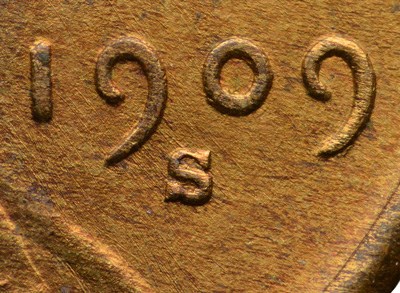


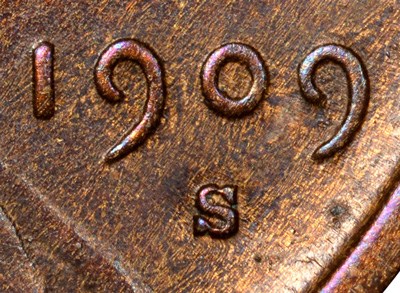
Images courtesy of NGC.
Pictured below are the differences between genuine and counterfeit designer initials. The first one is a counterfeit, the second is genuine.
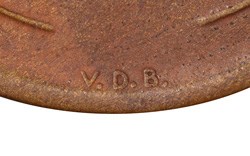

Images courtesy of NGC.
Another popular key date that is often counterfeited is the 1916-D Mercury Dime. Similar to the 1909-S VDB cent, a genuine 1916-D Mercury Dime can be worth many thousands of dollars; counterfeiters focus on popular key date coins. Many counterfeit 1916-D Mercury Dimes are either genuine 1916 Philadelphia or San Francisco issues, but with either an added or altered mintmark. There are 4 known reverse dies that struck 1916-D Mercury Dimes. Interestingly enough, all genuine 1916-D Mercury Dimes have a slightly rotated die. The mintmark on genuine examples also has a triangular shape inside the mintmark.

Image courtesy of CoinHelpU.
One of the best ways of detecting counterfeit coins is by handling lots of coins and having sufficient tools. Once you get an understanding of what genuine examples of rare coins look like, you’ll be able to say to yourself “That doesn’t look right.” when encountering counterfeits. It is oftentimes hard to describe why you believe a coin to be counterfeit, but after a while you will certainly get an eye for counterfeit detection. Because of such minute details, a 10 power jewelers loupe is recommended for counterfeit detection.
This article was merely a brush over on the topic of counterfeit coins and can be delved into much deeper. Because counterfeit rare coins are an everlasting threat to the hobby and will only get better, we stress the importance of buying rare coins authenticated and graded by dependable third-party grading services. An emerging threat to the hobby are counterfeit slabs. This will be the topic of the next edition of Frankly Speaking that will be released shortly. Stay tuned!
Sources:
https://coinauctionshelp.com/1916-dmercurydimeID.html
https://www.ngccoin.com/news/article/5217/Counterfeit-1909-S-VDB-Lincoln-Cents/
The following was written by Chris.
Question for you. If you were traveling somewhere in your car with your coin collection, would you stop for food along the way and leave your collection (or any valuables for that matter) in the car? The answer should be “Of course not!” It is mind boggling to me the number of dealers whose vehicles are being burglarized on their way home from coin shows. While we of course feel for these folks, this is a 100% completely avoidable situation!
The Numismatic Crime Information Center (NCIC) is a non-profit organization that assists law enforcement agencies in their investigations of numismatic crimes. (For more information on NCIC, visit Numismaticcrimes.org.) They regularly put out email alerts about such crimes. These days, there are way too many alerts about vehicle burglaries. Take a look below for some recent examples.
May 2024
The owner of xxxxxx traveling home from the Central States Numismatic Society coin show was the victim of a vehicle burglary in Des Plaines, IL. The victim stopped at a restaurant and while inside suspects broke out the window to his vehicle and removed several bags containing a large inventory of currency.
April 2024
A dealer returning home from the recent Statesville, NC show stopped to eat and while inside the restaurant unknown suspect/suspects smashed the window of his vehicle and stole a portion of his inventory.
April 2024 (Yep, two in a month.)
A dealer heading home after the Albany Georgia coin show stopped to eat and while inside witnesses observed two male suspects smash the passenger window and remove coins from the vehicle. The suspects left in a grey Mitsubishi Eclipse.
February 2024 (While the circumstances are a bit different, the story is the same. Vehicle left unattended with coins inside.)
A dealer returning home from the recent Baltimore Stamp & Coin Show held on February 10, 2024 in Timonium, MD was the victim of a vehicle burglary. The dealer pulled into his driveway and went into the house for several minutes and when he returned to his vehicle unknown suspect/suspects entered his vehicle and removed a large tub containing his show inventory
October 2023
A dealer was the victim of a vehicle burglary after attending the recent Tuckwila, WA coin show. The dealer stopped for a short period of time and unknown suspect/suspects entered her vehicle and removed a large amount of foreign coin inventory.
It seems like basic common sense to never leave your valuables unattended in a vehicle, yet it keeps happening over and over. It might be the “well, it’ll never happen to me” approach that some people tend to take. I’ve got bad news for you…it probably will at some point if your routine when leaving a coin show is to stop for food.
As an aside, the scary thing is that we of course only hear about the times when someone does actually stop and has their vehicle burglarized. Think about all the times when someone is followed home or to their office and the would-be thieves don’t get the opportunity to do their thing and thus drive off. To collectors and dealers alike, BE ALERT when traveling with your collection/inventory.
Here's a new one from 6/5/24. Ridiculous.
On May 25, 2024, a dealer, traveling home from a show in Crown Point, Indiana was the victim of a brazen theft that occurred in Crete, Il. The victim stopped to eat and while in the restaurant, two suspect vehicles pulled up on both sides of the victims vehicle. The suspects then broke the victim’s van window and grabbed totes with the victims inventory. The incident was captured by the restaurant parking lot video and took less than one minute. The suspect vehicles were described as a blue Odyssey and a blue Dodge Caravan.
But wait, there's more. From 6/6/24.
A dealer attending the Salem-Roanoke coin show in Salem, VA was the victim of a vehicle burglary after leaving the show for the evening on 6/1/24 and stopped at a restaurant to eat. The victim went inside the restaurant and when he returned to his vehicle unknown suspects had broken out the rear window and removed his inventory. The victim had taken his coins out of the show cases to take back to the hotel instead of leaving them at the show. No suspect or vehicle information is available at this time.
Same thing happened here in Canada, the dealer lost his inventory and never do the show anymore, sad!
https://canadiancoinnews.com/dealer-loses-an-estimated-500k-in-post-show-theft/
Sorry for the delayed reply, Panda. We had some a technical glitch in our blog software. Terrible story about this Canadian dealer and his family! : (
The ANA National Money Show (the Midwinter Show) is this week in Colorado Springs. We decided not to attend, partly because it's a bit of a pain to get to, and mainly because the Whitman Coin Expo is next week in Baltimore. Boy, are we glad we didn't go.

To those of you who are attending, button up and be careful!
The following was written by Frank.
Overstruck coins offer great value to collectors, as each coin offers an historically significant story. There are various reasons why a coin might be overstruck, including a country’s economic issues, mint errors, and private overstrikes.
One of the most popular and affordable examples of an overstruck coin is the Brazilian 960 Reis. In 1810, Brazil was still under Portuguese colonial rule. At the time, a Spanish 8 Reales coin was valued at 750 Brazilian Reis. The Portuguese government decided to overstrike 8 Reales and denominate them at 960 Reis, this was to discourage mass exportation of coins to other nations. Also, the government profited greatly from doing so, nearly 30% after revaluing these coins. From 1810-1827, an estimated figure of 22.5 million 960 Reis were overstruck. The overwhelming majority of these 960 Reis coins are overstruck on Spanish 8 Reales, but there are some other undertype coins that have been discovered over the years including U.S. Bust Dollars, a single 1696 British Crown, Bank of England 1804 Dollars, Indian Madras 2 Rupees, Austrian Mother Teresa Thalers, Netherlands Silver Ducats, and many more unique undertypes. Many of the undertype coins were sourced from visitors of Brazil, which is why there is a great variety of undertypes. Common and circulated 960 Reis coins overstruck on Spanish 8 Reales are very affordable, they can easily be purchased for a couple hundred dollars. In comparison, a regular non-overstruck Spanish 8 Reales are available for $150-$200, very little premium if any at all for an overstruck 960 Reis. Talk about a coin packed with value!

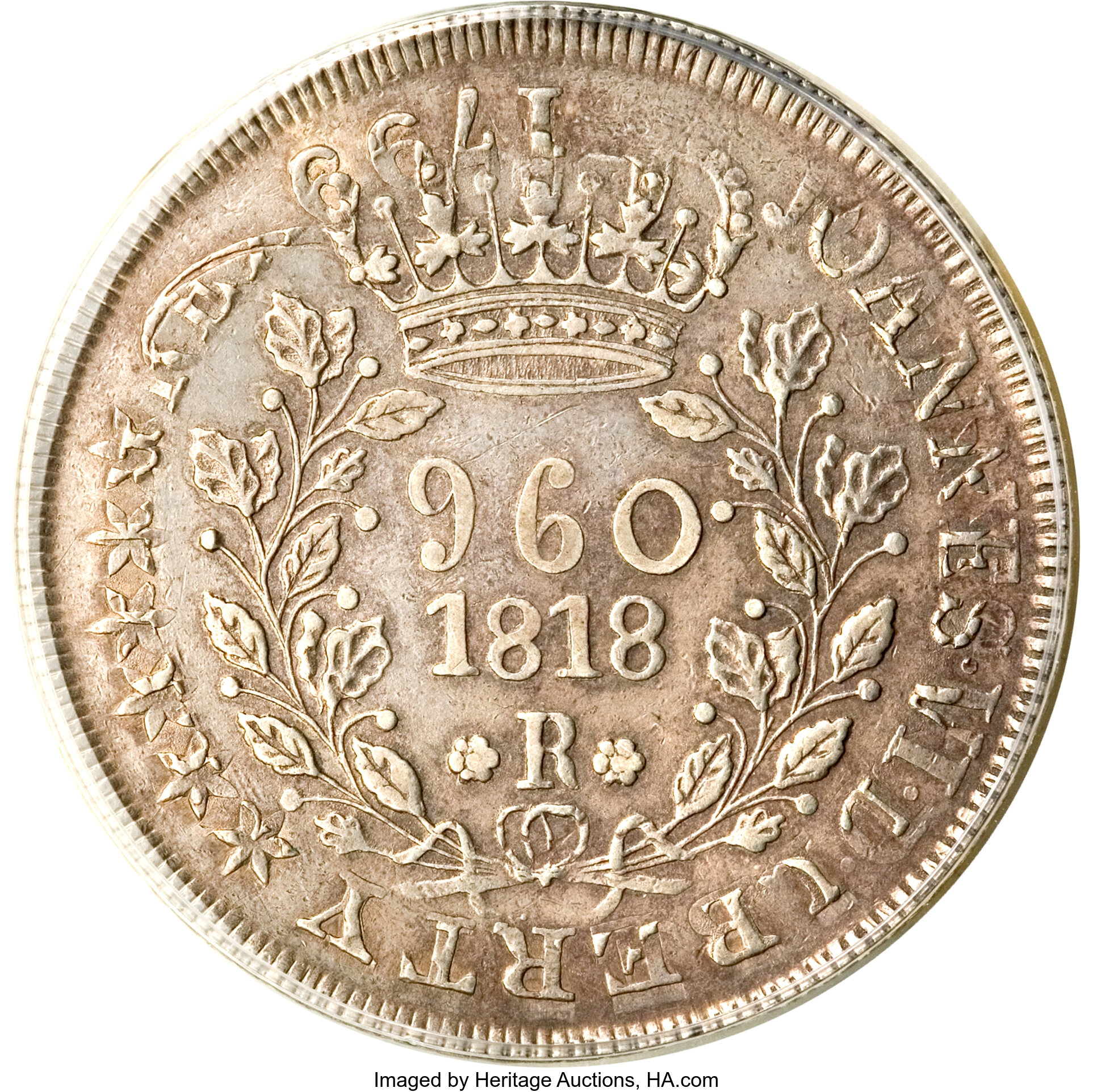
1818 960 Reis overstruck on a 1799 U.S. Bust Dollar. Much of the overstruck Bust Dollar’s design is still visible, including the date, “Liberty”, and the eagle’s talons. Images courtesy of Heritage Auctions.
There are many fabulous overstruck coins that have been discovered; some of them will leave you scratching your head, including a proof 1970-S Washington Quarter struck over an 1898 $5 Liberty, which sold for $93,000 in January 2023. This is likely not a mint error because of the strict quality control of the U.S. Mint, especially when producing proof coins. This must have been the clever work of a Mint employee who thought it would be neat to “make” a nearly impossible mint error. Interestingly enough, there is also a proof 1970-S Washington Quarter overstruck on a Canadian King George V silver quarter, which sold for $7,800 in August 2020. Again, this was likely not a legitimate mint error, but a Mint employee having fun.


1970-S Proof Washington Quarter overstruck on an 1898 $5 Liberty. Images courtesy of Heritage Auctions.
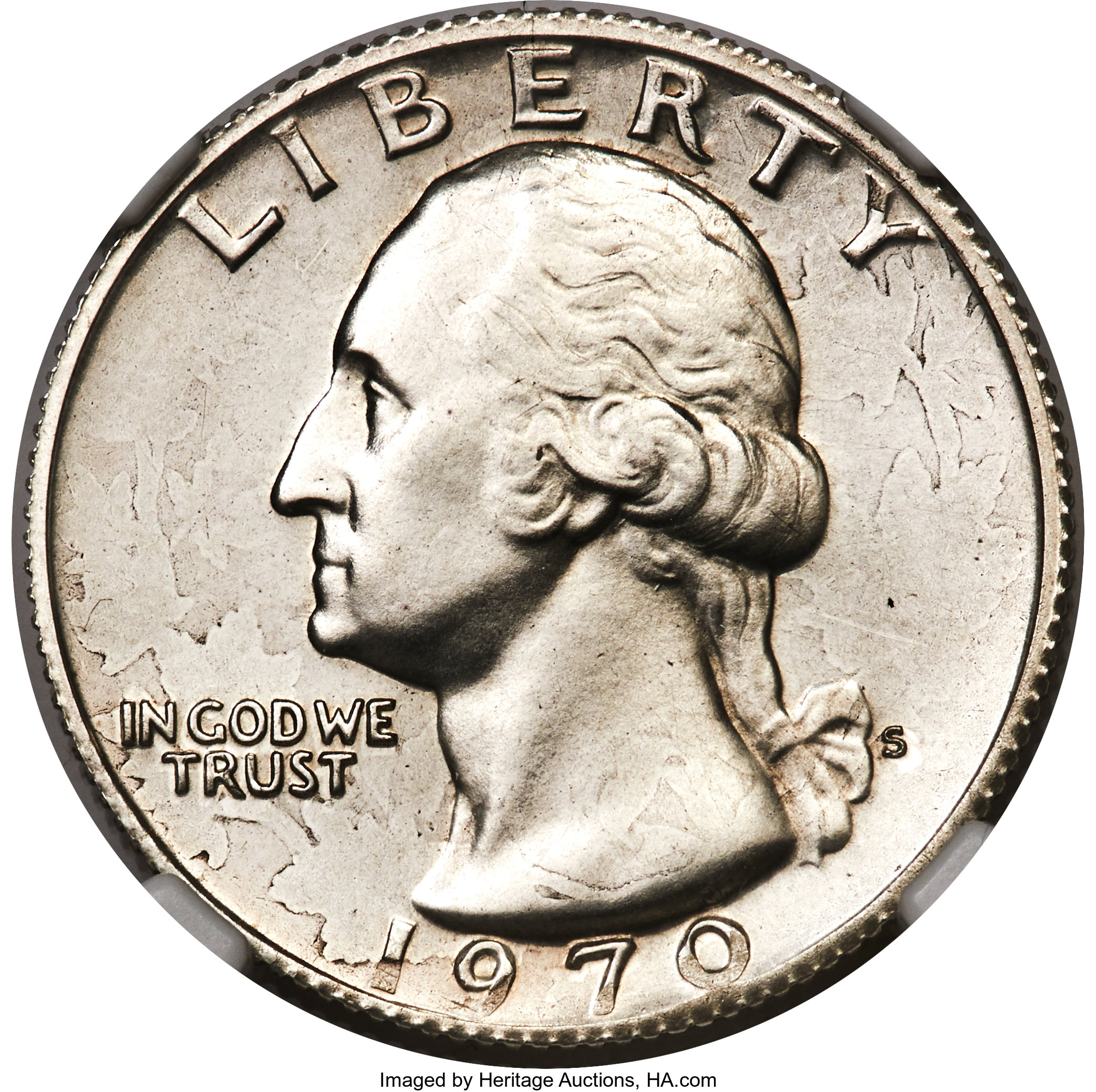
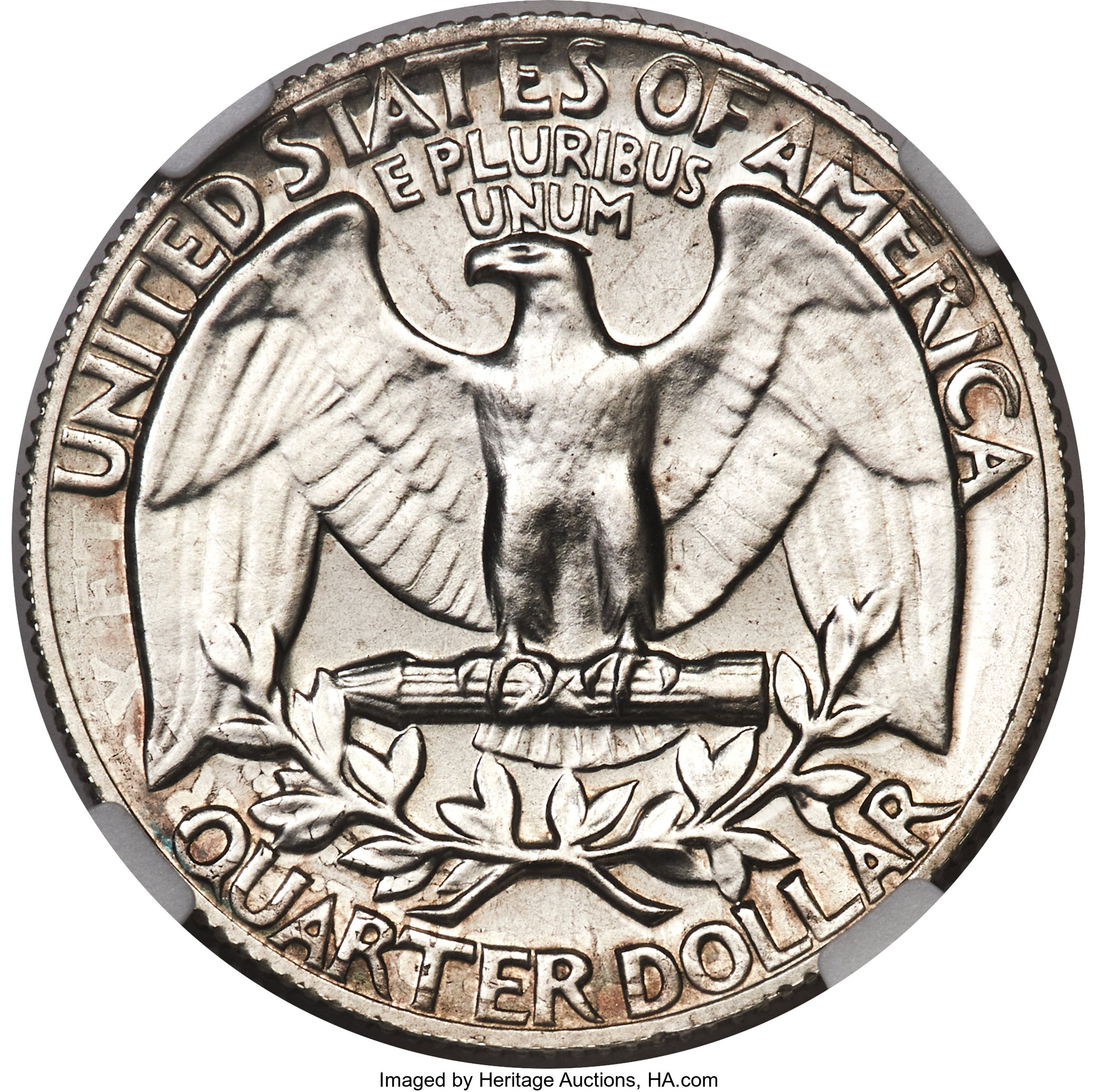
1970-S Proof Washington Quarter overstruck on a Canadian King George V Quarter. Images courtesy of Heritage Auctions.
One of the most interesting private overstrikes is the 1861 Confederate Half Dollar Restrike of 1879. Around 1879, coin dealer Ebenezer Locke Mason Jr. purchased an original 1861 Confederate Half Dollar and the reverse die from Confederate Chief Coiner Dr. B. F. Taylor. Mason then sold both pieces to J.W. Scott, who struck roughly 500 restrikes of the 1861 Confederate Half Dollar. To produce these restrikes, Scott purchased around 500 1861 dated half dollars, planed down the reverses of each coin, and struck the reverse with the Confederate reverse die. This is quite a unique overstrike example, as only half of the coin was overstruck!


1861 Confederate Half Dollar Restrike. Images courtesy of Heritage Auctions.
The following was written by Chris.
The annual Florida United Numismatists convention (the FUN show) was held the first week of January. Tom, Brian, Frank, and I attended. We began our travels to Orlando on New Year’s Day. Flying on the holiday definitely took a little fun out of FUN (fortunately, the next three January conventions will be held the second week of January). Our JetBlue flight was delayed as usual. And as is now custom with that airline these days, no explanation or apology was given. I guess they assume their regular passengers understand that the flights will usually be delayed.
Tom stayed at a Hyatt, as he typically prefers to do for this show. Frank, Brian, and I stayed in our usual location, which was an Airbnb condo in a gated community near the convention center. For the amenities available, it’s tough to beat the price. And with the show being held in the North concourse of the convention center this time, it was an easy 15-minute walk to the show.
It’s impossible for us dealers to start doing business at a coin show on the actual day of the show. There is always pre-show trading going on. If coin show coordinators stretched a show out from five to 15 days long, I can guarantee people will still show up one to two days early to do biz. This show was no exception. I Ubered around to various hotels to meet with wholesale dealers. From a security standpoint, this is far from ideal. Fortunately for me, I never carry inventory on me. Dealers will hold my purchases and deliver them once the show opens.
I went on this trip hoping to be very selective in my buying. I made a concerted effort not to buy anything we already had in inventory, pretty much regardless of price. I got a very early shot with one of my favorite wholesalers and was able to pick up a nice selection of interesting coins (the 1799 $10 PCGS XF45 OGH we have/had on our homepage is one of them). Six Uber rides later to different hotels, I was done for the day. Brian and Tom had success showing our inventory to a couple of dealers that day. Tom also played the Uber game and did some buying. Unfortunately, Frank hit a wall Monday night when we got in, and by Tuesday morning he was quite sick. He stayed in his room at the Airbnb all day. Brian was the ultimate caretaker, and heated up some chicken noodle soup and crackers and delivered a tray to Frank’s room that evening. We were all being quite cautious, as no one else wanted to get sick. Fortunately, Frank was consistently testing negative for COVID.
Wednesday started with more pre-show buying, and one more trip to a hotel to look at some new inventory that had just come in. The show kicked off at 2 pm. I went straight to our table to start setting up. I had barely had time to get the power strip plugged in when someone came over to the table to show me coins. I got my halogen out, took a seat, and was pretty much in that same position looking at coins until close to 7 pm. The other fellas were equally busy.
The show opened to table holders and early bird dealers at 8:30 on Thursday morning. Frank was feeling significantly better, so after yet another negative VID test, he masked up and we all started work right away. Other than a bathroom break or two, I did not leave the table and spent the whole day looking at coins. A lot of YN dealers that Frank knows came to the table to do business with him. Tom was venturing out on the bourse floor looking at coins. And Brian was out on the floor showing our coins to as many dealers as possible. We wrapped up the day at closing time, which was 7 pm. While not big law firm hours, it was definitely a long day.
Friday we checked out of the Airbnb and allowed ourselves a late start to the day, getting to the show around 10 am. Business continued as usual for all four of us, though I was calling it quits early. My wife had flown in from Boston the night before, and we were planning on seeing friends for the weekend. I typically do any necessary shipping from the show. I’m fussy about it, so I feel more comfortable doing it myself (and I think everyone else prefers that I do it, which is understandable since it’s a pain in the @ss). I ended up shipping five large FedEx boxes back from the show.
The day ended for me around 2 pm. I met my wife outside the convention center, and we left to start our mini-vacation for the weekend. Brian and Frank left for the airport a couple of hours later. Tom’s intent was to stay another day and fly home Saturday night. However, we were a little concerned about a winter storm coming our way in Boston. He decided not to risk it and flew out first thing Saturday morning. It wasn’t our intention to leave an empty bourse table on Saturday, but the situation demanded it. And good thing too. On Saturday, apparently a big leak occurred directly over our table. It was the only place on the bourse floor to get flooded!
How was the show? I give it an A minus. I was satisfied with my buying, though I came home with a little bit more than I intended to buy. But I was pleased with what I bought. A last-minute purchase on Friday afternoon was quite satisfying – an extremely rare 1879-O $20 in uncirculated condition, which was cleaned. I typically do not buy problem coins, but I did not want to pass up on the opportunity on such a rarity. Frank seemed fairly satisfied with his purchases and time there. His health improved each day, and he was back to normal by the time he went home. Sales were pretty decent. After some disappointing show sales in 2023, it was a good start to 2024. While we typically do wholesale business at shows, we did make a few sales to the public. Thursday public turnout was incredible. It was as busy a bourse floor as I recall seeing at a show, which was great.
On a personal note, I enjoyed a few extra days in Orlando with my wife. We visited with local friends and some FSU college buddies of mine that drove down from Tallahassee. We used to play all the intramural sports in college back in the day. Now in our 50’s, our sports activities were limited to such things as putt-putt, Top Golf, bowling, and cards. I lost at putt-putt, won at Top Golf (I am terrible at golf…I just happened to be less terrible than my friends), and got absolutely destroyed in bowling. Gone are the days of bowling 185-215. I didn’t crack 100 in either game. Maybe my "sports" report after the next show will be better.
Thanks for reading!
P.S. Our JetBlue flight was three hours delayed going home.

Time to show off my mad driving skills (I think I hit one 275 125 yards) at Top Golf.
Putt-putt. As most of my friends know, I am prone to being goofy in front of a camera.

Told you.

We found a GREAT locals bar. They were kind enough to put on the crappy Patriots game for us. Adios, Bill! Thank you for your football service.
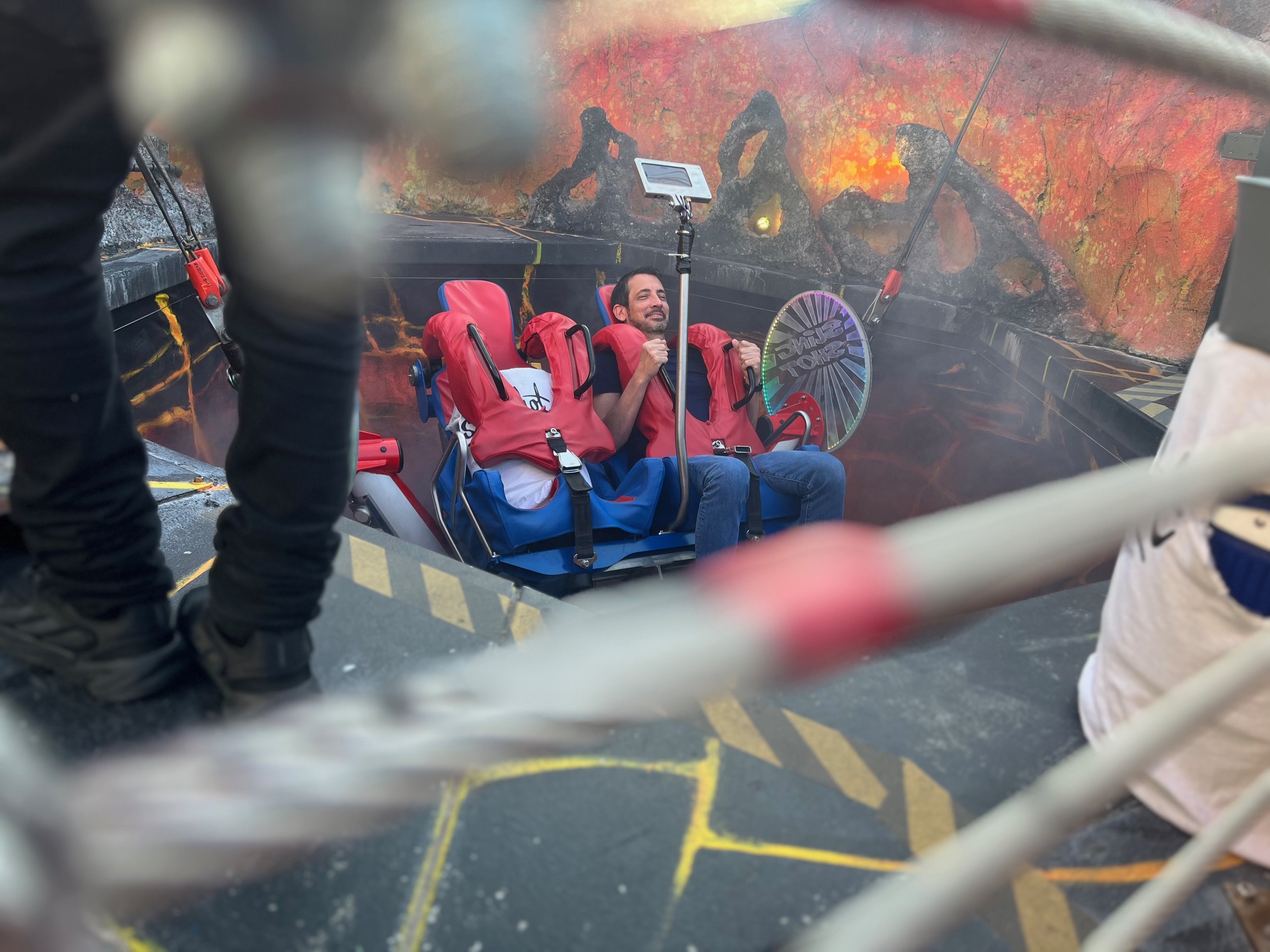
I couldn't get anyone to do this ride with me. Maybe this is why: Slingshot Terror
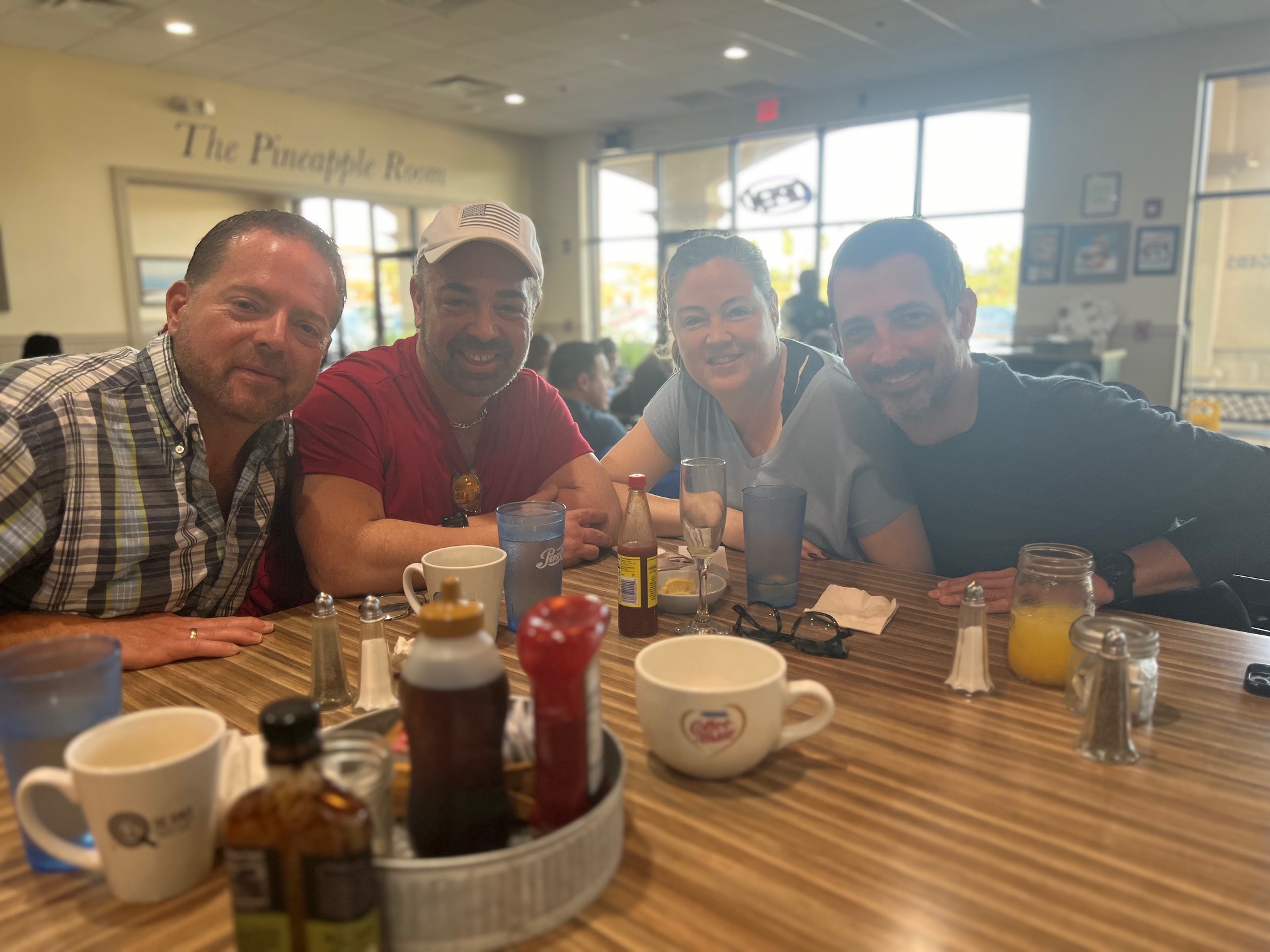
Enjoying brunch with my wife and Florida State buddies. That orange juice may or may not have vodka in it.
Enjoyed, Chris. And very cool pics. Yes, sad to see Bill Belichick go. What a football mind.
The following was written by Frank.
The Three Cent Nickel has a fascinating origin story that is packed with history. The first example of the denomination, the Three Cent Silver, was minted from 1851-1873. The intent of striking Three Cent Silver pieces was to create an intermediate denomination between the Large Cent and the Half Dime. Also, the price of postage stamps was dropped from five cents to three cents, which made this coin have a very practical use. Instead of carrying around three clunky Large Cents, you could bring a small Three Cent Silver piece to buy a postage stamp at the post office. The Three Dollar Gold piece was also minted for a similar reason; you could easily purchase a sheet of 100 stamps without having to worry about having the correct amount of coinage in various denominations.

Because of economic concerns, the public hoarded vast amounts of silver coinage during the Civil War. Many of these coins were Three Cent Silvers. Because of the coin shortage, stamps were accepted as tender for small change, but it created a sticky situation (pun intended) because the stamps would begin deteriorating much faster than coins. To aid the coin shortage, many merchants issued their own one cent tokens, called Civil War Tokens. These Civil War Tokens were accepted and used in commerce regularly. The government also began printing fractional currency, which were pieces of paper money with denominations ranging from three cents to fifty cents.
On March 3, 1865, Congress passed a bill for the coining of Three Cent Nickels, composed of 25% nickel and 75% copper. The Three Cent Nickel has a diameter of 17.9 millimeters and a weight of 1.94 grams. Fourth Chief Engraver of the U.S. Mint James Barton Longacre was in charge of producing a design for the new coin. Three Cent Silvers were struck alongside Three Cent Nickels, but mintages of the silver type were miniscule compared to the nickel type. Eventually, the coining for Three Cent Silvers was halted in 1873, making the Three Cent Nickel the sole type of the denomination until they were discontinued in 1889. Mintages for Three Cent Nickels were quite high during the 1860s, but tapered off until 1889 as the mintages of five cent nickels and higher denominations of silver coinage increased rapidly. The 1880s, with the exception of 1881, had very low mintages; the lowest being just 1,000 pieces in 1885. Many business strike examples from the 1880s are tough to locate.
The U.S. Mint produced only proof Three Cent Nickels for the years of 1877, 1878, and 1886. These proof only dates are in demand for collectors seeking to assemble a date set, as they can only resort to proof examples since none were minted as business strikes. Mintages for proof coins for the type vary from 500-6,609. Many earlier date pieces have lower mintages, while later dates tend to have a higher mintage for proof issues. Proof Three Cent Nickels often come with great eye appeal and a nice cameo contrast.
A few highlights of the series include the business strike 1884 (mintage of 1,700) and business strike 1885 (mintage of 1,000). These two dates are rare because of how relatively low their mintages are. All 1887 proof Three Cent Nickels are overdates (1887/6). The die engraver punched a “7” over the “6” on the die, creating the overdate. There are two varieties of this overdate, a weak and strong overdate. The Mint workers made an effort to polish out the overdate but failed to completely remove it.
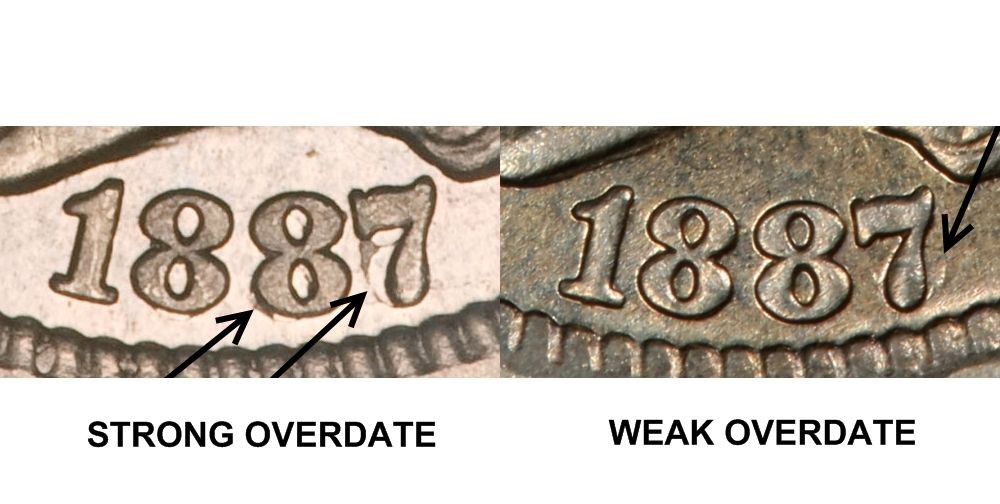
The following is an excerpt from Tom Caldwell, president of Northeast Numismatics:
“Speaking of proof Three Cent Nickels, when we first started traveling to major shows in the early 1970s, it was not uncommon to handle complete sets of this series in proof. Starting in 1865, with its exceptionally low mintage of 500 (all from this year have a recut date) through 1889. I recall figuring most dates in the $50 or less range and the proof only years of 1877, 1878, and 1886 for about double. We handled many complete sets during this time period. Specific numerical grades were not in common use during this era; they were either choice or gem, which is hard to imagine today. The coin business was booming in 1980, and amazingly any proof Three Cent Nickel was trading for $1,500-$2,000 regardless of quality. Prices eventually calmed down and became more stable starting in 1986, as the grading services standardized grading. Today, it is highly unusual to find a complete proof set of this series offered for sale.”
As Tom mentions, finding a complete proof set of this series is a rare occurrence. We have the pleasure of offering a complete proof Three Cent Nickel set on our site: Three Cent Nickels
Sources:
https://www.pcgs.com/coinfacts/coin/1887-6-3cn-strong-overdate/3784
I once tried to assemble an 1885 mint set, excluding of course the Trade Dollar. I never completed the set because I could not find an 1885 business strike. I was offered four coins that all turned out to be proofs. This year, I was finally shown an 1885 business strike, the only one in over 25 years.
Northeast: Were you able to add it to your collection?
I did not add it to my collection, it was over $4,500 and while I recognize its rarity I have other priorities for my collection.
The following was posted by Chris.
We like to have a little fun around here, and this year we have been slowly compiling a list of numismatic puns. We hope you enjoy them, and welcome any that you might come up with! Just comment on this post.
Has anyone ever taken a proof coin and put it in some pudding, just because?
What do you call a coin midway to its destination? Half Cent.
Why was the numismatist excited about his evening? Because he had a key date that night.
What kind of coin do you put in the bathroom? A Voce Potpourri.
What did the tiny numismatist use to protect himself? A Shield Nickel.
Shouldn't a Clamshell Lamination just be called a Clamination?
Did you all hear about the kids in the young Numismatists class? They got in trouble for passing notes!
The following contributions are from the coin message boards. Thanks to all who contributed!
The trouble with blanks and planchets is that you can't make heads or tails of them. (braddick)
Two couples going out is a doubled date. (TurtleCat)
Favorite coin of a divorced couple? Half Union. (TurtleCat)
Undertakers prefer their coins in slabs. (TurtleCat)
Be nice to your partner or you will be a repunched date. (TurtleCat)
What do you call a collector who goes into a tanning salon? Artificially toned. (TurtleCat)
Q: Why can't anyone understand a broken coining press?
A: Because it doesn't make any cents. (MarkKelley)
Why did the coin thief go to jail? He couldn't show the judge any proof he was innocent. (Steven59)
What's the difference between a dollar bill and the Cleveland Browns? You can always get 4 quarters from a dollar bill. (Steven59)
When the brockage cleared I had to run to the privy. (Fraz)
Old Coin collectors never retire, they just lose their luster. (Dug13)
And now our favorite.
"The mint said due to inflation, one of us has to go."

"Why are you all looking at me?" (Manifest_Destiny)
We recently culled the random assortment of books shown below from our library. If you are a member of a coin club and would like to add these to your club's library, let us know and the group is yours at no charge. Given away on a first come, first serve basis. You can request them by leaving a comment on this post.

The following was written by Chris.
I’m always very busy after coin shows playing catch-up, which is why the occasional coin show report we post shows up several days, if not weeks, later. But considering how short the show was, I figured I’d bang one out quickly.
As mentioned in our previous show report, NEN did not take a table at this show for the first time ever. Sales were terrible at the last LB show we attended, and two of our other buyers (Tom and Frank) either couldn’t or didn’t want to go to this one. That said, I was not ready to give up on the show. A big reason is that I enjoy attending it. The weather is almost always the same (lovely), and the downtown area is light years ahead of where it was 10+ years ago in terms of things to do and places to eat.
I flew into LAX from Boston Tuesday night. (I sure do miss those nonstop flights from Boston to Long Beach!) I started early Wednesday morning doing pre-show biz with wholesalers. Show setup started at noon, and I was able to get in thanks to getting an Early Bird badge. It was refreshing to see that the show opened on time and everything was set up. Not so the past couple of shows.
From noon until 6 pm or so, I traveled to various wholesalers’ tables looking through their boxes. My plan was to fly home late Thursday night on the redeye, but by the end of the first day, I knew I was going to be taking an earlier flight. I’m disappointed to say it, but wow, has this show declined significantly. More and more dealers are no longer setting up or even attending. That night I changed my flight to a Thursday afternoon flight, with the added benefit of getting a full day in the office on Friday.
Thursday morning I hit a few other dealers who still had their inventory in boxes or who hadn’t set up at all (see my previous show report about trawling the floor looking in showcases). I went to the show with two empty double row boxes, with the plan to hopefully fill them up, but not looking to buy any more than that. I was definitely being selective. After I finished my last deal, it fit perfectly in the second box. I didn’t have to cram anything in nor was there room for another coin. Exactly two double rows!

I shared a ride to LAX with a dealer friend of mine and grabbed yet another shockingly on time JetBlue flight home, getting to my house around 1 am this morning. Now for a quick food summary. Lunch from Islands Restaurant on Wednesday was generously provided to me by one of the wholesalers, and dinner was with a long-time coin circuit friend of mine at some Italian restaurant. I generally do not eat Italian food, so I of course tried their burger. One hockey puck later, it was time to call it a night.
I’m not sure if we’ll be taking a table at the next LB show. Regardless, I will definitely be attending. While there are way fewer dealers at this show now, it was well worth the time and expense to head out there. I am very pleased with what filled the two boxes I bought.
The following was written by Chris.
The ANA’s World Fair of Money was held earlier this month in Pittsburgh. Back in the day, this show used to be in a different location every year. I really enjoyed the fact that I could count on being able to travel to a different city at least once a year, as all of the other shows on the circuit are held in the same place (e.g. the Whitman show in Baltimore, the Long Beach show in CA, the FUN show in Orlando, etc.).
The ANA then started holding the WFOM every year in Rosemont, IL. Nothing against Rosemont, as it is convenient and they have a nice entertainment complex near the convention center, but it became boring. So, it was nice to have a different host city this year. Of course, we’re back to Rosemont next year. And after that, they are moving it to a new place – Oklahoma City. In August. What?! NOT a convenient city to get to and it’s going to be HOT.
Tom, Brian, Frank, and I attended the show. We flew into Pittsburg Sunday evening and I hit the ground running. I had second shot at a wholesaler’s inventory, so I didn’t want to miss the opportunity. We set up in his hotel room and I was able to pick up a decent group of coins from the 12 or so double row boxes that he had, while eating a pretty darn good takeout burger in the process. Wrapped my night up around 10:30 pm and went back to my hotel for the night.
Dealer Day started Monday morning, and it was a nice short walk from the hotel to the convention center. Not everyone who sets up at the regular show gets a table for the dealer day. Tom and Brian were not on the bourse floor right away, as they were offsite showing our inventory to two different dealers whose business we rely on for a good show. As soon as I had my lamp set up, I flagged down a dealer walking the floor and the day began. Next thing I knew, they were announcing that the bourse floor was closing soon. The day flew by just like that. I recall taking a break to eat some pork rinds I had brought, and Brian graciously provided the rest of my sustenance – a fountain diet coke. It was a successful day of buying from strictly wholesalers.
Tuesday brought the rest of the table holders in. From all appearances it looked like a pretty full bourse floor. That said, I rarely ventured away from my table other than to look at a couple other dealers’ inventories in their boxes. My preferred way to look at coins is in boxes, and I’m fortunate to be able to do most of the viewing at my table. Dealers would bring me their inventory and leave it with me to go through. I don’t enjoy, nor am I very good at, walking around the bourse floor peering into showcases looking for coins to buy. This was a 10-hour day of pretty much nonstop box-looking. I think more pork rinds were consumed, a soda, some candy, and 25 gallons of water.
Wednesday was more of the same for me. I looked at a couple of sealed bid auctions, and went through a few other dealers’ coins at my table. 3 ½ days of buying is plenty for me, so I was scheduled to fly out that evening. Grabbed my first meal of the day at the airport, and an unusual on-time JetBlue flight was greatly appreciated. I was glad to get some much-needed time in the office on Thursday and part of Friday, before heading out for a very enjoyable weekend visiting some friends at Lake Sunapee, New Hampshire.
Tom, Frank, and Brian stayed at the show until Saturday. They sent me a photo of the bourse floor Saturday afternoon. It was a ghost town. I wouldn’t be surprised if they decide to fly back on Friday next year.
Overall, it was a decent show. I was happy with what I was able to buy. Sales were a bit disappointing, particularly considering how much inventory we brought. We’re hopeful for a rebound at next year’s WFOM.
I DID eat while I was in Pittsburgh. I found this fantastic bar that is 100% my scene. Kinda sorta divey, with very friendly staff and great food. If you find yourself in the city looking for a place to unwind and enjoy a good meal, I highly recommend The Warren Bar & Burrow (www.thewarrenpgh.com).
Next up on the show schedule is the Long Beach Expo. For the first time ever, Northeast Numismatics is not taking a table. (Possibly more on that later.) I’ll be heading out for just a couple of days to buy. Hopefully it will be eventful enough to warrant a show report.
The following was written by Frank.
Last month, I attended my second ANA Summer Seminar in Colorado Springs. Brian and I had just been at the Long Beach Coin Expo the week before Summer Seminar, so I had flown from Los Angeles to Colorado Springs. This time around, I took Advanced Grading taught by 3 industry leading professionals, Jeff Garrett, Don Ketterling, and Ken Park. The first day of classes began with introductions of all students and instructors. For the first day, we all graded coins individually and had to record our grades on a sheet of paper to be turned at the end of the day. The next day, our instructors created three teams of 7 graders with each having a finalizer; I was chosen as a finalizer for one of the teams. The instructors passed out 7 certified coins with the grades covered with stickers to each team. As a team, we all graded individually and when everyone graded all the coins, we came together and formed a consensus grade. There were times when we disagreed on grades, but discussed our opinions thoroughly until we came up with an agreement. After gathering consensus grades, one of the instructors would sit down with us and talk us through every coin, give their expert opinion, and tear the sticker off to reveal the grade. Most of the coins we either nailed the grades right on the head or were within a point. Some tricky coins were passed out over the course of the week, including a 1907 Omega High Relief $20 (in a straight grade holder), and a counterfeit 1885-CC Morgan Dollar in an altered holder, amongst many other details coins. During the first couple of days, our individual grades were all over the place, but gradually tightened as the week progressed. Nights were spent talking coins, shooting pool, and riding electric scooters in the downtown area.
The instructors held a grading competition during the last day of class. This was the moment we had all been training for. Over the course of the week, the ANA had a camera crew in the classroom filming parts of class which will later be shown on the ANA’s website for educational purposes. Before the competition began, the film director wanted a representative from each team to go in front of the camera to introduce themselves, talk about their team and about the class. My team nominated me, and I hesitantly walked over to where the camera was stationed and talked for a minute or so. Anybody that knows me, knows that I am a pretty shy person and don’t like to be in the spotlight. The grading competition consisted of 21 coins, whichever team graded the most coins right won. The prize: bragging rights. We graded all of the coins and felt confident in our grades. After the class had graded the 21 coins, Ken Park would finalize each grade. There were many coins that Ken disagreed with once the stickers were torn off, but ultimately it was his call. For instance, there was an AU 1884-S Morgan Dollar in a PCGS Old Green Holder that we had called AU55, but Ken called it AU Details Damaged. I felt that our team had a solid shot at winning, but we ended up tying for second place, at least we weren’t the only team to come in last place. After the competition, we all said our farewells and thanked the instructors for taking the time to instruct the class. I went back to my hotel and flew back to Boston the next morning. Summer Seminar is a great place to learn and socialize with people who have a similar passion, I would highly recommend anyone with an interest in coins to attend Summer Seminar next summer.
What Frank has humbly neglected to mention is that he got the highest score on the individual grading test in his previous grading seminar. -Chris
The following was written by Frank.
Production of business strike Two Cent coins officially began in 1864 but talks about introducing a Two Cent coin started over fifty years prior. In 1806, Connecticut Senator Uriah Tracy proposed the idea of the production of Two Cent and Twenty Cent pieces. The proposed Two Cent coins would be made of Billon, a composition of silver and copper - 6.4 grains silver and 24.3 grains of copper. The bill made its way through the House but died in the Senate, as it was too expensive of a project and would likely be an unpopular coin for public use.
The concept of the Two Cent coin was brought up once again in 1836. These coins would be made of Billon, this time 90% copper and 10% silver. Infamous Chief Engraver Christian Gobrecht would oversee making the new design. The U.S. Mint struck patterns for the Two Cent piece, but none were ever struck for circulation because of counterfeiting concerns. Franklin Peale, U.S. Mint Melter and Refiner, was worried that these new coins could be counterfeited quite easily. The Mint would halt experimentation of the Two Cent denomination until the idea was revisited during the midst of the Civil War.
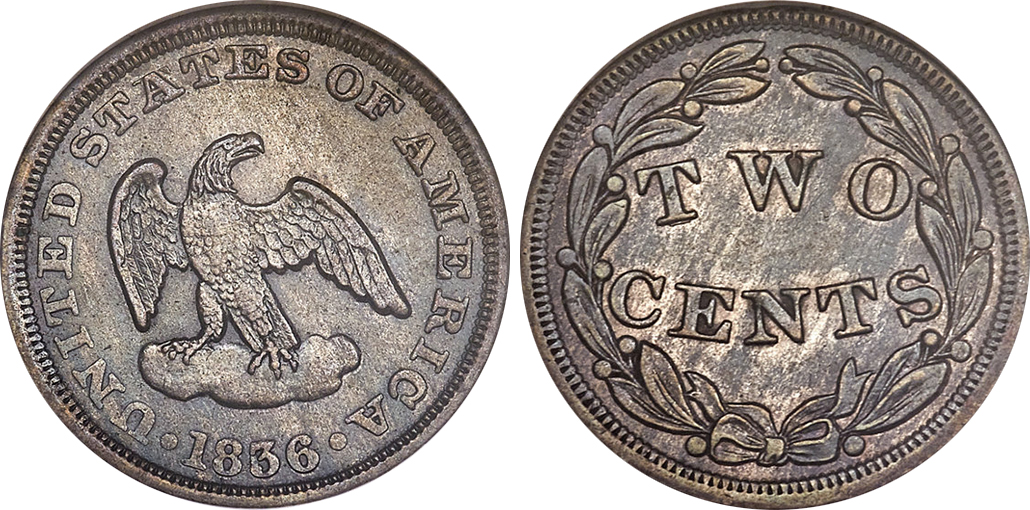
Images from Heritage Auctions.
As they say, “The third time’s a charm!” The Two Cent piece discussion was brought up for the third time in 1863. The Mint began crafting up some potential designs for the brand-new coin. One of the designs depicts George Washington on the obverse with the legend “God and our Country” and a similar looking reverse to what we see today. Another 1863 pattern has a very similar obverse to the business struck Two Cent pieces, but instead of “In God We Trust”, the motto is “God Our Trust”. The reverse is the same as the George Washington issue.

On April 22, 1864, the Thirty Eighth Congress approved legislation which would allow the Mint to strike Two Cent coins for circulation. Chief Engraver James B. Longacre designed the new denomination. The Two Cent piece finally became a reality; over 50 years since the idea was first introduced. The Two Cent piece would be the first coin to bear the motto “In God We Trust.” Many coins followed suit later. The United States suffered a great coin shortage during the Civil War. Two Cent pieces were initially widely accepted because of the dire need for new coinage. Once the coin shortage subsided, these coins were not very popular in commerce as smaller silver coins were more available for transacting. This is proven by the amount of heavily circulated Two Cents from 1864-1866. Coins with later dates are not often seen with heavy circulation. The Mint ended production of business strike Two Cent coins in 1872, which is considered to be the key date of the series. The final Two Cent pieces were struck in 1873 as proofs only.

Sources:
https://www.pcgs.com/coinfacts/category/two-cent-1864-1873/670
The following was written by Frank.
The Coinage Act of February 21, 1857, abruptly disrupted commerce throughout the entire United States. This Coinage Act ended legal tender status for all foreign silver and gold coins in the United States. “All former acts authorizing the currency of foreign gold or silver coins, and declaring the same a legal tender in payment for debts, are hereby repealed.” Before this Coinage Act, foreign silver and gold coins freely circulated in the U.S. These foreign coins were mostly Spanish Reales, but also contained coins from other nations across the globe. The money of today is much different than it was back in those days; the silver and gold coins that circulated had intrinsic precious metal value. Today, our money has nearly no intrinsic value at all. Rather, it has value because we all agree it does. Operating a business in an era of so many denominations of coins from foreign lands was quite a headache for even the simplest of transactions. Conversion tables of all these coins were issued in almanacs to ease the pain.

The Spanish 8 Reales dominated global commerce for many years. These coins circulated in the Americas, Asia, and Europe. Many of these 8 Reales show Asian chopmarks. These chopmarks were punched into these coins by merchants who verified the appropriate silver content of these coins. On many pieces of Continental Currency, the notes state “This bill entitles the Bearer to receive X Spanish milled dollars, or the value thereof in gold or silver.”

Photo Courtesy of Heritage Auctions
The Spanish 8 Reales was such a common coin in commerce that this 1861 obsolete note from Richmond Virginia depicts one on the obverse! It is curious that this note was produced after the Coinage Act of 1857, which is a clue that many businesses still accepted Spanish Reales as payment.

Because transacting in Spanish Reales was so common, the New York Stock Exchange would use eighths instead of the decimal system for stock pricing during their inception in 1792. Stocks would trade in eighths, quarters, and halves instead of decimal cents. The NYSE would finally convert to the decimal system in August...of 2000!
The following was written by Frank.
Coin Curiosities - the 1964-D Peace Dollar

The 1964-D Peace Dollar has remained a numismatic mystery for nearly 60 years. In 1921, the United States revived production of the Morgan Dollar, this would be the first time since 1904 that the United States minted silver dollars. Partway through 1921, the United States decided that they wanted a new silver dollar design. The Peace Dollar was the new design chosen, which represented peacetime after World War One. All 1,006,473 1921 Peace Dollars were struck in the last week of December 1921. 1921 Peace Dollars have a much higher relief than coins issued from 1922-1935. The more pronounced a coin’s relief is, the more pressure is needed to strike the coin fully. Because of all the pressure exerted on the dies, the dies oftentimes broke and needed replacement. Fully struck 1921 Peace Dollars demand a premium over weakly struck examples. The relief was lowered for the next year of production, which remained the same throughout 1935.
The United States faced a massive coin shortage in 1964. This was due to the public hoarding silver coinage, the intrinsic value of these coins were worth more than their face value. The United States was also low on silver reserves. Anyone could order $1,000 bags of silver dollars during this time period, the government needed to replenish it’s supply. In August of 1964, Congress approved legislation allowing the production of 45 million silver dollars to be struck. There was a debate at the time to strike Morgan or Peace Dollars, and the Mint ultimately decided to go with the Peace Dollar design. The Peace Dollar design wasn’t as popular with coin collectors at the time as Morgan Dollars, so there wasn’t as much concern about hoarding the new coins. The Peace Dollar hubs were destroyed in 1937, so the Mint had to create new hubs from scratch.

It would not be until May of 1965 that production of these Peace Dollars began. The Denver Mint produced 316,076 Peace Dollars for circulation, and 20 trial coins in May of 1965. There was an uproar in Congress once the Denver Mint reported to them about the striking of the coins. Congress demanded production of the coins be halted immediately, and the Mint obliged. The Mint reportedly melted every single 1964-D Peace Dollar by weighing out the entire mintage to make sure no coins were stolen. The Mint was a very unreliable source of information during this time period, they falsely reported that no 1964-D Peace Dollars were ever minted. A Mint employee could have easily swapped out a few new coins for some older pieces. 18 of the 20 trial pieces were reportedly melted. The other 2 were reported to be in the Treasury vaults and melted in 1970.
If a genuine 1964-D Peace Dollar surfaces in the United States, it would likely be illegal to own and the coins would probably be seized by the United States government. In 2013, PCGS offered a $10,000 reward just to look at a genuine example. Unfortunately for the hobby, there has never been a 1964-D publicly reported to exist. There have been rumors circulating since the 1970s that some coins existed, but none have ever seen the spotlight. If/when a 1964-D Peace Dollar does surface, it will make national headlines and will be one of the most significant numismatic discoveries of the century. It’s hard to predict what such a coin would bring in a public auction setting, but it would likely bring many millions of dollars.
The following was written by Chris.
When the U.S. Mint released the new Sacagawea Dollar in 2000, they did a promotion to announce the new coin with General Mills, the maker of Cheerios. The Sac Dollar was placed in 5,500 boxes of Cheerios, while a Lincoln Cent was placed in 10 million boxes of the cereal.
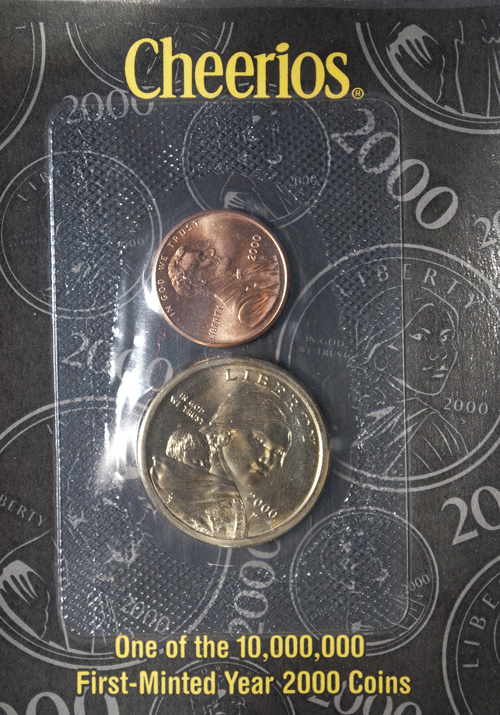

In 2005, astute numismatist Tom Delorey discovered that the reverse on these Dollars appeared to be different from those released for circulation. The tailfeathers are noticeably more enhanced than on the regular issue. In the image below, you’ll note the sharp detail of the feathers on the top coin, the Cheerios “pattern” Dollar.

Images from NGCcoin.com
It’s important to note that not all of the Sacagawea Dollars that came in the Cheerios boxes have the special reverse. You never see them anymore, but if you were to come across a sealed Cheerios Sacagawea Dollar, how would you know if it had the enhanced tailfeathers? Mr. Delorey discovered a diagnostic on the obverse. Underneath the mintmark, coming out from her coat, are die polish lines. These are not found on the obverses of the regular issue Cheerios Dollars. The coin on the left is Cheerios issue.


Images from PCGSCoinFacts
Are these valuable? While the number of these in existence is unknown, the answer is a definite YES. MS67 examples regularly sell for over $5,000, while MS68 coins have brought north of $12k before. That’s quite some find in a cereal box. Sure beats the crappy little plastic toys I would fervently seek in the boxes of cereal I ate when I was kid.

Believe it or not, you can still occasionally find unopened boxes of Cheerios from 2000. The image of this box is from an eBay auction in 2022. The box brought over $500!

The Cheerios Sacagawea Dollar is certainly one of the most interesting finds in modern numismatics, which explains why it made its way to number 12 in the book The 100 Greatest Modern Coins. Eat up!

After two years of development, our new inventory system recently went live. While this is mostly a huge deal for us here at Northeast, it will provide our customers with a more robust user experience in terms of viewing past order history, checking current balances on invoices, retrieving old invoices, and viewing shipping information. If you have any questions about how to access this information, please email me at chris@northeastcoin.com.

The following was written by Chris.
On May 7th 1915, a German submarine (U20) sunk the British liner Lusitania. Nearly 1,200 passengers and crew were killed. This occurred during a period of unrestricted submarine warfare. After the attack, the United States demanded that Germany cease these types of hostilities, and the Germans complied. However, the Germans resumed such activities in 1917, and ultimately the United States joined the Allies in the war.
The sinking of the Lusitania was a propaganda-inspiring event for both the Germans and the British. For instance, the Brits used it as a military recruitment tool.

German medalist Karl Goetz memorialized the event with a satirical medal. His belief was that the Germans had done their due diligence in warning the Americans, British, and the cruise line (Cunard) to the danger of sailing the ship from New York to its destination in Liverpool. The classification of the ship itself was questionable, as it was registered in the Admiralty fleet as an armed auxiliary cruiser. The Lusitania was indeed carrying munitions to Great Britain when it was torpedoed.
The medal Goetz issued features a skeleton on one side selling tickets to passengers from a Cunard ticket counter. A man is seen reading a paper with a headline that translates to “U-Boat Danger”. Above is a legend that translates to “Business Above All”. This speaks to Goetz’s opinion that the Germans had fairly warned of the potential risk, yet the cruise line chose to bring paying passengers on board and take the journey anyway.
On the other side, we see the sinking ship. The wording on top translates to “No Contraband Goods”, referring to the classification of the ship and its cargo. On the deck of the sinking liner are artillery and warplanes. The legend below translates to “The Liner Lusitania Sunk by a German Submarine”. It’s the date on the medal that turned it into a huge British propaganda tool.
Goetz first issued the medal with the date 5 Mai 1915 (May 5th). However, the ship was sunk on May 7th. The incorrect date was no more than an error on Goetz’s part, as he likely referred to a single and erroneous source for the information. He soon reissued the medal with the correct date, 7 Mai 1915 (May 7th), but the “damage” had been done.
The British viewed the May 5th date as proof that the sinking of the Lusitania was a premeditated act. This prompted the British government to issue their own medal with the incorrect date. 300,000 or so medals were struck and distributed.
All three versions are very popular among collectors today.
Original Goetz issue (Image from Spink)

Second Goetz Issue
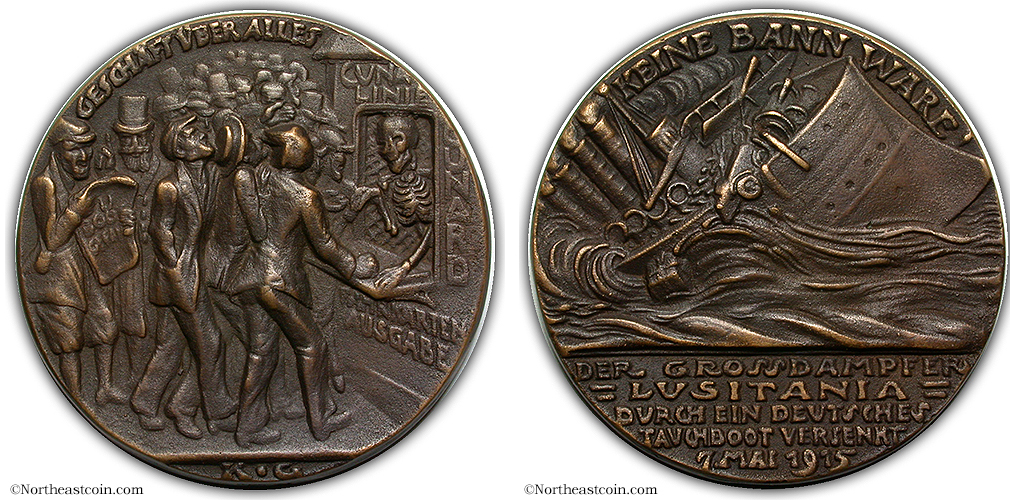
British Issue (Image from PCGS CoinFacts)

The following was written by Frank.
Counterstamps are a history packed niche of numismatics. Counterstamped coins are coins that have been punched with a design or text after the minting process. Some are counterstamped either for advertisement purposes, or for verifying the coin's authenticity and precious metal content. Some coins are counterstamped for no apparent reason with generic letters or numbers; these are usually considered damaged coins and should not trade for a premium. I will be focusing on U.S. coins and foreign coins that circulated in the U.S. for this blog post. Counterstamped coins tell a great story, they tell you where and when a particular coin circulated and what it may have been used to purchase. Counterstamps are a perfect area of collecting for those who have an interest in history.
Before there were radios, televisions, and billboards, it was common practice for store owners to advertise their business by counterstamping coins with their business’ name, the products they sold, and their address. This was a fairly inexpensive method of advertising; all the store owner had to do was order a custom punch with their information, and counterstamp the coins they received for everyday transactions. Pictured below is a counterstamped 1858-O Seated Half Dollar advertising a saloon in Memphis, Tennessee.

An 1858-O Seated Liberty Half Dollar that reads “Ben. F. Wyant May Flower Saloon No 137 Main St Memphis-Tenn.”. Photo courtesy of Heritage Auctions.
Up until 1857, many different foreign coins circulated alongside U.S. coins. Many foreign coins were also counterstamped with the purpose of advertising. Pictured below is a Carlos III 2 Reales that reads “ADMIT TO WOOD’S MINSTRELS 444 BDWAY. N.Y.”. This particular coin was used as admission to a minstrel show during the early days of Broadway.

18th century Carlos III 2 Reales “Admit to Wood’s Minstrels 444 Bdway. N.Y.”
Coins were also counterstamped by merchants, silversmiths, and goldsmiths who would verify the authenticity and precious metal content of the coin; these are commonly known as “chopmarks”. It was important to verify these coins because they were supposed to have an intrinsic precious metal value, unlike the coins that we have today. Chopmarks are quite common on 8 Reales and United States Trade Dollars, as both of these denominations were used overseas for trade, mostly in Asia. Pictured below is an 1877 Trade Dollar decorated with many Asian chopmarks.
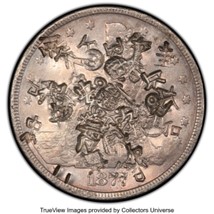
1877 Trade Dollar with various chopmarks. Photo courtesy of Heritage Auctions.
Ephraim Brasher was a well known goldsmith who lived in Manhattan during the late 1700s - early 1800s. He is most commonly known for being the designer of the infamous 1787 Brasher Doubloon. Brasher counterstamped a number of foreign gold coins, which confirmed that the coin is of proper weight and purity. Coins with Brasher’s mark were used with no concern because he was one of the finest goldsmiths of the era and was well respected. Pictured below is a 1760 British Half Guinea with Ephraim Brasher’s counterstamp, “EB”.
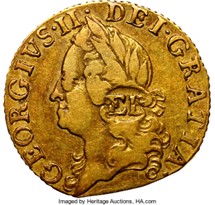
1760 British Half Guinea “EB” Counterstamp. Photo Courtesy of Heritage Auctions
Counterstamped coins offer a great history lesson and add a lot of “coolness factor” to their host coin. There weren’t as many advertising options during the 19th century. We might think it sounds silly to advertise with coins today, but during those days it made cents, oops, sense. We no longer need silver and goldsmiths to tell us the precious metal content of our coins anymore, we now have technology that tells us the exact purity of a coin.
The following was posted by Chris.
Oxford's English Dictionary defines beautiful as pleasing the senses or mind aethestically. As the definition implies, beauty is quite subjective. Everyone's laminated list (if this Friends reference is lost on you, think "hall pass") will be different.
Most coin collectors out there, with a lot of effort and mind-changing, can probably compile a list of their top five most beautiful coins. I decided to put together a list of some of the coins that I consider the most beautiful in the world. Choosing just five was too challenging for me and would have made for a short post. The coins listed here are in no particular order. At the end, you'll find everyone's favorite here at NEN. By the way, if you have a favorite that you'd care to share, please do! We'd be happy to post it.
All images from PCGS CoinFacts.
The 1907 High Relief. Certainly one that will be on many collectors' lists. (I cheated and used an Ultra High Relief image.)
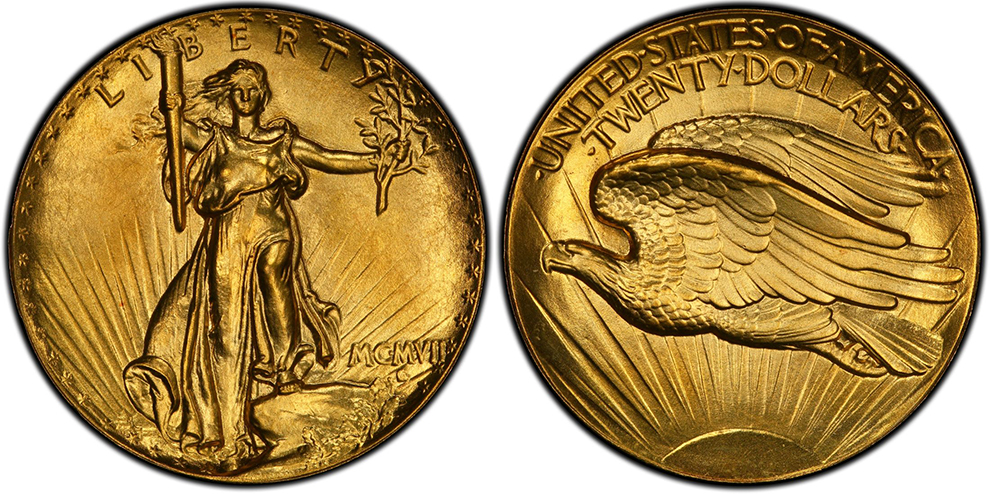
The 1847 Great Britain Gothic Crown. Definitely a top five for me.

The 1839 Great Britain Una and the Lion 5 Pound. Another top five for yours truly.
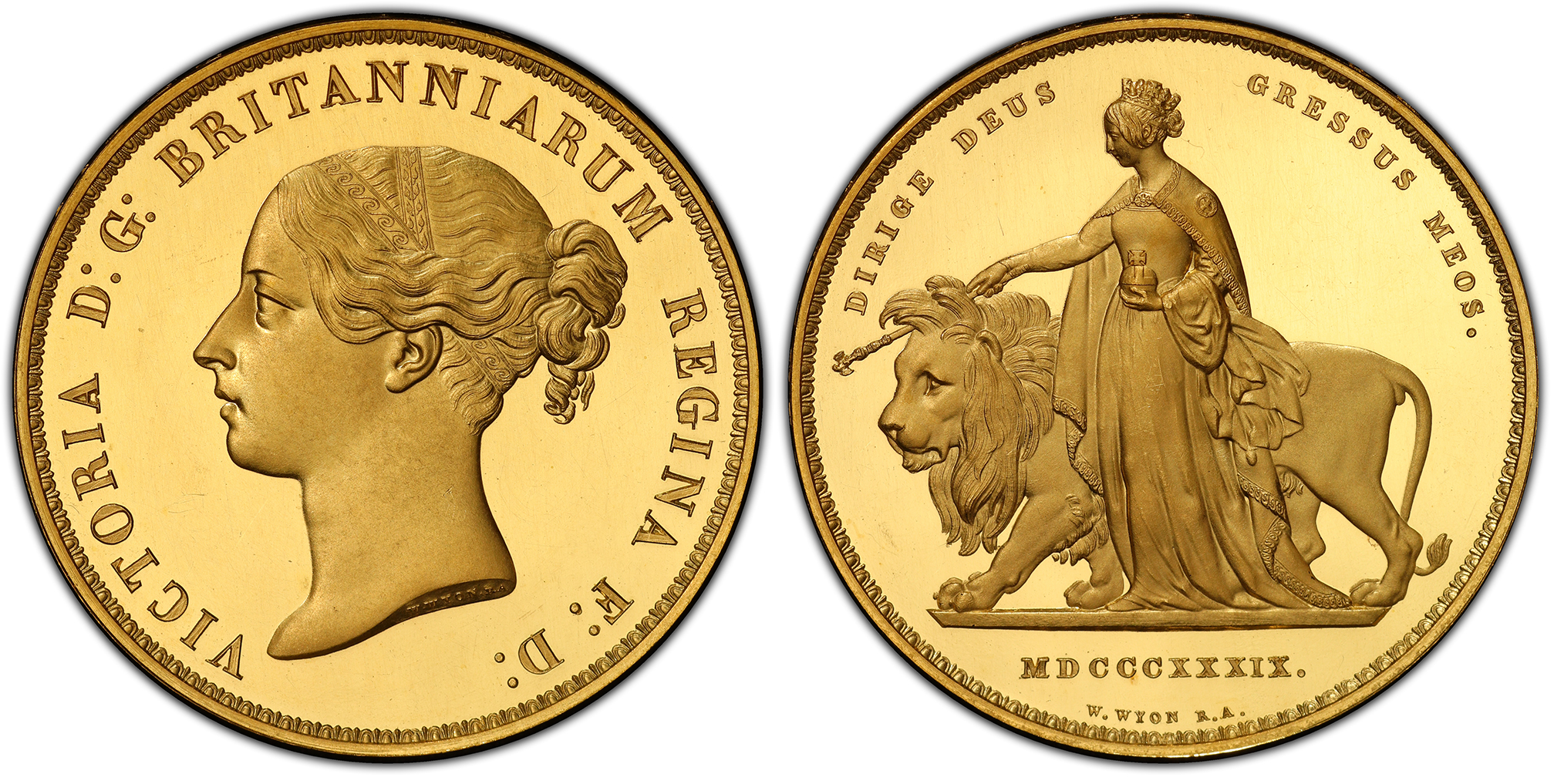
Central American Republic 8 Reales.

1916-1917 Type One Standing Liberty Quarters.
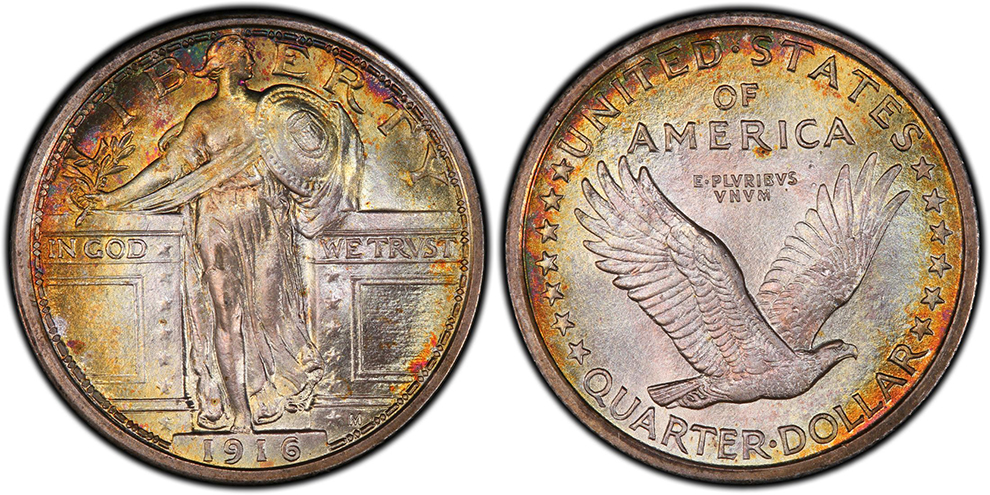
1935 Connecticut Silver Commemorative. Okay, I'm not a huge fan of the reverse, but I love the oak tree motif.
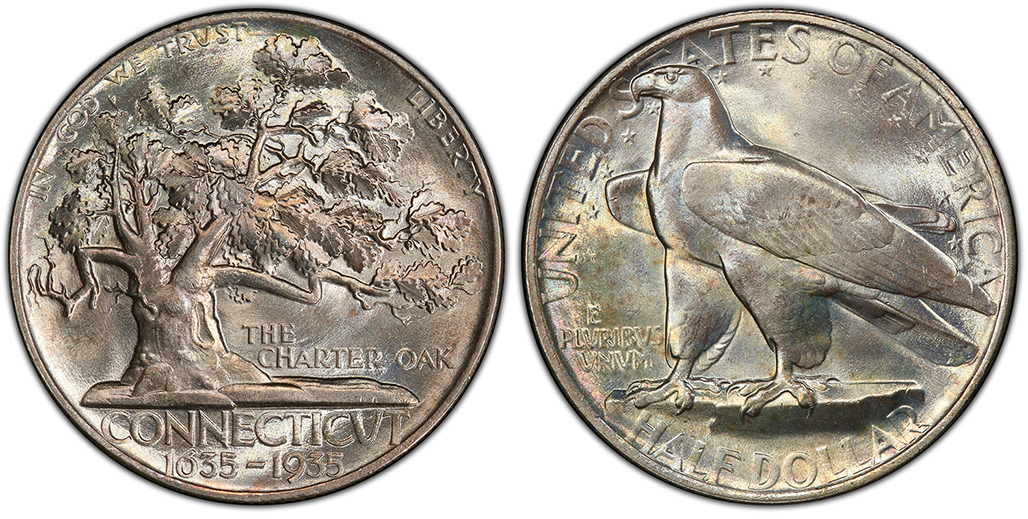
Libertas American Medal. Got me, it's not a coin, but this famous issue deserves entry. I might have to put this in my top five also.
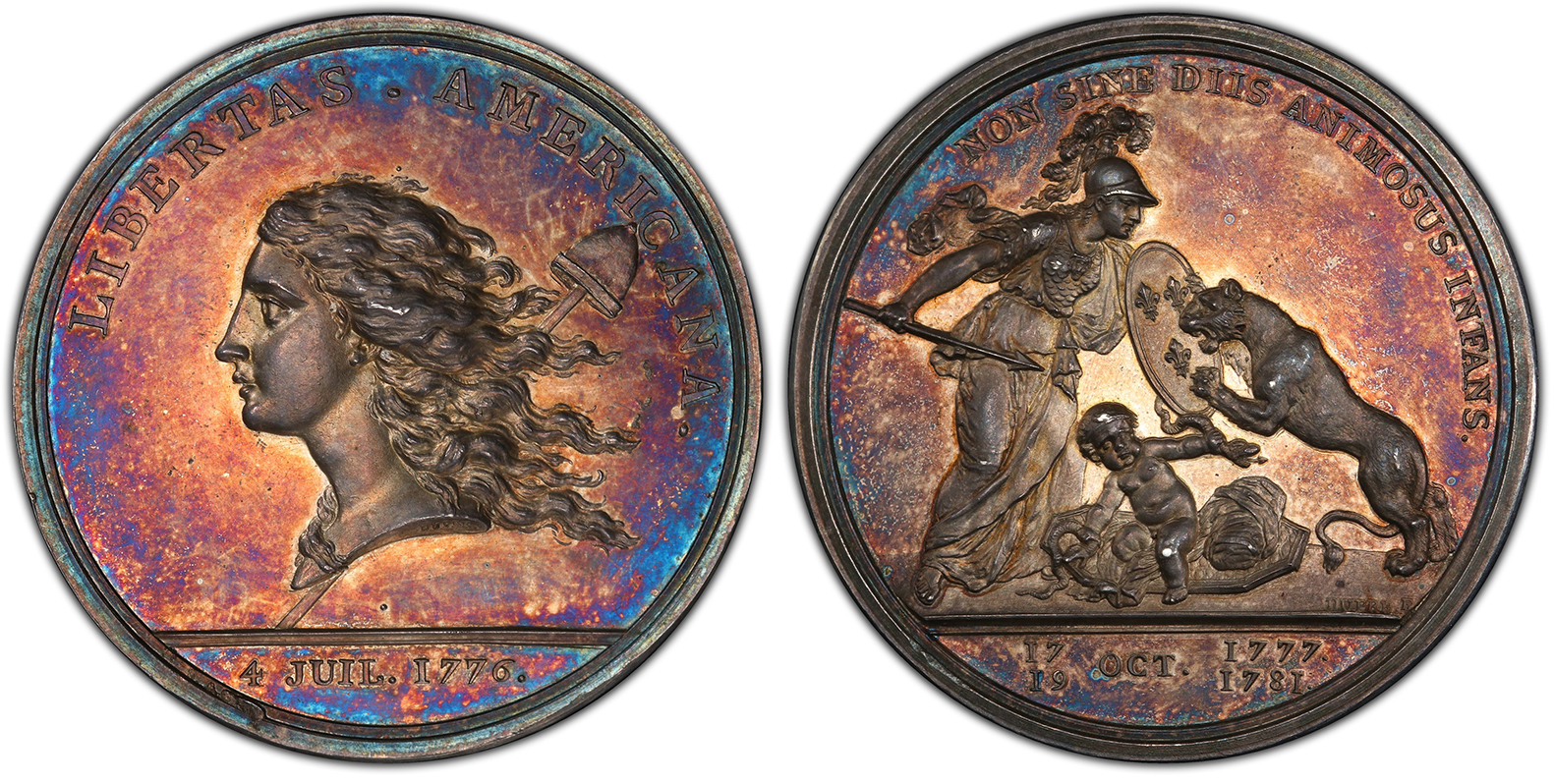
Draped Bust Heraldic Eagle Dollar. This one is a proof.

1894 German New Guinea Bird of Paradise issues.

France Hercules Silver Francs issues.

1921 High Relief Peace Dollar. (I cheated again, using a satin proof image for this one.)

2017-W $100 American Liberty High Relief. Generally speaking, modern coin designs don't appeal to me. But I figured I'd include something "new" in the list. I think it's the Mint's best modern production.
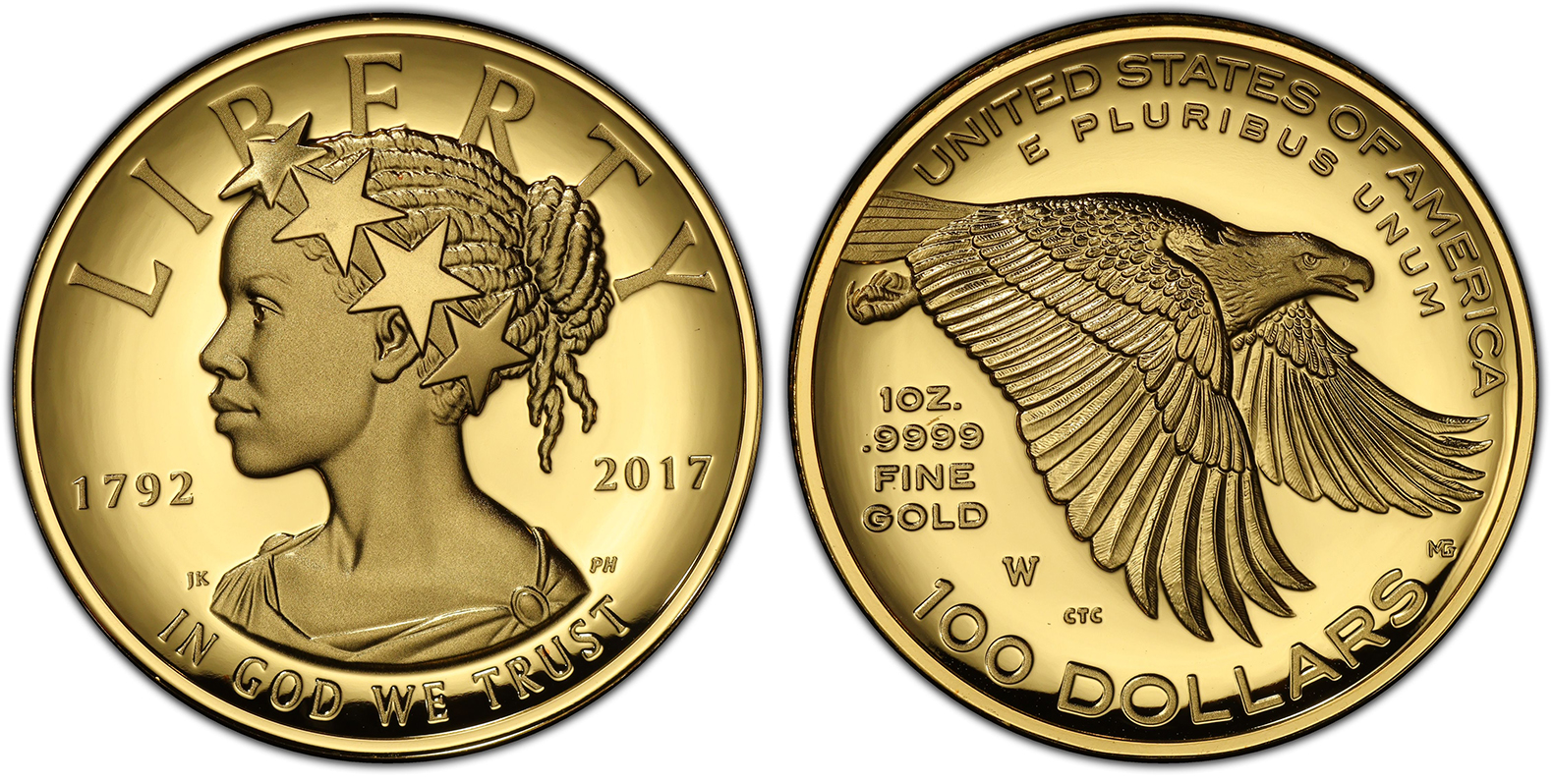
Now for everyone else's favorites!
1776 Continental Dollar. Tom picked this one.
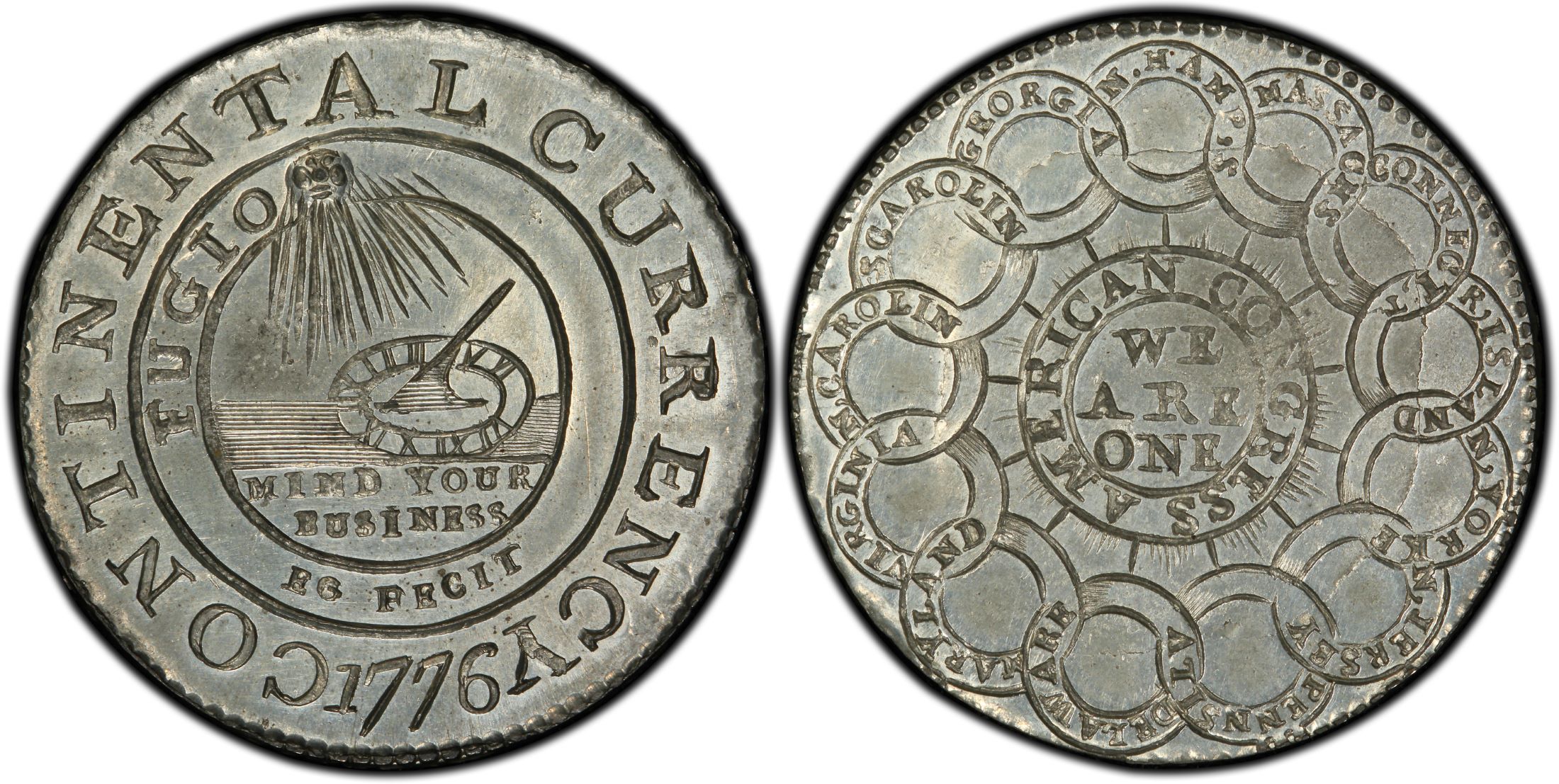
1915-S Pan-Pac $50 Gold Octagonal Commem. This is Marne's choice.

Mexico 50 Gold Pesos. Steven likes the design of the these.

Deeply mirrored Morgan Dollars. This is Mike's selection.

1836 Pattern Dollar. This popular Cap and Rays design is one of Frank's favorites.

Susan B. Anthony Dollars. Last but not least, Brian is a big fan of this issue.
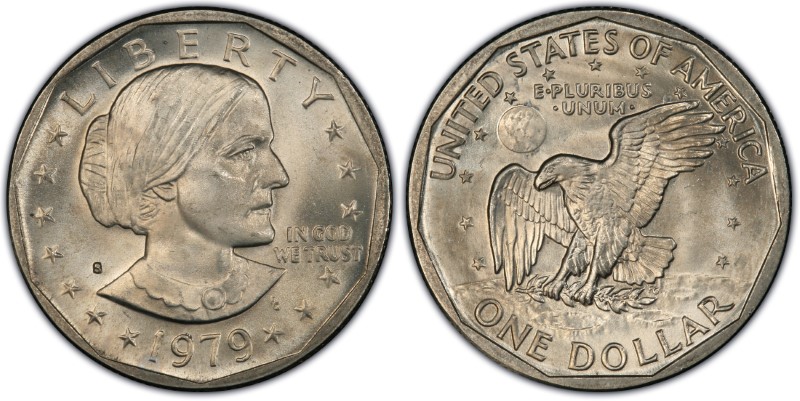
1943-1974 Mexico 20 centavos in red is a beautiful coin, lots going on, pyramid, cactus, cap and rays, etc
Thanks for sharing, JCoop. We agree!
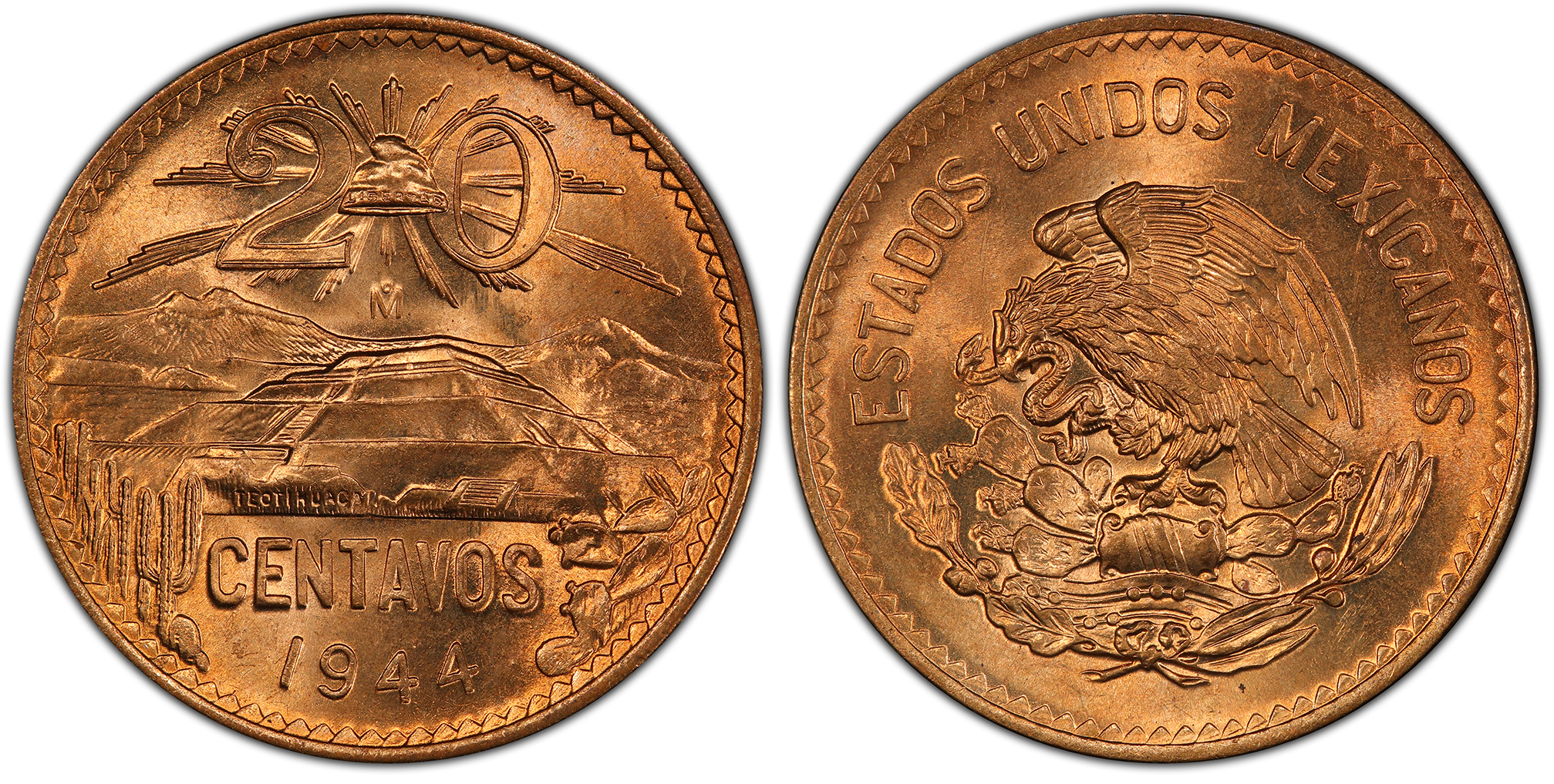
Identify what this is, where it's from, and approximately when it was made. Send your guess to info@northeastcoin.com. The first correct entry received will win a surprise coin, which will be revealed when we post the answer.


Congratulations to Panda, who correctly determined what this is! It's a 1/4 Baht from Thailand from the mid-1800's. It's commonly referred to as bullet money. Panda's prize is a silver 1 Baht pictured below.


The following was written by Frank.
Capped Bust Quarters have been a favorite of mine for a number of years because they have tremendous value and rarity compared to their larger counterparts (Capped Bust Halves). Only 5,496,984 Capped Bust Quarters were minted from 1815-1838, while 91,088,096 Capped Bust Halves were minted from 1807-1839. It’s also a rather short series; it is quite attainable to put together a date set of business strike coins, with exception to the 1823. Capped Bust Quarters remain relatively affordable in moderately circulated grades. You can easily locate a so-called “common date” XF piece for $500.
The story of how the Capped Bust Quarter came to be is an interesting one. The Mint hadn’t produced any quarters since 1807, which was the last year of the Draped Bust design. The United States began producing Capped Bust coinage with the Half Dollar in 1807. In the early days of the Mint, anyone could bring their silver and gold to the Mint and have them turn your metal into freshly minted coins. The Coinage Act of 1792 states, “That it shall be lawful for any person or persons to bring to the said mint gold and silver bullion, in order to their being coined.” So, if you were in Philadelphia during the early days of the mint, all those gold implants you have could be extracted and made into freshly struck uncirculated quarter eagles, if you were in dire need of some extra cash. The Mint would charge one half percent of the weight of gold or silver to cover their expenses.

Photo courtesy of PCGS
Banks too would often deposit their sums of silver and gold to the Mint and get coins in return. In 1815, the Planters Bank in New Orleans placed a large order of Quarter Dollars from the mint. Bailly Blanchard, the head cashier at Planters Bank, wanted Quarter Dollars because of a local shortage of their Mexican counterparts, the 2 Real (1 Real was equal to 12 ½ cents). You have to remember that Mexican coins circulated alongside U.S. coins up until 1857. The Director of the Mint, Robert L. Patterson, didn’t want to follow through with the order of Quarters because the Mint didn’t have any Quarter Dollar dies prepared. Eventually, Patterson caved and instructed Chief Engraver John Reich to create dies for 1815 Quarters. The total mintage for 1815 Quarter Dollars is 89,235. 69,232 Quarters were struck in 1815 and another 20,003 coins made in 1816 bearing the 1815 date.

Photo Courtesy of Newman Numismatic Portal

Photo Courtesy of Newman Numismatic Portal
Planters Bank would get their shipment of almost 57,500 pieces in December of 1815, the remainder of the coins were paid to the Bank of Philadelphia on December 30th, and Jones, Firth & Co. on January 10, 1816. The large diameter Capped Bust Quarter would be produced until 1828, when it was replaced with the small sized Capped Bust Quarter in 1831, these would be produced until 1838.
Works Cited:
1815 25C (Regular Strike) Capped Bust Quarter - PCGS Coinfacts. https://www.pcgs.com/coinfacts/coin/1815-25c/5321.
1815 – The Year Without New Cents.” Numismatic News, Numismatic News, 2 Apr. 2012. https://www.numismaticnews.net/archive/1815-the-year-without-new-cents.
We have quite a bit of numismatically related art hanging in our office. We thought we'd take the opportunity to share some of it. Do you have any hanging or on display in your house that you'd care to share?


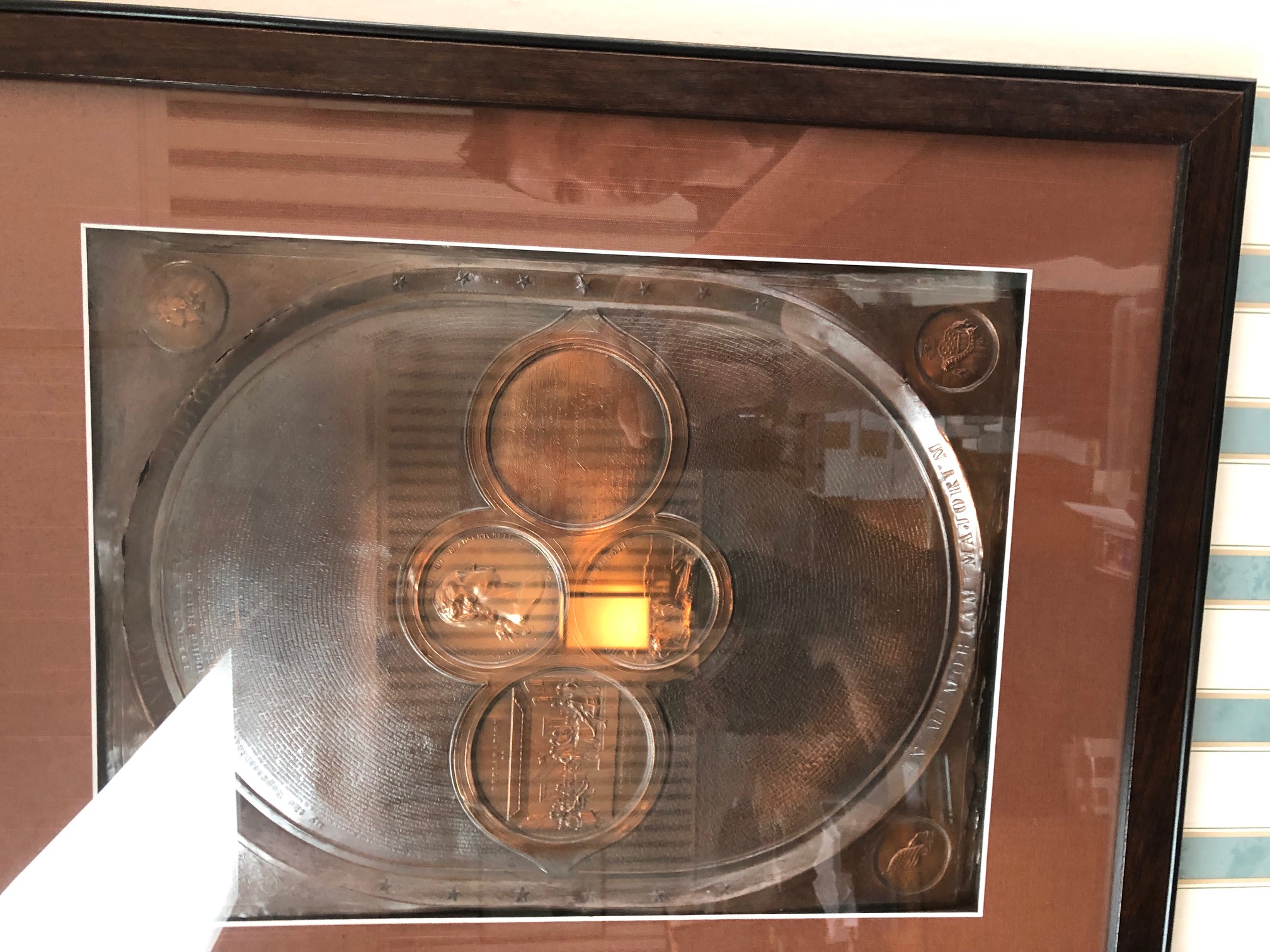




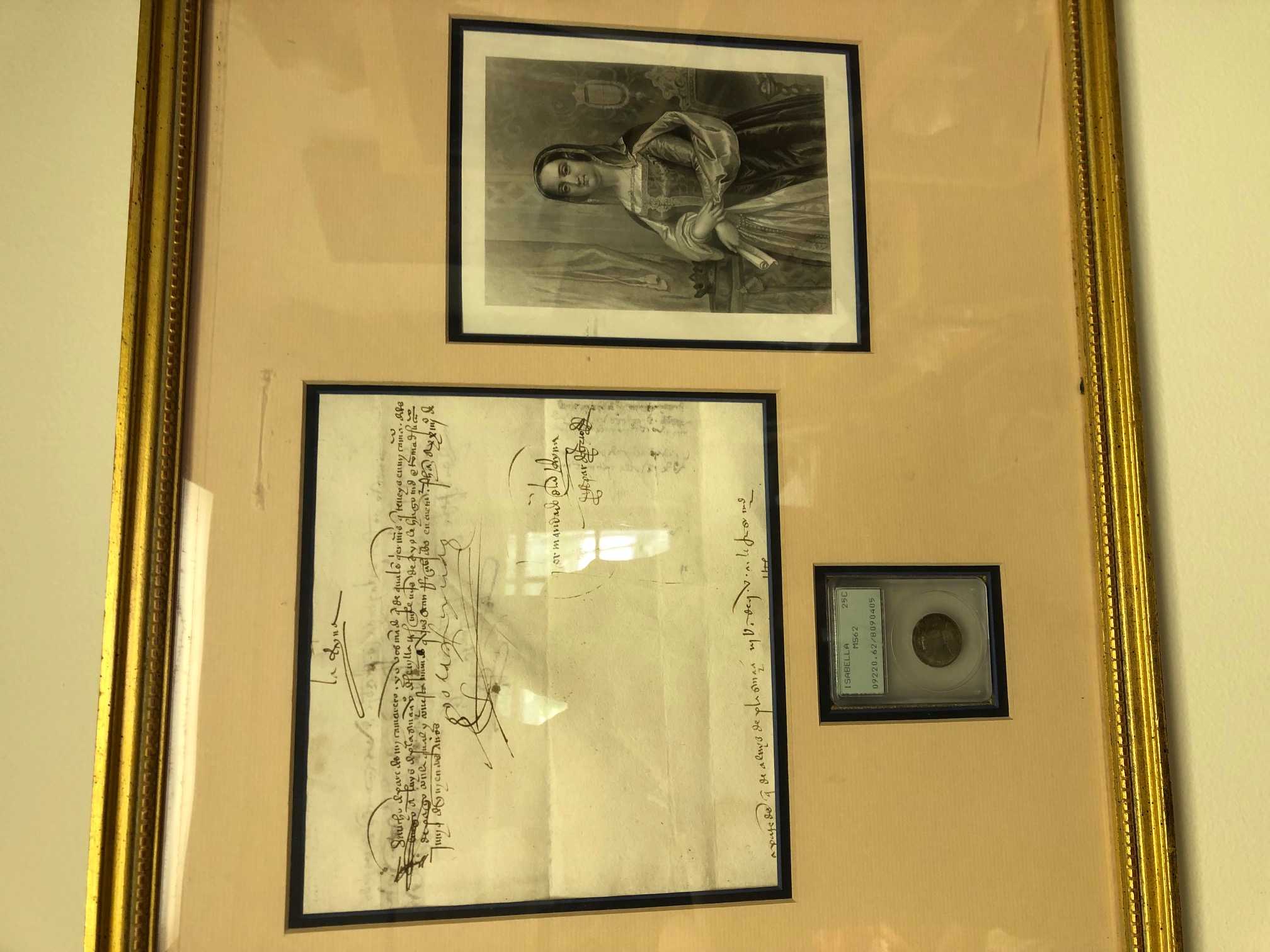

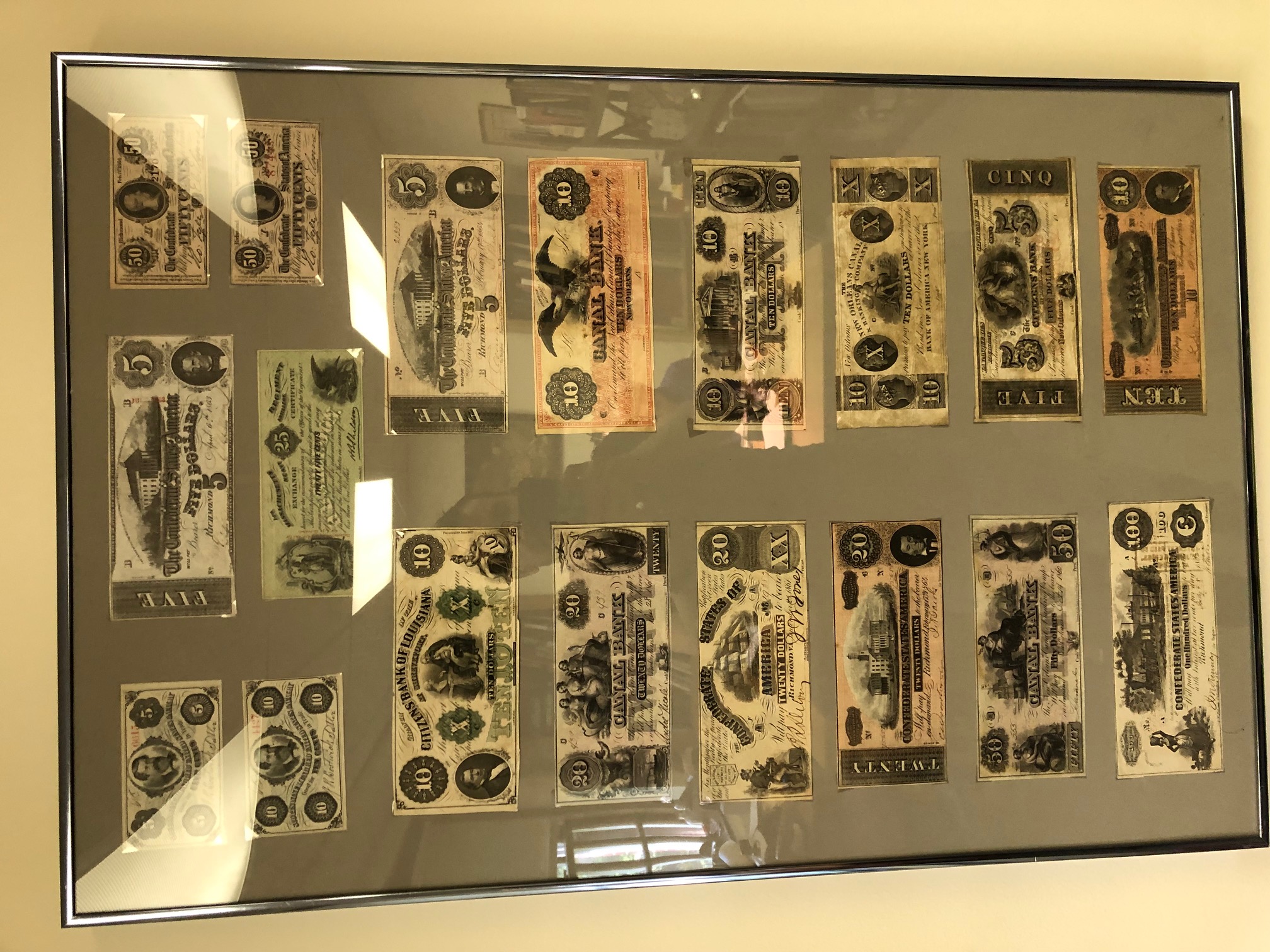



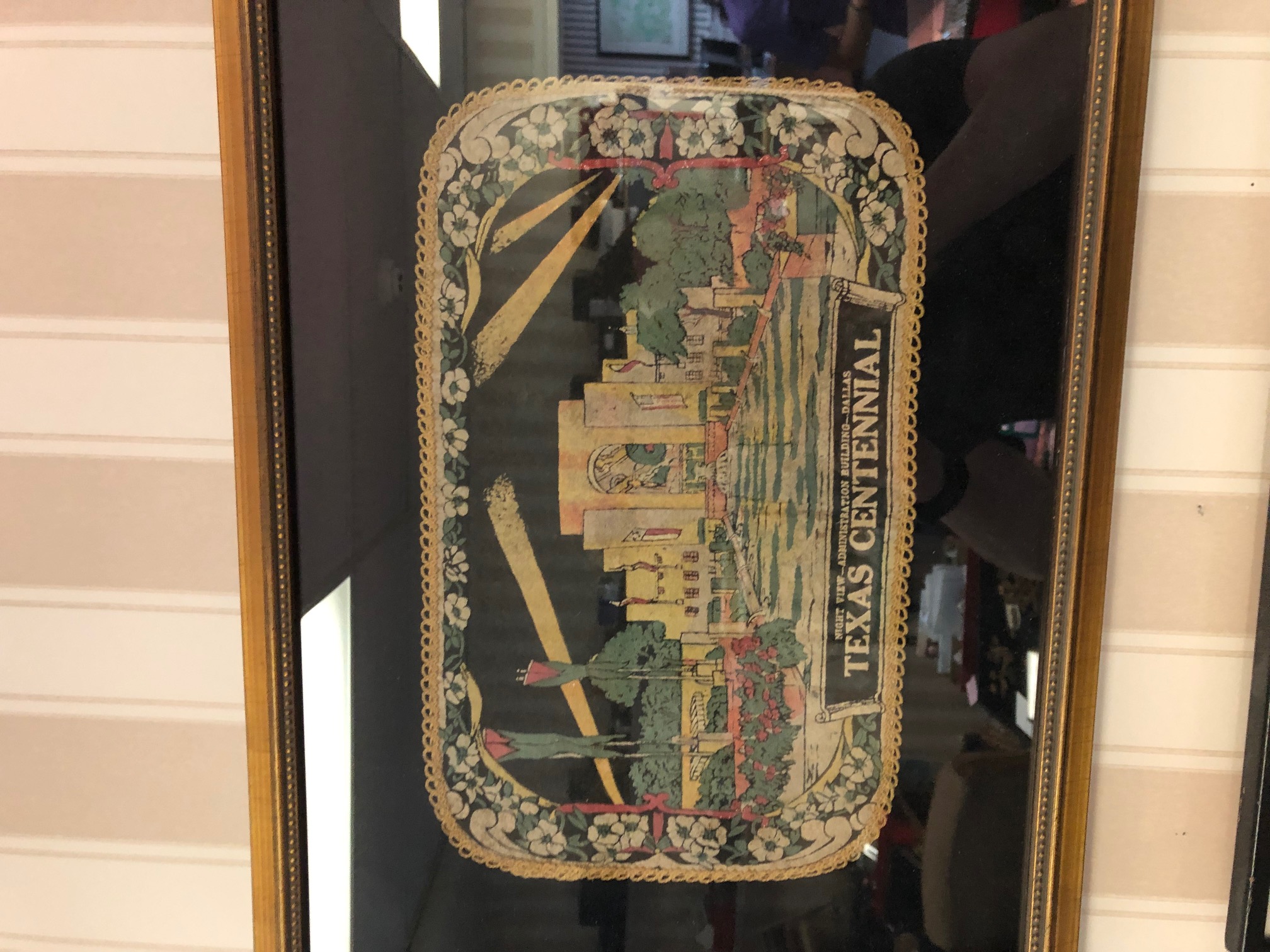



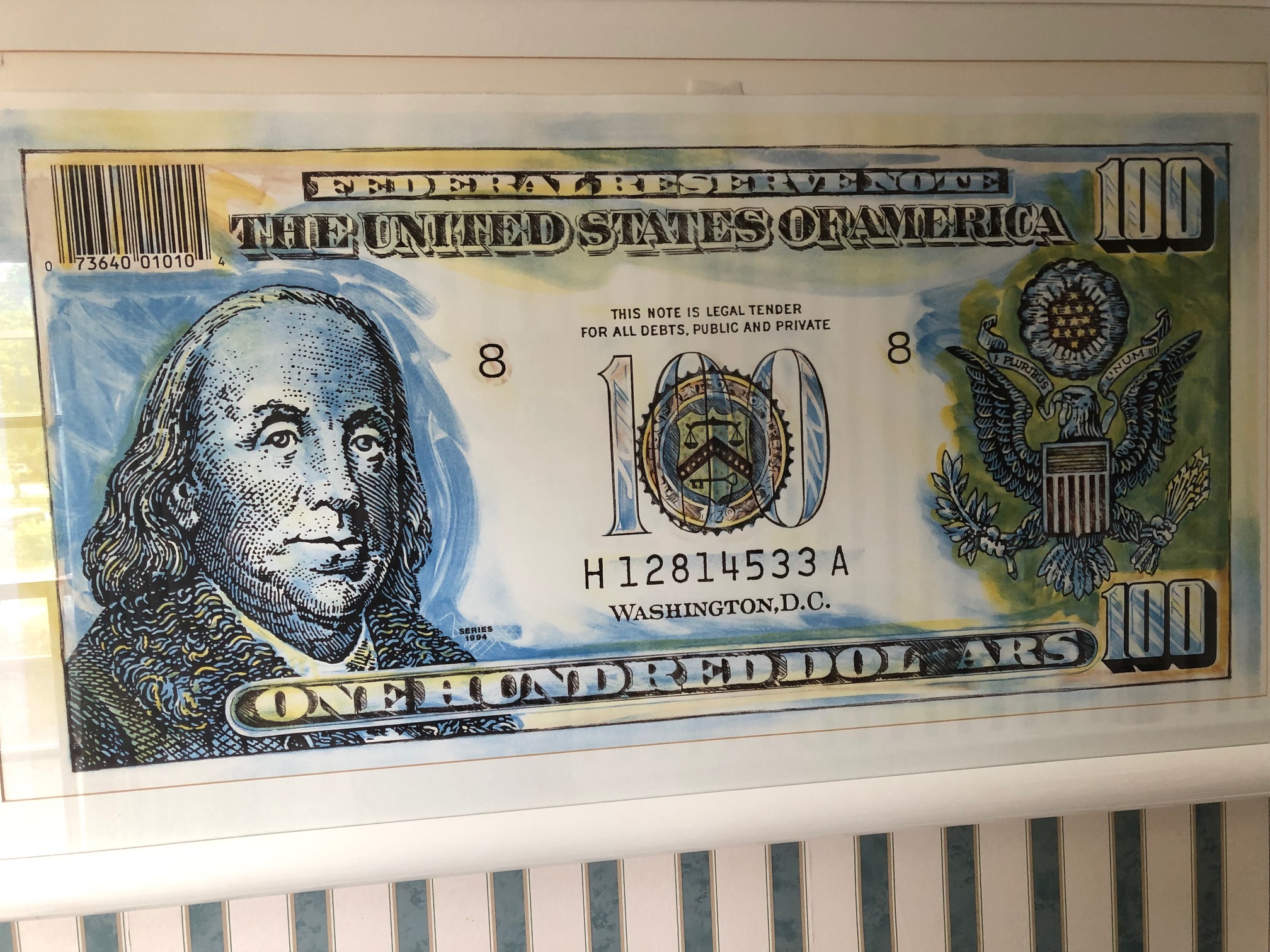
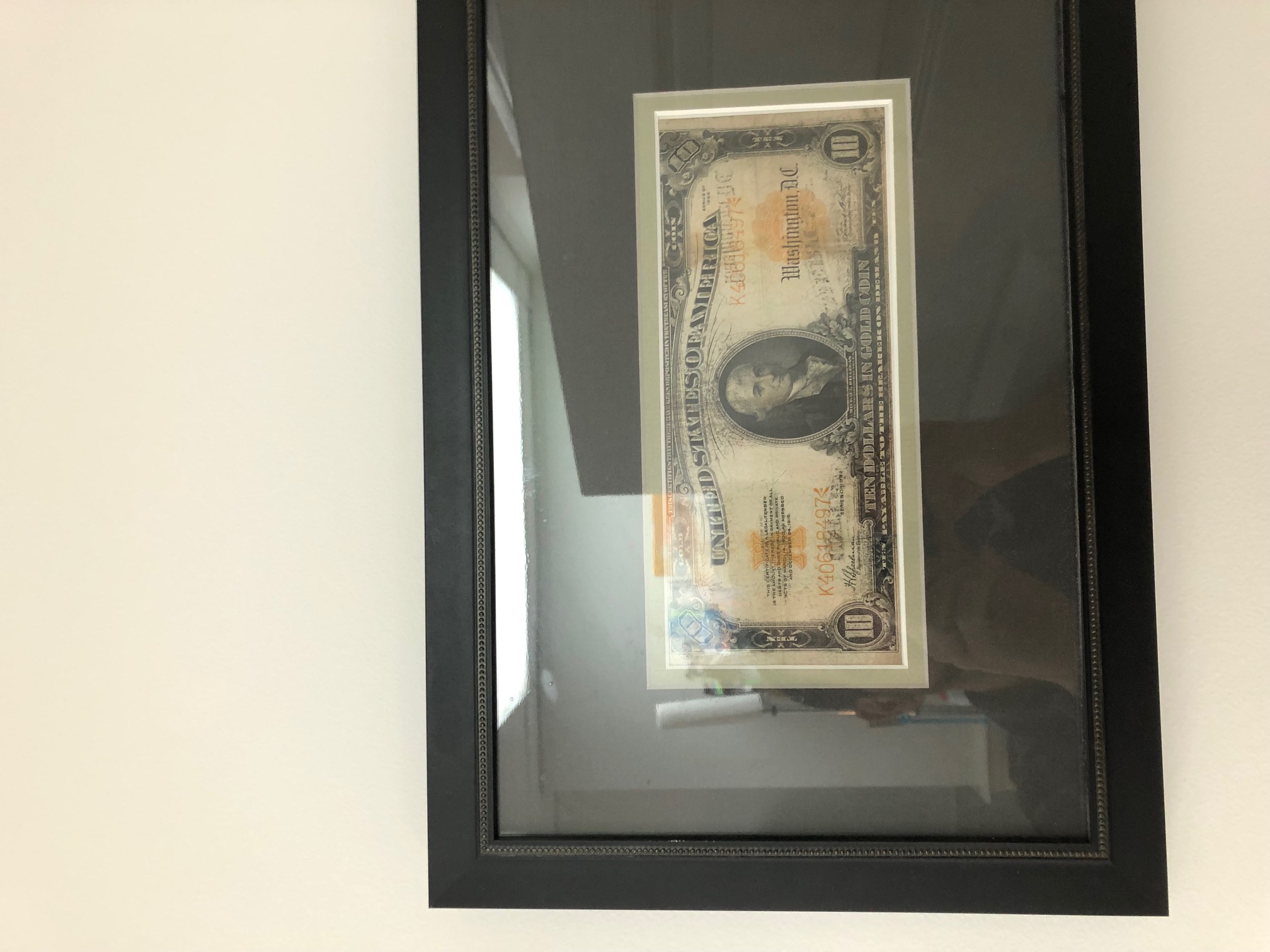
(Next post, our personal knicknacks.)
The following was written by Chris.
We attended the Long Beach Coin Expo last week. It occurs to me that I’ve now traveled to this show for a quarter of a century, three times a year. That means I’ve spent well more than a half a year in Long Beach, or nearly 2% of my life, even though I’ve never lived there. Huh. (If you think that’s impressive/depressing, our boss Tom has spent close to two years of his life in Long Beach, never having lived there either.)
Brian, who handles the vast majority of our wholesale sales at coin shows, was out for the count with a back injury. Tom’s son Russell, who has worked many shows in the past for us, traveled in his place. We flew into LAX from Boston early in the week. Personally, I think LAX is a mess. Slow baggage claim, and a ridiculous trek via an overcrowded and/or delayed bus (or take a long walk) to the Uber/taxi lot. I really miss the non-stop flights from Boston to Long Beach. Boarding and deplaning outside on the tarmac via ramps and steps? Supercool old school!
Dealer setup for this show these days starts at noon on Wednesdays. We always attend some pre-show trading that morning (and often the day before). Our trading room at this show was maybe only 25% full, but we were certainly busy the whole time trying to buy and sell.
As mentioned, the show opens at noon for dealers. But not this time. For the first time in my coin show career, dealers were held out in the lobby for close to 30 minutes after the posted start time before being let in. I’m a bit surprised an email wasn’t sent out by the show coordinators after the fact explaining the issue and issuing an apology. We have no clue what the hold up was.
Admittedly, expectations for me were not particularly high for this show. Some wholesale-only dealers with whom I often do lots of business were not in attendance. While formerly one of the major shows of the year, I feel the LB show has slipped down in the ranks a bit. My initial perception of the bourse floor was that it was two-thirds coin dealers, and the rest sports card dealers. Nothing wrong with that whatsoever, as it’s a convention for many types of collectibles. But it’s typically been a coin show with some other business going on.
Once we were in the show for setup, I was able to look through several boxes of wholesale inventory, mostly at my table. I bought what I could, but I passed on so many coins based primarily on price. The market remains solid in most areas that we buy. Has it tempered a bit since its take-off in Spring, 2021? Yes. But prices aren’t falling. Unfortunately the overly aggressive pricing I saw limited my buying. Tom had more success acquiring fresh inventory thanks to his efforts prior to the show. Combined we managed to come home with about six double row boxes of newps.
If anyone cares to hear about our dining experiences, read on. To start, the show provides free beer for dealers later in the day at setup. I choked down my typical amount of light beer (about a 1/3 of the bottle). I’m just not a beer drinker. What I did notice for the first time was a full bar that was set up near the entrance. I did not partake, but I think it was an interesting idea.
Lunch every day was from California Pizza Kitchen. That’s a staple for most of the dealers that choose not to eat an $18 hot dog from the concession stand, as CPK is right across the street from the convention center. Dinner Wednesday night was with a friend of mine from back in my NOLA days. He decided to swing by the show for a day, and it was nice to catch up. We ate at the Auld Dubliner, which is an Irish pub also right across from the convention center. Always great food. And the final night was dinner with Russell at a new and huge Mexican restaurant called Solita. It was decent, but nothing to write home about (yet here I am writing about it).
The last major show of the year is coming up in a few weeks at the Whitman Expo in Baltimore. I anticipate having a better show there than I did in Long Beach.
Enjoyed, Chris.
The following was written by Brian.
Ok, fine, I spelled ‘currency’ incorrectly, but I’m not the first one. And at least I didn’t design a US coin with a spelling error.
And so it is, one of the most famous (and controversial) coins in US history, the Continental Curency Dollar.
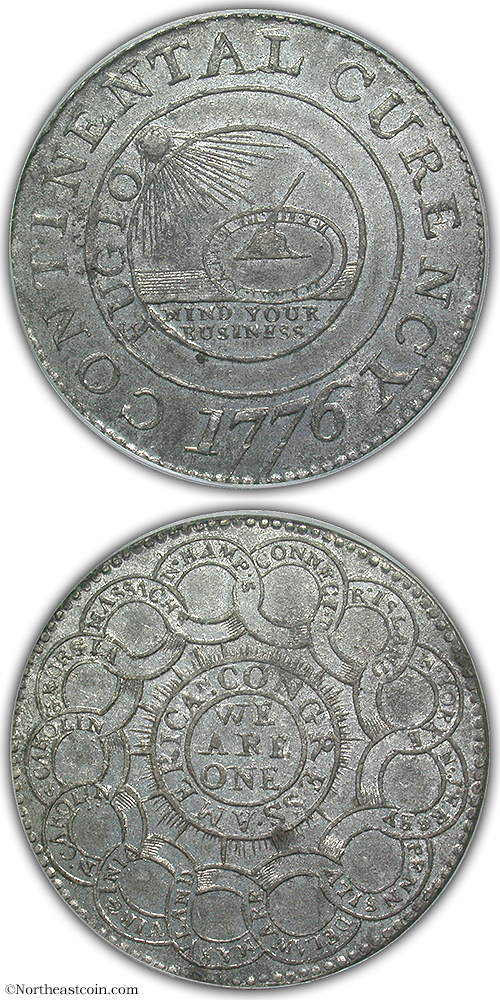

Listed at number 30 in the fifth edition of the 100 Greatest US Coins. This is and has always been an immensely popular coin, due to the theory that this was the first circulating US coin, it’s magical date and its ties to Ben Franklin. This particular variety is noted for its lack of two R's in CURENCY. Designed by engraver Elisha Gallaudet, it includes elements from the One Third Dollar and One Sixth Dollar Continental Currency notes that were in circulation at the time, as well as some features proposed by Benjamin Franklin.


A most interesting inscription, Ben Frankloin's “Mind Your Business” (taken from the Fugio Cent) is located just below the sundial. Now, mind you, this phrase is not meant in the contemporary sense as in "mind your own business", like buzz off, go take a hike or take a long walk off a short pier or go pound sand. No, Franklin did not intend to communicate this idea. Instead, he likely meant to communicate that others should literally keep their business affairs at the center of their thinking. This wouild make sense as Franklin was a fervent businessman.
There are, however, some questions regarding the origin of the Continental Dollar. There are no remaining records of its production in congressional records and the first mentions of the coin in print are supposedly from European sources. Eric Goldstein and David McCarthy concluded that the Continental dollars were struck in London, circa 1783, as a commemorative medal, rather than a coin. Additionally, new research has revealed it may very well be German in origin. Appearing in a 1783 printing of Historisch-geneologischer Calendar was Daniel Berger’s engaving of a piece nearly identical in design both on obverse and reversee (with the legends in German, not English).
Side note; I've always thought it was interesting that in colonial script, you will find f's used as esses. It was to distinguish between a hard 's' and a soft 's'. The 'f' represented the soft 's' which is why you will find words like house and houses spelIed 'houfe' and 'houses'. I really wish thif would make a comeback because I actually miff thif feriously cool fcript. And now I sound like Daffy Duck.
The following was written by Frank. He is a college student who has been working for us part-time over the past few years, starting with us when he was in high school. He's developing into a rather sharp coin buyer, and we are excited to have him on our team. Look for more "Frankly Speaking" posts in the future.
This past June, I attended the ANA Summer Seminar in Colorado Springs for the first time. I was excited to learn more about coin grading from two top notch professionals, Steve Feltner and David McCarthy. I landed in Colorado Springs Airport to find my checked bag filled with a week’s worth of clothes missing. Traveling is still fairly new to me, so I was a bit frantic about the situation. After leaving the airline’s customer service desk, I was kindly greeted by a representative of the ANA. From there, myself and other students loaded on to the bus and headed to Colorado Springs College. On the way, we chatted about coins and got to know each other. After checking in and settling into my wicked hot dorm room, I ordered out Thai food and called it a night.
The next morning I got a call from a Colorado number, my bag filled with clothes had arrived! I quickly changed into new clothes and went off to breakfast with a couple friends. Right after breakfast, we walked across the street to class. We all introduced ourselves and went right into grading. Both instructors are a wealth of knowledge, every coin that we graded, they went into great depth explaining why the coin was a certain grade. Every once in a while they would throw a curveball at us, including a proof Franklin Half Dollar with a huge wheel mark on the reverse, a proof Lincoln Cent with added cameo, and a 1927-D $20 Saint Gaudens with an added mintmark.
During lunches, we’d make root beer floats and if we had time, we toured the ANA’s Money Museum, where many of the coins from the infamous Bass Collection were on display. Nights were spent hanging out with friends, shooting pool, and doing coin deals with each other.
The week flew by and before I knew it, it was time for the graduation banquet. We had a fancy dinner which ended with an award ceremony. Both Steve Feltner and David McCarthy were awarded their honorary doctorate in Numismatics for their dedication to the hobby.
After Summer Seminar, I attended the Coin-X West Coin Show in Colorado Springs to do some buying for Northeast. This was my first time going out to a show solely buying for Northeast, so I was a bit nervous about it. The show was a decent size, roughly 100 tables. My favorite buy from the show was an 1839-O Capped Bust Half Dollar PCGS F12; these have always been one of my favorite coins because it’s the only Capped Bust coin with a mintmark intended for circulation. I spent 3 days at the show looking for good buys and came home with about 100 coins and COVID.
If anyone ever has the opportunity to attend the ANA Summer Seminar, I would highly encourage you to do so. I built many great connections and learned a lot in only one week.
The following was written by Brian.
I went ahead and got myself some sushi last Saturday night. The service was excellent and so accordingly I left a nice tip, but also a shiny Lincoln Cent – heads (or obverse as some you people like to call it) up. This is an old custom and it is very possible that my gesture was lost on this younger generation waiter, but that’s okay, he still got a nice tip in addition to the cent. Note; this refers to a cent left *in addition to* the gratuity/tip, not instead of it. Anyway, it got me thinking about coins as symbolism and not just currency.
There are plenty of examples too. Another one I was reminded of was a customer we had a few years ago. She used to call ahead and order anywhere from 10-20 American Silver Eagles (that year’s date) and come pick them up. She would present them to her town’s graduating Eagle Scout class. Pretty cool!
Another example is coins on headstones. A coin left on a headstone lets the deceased soldier's family know that somebody stopped by to pay their respects. A penny means you visited, a nickel means you and the deceased veteran trained at boot camp together and a dime means you and the deceased veteran served together in some capacity. A quarter is left by someone who was physically with the service member when he or she died. This is no new custom, either, coins for the dead can be traced all the way back to the Roman Empire. Coins were placed into the mouth of fallen soldiers to pay for passage and protection across the River Styx, which separates the world of the living from the world of the dead. In Navy mythology, coins were placed under the mast of a ship to pay the “ferryman” for safe transport to the afterlife in the event sailors died at sea. Pretty neat!

It is a custom in some cultures to place silver coins over the eyes of the recently departed. The theory is that the deceased will not be able to see their own death captured in the eyes of the living. Pretty creepy!
And lastly, the Short Snorter! What a fun name. The short snorter name, when taken literally means a small shot of alcohol. During WWII, ‘snorter’ was slang for a shot of booze and short just meant small; hence a small shot drank swiftly.
The short snorter was a signed banknote in most cases. US soldiers, sailors and airmen would sign, collect and exchange these military and foreign notes as a record of their exploits. Some of them were made into streamers several feet long!
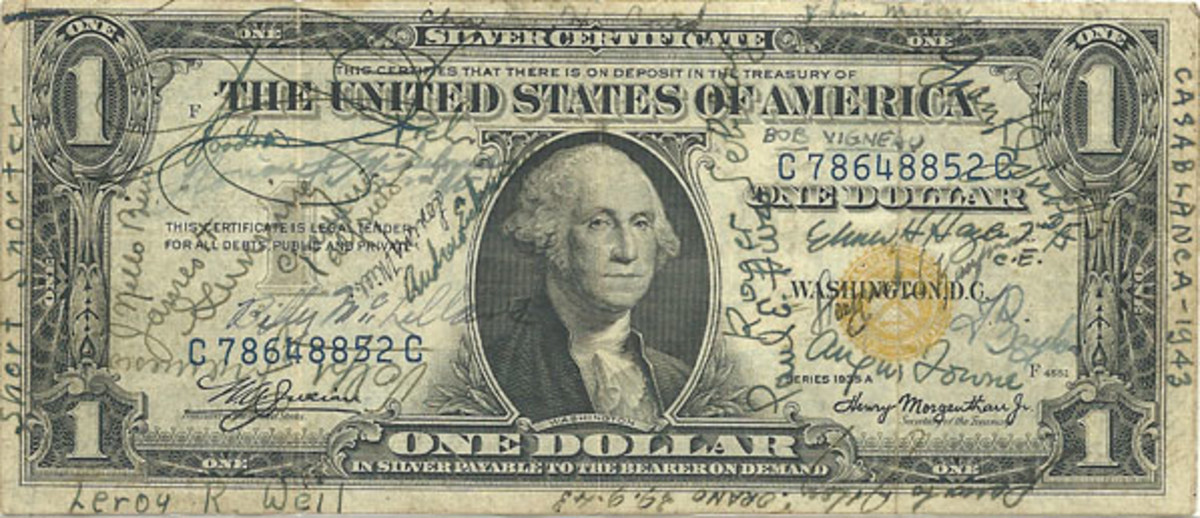


How this practice took on the namesakes of a small shot of alcohol is unknown, however it is said that after the ritual of exchanging these notes, alcohol generally followed.
John Steinbeck once noted that “very curious practices grow out of a war,” but he found none stranger than the oddly-named short snorter.
Feel free to comment with any of your own symbolic coin and currency anecdotes, observations or customs.
Short snorters were also popular with US Astronauts and fetch a lot of money. As an aside, when my father died we placed a silver dollar in each of his hands. As we shoveled the first bit of dirt onto his casket the local ferry whistle blew. One of us said, "at least we know he had the right fare."
They say good things come to those who wait and in numismatics, a case can be made for the 1912-S Liberty Head “V Nickel” 5 cent piece. This key date of the Liberty Head nickel series almost never happened. Coinage finally commenced on Christmas Eve in 1912 and lasted only 4 days. This would be the last year of the Liberty Head nickel series (if you don’t count the 1913 and you shouldn’t).

The San Francisco mint produced a total of just 238,000 V nickels in 1912, making it the lowest mintage of the series by a long shot. Put into perspective, the key date 1885 and 1886 nickels had mintages in the millions but the 1912-S nickel had about half the mintage of the celebrated key date 1909-S VDB Lincoln Cent. Despite a very low mintage, this rarity can be found without too much difficulty in grades up to MS65. In MS66, however, this date becomes truly rare. There are no known MS67’s at either grading service. 10 MS66+’s exist, although some of those are possibly resubmissions.
Quality was indeed a bit of an issue as can be seen by comparing the Philadelphia and Denver mints issues of that year. The Philly and Denver strikes were much crisper. The San Francisco nickels can be seen with a softer overall appearance and weakness on the left side ear of coin on the reverse. On many specimens, the ear is completely flat. You can also expect to encounter die cracks on many specimens as the hardness of the metal wreaked havoc on several sets of dies.
A good example of strike weakness. This coin is graded MS64 by PCGS.

Quality issues aside, this low mintage date did not stimulate much interest at the time. The 1912-S nickel was not alone, however; later in the decade the 1916-D Mercury Dime would be born with a mintage of 264,000 – the lowest of the series and instant key date. This coin too would not be met with much interest. As a whole, mint marks did not hold much importance to collectors until nearly 20 years later. Oh, to be able to go back in time!
Not sure if production was Dec 24 or Dec 26 as the daily logs were not clear.
I have it as 100,000 on December 26 and 138,000 on December 30.
Regardless, they only minted these on 2 days over the last week of 1912.
The following was written by Brian.
Back to Baltimore! The Whitman show is almost always a good one for us and conveniently situated on the east coast, close to home. Unfortunately we needed to fly into DC instead of BWI and that is about a one hour drive from the airport into the city. Still, the weather was nice when we arrived and our flight was only about an hour late; Christmas in June! In addition to the usual gang of Tom, Chris and Brian, our new superstar intern Frank made the trip along with us and he handled the entire show like an old pro. It was great to have him with us.
The next night saw a thunderstorm so intense it knocked the Baltimore Orioles clear into dead last place. Seriously, it was scarier than their staff ERA.
But the next day was really nice!
The dealer pre-show trading was brisk and we were able to make quite a few purchases while moving some of our older inventory at the same time. The rest of the show was also quite good for buying and this is of course great news for our customers.
The show opened the next day and the bourse floor was, ummm, how to put this…roomy! Plenty of space in the aisles to walk and plenty of space behind the booths from which to operate. All this is nice, however, this just meant less tables than in previous shows. The show attendee traffic was light to say the least and there wasn’t much of a ‘buzz’ in the room, but this did not prevent us from doing some solid business! Plenty of fresh coins were offered to us and we’re still in the process of listing them on our site, so be on the lookout in the coming weeks.
Though the dinner dining choices were somewhat mundane this time (we sure do go to Cheesecake Factory a LOT), we did find a nice new Alehouse across the street from the convention center for lunch (no, we did not get any ale for lunch…this time…). We’ll be sure to go back there next time we’re in town.
The following was written by Brian.
The 1918/7-S Standing Liberty quarter deserves a standing ovation. It is without question one of the most heralded rarities in all of numismatics. The fact that it is such an elusive coin coupled with the fact that it is an issue in which the overdate is clear to the naked eye certainly bolster the popularity of this issue.

This error occurred as a result of a die blank being first impressed with a hub dated 1917 and then receiving a second impression from one dated 1918. It was then by chance that this die was then stamped with an S mintmark for shipment to San Francisco. It is a matter of debate as to whether or not this die would still have been used even if detected by the San Francisco engraving department.
The 1918-S Standing Liberty Quarter enjoyed a rather large mintage of 11,072,000 and they would be pressed into service immediately. The war years saw a great demand for fresh coinage and this meant there would not be an abundance of rolls to search through once the variety was even discovered. Since coin collecting and hoarding didn’t really become a “thing” in the US until the 1930’s, this variety sat undetected. As with all coin issues pressed directly into circulation, this will mean mint state and high end AU examples will be a challenge.
A tough enough coin to locate in any grade, in mint state, this coin becomes exceedingly difficult. In gem or better, practically impossible, but it can be done, I suppose, with time and (a good deal of) money.
According to the PCGS census, the finest known top out at MS66 (of which there are only two). The PCGS Price Guide for an MS66 1918/7-S Standing Liberty quarter is $125,000. It doesn’t get much easier locating a gem example as PCGS only has 4 (with the Price Guide at $100,000). MS62, 63 and 64 examples are somewhat more plentiful (about 25 in each grade), but they will still cost you a pretty penny. NGC examples are no less scarce. And please keep in mind; the numbers above are for the non-Full Head designated examples. I won’t go into the miniscule populations and inherent price tags for Full Head examples so as not to discourage (perhaps depress) you. I feel that is part of my responsibility as an author.
Ok, the finest known at PCGS are two MS64+ examples – the most recent of which saw an APR of $336,000 in September of 2020.
The good news, as mentioned above, is that this overdate is easily discernable without the need for a loupe. Indeed, even in lower graded examples, it is easy to see and you won’t be disappointed.

With a bit of time and patience (and a few thousand dollars) one can be obtained.
When it comes to Colonial coins, the 1670’s St. Patrick Coppers are by no means the rarest of the bunch. Sure, they are rare in their own right and some of the higher AU grades have brought 5 figures and up. What makes them so interesting to me is how they were minted with brass 'splashers'.
We’ll take the St. Patrick’s Halfpenny for example.

The St. Patrick Halfpenny was a milled copper coin minted in the 17th century (exactly when is the subject of much debate) in Ireland, England and Wales. The reverse depicts King David jamming out on the harp, while the obverse is a standing St. Patrick in bishops regalia, driving serpents out of Ireland and into the sea (as the story goes). The majority of these St. Patrick halfpennies are copper coins with a splash of brass minted in two sizes, large and small.
The intention of the ‘splash’ was to cover King David’s crown, giving it the illusion of being gold and thereby adding aesthetic value, though nobody at the time would have expected it to be real gold. The method of transfer for the brass to copper is also unknown although some specimens are so sloppy it is speculated that Jackson Pollock himself may have been hired for that work.
Englishman Mark Newby (aka Mark Newbie) is responsible for bringing the St. Patrick’s copper coinage to America. A devout Quaker, Newby sought to avoid religious persecution by emigrating to Ireland. Shortly after, he along with several other families of the same belief sailed to America. Newby landed in West New Jersey and established himself as a banker in Camden. What gives Mr. Newby this interesting footnote in American history is the fact that he brought with him from England enough St. Patrick coppers to facilitate their entry as legal coinage in New Jersey. Indeed there was a pressing need for coinage in the colonies.
What makes this particular ‘splasher’ so impressive is not only the sheer size of the brass splash on the obverse, but the fact that it continues all the way to the reverse. This was a farthing example we had back in December of 2020.

Pretty cool.
The following was written by Brian.
George Washington, the 1st President of the United States died December 14th, 1799 and it was a profound tragedy for the nation. Washington’s memory would be honored via tributes and memorials throughout the United States. Boston, in particular, held three separate memorial processions early in 1800. As part of the processions, mourners would be adorned with newly struck ‘Washington Funeral’ medals.

The medals were engraved by Jacob Perkins of Newburyport, Massachusetts. Coincidentally, both Perkins and Washington were masons by trade. The obverse features simply a left facing bust of Washington. Indeed this man was most revered as the obverse legend reads: He is in Glory, The World in Tears. The reverse showcases a funeral urn with ‘GW’ in fancy cursive inscribed on it as well as important dates in Washington’s lifetime. By no means common, these are the most commonly seen Washington Funeral Medals and they were struck in silver, gold, copper and white metal. Though all are rare, the silver and white metal are most frequently encountered while the coppers are rare and the gold medals extremely rare.
As there were to be three different funeral processions in Boston, one medal would be made for each. The first is the aforementioned image above; again Washington bust left with urn on reverse. The second showcases rather jarring imagery (though not uncommon for the time) with skull and crossbones on the reverse. This ‘memento mori’, or mortality reminder is an ancient Masonic emblem.

Thirdly, a slight variation of the first medal shown has the GW initials below the urn. Even when compared to the very rare first type, the GW below is a great rarity with only six pieces known.



Lastly there exists an oval, uniface medal which is exceedingly rare with likely no more than a dozen specimens struck. This type was not intended to be worn at the processions, per se, but rather to be placed in lockets or in other types of jewelry.


Undoubtedly you’ve noted that all the Washington Funeral medals shown (with the exception of the jewelry piece) are holed. This is because they were all created this way. Now, normally a hole in a coin is a problem. However, not all holes are created equal; these medals were purposely hole-punched because it was required to suspend them. Other holes in coins are indeed considered problems and in most cases lower the value of the coin. This is not the case, however, with the Washington Funeral medal.
Northeast Numismatics is lucky enough to have recently purchased one of these silver medals.

The following was written by Brian.
The 1816 Coronet Head Large Cent is the answer to a pretty good numismatic trivia question: what single US coin has the distinction of being a complete mint set?

It’s true. Although the mintage was fairly high for the Large Cent that year (2,820,982), just one denomination was struck by the Philadelphia mint.
Other years during that era were almost equal in terms of minting stinginess. The year 1815 saw just three denominations; quarters, half dollars and $5 gold pieces.



1813 also saw just three different denominations struck; again, the $5 Gold piece but also the only silver coin produced during 1813 - the Capped Bust half dollar, with a mintage of 1,241,903 pieces. Lastly, the classic head cent was also minted that year with a modest mintage of 418,000.



Why were so very few denominations (and coins in general) struck during these years? Well, most agree that the War of 1812 is to blame. 1813 saw the success of Oliver Hazard Perry over the British fleet at the Battle of Lake Erie. With this, the Philadelphia Mint had been operating under a cloud and the lack of cooper planchets (previously shipped from England but certainly not during the war) was not helpful. Now the mint needed to find its own copper source and also manufacture the copper planchets.
While the 1813 and 1815 mint sets may be tougher to complete, the 1816 “set” of one coin should be obtainable for most. And while not a rarity in the lower circulated grades, the 1816 large cent becomes downright rare in MS64 and an extreme rarity in MS65. With a relatively healthy mintage of 2,820,982, you would think more gems would be saved, however this being the only coinage of the year, they would be pressed into service immediately.
There are a handful of Red Brown examples out there, but only 3 red specimens exist at PCGS (none at NGC).

The following was written by Brian.
1905 was the year that then-President Theodore Roosevelt embarked on an effort to ‘freshen up’ US coinage. Roosevelt believed the current designs on US coins were a bit stale and archaic and he sought to change this imagery across all US coins.
It wasn’t until 1916 when Hermon Atkins MacNeil’s new quarter was designed and selected. At the time, this broke a law prohibiting design changes more than once every 25 years. The next time this law would be broken was in 1932 with the Washington Quarter. Indeed MacNeil’s quarter fell victim to its own special set of circumstances.
Hermon MacNeil was born in Everett Massachusetts, just to the north of the bosom of Boston Harbor and the Atlantic Ocean.

Sculptor, designer, academician and apparent filthy pervert Hermon Atkins MacNeil
MacNeil is also famous for his carving “Justice, the Guardian of Liberty” on the east pediment of the Supreme Court Building in Washington D.C.


The 1916 Standing Liberty Quarter
Unfortunately for MacNeil, his original new quarter design would, in part, turn out to be a bust. The new quarter, the first to include a partially nude Liberty on business strike coins, was met with some opposition. Perhaps it was a prudish outcry for a more ‘decent’ design. There is also the theory that perhaps adding mail to Liberty’s bust would create ‘ready for war’ imagery. There was certainly favor in this regard as WWI had been raging in Europe since 1914. Although this “uproar” ultimately led to a somewhat major change in the original design and the boobirds got their way, fortunately, the rest of the design was not rendered udderly useless. Changes to the Type 2 Standing Liberty Quarter would be made by none other than George T. Morgan, chief engraver.

Side by side closeup 1916 and 1917 Type 2 Standing Liberty Quarter
Lastly, something to stay abreast of with the SLQ’s, is the earlier dated examples, in particular 1916-1925. The date itself is one of the highest points on those years and as such, is subject to wear. It is not uncommon to see very worn or even ‘no dates’ on coins graded Good to even Very Good. This factor is acknowledged by third party grading companies when assigning grades and is something you should keep in mind when filling your treasure chest full of these beautiful US coins.

The following was written by Brian.
The Austrian 1908 Gold 100 Corona – also known as the ‘Lady in the Clouds’. What a great coin. Just look at it in all its majesty.
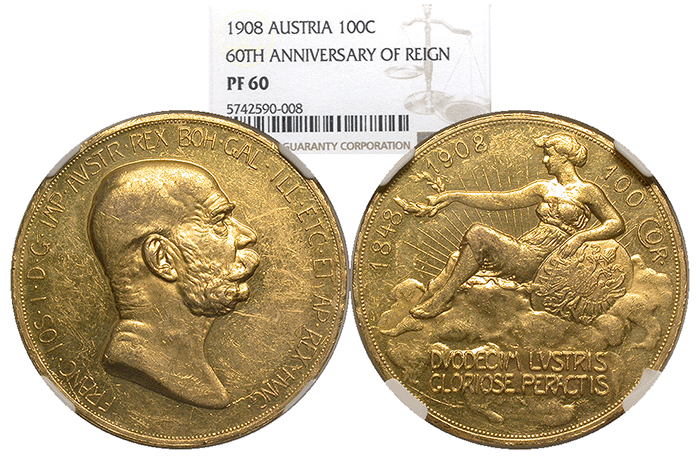
Some might go so far as to call it Austria's 1907 Saint Gaudens High Relief. It features a not uncommon obverse of the bust of a nation’s leader paired with a most uncommon reverse that is loaded with imagery.
The obverse bust is that of Franz Joseph 1. The inscription around the obverse perimeter translates as “Franz Joseph by the grace of God, Emperor of Austria, King of Bohemia, Galicia, Illyria, etc. and elected king of Hungary”. There is also incuse lettering around the edge of the coin with the phrase “VIRIBVS VNITIS”. This would be Franz’s motto throughout his reign and it meant ‘with united forces’. Franz Joseph 1 became emperor of Austria in 1848 succeeding his uncle Ferdinand 1. He would rule Austria for almost 68 years until his death in 1916.
And now onto the glorious reverse. You’ll find the usual assortment of reverse features such as the denomination “100 Cor” which loosely translates as “100 Coronas”. Mmmmm…100 Coronas…. and the Latin phrase “DVODECIM LVSTRIS GLORIOSE PERACTIS” which I’ll assume you already know what that means. Ok, well, if you don’t, I will tell you that it translates as “60 years gloriously accomplished” but you really should brush up on your Latin.
Most importantly, on the reverse is the stunning Greek goddess Clymene (also spelled Klymene), seated or reclining on pillows of clouds. Clymene is seen resting on a shield that bears the Austrian coat of arms. In her outstretched hand is the laurel wreath which signifies fame (as well as achievement, prosperity and status). Clymene was the Titan goddess of fame and renown (and sometimes infamy). She was daughter to Okeanos and Tethys. Speaking of fame, as wife of Titan God Iapetus, Clymene was the mother of the very famous Greek god Atlas (she also bore Prometheus).
You’ll note that Clymene is in the seated position. Undoubtedly this is not the first time you have seen ‘seated’ imagery on a coin. The seated position is primarily a position of rest, but it also conveys ease, power, perhaps sitting and looking over a victorious campaign. The county seat, a seat in the senate or on a court bench – they all emphasize power, importance and fame - and that is what Clymene portrays in this beautiful design.
As a sidenote, the use of mythological imagery is not a new theme by any means. Mythological gods/goddesses as representative images appeared on coinage dating from near the beginning of the very first coins struck. One can find the Greek goddess Athena appearing on coins around the 5th Century BC.
Interesting, Brian. Have you noticed that women who appear on coins this way, including the woman here, often appear to be rather big-boned, sturdy, strong, etc.? Some appear to have more masculine features. I'll bet this is done for a reason.
Quoting the last post:
"... including the woman here, often appear to be rather big-boned, sturdy, strong, etc."
Such is often the case with Northern European women, including as my lovely wife, who is from Germany. There might be some implication to the design, or just a reflection of ordinary reality.
The following was written by Brian.
Every time I see or hear about Maundy Money, I can’t help but start singing ‘Monday Monday’, by the Mamas and the Papas. I of course will sing “Maundy Maundy” to this tune (much to the delight of my co-workers). So, let us dig into the reason for this tune rolling around in my head – Maundy Money!
Before Maundy Money was created, there was an ancient custom in Great Britain dating back to the 13th century called The Royal Maundy. This once-a-year tradition involved British royalty washing the feet of the poor and providing food, clothing. The washing of feet and distribution of food and clothing by monarchs to the poor can be traced back to the 4th century and the origin of this tradition goes all the way back to Christ washing the feet of his disciples on the day before Good Friday.
The foot washing act was discontinued in the 18th century as British royalty undoubtedly came to the foregone conclusion that it was totally nasty. Eventually even the food and clothing allowances would be replaced by money.
At first, the royal family would hand out ordinary coinage of the time, usually silver pennies, but in (approximately) 1662 the first true Maundy Money appeared. The specially struck coins were a four penny, three penny, two penny and one penny piece. They were, however, undated. Here is an example of a Charles II undated Maundy penny.


The four coin dated set began in 1670. Mintages at the time for these sets were very small; usually in the hundreds for any given year and never more than 2,000. And it was not until 1752 that coins not struck for circulation were used for the Maundy distribution.
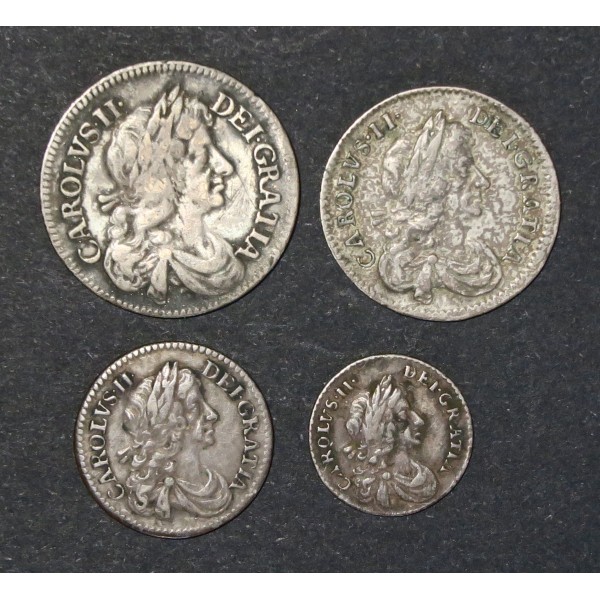
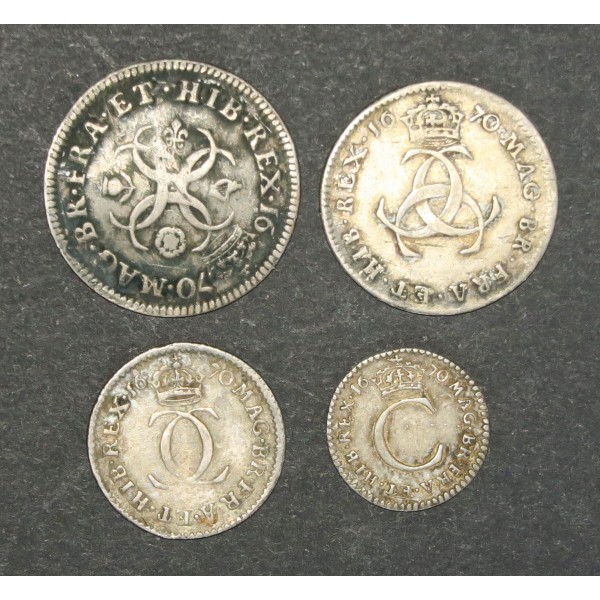
Maundy Money can be found with some pretty spectacular toning as it was traditionally struck in sterling silver. These of course would be pre-1921 (the fineness was reduced to 0.500 in 1921). Check out this 1884 Silver Maundy 2 Two Pence Queen Victoria Young Head.

Today, this tradition continues, but the money is not distributed to the poor. The royal family selects one cathedral to give out the Maundy Money. A red purse and a white purse are given to each of the selected parishioners; the red containing money in lieu of food and clothing and the white purse containing the ceremonial Maundy money set. The number of recipients (a male and female each) of the money reflects the monarch’s age. Given the queen’s advanced age, this has had a catastrophic effect on the royal family bottom line. The Maundy coins of today are legal tender but rarely spent because of their symbolic value.

The following was written by Brian.
Marquis de Lafayette was a celebrated 18th century French nobleman and a central figure in the American Revolution. Although orphaned in his early teenage years, Lafayette had been born into nobility in the Auvergne region of France. By the time he had been orphaned however, he had already amassed quite the massive inheritance. He would later use this fortune to aid the colonies in a time of great need.
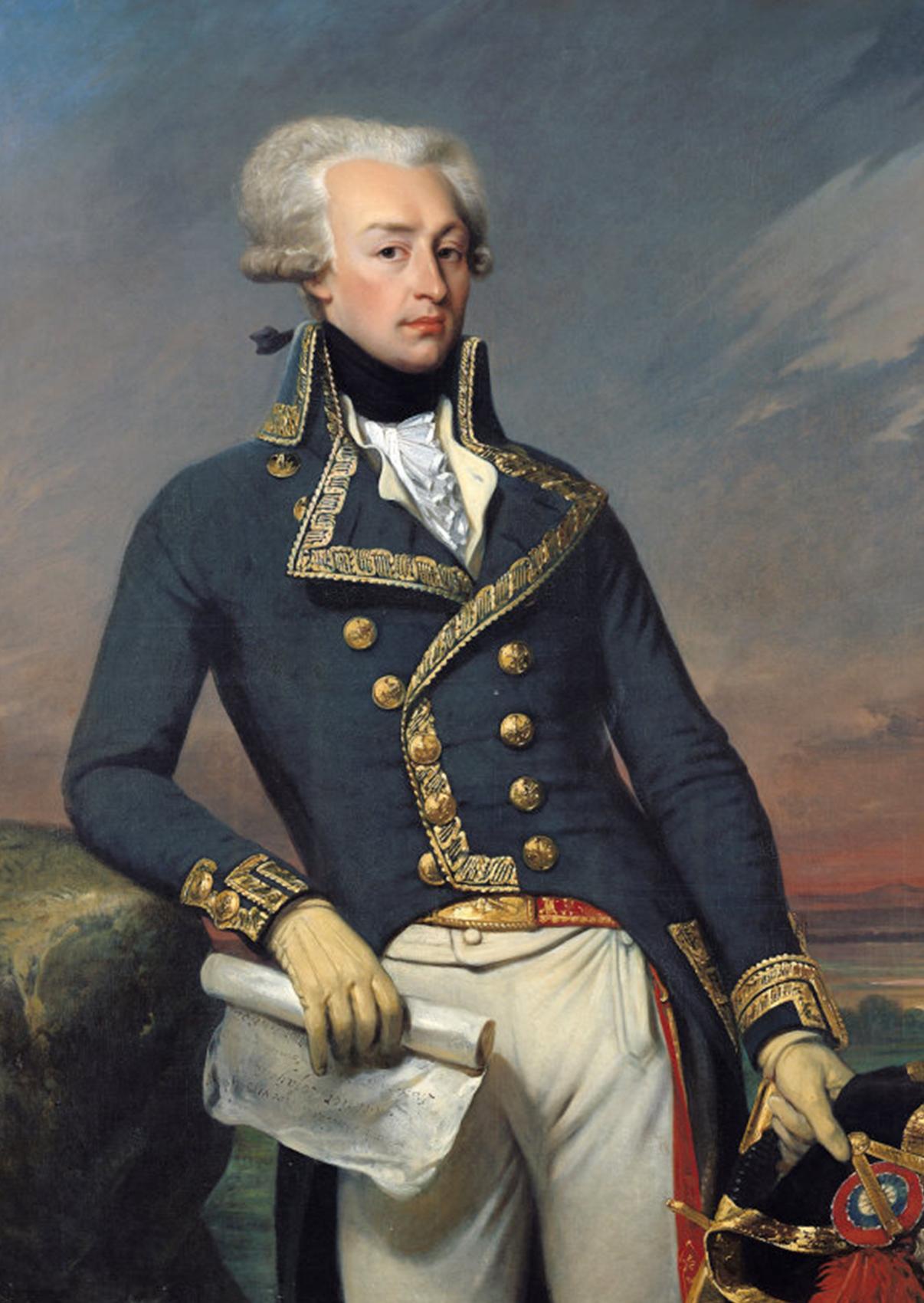
Lafayette left his life of privilege to assist, indeed fight alongside American colonists, the British forces as a Major General in the Continental Army. He would also become close with Benjamin Franklin and George Washington. But most importantly he would be a critical tactical advisor to the American troops and use his influence, power and wealth to bring forces, supplies and even naval ships from France. Lafayette was a true ‘American’ hero.
Fast forward to the Paris Exposition of 1900. The United States was invited and US leaders decided a fitting contribution would be a statue of the great Marquis de Lafayette, to be sculpted by Paul Wayland Bartlett. In order to raise money to pay for this expense, the Lafayette Monument Fund was created (and supported mostly by schoolchildren’s donations).
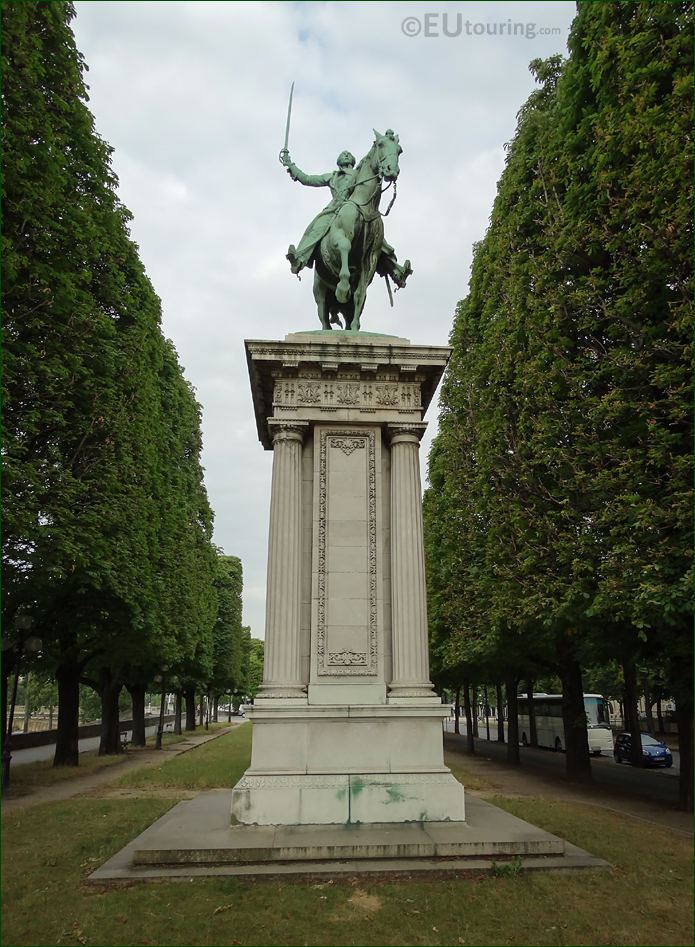
The Monument Fund would not be enough to cover the expense and so the Lafayette Silver Commemorative dollar was born. Chief Engraver of the Mint, Charles E. Barber would be given the honor of designing the coin and 50,000 were to be struck. These would be sold at $2 each with the proceeds going to the making if the statue. Note that some 14,000 were returned to the mint many years later and would end up being melted in 1945. This is why the total mintage today is listed at 36,000.
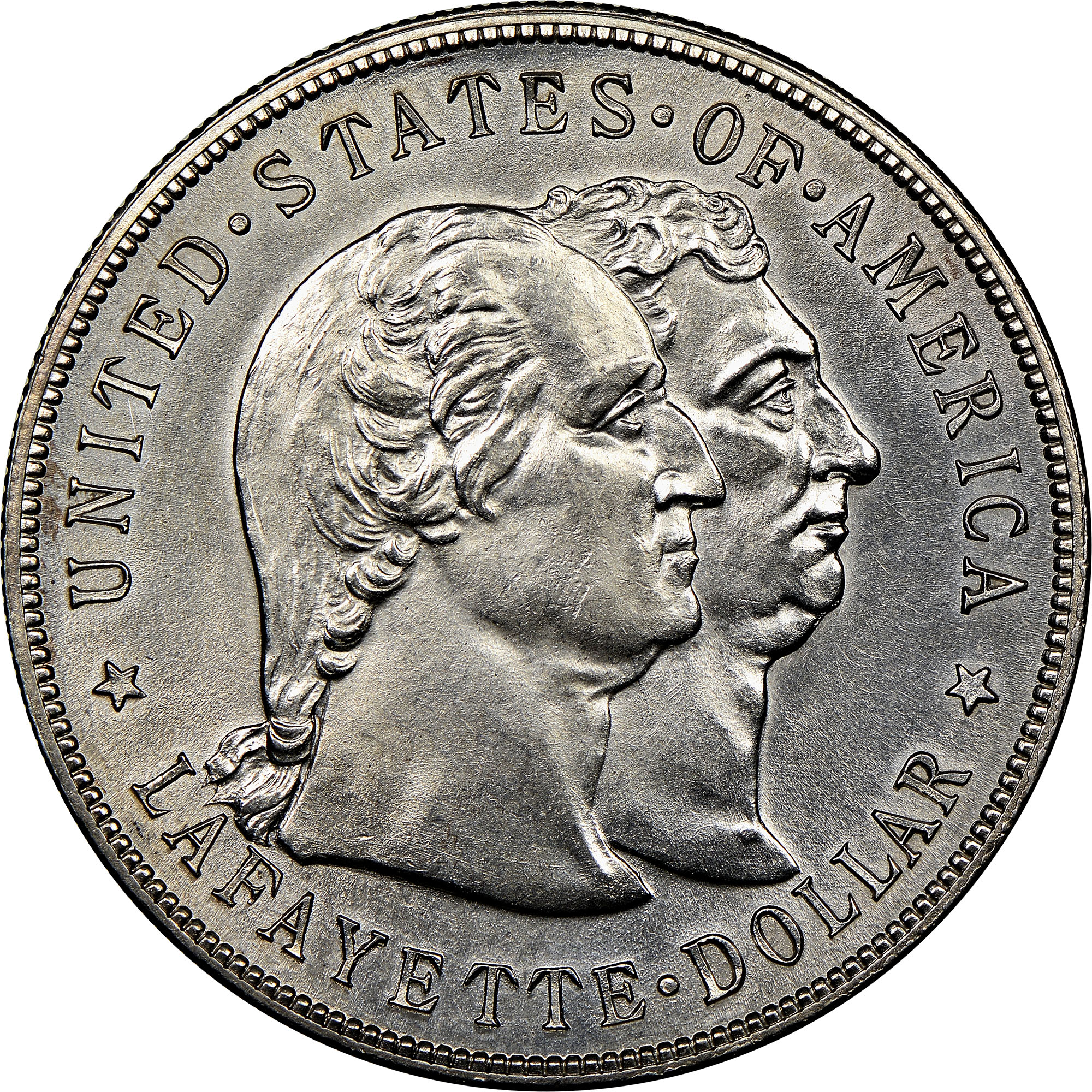

This was the first commemorative dollar struck by the US Mint (and the last until many, many years later in the 1980’s). The obverse features the busts of Washington (in front) and Lafayette. Note that this is the same obverse bust that would be used in the design of John Flannigan’s Washington Quarter years later. Although all the coins were struck in one day (December 14th 1899 – the centennial anniversary of Washington’s death), the reverse of the coin bears the date 1900. The reverse also features Lafayette mounted on horseback and the legends “Erected by the Youth of the United States in Honor of Gen. Lafayette. Paris 1900”.
The following was written by Brian.
I’m pretty sure this is my very first show report. Normally Chris or Tom give you the lowdown, but we’ve decided to give their tired angle a rest and offer a fresh, new perspective of one of our favorite shows from your favorite author – me!
As usual, the flight was uneventful and we landed on time, so off to our usual Airbnb we went. We love this place; affordable, large, clean and conveniently located about a mile from the Orange County Convention center – which is great because that place is enormous! We’re talking the second largest convention center in the US large. 7 million square feet of total space big. The main span of the Brooklyn Bridge could fit inside the West Building's contiguous exhibition space. Huge. You could fit 3.7 Rhode Islands inside it. Ok, I lied about that last part, but you get the picture. It’s really big. Bigger than Elaine’s really big salad. One more note of interest; this was the first time we attended a show and did not go out to dinner even once! A lot of deliveries and a lot of waiting, but these services are great and they pickup almost anything from almost anywhere nowadays.
On to the show!
As we try to do with every show, we arrived a day early to try to do some pre-show trading with other dealers (this is one of the ways we have of getting our fine collector base fresh inventory). However, due to (you know what is coming) Covid protocols, we were unable to meet in a rented space inside the convention center. That’s right, the OCCC would not rent us large rooms to conduct a little biz before the show. This was because of Covid, you see. You could go to the show the next 5 days and mingle/sneeze with/on strangers, not follow safe distancing practices and not wear a mask (yes, the overwhelming majority were not wearing masks and it was not enforced), but 25 or so of us couldn’t rent a large room for a few hours. Got it! Perfect sense!
Rant over.
The actual show, however, ranks up there with one of the better FUN shows for us. Not every dealer that we normally do biz with was there and that was kind of a bummer, but for the most part the usual suspects were in attendance, which is great for me! As the wholesale sales guy, my days are spent walking the floor showing our wares to as many dealers as possible. After two years of no FUN shows, I must admit it was really nice to see some old friendly faces. The sales were good, great even. Buyers were robustly buying and that’s always a good thing for our industry. Perhaps more importantly, we ourselves were able to buy a good amount – over 350 new pieces. The retail side was strong as well with strong attendance numbers.
With the show now over, we (most of us) packed up our belongings and new coins and headed to the airport, saying goodbye to warm sunny weather only to welcome the beautiful climes of New England in mid-January. The flight home was uneventful, although Tom and I were without Chris, as he decided it would be best to drive to Miami, sit in the rain and watch our Patriots lose in humiliating fashion.
Nice read, Brian!
And...350 new coins...!
Sorry your Patriots lost...
Hope to see more from you!
Pat and Mary Jo
The following was written by Brian.
Normally this would be called a ‘Part II’ follow up to the last blog about the fabulous Gold $4 Stella, but this time we’ll be discussing something far rarer – the 1879 Gold Twenty Dollar Stella.
While the Gold $4 Stella has enjoyed immense popularity over the years, it’s scarcer, much lesser known counterpart has slid under the numismatic radar for the most part.
Here she is, in all her glory. Just 1 of 5 known (1 of which is in the National Numismatic Collection in the Smithsonian) and commonly referred to among numismatists as the “Quintuple Stella”
As with the $4 Stella, the Quintuple Stella is a proof-only pattern (Judd-1643). Also like the $4 Stella, it was meant to facilitate international trade and travel. There had been a schtickle of effort toward this goal earlier in the decade, specifically with the 1874 Bickford pattern $10 gold pieces, but 1879/1880 were the years that serious endeavors were made to accomplish these aims.
Here’s the Bickford example; an interesting design in its own right.

Like the other Stellas, the $20 Quintuple was designed by John Barton Longacre. Around the head is the legend +30+G+1.5+S+3.5+C+35+G+R+A+M+S+.
Fun facts: The last sale of a genuine $20 Gold Stella brought $1.88 million. The US Mint also produced other $20 Stella patterns including copper and gold plated examples.
Pretty cool!

Thank you for sharing this amazing piece, very nice to know!
The following was written by Brian.
If you saw it, you never forgot it. Marlon Brandow’s legendary scream to his wife in the 1951 film A Streetcar Named Desire. So cool. Just so damned cool.
Almost as cool is another legend – this time in the field of numismatics; the 1879 and 1880 $4 Gold ‘Stella’.


What a great issue and certainly a coin that you will find in every edition of the book 100 Greatest US Coins by Jeff Garrett (usually near the beginning of the book – top 20).
During the mid 1800’s, the United States had difficulties getting congressional approval for an international gold coin. Despite several attempts, nothing had moved forward until 1879 when the US Minister to Austria John Kasson (he was also the former Chairman of the Committee of Coinage, Weights, and Measures) suggested a US gold coin be created similar to the Austrian 8 Florin piece. The coin would have metallic content stated in metric units and would approximate in value the Spanish 20 pesetas, Dutch 8 florin, Austrian 8 florin, Italian 20 lire and the French 20 franc among others. The hopes of representing in metric units was that it would be easier for Europeans to use and it would aid in international trade and travel by US citizens. Its namesakes come from the Latin word for star “stella” and indeed the reverse bears a 5-pointed star.
Two US Mint chief engravers Charles Barber and John T. Morgan were responsible for the designs and the two portraits were very different from each other; Barber’s version displayed loose, fluid locks, while Morgan’s featured a tight, coiled, braided hair style. Each year – 1879 and 1880 - feature a flowing hair and coiled hair design amounting to 4 designs in total.
As mentioned, there are 4 known varieties, but the most readily available is the 1879 Flowing Hair Stella. This was a proof-only issue (as were the others) with a mintage of (about) 425 that were given to members of congress. It is said that many of the 1879 Flowing Hair Stellas were given to mistresses of these congressmen, which would explain the large number of ex-jewelry pieces. Now that’s a spicy coin-a! Although the 1879 Flowing Hair variety has the zesty back-story, the other 3 varieties are significantly rarer. The 1880 Coiled Hair has a mintage of just 20, but all 4 bring huge premiums at auction when and if they show up. A very tough, but most beloved and interesting US coin.
The following was written by Tom.
Around 20 years ago we started our current invoicing system, beginning at invoice number one. Today we reached a significant number; we created invoice number 100,000. It means little in the big picture other than to show that Northeast has been busy these past couple of decades. We are proud of our consistent daily activity and fair dealings of buying and selling with collectors, investors, and dealers, all while under the same ownership. We thank you, our customers, for making it all possible. We look forward to reaching the next big milestone!
Congratulations!
The following was written by Brian.
One of the most historic events in world currency came in the year 1497 with the creation of the Spanish ‘8 Reales’ silver coin. For many, many years after the first minting, these 8 Reales would be the standard of global currency. The 8 Reales was known as the Spanish Dollar but also was referred to as ‘pieces of eight’. At the time it was the largest denomination silver coin in the New World. The coin boasted a 38 mm diameter size.
For comparison, here is an 8 Reales next to a Morgan Dollar.

These coins were minted in Potosi, Bolivia where the main 'silver mountain' and mine were located. The harsh reality is that thousands of indigenous people were held as slaves to operate the mine. Many died due to the harsh conditions and the demand for silver to pay for Spain's military initiatives. This, however, did nothing to diminish the coins’ impact on world currency and one could say that it was the first uniformly used global currency.
The Spanish dollar coin was worth 8 reales (a unit of currency in Spain) and could be physically cut into 8 pieces or ‘bits’ to make change and indeed this was a very real practice. The Spanish Dollar could also be cut into quarters or even halves.
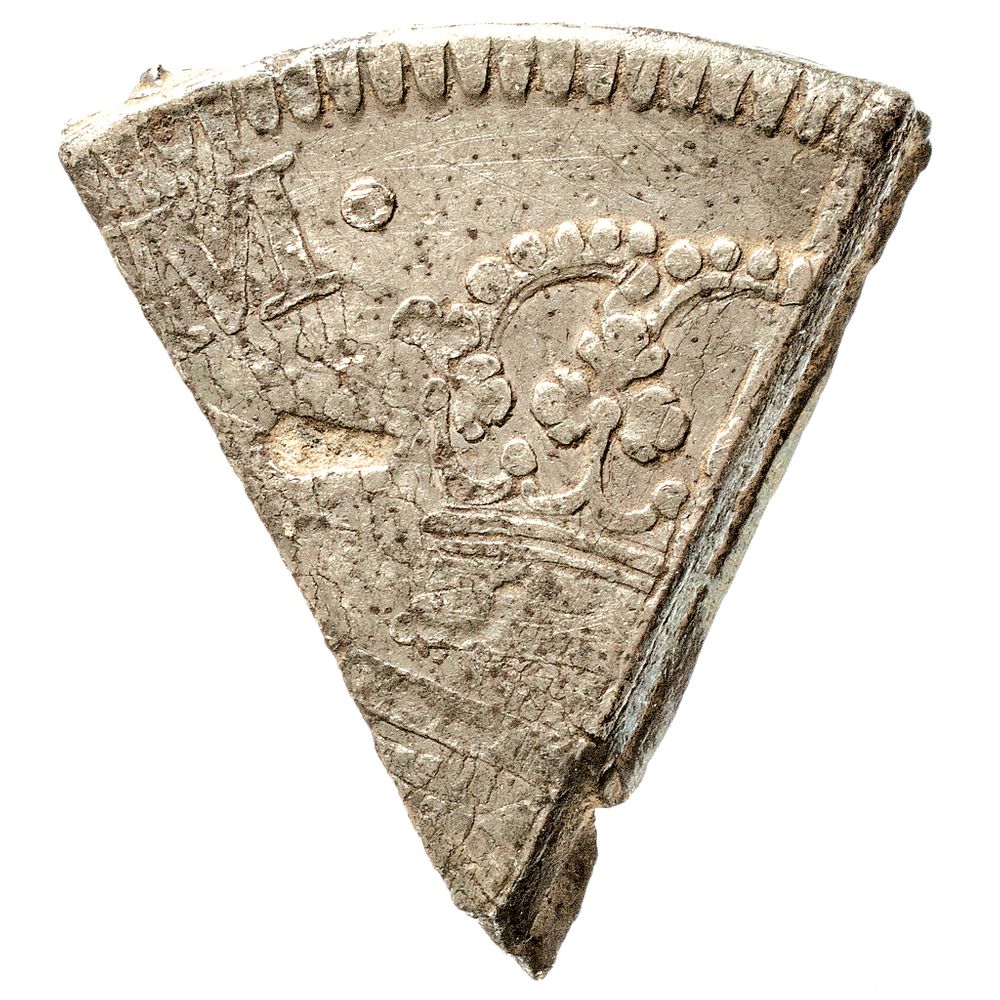
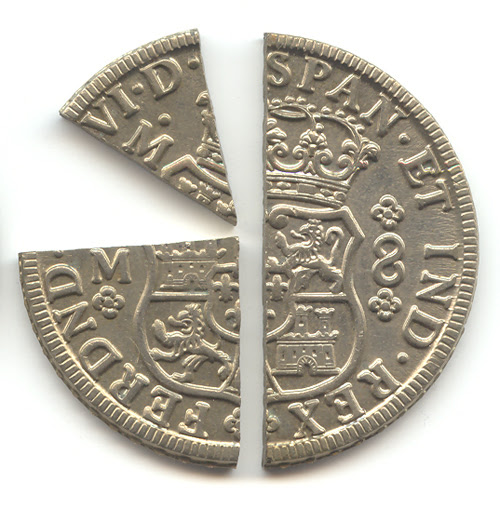
Here is a modern representation of how the bits might be cut.

If you’re like me, you immediately think of a pie chart when viewing these bits. Here was my first thought and an example we can all wrap our heads around.

Spanish coins were increasingly popular and were preferred over other currency because they had a milled, or patterned edge, which prevented the practice of shaving down the edges of coins without being detected. Many years later, the United States and Mexico would adopt a similar style silver dollar/peso.
For this particular Spanish Mexican colony piece (below), the obverse has a profile portrait of King Charles IV and reads “Del Gratia 1805 Carolous IIII,” (Charles IIII by the Grace of God, 1805). The reverse shows an image of Spain’s Pillars of Hercules lesser royal coat of arms and reads, “HISPAN ET IND REX M 8R T H” (King of the Spains and the Indies, Mexico, 8 reales).
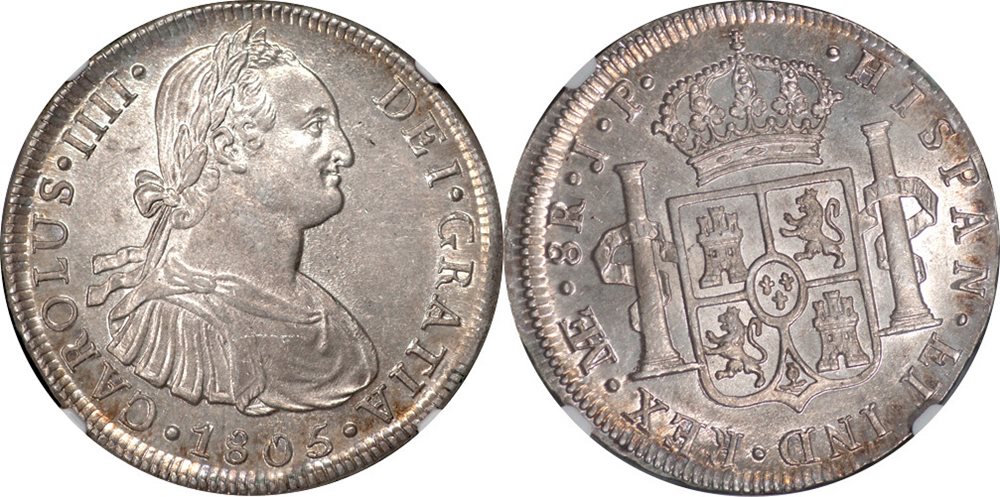
The ‘M’ is for Mexico, but more interestingly, the ‘T H’ on the reverse refers to the assayers initials; one for each of the first letters of the first names of the senior and junior assayer. In this case, the TH is for Thomás Butrón y Miranda & Henrique Buenaventura Azorín.
A great coin indeed and the popularity of this coin continues to this day. But hey, that’s just my two bits. The most important take from all of this is that you now know truly how much a shave and a haircut will cost you.
Fall is a wonderful time to travel in New England, especially by car. This is the season that many thousands of ‘leaf peepers’ will descend upon sleepy towns in the northeast to be dazzled by vivid displays of the changing season. Apple orchards, cider donuts, pumpkin-fests, decorative gourds and of course the foliage are among the many wonderful features to enjoy during your stay.

Believe it or not, this isn’t Photoshopped!
Another perhaps lesser known New England attraction can be found in Cornish New Hampshire. Cornish is a pleasant 2 hours 15 minutes drive from Concord, MA (home of Northeast Numismatics) on the New Hampshire-Vermont border. Cornish is also home to the Saint Gaudens National Historic Park. Within the park grounds you will find the home of Augustus Saint Gaudens. St. Gaudens was one of the world’s preeminent sculptors of the 19th and 20th century and he made Cornish his summer residence from 1885-1897 as well as his permanent home from 1900 until his death in 1907. The grounds also feature many of his bronze sculptures, the Blow-Me-Down farm, dance hall, nature trails, monuments, statues, memorials, atriums, flower gardens, ponds and wide open fields that showcase views across the Connecticut River to the Vermont mountains.

Main House and Flower Gardens

Shaw Memorial on the Bowling Green
St. Gaudens was well known for his ‘Beaux-Arts’ generation sculptures and was quite famous during his lifetime. Some of his major achievements include the Civil War Robert Gould Shaw Memorial which still stands on Boston Common, the General John Logan Memorial in Chicago’s Grant Park and a plethora of other works too voluminous to name here.

Robert Gould Shaw Memorial honoring the 54th Regiment
It is said that St. Gaudens was a good friend of Teddy Roosevelt. Roosevelt, early in his time in office, was unimpressed (to put it lightly) with the designs of US gold coins and he developed a scheme to change that. St. Gaudens was commissioned to lead the way for these advancements and was charged with designing a $20 gold piece, a $10 gold piece and a cent (which was never minted). Many consider his gold $20 Double Eagle to be the most beautiful in all of US coinage. Here is one of the finest known of his $20 designs.

And of course the $10 Gold Indian Head

The most famous (and perhaps most controversial coin in US history) is the 1933 $20 Double Eagle of which only 13 remain and just one privately owned. This particular specimen just sold for 18.8 million dollars in June 2021.

Perhaps second only to the ’33 Saint is the equally famous and certainly more attainable 1907 $20 High Relief. This important US coin comes in two varieties; the Wire Rim and Flat Rim, although they are not true varieties as the two different strikings were not planned by the mint, but rather a result of a rather tedious striking process (each coin required 5 blows by the equipment in order to bring up the design elements fully).

Beautiful American coins designed by a very talented American artist. If you’re ever in New England you should definitely make this one of your must-see attractions.
I'm a little late to the party here but I agree that a visit to the St Gaudens' home is well worth the visit. My wife and I visited in September of 2021. If you're coming up from the south you'll pass by the Cornish-Windsor bridge, the longest covered bridge in the United States.
Bring your pup with you and have it qualify for a "Bark Ranger" badge. All-in-all a great place to visit. And, if you stay overnight in the Lebanon area, be sure to visit the Four Aces diner for a really good breakfast.
My vote for the prettiest coin designed by St Gaudens is the $10 Indian head.
The following was written by Brian.
Feuchtwanger! It’s just fun to say and it seems that there are a few acceptable ways to pronounce the word.
Foist-fahnger (the ‘g’ is soft).
Fyooch-twinger (the ‘g’ is like the ‘g’ in ginger).
And finally, Webster’s dictionary has it broken down as foikht-vahng-uhr
Regardless of how you pronounce it (and I’ve heard some very, um, let’s say unusual attempts) it is a pretty cool, well designed and interesting coin.
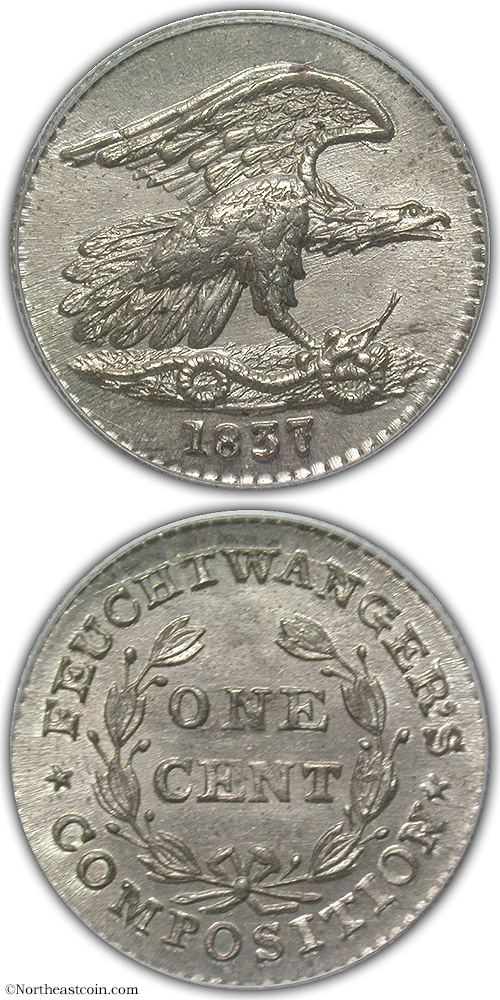
MS65 Feuchtwanger Cent
The Feuchtwanger cent, which is technically a token, was minted privately in 1837 by a Bavarian-born chemist and pharmacist named Dr. Lewis Feuchtwanger. The token coins were struck in “German Silver”, a composition of nickel, copper, and some zinc. These cents were no joke either - they were widely accepted and circulated. Like the Liberty Dollar, this was back during a time when the manufacture of such commerce was not unlawful.
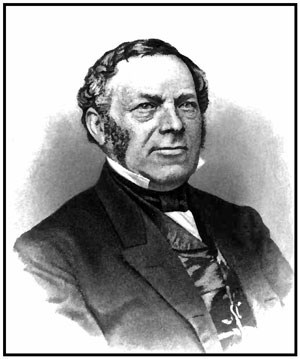
The good doctor.
‘German Silver’ had already been circulating in Europe when the doctor proposed that his coinage replace the Braided Hair Cent (which was 100% copper). And so Dr. Feuchtwanger presented his cent to the US Mint, but it was ultimately rejected due not to the design, but the metal composition. However, the year 1837 saw much uncertainty and concern with the US banking system and the Federal Reserve. So much so that many people were hoarding coins - silver coins in particular. This may account for a good number of extant coins being mint state or having light circulation.
Though the token cent is far more popular among collectors, Feuchtwanger also developed a Three Cent piece that saw heavy circulation in its heyday.
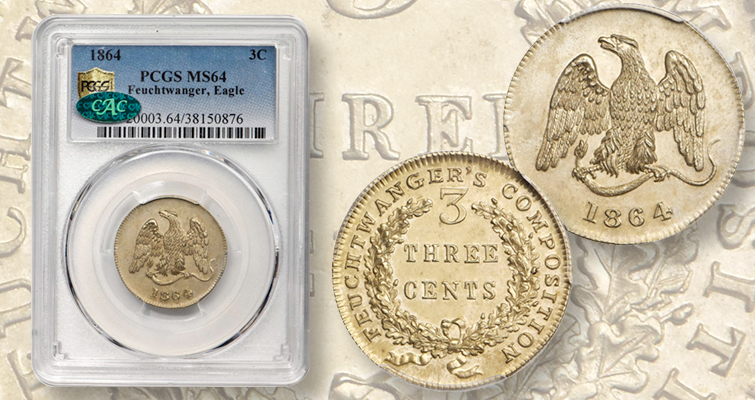
Feuchtwanger 3 Cent Piece
Such a neat coin, embedded with history, and it doesn’t cost an arm and a leg to own one in the lower grades. So let’s say it one more time…
Feuchtwanger!
The following was written by Brian.
We recently purchased a large group of coins from a longtime customer of ours and the group included about fifteen 1937-D “3 Leg” nickels, many of those of which were in high XF and upper AU grades. There is little doubt as to the immense popularity of this particular numismatic rarity; it ranks right up there with the 1909-S VDB Lincoln Cent, 1955 Doubled Die Obverse Lincoln Cent and the 1942/1 Mercury Dime.
Upon examining some of the higher end non-MS examples I noticed that many of them were close to qualifying as Mint State and without doubt would have been sliders back in the days of the Wild Wild West (pre-TPGCs).
The Buffalo Nickel series may indeed be the most difficult type to grade and an important distinction (among all coin types, really) is if the coin has seen circulation or if it is Mint State. Grading coins often begins with the obverse of the coin, but with Buffalo Nickels it should start with the reverse and in particular, the hip bone/flank area. As we know, many (if not most) issues in this series were poorly struck and because of this, some coin features are difficult to discern in terms of wear vs. weakness. For instance, you can have a well struck Mint State coin with a clearly defined and well-rounded hip bone area.
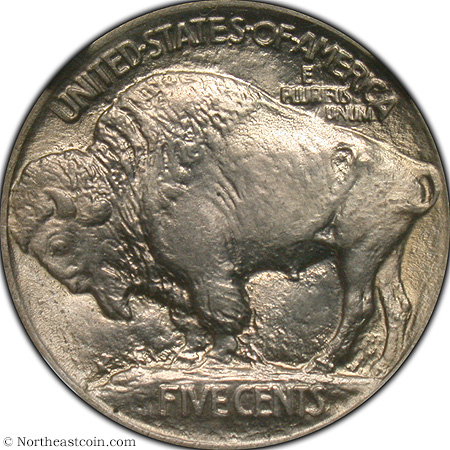
Conversely, you can have a weakly struck mint state coin with the hip bone/shoulder area not nearly as well-defined.

Again, neither of the above coins has wear, but due to striking you can see a big difference in the definition of the hip bones and this can really become a big factor when determining upper AU and lower Mint State examples.
When Buffalo Nickels have been circulated, the wear on the hip bone and flank underneath it is known as the “mesa affect”. In Spanish, mesa literally means table. In essence, that area flattens much like a table and it will be accompanied by a dullness in color. Here’s a sold XF example where you can clearly see the mesa affect on the hip bone and also rub on the upper shoulder area.

Here, however, is an example of a coin graded AU58 by NGC. Notice just the lightest hint of wear in the aforementioned areas. As Willie Shakes would say, “ay, there’s the rub.” This is another good reason to keep the loupe on hand and use it.

After looking at the reverse for the telltale signs of wear, be sure not to ignore the obverse as it can confirm your analyses.

The following was posted by Brian.
Key Denson Pittman (September 19, 1872 – November 10, 1940), a democrat from the state of Nevada was elected to the US senate in 1913 and served until his death in 1940. Among his notable legislative contributions included the Pittman-Robertson Wildlife Restoration Act of 1937. He also served as president pro tempore and chairman of the powerful Foreign Relations Committee. Although many pieces of legislation bore his name, it was the Pittman Act of 1918 that is often noted as greatly affecting the numismatic hobby to this very day.
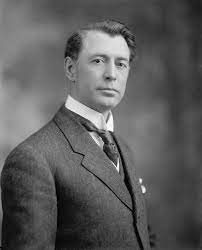
The Act authorized the conversion of “not exceeding 350,000,000 standard silver dollars into bullion and its sale or use for subsidiary silver coinage, and directed purchase of domestic silver for re-coinage of a like number of dollars”. In addition to the melting of silver dollars, under the act, an equal number of Silver Certificates would be eliminated and the certificates would be replaced by the new Federal Reserve Bank Notes. The new notes would include for the first time $1 and $2 bills. A grand total of 270,232,722 silver dollars were hence melted and converted into bullion; the majority of which was sold to Great Britain. The main reason for the act was in fact to finance the war in Europe, however American mining companies benefited greatly since every coin melted needed to be replaced one-for-one by a new silver coin. The resumption of Morgan dollar production in 1921 as well as the new Peace dollar up until 1934 would be sufficient to fill this need.

The Pittman act would of course have a great effect on the rare coin market. ‘Survival estimates’ is a term used to describe approximately how many coins are extant today. The Pittman Act although certainly the largest conversion to bullion was in no way the only time in American history that coins were melted down for one reason or another. There have been many issues along the way that suffered this fate, most often due to the American populace’s response to new (usually fractional) coinage. The Pittman Act, however, did not account for which dates and in which numbers those dates were melted. We can make guesstimates based on current population reports from the third party grading companies and researchers, but unfortunately it will forever remain an unsolved mystery as to truly which ones and how many were melted.
Further complicating matters is the fact that though over 270 million dollars would be melted, this number represented probably 50% of the total of silver dollars in vaults at the time. This means that many millions of silver dollars would eventually be released by the bag for sale – but not until the 1950’s and early 1960’s! Before that, a tough date could mean that it had been melted or it had simply not reappeared yet. For many dates, this resulted in the ‘rare yesterday, common today’ phenomenon. For example, a few New Orleans dates, most notably the 1898-O, 1903-O and 1904-O were all tough. Assumed to be casualties of the Pittman Act, these would be key dates at the time. However in 1962, bags of these dates (especially the 1903-O) began to emerge from the Treasury and thus rendering them as somewhat common.
There are of course many other dates affected and countless theories as to which ones and how many were melted. Perhaps we’ll explore that at another time, but as this is a blog and not a book, I’ll close this chapter and thank you for reading!
The following was written by Brian.
In my last post, I discussed the 1914 $2.5 Indian and we learned that the most common way to fake this coin is via die transfer. For those that did not read the last post, you are of course encouraged to do so, but in essence, the die transfer method is done by taking an original issue coin and transferring the details onto the counterfeit die, which is then tooled to hide the sins and eventually used to strike the fakes.
The 1914 $2.5 Indian had a mintage of 240,000 however, which makes the availability of a quality original to work with possible. But when the size (diameter-wise) of the coin goes up and the mintage goes down, sometimes the die transfer just isn’t the best (or easiest) way for these lowlife counterfeiters to make the fakes.
This brings us to #3 in our series; the 1893-S Morgan Dollar. Easily one of the most recognizable key dates in numismatics, the 93-S Morgan had a mintage of a scant 100,000. Many consider the 93-S Morgan dollar the true “King of the Morgans” due to the simple fact that the 1895 proof is A) a proof issue and not a business strike, and B) basically unobtainable by all but the very wealthy. Mix these factors together along with the potential for massive profits and you have a recipe for counterfeits. Indeed, much like the King of Rock and Roll - Elvis Presley, this king also has its throngs of copycats.
The counterfeit 93-S Morgan $ is a bit different than the aforementioned 1914 $2.5 in that it employs an added mintmark. 1893 Philadelphia Morgan Dollars, while a lower mintage in their own right, are most often called into service for making of a 93-S.
As usual, I’ll show you a very nice authentic 1893-S Morgan Dollar.

Now let’s take a bit of a closer look at the mint mark of a genuine, since that is one of the tells.


Since there were two reverse dies, you’ll see these two very slightly different mintmark orientations.
Here’s an altered mintmark

While the mintmark above itself doesn’t look horrible, you can see discoloration around the ‘S’ and that is a dead giveaway. Any time we’re moving metal, there will be some slight discoloration.
The date alone (thankfully) is not the only marker of a genuine 1893- Morgan Dollar. The “rabbit ears” in left foot of “R” in LIBERTY and the die scratch in top of the “T” in LIBERTY are seen on all but the lowest grade authentic pieces.
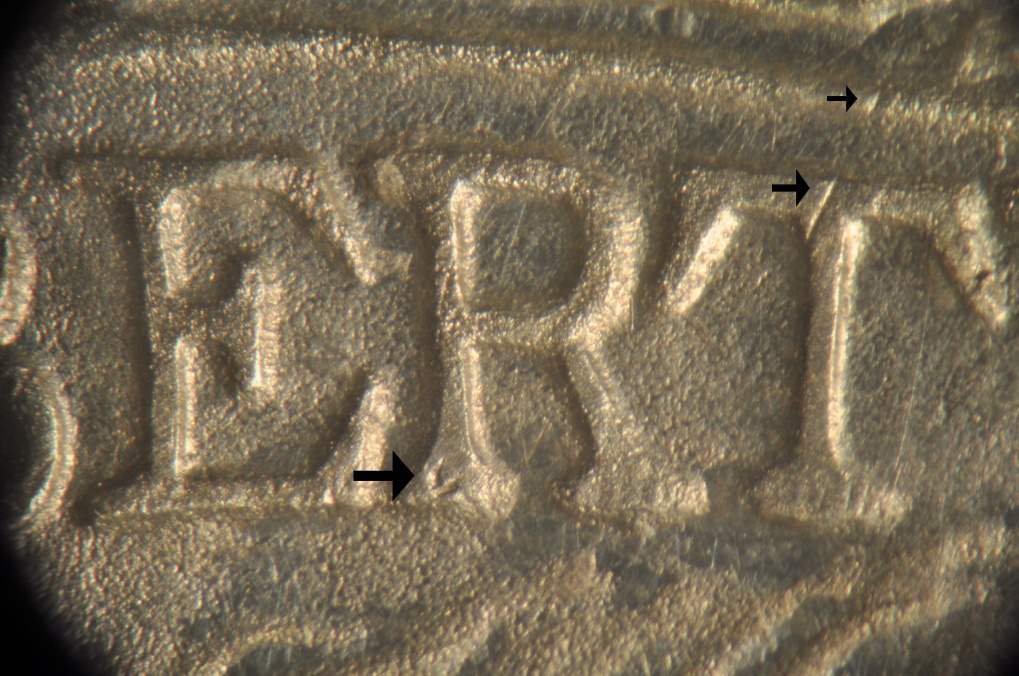
Lastly, the date is another giveaway with counterfeits. A genuine 93-S will have the ‘1’ directly over the denticle and the date is slightly tilted to the right. Here’s a good one.
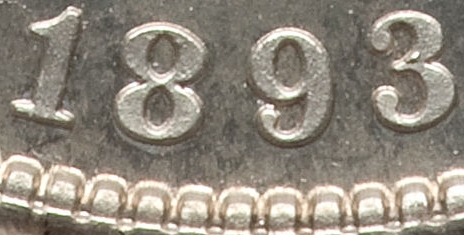
Ok, so now you’re loaded for bear! But as always, my advice is to buy only NGC or PCGS graded pieces when it comes to purchasing rare and expensive dates. Don’t get burned!
Always interesting, Brian.
The following was written by Chris.
Last week I attended a coin show for the first time in nearly a year and a half. The 15th Annual Summer FUN show was held in Orlando. While there are probably more preferred places to be in the middle of the summer (H-O-T), I was excited to finally go to a show. It was probably the largest summer FUN I’ve attended, full of other dealers desperate to attend a large, non-regional event.
Both Brian and I were planning on attending, with Brian’s main efforts to have been focused on getting as much of our limited inventory as possible in front of other dealers. Unfortunately, Brian was sidelined with major knee surgery, so I flew down by myself with the goal of buying as much as possible. The show did not disappoint.
Except for some hotel room coin buying before the show, nearly all my business occurred within a twenty-foot radius of my table. I was fortunate enough to have first/early shots at some wholesalers’ inventories, so my first two days were non-stop buying. Only near the end of the second day was I able to venture to the first aisle of the bourse, where I picked up a handful of newps. That was as far as I made it. My third and final day was abbreviated (I was flying out that afternoon), so that was spent back at the table doing some more buying and taking care of paperwork.
I was not the only one there for the sole purpose of buying new inventory. A few other dealers who normally bring significant inventory to coin shows only showed up with their checkbooks. Despite the competition, I was able to pick up three double row boxes of newps. (These will start hitting our site next week, so stay tuned.)
This “new” coin market we are in remains quite strong, with coins bringing levels we have not seen in over ten years, and it’s not just Morgan Dollars. If you showed up with nothing more than a Greysheet, you likely went home with almost nothing to show for your efforts.
I know many dealers, ourselves included in the past, like to incorporate their dining experiences into their show reports. I would do so here, but that would have meant I actually ate. Aside from some lemon drops I brought and some beef jerky that a coin dealer friend of mine hooked me up with, I went sans food during the show hours. The evenings consisted of hotel food in my room, so I’m sorry to disappoint in this aspect of the report.
We have the ANA World’s Fair of Money coming up in Chicago in August, and Tom, Brian (on a scooter), Frank, and I are looking forward to attending!
p.s. I flew from Orlando to NOLA to visit my family, and I more than made up for the disappointing dining experience I had at the show. Anyone who has been to New Orleans knows how amazing the cuisine can be.
The following was written by Brian.
Next up in our continuing series of counterfeit detection is the 1914 $2.5 Gold Indian. There is no debate that this issue is a key date as it has the second lowest mintage (second only to the key date 1911-D) in the entire series. The 1914 $2.5 is only slightly less rare than the lower mintage and much higher priced 1911-D.
It probably goes without saying at this point, but I will stress once more that a collectors’ best protection against purchasing a fake is buying only certified coins graded by the top tier third party grading companies. I will repeat this advice in every blog post regarding this topic until I’m told to stop.
The 1914 $2.5 falls into the “Outright Counterfeit” group, as it is produced from a counterfeit die (as opposed to say, an added mintmark or altered date counterfeit). Only 240,000 pieces were struck, and that makes the 1914 Gold Quarter Eagle quite the desirable piece. Unfortunately, with that kind of rarity comes the scourge of counterfeit coins.
Here is an authentic 1914 $2.5.

Perhaps it is the incuse design that gives collectors and even some dealers problems with identifying fakes. Most counterfeit quarter and half eagles were made using the die transfer process. This is a process in which the details of an original coin are transferred to the counterfeit die. This is not a perfect process; the “original” counterfeit die will always have some issues – those issues being literally any contact mark or defect that transferred from the genuine model coin. This is why tooling becomes the next step in the process. Tooling is done to the die itself with the objective of “correcting” the issues (again, contact marks or defects) on the original model. This sharp tool, however, will cause raised (not incuse) lines and depressions on the surface of the resulting counterfeit coin. And that’s a major diagnostic of detection.
Here is a counterfeit example.

This close-up shows the tooling lines at the base of the neck.
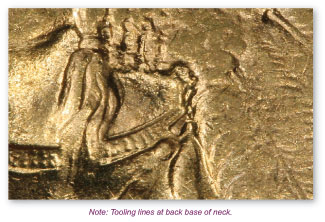
Here, the counterfeiter tries to cover up a known depression in 1914 $2.5 fakes.

Here are a few typical diagnostics:
1) Look for tool marks in the recesses at the back of the Indian's neck.
2) Heavy toolmarks which can look like raised spikes are often detected around the perimeter as well.
3) Weak details.
4) Depressions - one common depression can be found above the 4 in the date. Note: you may see tooling marks where the depression was if the counterfeiter tried to ‘fix’ this.

Hopefully this will leave you armed with enough info needed to keep yourself from being duped. But as always, if there are ever any doubts (and even some of the most skilled and seasoned numismatists have them), the third-party grading company route is always the best, safest way to go.
stack two coins, compare their edge reeding: if they don't perfectly match (e.g. the edge teeth counts), then one is fake!
Tom discusses our recent acquistion of a large collection of Double Eagles.
The following was written by Brian.
Without doubt, one of, if not the biggest scourges in numismatics is counterfeiting. Many of us in the hobby have come across it first hand or heard a story about someone selling or being sold a counterfeit coin. From the tooled/forged 1916-D Mercury dime to the 1914-D Lincoln cent to the 1914 $2.5 Indian, its existence can not be denied.

Luckily we now have 3rd party grading companies that are fully trained to detect such forgeries, and I personally have every faith in them. Say, remember that old PGA commercial ‘These Guys Are Good’? Like those pros, the graders at the top tier 3rd party grading companies are literally the best in the world and it’s nice to have them on our side as collectors (and dealers). The grading companies protect us from these phonies and it’s a very good thing for the hobby.
Enter Omega Man – responsible for some of the greatest numismatic counterfeits the world has ever seen. Not even the finest experts in the industry could detect his handiwork until it had become known and looked for. This guy was good too. So good, in fact, that had it not been for a signature that he put on his coins – the Omega symbol, it is possible that more of his coins would be indistinguishable from their legitimate counterparts. You have to wonder if the talent at today’s third party graders would have been able to catch his counterfeits. Omega Man had his favorites; the 1907 Ultra High Relief Double Eagle and the 1882 $3 Gold coin. But again, without his very faint, tiny trademark symbol, most of these coins would go undetected. Here are a couple examples of the famous signature.

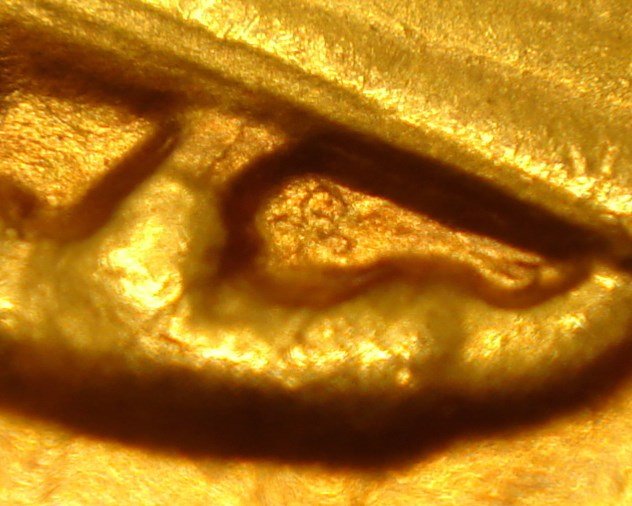
What’s still a mystery is why. Most counterfeiters try to go undetected so as to make the most money possible without getting caught. Perhaps this was just a case of an artist’s vanity. Omega Man was never caught, although pleas for his correspondence had been made in a big way. Check out the article below in which Omega Man is called to at least send a letter or something, anything! Again, we may never know who this person was or why this person did it, but we can be assured (as can be seen from the very bottom of the article below) that everyone thinks they have a genuine 1943 copper cent.
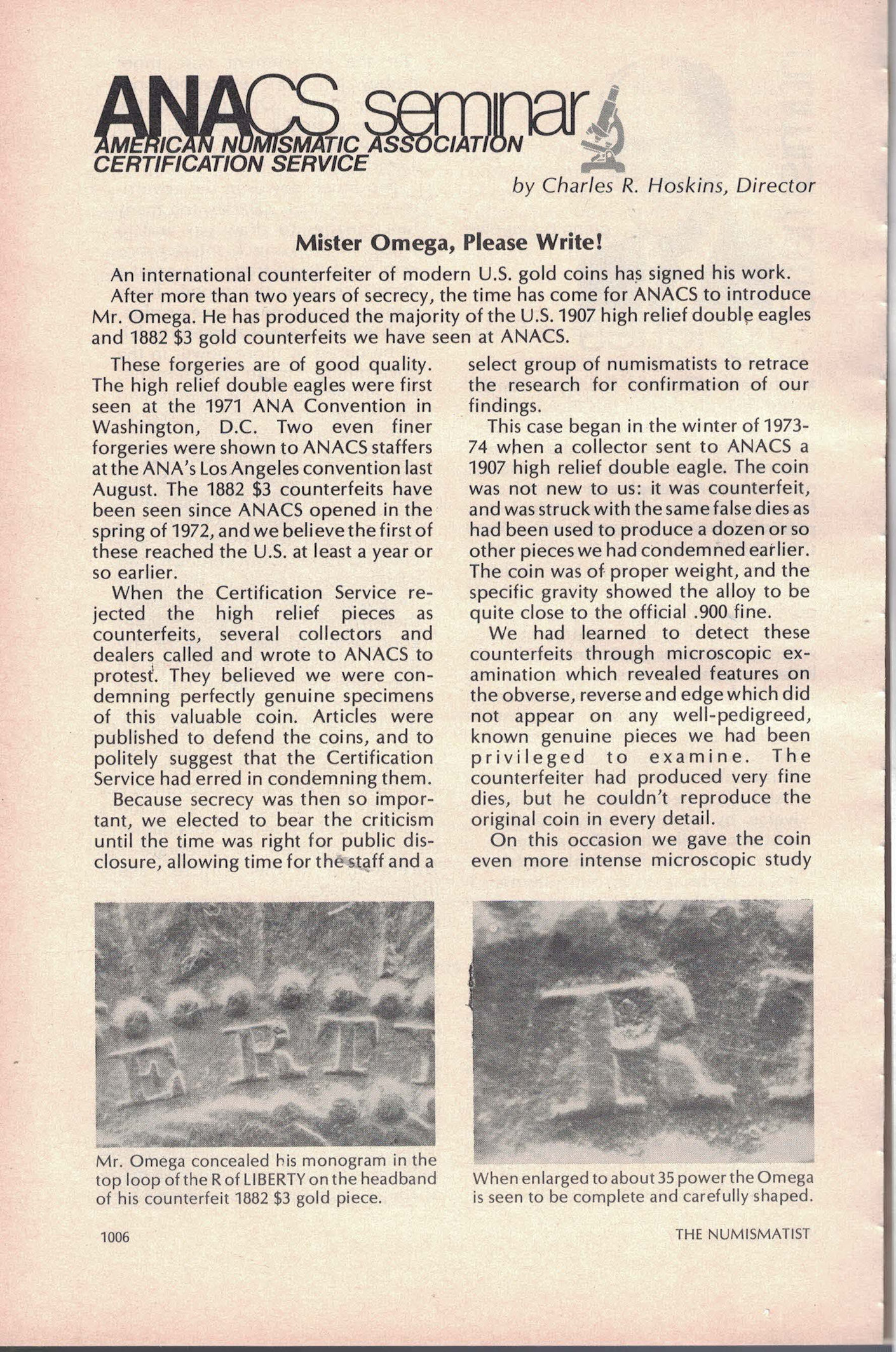
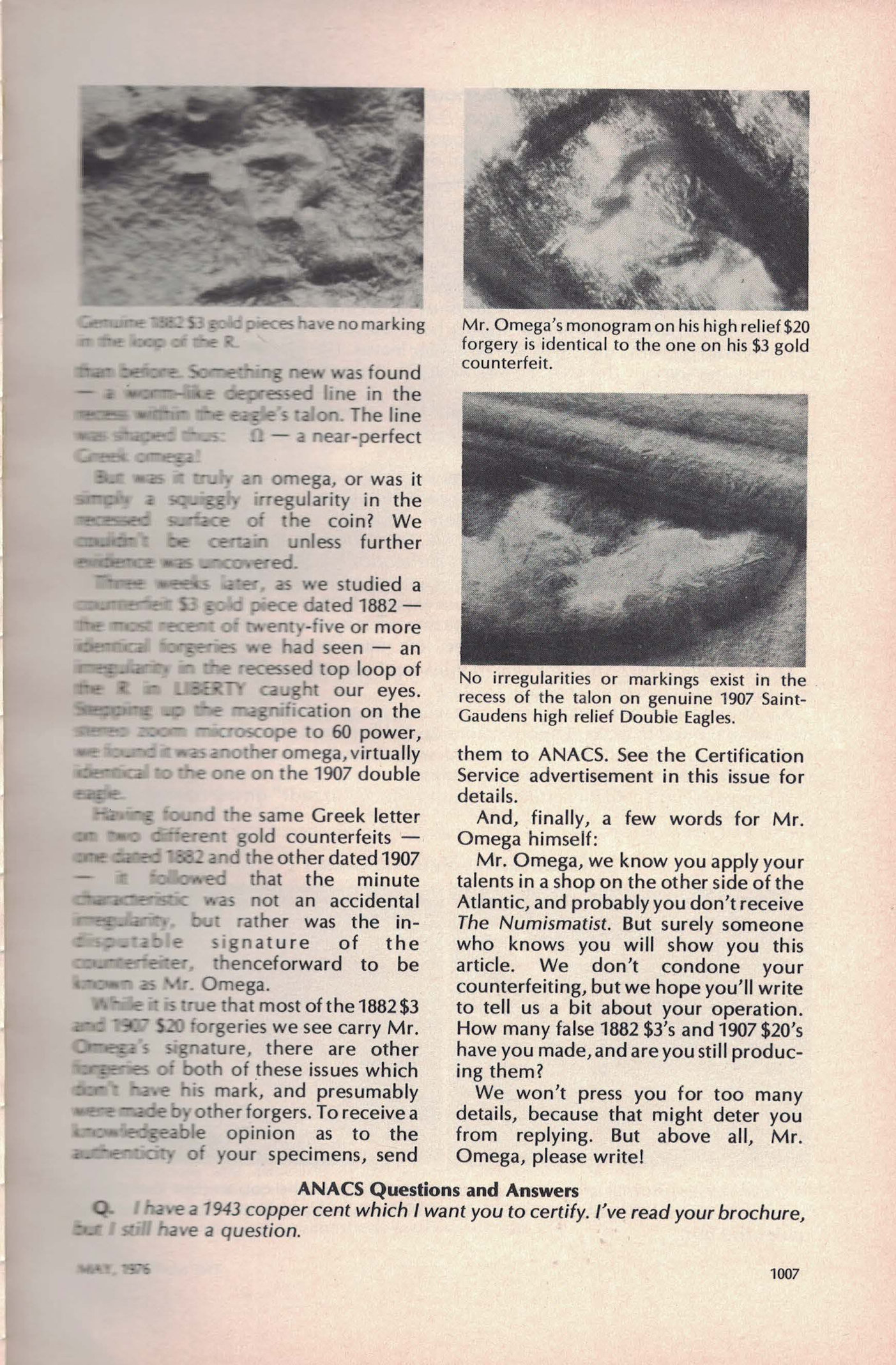
The following was written by Brian.
What comes to mind when you see a Redfield dollar? One thing that probably pops into your mind is that it’s a pretty cool holder, probably an overgraded coin, but a neat holder that has some history. You might even have one and if you don’t you probably want one. Here’s what one looks like:

That particular one (along with several thousand others) was "slabbed" by the Paramount International Coin Corp and given a grade of MS65.
Of course, we as collectors typically prefer to have everything slabbed, and so the major third party grading companies also found a way to certify and put the Redfield dollars into holders. Interestingly, so many Redfield dollars were cracked out that it created a new market demand for Redfield dollars in their original Paramount holders! Here’s how PCGS and NGC did it.


I know, still not terribly exciting, but probably just as LaVere Redfield would have wanted it; unassuming, bland, nothing flashy. While Redfield was not a flashy guy, he certainly was a shining star when it came to making money. He is said to have been a better stock picker than just about anyone in the 1920’s and 30’s. Picking winners was just in his blood. He thrived during the Wall Street market swells of the 20’s, he thrived during the collapse in 1929 and even flourished during the great depression. He could just flat out pick ‘em. Redfield was the ‘mad man’ of his time.
Apparently he was even good at gambling. In 1935 Redfield decided he would do what others had done to take advantage of US tax havens and he moved to Nevada. Redfield became quite a regular at high stakes tables – usually roulette.
And although the multi-millionaire lived quite an exciting life in the desert, he wanted to appear anything but and shied from the public eye, the media and above all – the watchful eye of the government. It is true that rather than pay the government taxes based upon the massive wealth he had accumulated, he would rather serve time in prison for tax evasion; and that’s exactly what he did.
It also became known that Redfield was quite the hoarder. Upon his death in 1974, the basement of his estate was found to house thousands upon thousands of boxes filled with newspapers, empty bottles of all kinds and canned food (most all of it spoiled). It is said that this basement was empty before a viscous mugging in 1948 that put him in a hospital for several weeks. After that event, which clearly affected him, he started buying everything in sight at auctions. Redfied also had a major distrust of banks and a hatred for paper money and was known to buy silver dollars by the bag. And so it was that in 1974 as his estate was being cleared out, along with those empty bottle, cans of food and newspapers, something else was found…
407,000 Morgan and Peace Silver Dollars! This of course became known as the Redfield Hoard. A hoard that is still celebrated today. RIP, Mad Man Redfield. You were one of a kind.

We'd like to take this opportunity to congratulate Tom, our owner and founder, on making Coin World's recently recently released issue of The Most Influential People in Numismatics. This special edition, spanning from 1960-2020, features people who have made an impact in the numismatic industry. Here's the article that featured Tom.

What an impressive achievement!
Thank you!
Tom, what a wonderful acknowledgement of an illustrious career and contribution to our hobby! Your experience is our asset. Congratulations!
Thank you, Pat!
The following was written by Brian.
It’s time to give some love to an often-underappreciated segment of the U.S. rare coin market: Hawaiian Coinage.
The first official Hawaiian coinage began in 1847 with the ‘Keneta’, a large copper coin commissioned by King Kamehaheha III.The King understood the need for local coinage and the desire to migrate away from foreign currency. With the demand for small denomination coins and a need to tie into the U.S. monetary system, the Keneta would be worth one cent of a U.S. dollar and be roughly the size of a U.S. large cent. The obverse bore a portrait of the King (which by accounts at the time looked absolutely nothing like him) and the words ‘Hapa Haneri’ meaning “part of a hundred” (or loosely, one cent) on the reverse.


Although it is not known where the pieces were minted, there is speculation that they were struck at the private mint of H. M. & E. I. Richards of Attleboro, Massachusetts.
No matter where they were minted, The Keneta was not met with much enthusiasm. The coins arrived on the island worn and discolored due to ship/hold storage over many months. Islanders were also not fond of smaller transactions and saw no need for the coins. Apparently there was even some controversy surrounding the spelling of ‘Hapa Haneri’.
With the big island saying Aloha to the Keneta, there would be a 36-year hiatus before the next round of coins were stuck. Aside from an 1881 5 Cent pattern issue (which is rare), Hawaiian coinage was not produced again until 1883 when Kalākaua I coins were issued – again to the American coinage standard. These silver coins were minted in 1883 and 1884 but all bear the 1883 date. Designed by American Chief Engraver Charles Barber and minted in San Francisco, the denominations were as follows;
UMI KENETA (ten cents), HAPAWALU (eighth dollar), HAPAHA (quarter dollar), HAPAHA (quarter dollar), HAPALUA (half dollar), AKAHI DALA (one dollar).
I can just hear modern islanders saying “back in my day an Umi Keneta, a Hapaha and a Hapawalu would buy you 3 pounds of taro, 25 coconuts, a jar of ground kukui nut and you would *still* have enough left over for an hibiscus arrangement”.
Here is a nice mint set (minus the Hapawalu)

And here is the eighth dollar or Hapawalu.
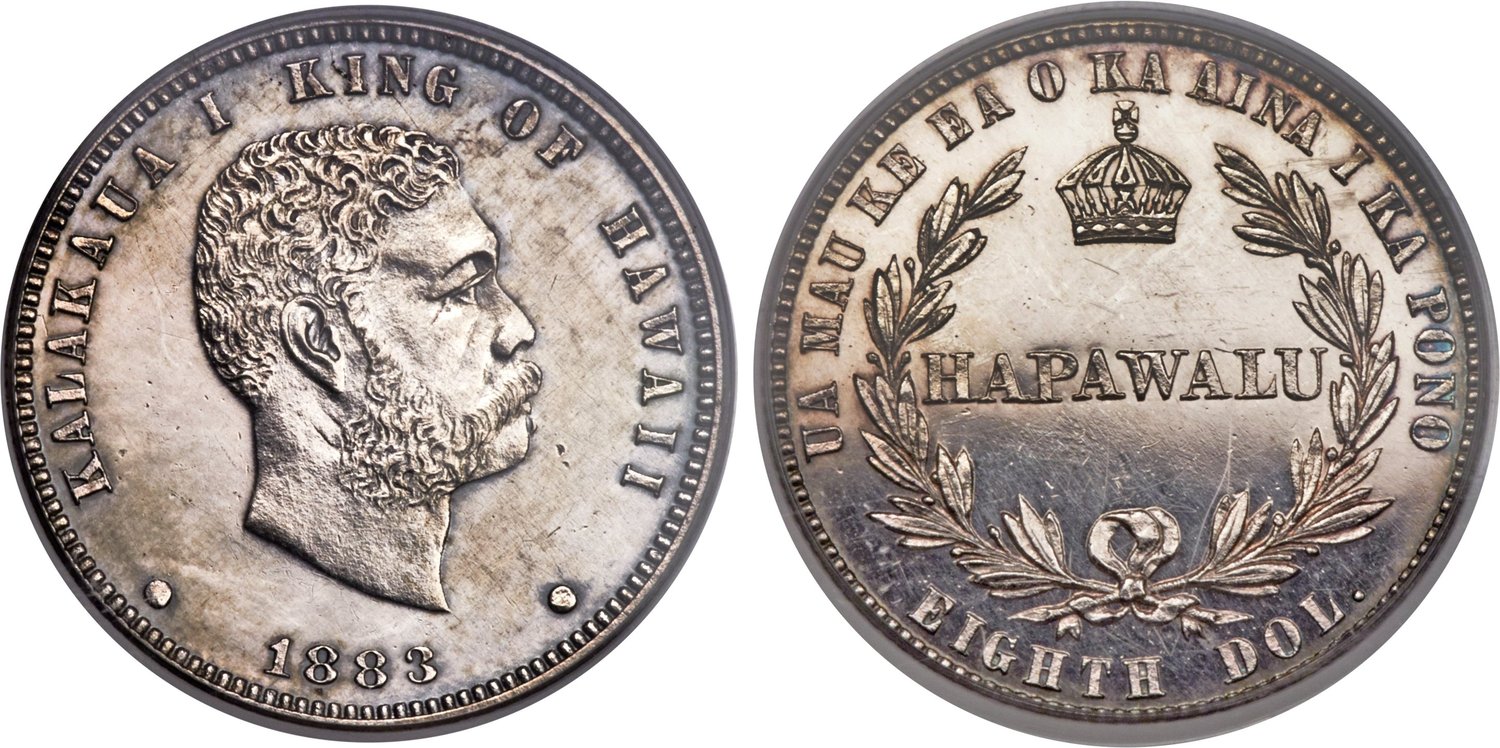
That’s just fun to say. Hapawalu. Hapawaluuuuuu.
After Hawaii had been annexed by the U.S., an act of congress in 1903 ordered $814,000 of the original 1 million in face value coinage to be returned to the United States and melted. It would be replaced by the U.S. coins which Hawaii still uses today. For this reason, Hawaiian coinage (especially in higher grades) is still in high demand and enjoys a collector favorite status by many.
The following was written by Tom.
We seldom take appointment on weekends, though sometimes it is necessary to meet folks at our office on a Saturday or Sunday to accommodate their work schedule. One Friday I got a call confirming an appointment the next day. I was caught a little off guard, as I had not planned on coming in. I checked our calendar and sure enough there was an appointment that had slipped my mind. It would not have been Northeast’s finest hour had I totally missed this appointment, especially since the customer was traveling quite a way to our office.
The calendar notes associated with the appointment stated “buffalo nickels to sell.” Now frankly, when some random caller says they have buffalo nickels, more than nine times out ten we get average circulated accumulations of dateless or barely legible dates with very little value. So at this point I was not particularly excited about the appointment.
Come Saturday and we meet, and the client has 14 Buffalo nickels. It turns out that he is a specialist in the series with several sets, and he had decided to offer us a small group of predominately proof specimens. The group consisted of every proof date from 1913 to 1916, as well as 1936 (both satin and brilliant) and 1937. There was also a 1937-D 3 Legger in MS64. We then discussed the coins and figured out a mutually agreeable price in the mid five-figures. We were a happy buyer, and the client was a happy seller, which is what it is all about. These pieces are now ready to find a new home and can be found on our website (while they last!).


The following was written by Brian.
One Dollar in Silver Payable to the Bearer on Demand. Most in the hobby can recite this in their sleep as it is written upon all Silver Certificate U.S. notes. This all came to an end in the 1960’s as the government halted this practice, ultimately resulting in approximately 3,000,000 silver dollars being held in the vaults of the US Treasury Department. 95% of these coins were from the storied Carson City Mint. Just think…literally millions of Carson City silver dollars in brilliant uncirculated condition!
In 1972 a government agency known as the GSA was tasked with the important job of selling off and dispersing this monstrous amount of silver. But just who is the GSA? According to Wikipedia, the General Services Administration, headquartered in Washington DC, is an independent agency formed in 1949 to “help manage and support the basic functioning of federal agencies. GSA supplies products and communications for U.S. government offices, provides transportation and office space to federal employees, and develops government-wide cost-minimizing policies and other management tasks.” If you can think of a more generic, more blasé name for a group than General Services Administration, you go ahead and you let me know.
Through a series of auctions in the early 70’s and 80’s these coins were made available to the public, and dealers and collectors alike were very much ready to purchase. The availability of all these CC dollars literally changed the course of Morgan Dollar collections forever. Imagine trying to find CC Dollars in the 1960’s, looking at the mintages and scratching your head at the elusiveness of these coins. Some of these previously “rare” dates were now suddenly available and the public lined up to get their hands on these “scarce” issues. This caused quite a commotion in the coin industry for certain.
Here is a list of the Carson City Morgans from the GSA Hoard:
|
DATE |
NUMBER in HOARD |
|
1878-CC |
61,000 |
|
1879-CC |
4,100 |
|
1880-CC |
131,500 |
|
1881-CC |
147,500 |
|
1882-CC |
605,000 |
|
1883-CC |
755,000 |
|
1884-CC |
962,000 |
|
1885-CC |
148,300 |
|
1890-CC |
3,950 |
|
1891-CC |
5,700 |
Another thing that caused a bit of a stir was the custom holders they went in. Here’s an ungraded “raw” Carson City GSA dollar.

As you can imagine, these big, clunky holders were not popular (at first) and you can see why. Most collectors at the time still stored their coins in albums, flips or some other method. And it wasn’t until 1986/87 that third party grading services (TPG’s) started encapsulating coins. However, once grading and encapsulating came along, so did the mass destruction of the original holders. They were “cracked out” as we say in the industry and sent off to grading (or perhaps into an album or just sorted into a collection). Both NGC and PCGS certified a good number of these crackouts.
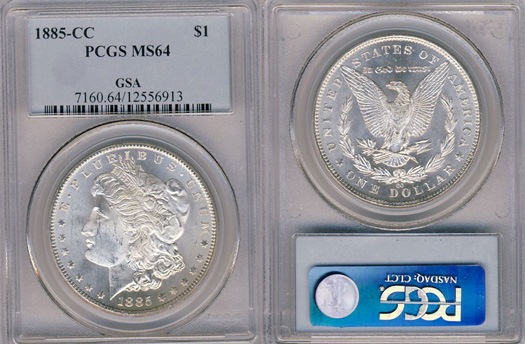
Of course, with all things “original” being the goal of collectors and numismatists alike, the pendulum started to swing in the other direction: buyers now demanded original holders certified by the third party grading companies. The TPG’s of course were willing to oblige, and we still have today what looks like this:

And that, friends, is the story of the Carson City GSA Hoard. Here’s one of the finest known.

Let me remember in 2012, the Royal Canadian Mint (RCM) sold 30,000 1912-1914 dated $5 and $10 gold coins: "...they were stored in cloth bags and remained locked away in vaults at the Bank of Canada..."
This made high grade 1914 $5 no longer a rare coin, sad :(
One of the rarest, and in our opinion the most valuable, U.S. coin is coming up for sale after having been off the market for close to ten years. PCGS has just issued a press release, which we've provided below. It will certainly be one of the most anticipated sales in auction history!
From PCGS:
(Santa Ana, California) – Professional Coin Grading Service (www.PCGS.com) was selected by Sotheby’s in New York to officially certify and grade the 1933 Saint-Gaudens Double Eagle, a gold coin once owned by King Farouk of Egypt that will soon be offered for sale. PCGS has graded the gold coin MS65 and its current owner, shoe designer Stuart Weitzman, is offering it along with a handful of other exceptional rarities at a Sotheby’s auction to be held in New York on June 8, 2021.
“We are excited and proud to be given the opportunity to formally certify the 1933 Saint-Gaudens Double Eagle," says PCGS President Brett Charville. “This coin is a true gem! Breaking the world record in 2002 for being the most valuable coin ever sold, this specimen has a story unlike any other United States rarity.”
The first delivery of 1933 Double Eagles to the Philadelphia Mint cashier was made about 10 days after President Franklin Delano Roosevelt was inaugurated. In one of his first acts, Roosevelt declared an effective end to the nation’s adherence to the gold standard, banned the payout of gold coins, and began the recall of all U.S. gold coins, which were eventually melted.
According to the Mint’s records the entire mintage of 445,500 double eagles struck in 1933 was accounted for, and all were to be melted except for two sent to the Smithsonian. In 1937, a number appeared for sale privately; in 1944 a Secret Service investigation determined that they had been stolen from the Mint and were seized from their owners.
One was purchased by King Farouk. It became part of his fabulous collection and was beyond their reach. Sociopolitical turmoil led to King Farouk’s fall; he was exiled, and the new government dispersed his collection of coins through Sotheby’s. The 1933 Double Eagle was withdrawn from the auction and its whereabouts were unknown for decades until British coin dealer Stephon Fenton surrendered the coin to United States authorities in 1996.
The coin hung in legal limbo for several years, leaving the rarity to be stored in a Secret Service vault at the World Trade Center in New York City. Just before the terrorist attacks destroyed the World Trade Center in 2001, the legal status of the 1933 Saint-Gaudens Double Eagle specimen hailing from King Farouk was resolved and the coin was subsequently removed from the ill-fated New York City landmark. The coin was offered for sale by Sotheby’s/Stack’s in 2002, taking a world-record $7.59 million.
Nearly two decades later, the specimen remains the only legally obtainable example of the 1933 Saint-Gaudens Double Eagle, with two specimens held at the Smithsonian Institution and all known others currently in custody of the United States government, which confiscated a handful of other specimens that came to light in recent years. The unique specimen being offered by Sotheby’s is expected to take between $10 million and $15 million.
Due to the unique circumstances and rarity of the 1933 Saint-Gaudens Double Eagle, PCGS is taking the unusual step of, at the auctioneer’s request, grading and certifying, but not holdering this rarity in PCGS’ tamper-evident holder. The winning bidder of the coin may submit it to PCGS for holdering to provide state-of-the-art security at no additional charge.
Previously, PCGS has only reserved non-holder certification to just one other rarity, which is the Walton specimen of the 1913 Liberty Nickel graded PCGS PR63. Those interested in examining a high-resolution image of the unique PCGS MS65 1933 Saint-Gaudens Double Eagle can view it via PCGS Cert Verification. More information about the sale of the 1933 Saint-Gaudens Double Eagle and other items up for bid at the Sotheby’s Three Treasures – Collected by Stuart Weitzman live auction, can be found at the Sotheby’s website.

I have one!!
.
.
.
.
..
(in my dream :)
Us too!
The following was written by Brian.
We folks in the hobby know that the precious metal content of our circulation strike coins contain less and less precious metal (particularly silver and copper) as the dates of those coins get more modern. It’s just a cold fact that over time, the intrinsic value of our coins has decreased.
Roosevelt and Mercury Dimes, Washington Quarters, and Walking Liberty, Franklin and Kennedy Half-Dollars minted in 1964 and earlier are 90% silver (just finding a 90% silver coin anywhere outside a coin shop these days is finding a needle in a haystack).
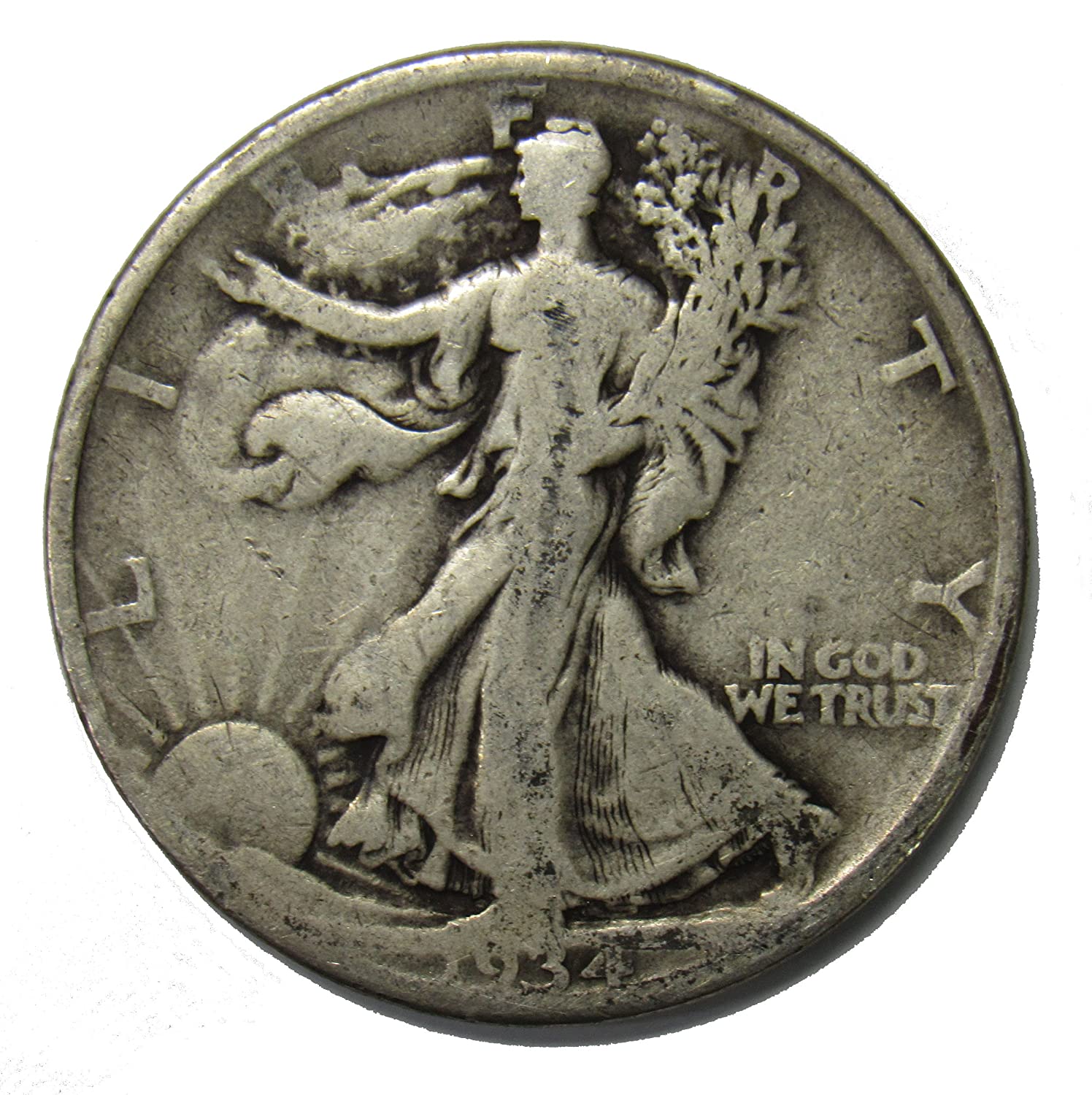
Between the years 1965 and 1976, two major U.S. coins contained 40% silver. The term “40% silver” is a way for investors, collectors, and buyers to refer to Kennedy Half-Dollars minted 1965–1970, and 1976, and Eisenhower Silver Dollars minted 1971-1974, and 1976.

All regular coins dated 1965 or later are clad coins and contain no silver at all. That 1983 Washington quarter in your pocket (unless it is an extremely rare mint error, which I assure you, it isn’t) has no intrinsic value. It is in effect, a physical bitcoin. And pretty much nobody cares.
For US cents, the alloy remained 95 percent copper and 5 percent zinc until 1982, when the composition was changed to 97.5 percent zinc and 2.5 percent copper (copper-plated zinc). I’m pretty sure not many outside the hobby even noticed.
So…where’s the outrage?
Well, nobody has seemed to bat an eye at these changes when they happened and this is due in part to the ancient Roman theory that if it looks the same, it must be the same in value. No need to alarm the citizens, right?
The Romans employed a technique of ‘silvering’ coins; essentially brushing on a light coat of heated silver onto a non-silver coin – all in an effort not to stir the commoners. And it worked. Silvered coins were indeed just made to look silver. As previously mentioned, they did contain some silver but in small enough proportions that it was not obvious so the 1% to 5% silver containing coins were plated to look like their ancestors that bore a pure silver content.

People of the day expected a coin to contain the required amount of the precious metal but inflation made a solid silver coin too high in value to be a useful denomination.
Today we see the same thing, but like I said all along, nobody really cares.
As a follow-up from our January 26th blog post, the fresh roll of 1909 VDB Lincolns are back from grading and now listed on our website. Check out the "reveal video" below.
so cool!that the pennies from that roll would all come back in such high states of preservation after over a century in the original ,so spot free with so many reds fantastic.Hope you guys continue with these fascinating blogs.
Click the player below to listen to our 30-second radio spot on WBZ News. If you catch it on the air, let us know!
Nice information .. Its too bad it wasn't a little longer with an intro video.
Excellent spot. Well done.
Excellent commercial. Clear, concise, informative and well communicated.
Tom...gotta luv it!
Concise, sincere and totally on point ...and yes:, your "MS-71" Team always offers 'Expert Service'...
The following was written by Brian.
The die-sinker. Just what in the world is a die-sinker? Sounds German. Or perhaps it is a fishing lure of some kind? Hit man? Torture device? Well, it’s none of the aforementioned. A die-sinker is a person who engraves dies used to punch or stamp designs onto coins or medals.
Surely, if you enjoy numismatics, you have stumbled upon a token or two in your day. Thanks to the die-sinkers, there are thousands of interesting and historic tokens and medals available for collection and enjoyment.
One of the most prominent die-sinkers of the 19th century was a Cincinnati businessman named James Murdock Jr. As a young man, Murdock emigrated from Ireland to the United States, working under the tutelage of another prominent Cincinnati die-sinker named John Stanton. Murdock would eventually purchase and run Stanton’s business as well as others.

Here’s an example of one of Murdock’s Civil War Tokens.
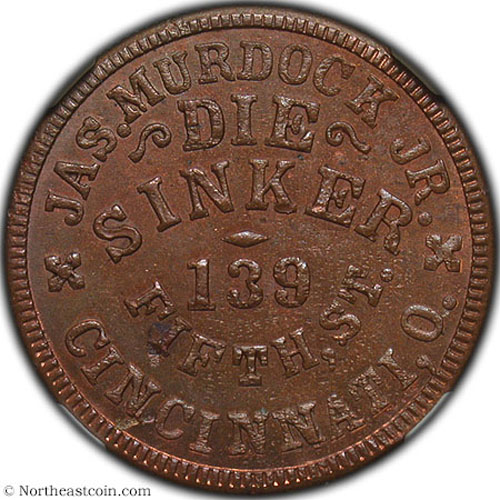
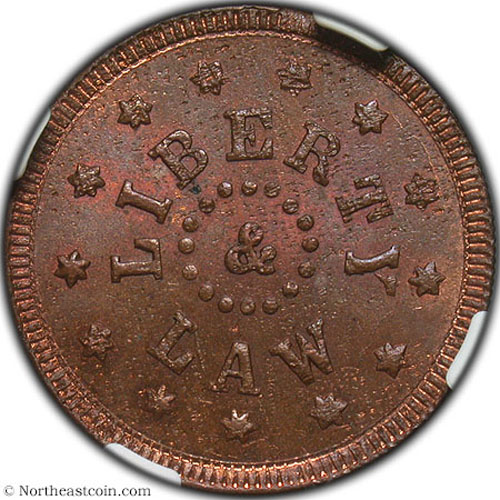

Here is another image of some of Murdock’s Civil War ‘storecards’ (used mostly by tradespersons and valued generally at 1 cent). The top center is Murdock’s advertising obverse and pictured around them are 5 stock dies.

It is known that during the Civil War and post war, collectors of these tokens could purchase them directly from the die sinker companies. This is where it gets interesting as many collectors would convince the die-sinkers to create custom tokens using dies not intended for each other (a practice known as ‘muling’). In addition to different dies, sinkers would often be persuaded to use different metals such as silver, aluminum and copper. This, in effect, resulted in some real rarities.
In addition to tokens, Murdock is credited with creating the first ‘bag-tag’ (a metal luggage tag used on the railroads). In fact, Murdock did so much more. His advertisement in the September 23, 1922, issue of The Cincinnati Enquirer listed the company’s products as “Steel Stamps, Stencils, Metal Specialties, Name and Number Plates, Metal Checks, Burning Brands, Log-Branding Hammers, Embossing Dies.” A regular Murdock for hire, this guy excelled at most everything that presented an opportunity across many industries – including seals. This neat image below is from the ANA magazine.

The following was written by Brian.
This is a silver certificate.

Many beginning hobbyists, or perhaps the casual observer, might argue that it is not a silver certificate but rather a Gold Seal payable in gold, but that’s not the case. Rather, this is an Emergency Issue Silver Certificate with a gold seal.
During World War II, the United States issued special currency for troops in North Africa and parts of Europe as well as the troops in Hawaii. The Hawaii notes have a brown seal and are overprinted with the word “HAWAII” on the front and back of the note. These were created after the attack on Pearl Harbor. The denominations for the Hawaii emergency notes were $1, $5, $10, and $20, while the North Korea emergency notes were $1, $5 and $10.
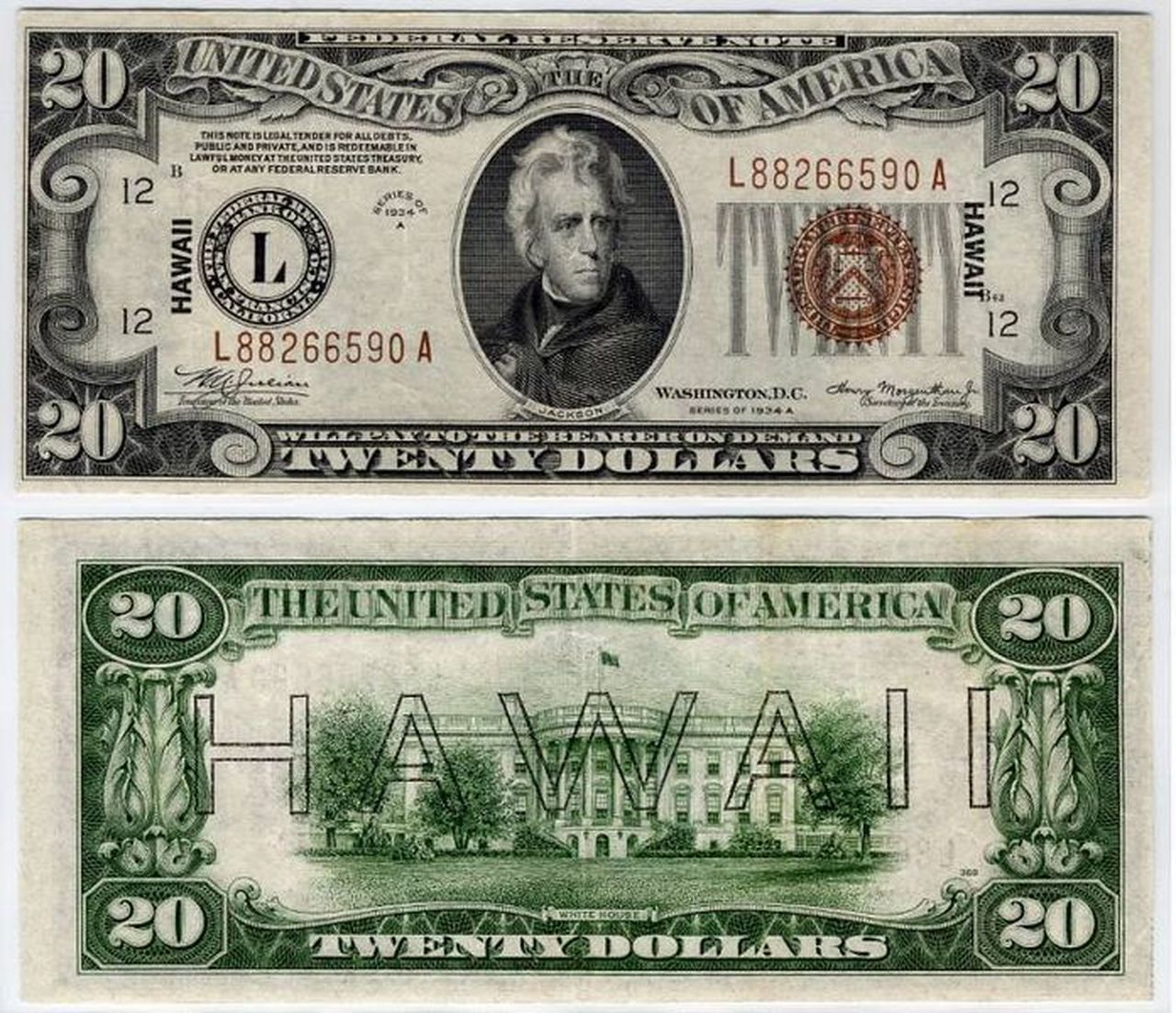
The idea behind the overprints was to easily distinguish US currency captured by Japanese or North Korean forces and render them useless. The US military feared that a Hawaiian invasion could result in the seizing of considerable amounts of US currency from financial institutions, businesses and/or private individuals. So, on January 10, 1942 an order was issued to recall all regular US currency in the islands, save for set caps that individuals and business could carry.
On June 25, 1942, new overprinted notes were first issued. Again, the hope was that should there have been a Japanese invasion, the US government could immediately declare any Hawaii-stamped notes worthless, due to their easy identification. This would make non-overprinted notes redundant and the residents of Hawaii would be forced to turn in any such notes for the overprinted ones.
After the war (and faced with a $200 million stockpile in currency) government officials decided that rather than dealing with the logistical problems of shipping the recalled currency back to the mainland, they would simply destroy them. They made use of a local crematorium until deciding that the job was too big and going too slowly when they employed the help of the Aiea Sugar Mill to finish the job.

This is a rather rare opportunity. Opening up a long sealed roll of 1909 VDB Lincoln Cents. Check it out!

We are very sad to announce the recent passing of our friend and colleague, Margie Sheaffer. She passed away at the age of 71, with her husband Gary by her side. Margie started working the coin shows with us back in 2011. Based out of Pennsylvania, she would fly out and meet us at all of the major shows. She primarily took our coins around the bourse floor to show other dealers, but she also provided invaluable assistance behind the table.
Margie’s time in the coin business started well before she started working with us, however. In fact, she started in the biz almost 50 years ago. To this day many still knew her by the name of Margie Sharp from her single days. Over a 50-year span, Margie has worked for Worldwide Numismatics, Britt Simons, Bob Hughes, Dennis Steinmetz, Frank Greenburg, John Maben, Modern Coin Mart, us here at Northeast Numismatics, as well as others. She was known by almost every dealer in the show circuit and was well-liked by all.
It was always a joy hearing the stories about the pre-coin circuit days when Margie had a minor rock and roll hit, cutting a record in the late 60’s or early 70’s. If only she could have traded in her cheery bourse floor voice and personality for rock & roll fame! In recent years Margie retraced bits of this glory performing in senior music competitions.
From Tom
Smiling & friendly. Reading the many tributes & remembrances from Margie’s many friends & dealer colleagues from across the country, I am really struck by these overriding comments. Margie was always known as someone that would greet you within a nice big smile on her face. She was funny & cheerful, would remember a birthday or special event, & was very easy to talk to.
Margie’s tremendous energy & hard work will be missed for sure, but more we will miss the Margie that would bring a thoughtful gift to a dealer friend, remember & comment on your grandkids, or some other thoughtful event. We were honored to be Margie’s friend & she will be missed immensely.
From Chris
Margie was such a lovely and fun person to be around. Some of my favorite moments with her was when she would recount the coin stories of old, well before my time in the business. The 70’s and 80’s were some crazy times in this industry, and she knew most everyone in the biz back then. I never tired of hearing the old school scoop.
It was always a treat to see Margie at each show. A fond memory I will always have will be the actual “treats” she would sometimes bring me. Her husband Gary is an avid hunter, and occasionally Margie would show up to the show with a bag of homemade deer jerky for me. (Thank you, Gary!)
While we didn’t go out to dinner too much together while on the road (Margie usually preferred calling it a night early and would enjoy some room service…probably because she was sick and tired of working with me and Tom all day!), we would occasionally enjoy an after-show cocktail in the hotel lounge. Tequila was her beverage of choice. You could always tell if Margie had had one or two tequila drinks. The color of her cheeks and her stories were the giveaway. She normally retired to her room after her second, but not after we had a bunch of great laughs.
Margie always asked about my daughter, wanted to know how she was doing, and see any updated pictures I might have. She was a kind and caring person. I will miss her so much, both as a colleague on the road, and as a friend.
From Brian
I first met Margie when she was visiting Boston and came into the office at our old place. We were introduced but before I could put my hand out to shake hers, she gave me a big hug. That really says it all about Margie; a wonderful, cheerful, loving, funny and welcoming lady. Though she never met my son Lukas, she would always ask me about him and tell me how adorable he is. It was always so nice to see her at the shows and we immediately had a musical bond that would keep us talking music the whole time. Gone way too soon, I will miss her greatly.
Tom discusses a collection of Walkers we recently acquired.
I enjoyed this vlog. I would love to see more in the future. It would be great to include some market commentary and forecasts as well!
We're glad you enjoyed the video. Stay tuned for more. And thanks for the feedback - we'll certainly keep your suggestions in mind!
The following was written by Brian.
Now that we are all familiar with the Schützenfest (if you’re not, please read the previous blog), let’s move on to the reason I’m blogging about it in the first place - the medals!
Shooting medals and cups are the most common form of the Swiss awards and are made from many different metals including silver, bronze, gold, aluminum, and white metal. Shooting medals in general are scarce due to low mintages (averaging 700-800 some more, some less), melting, being lost and basic attrition. The size of the medals ranges from 23 mm to 62 mm, with 45 mm being the most common. What makes these medals so noteworthy are the fantastic, complex designs that many display.
Here’s an example (and this one happens to be our lead numismatist Chris’ favorite) of the 1890 Old Suisse Confederacy Thurgau-Frauenfeld Silver Shooting Medal “Helvetia the Protector.”


Some designs convey a sense of movement and emotion, like the one below. I think it is clear what this man’s intentions are and I for one would not mess with him.
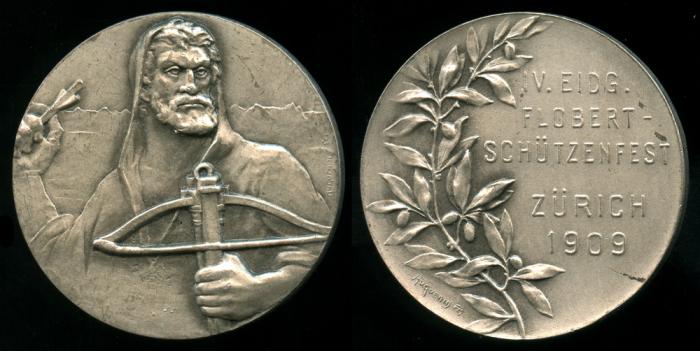
Shooting Thalers are minted to commemorate the festivals themselves. Here is the 1874, Swiss Cantons - St. Gallen. Silver Shooting Thaler (5 Francs).

Some are quite elegant in design. The 1886 Old Suisse Confederat Neuchatel La Chaucer de-Fonds Schutzenfest Shooting Bronze Medal “Helvetia & Youngling” is quite popular.

Many collectors are big fans of the shooting medals, which by the way falls under the category of Phaleristics, an auxiliary science of history and numismatics which studies orders, fraternities, and award items, such as medals, ribbons, and other decorations.

The following was written by Brian.
Here's a pretty good trivia question with which you can stump your friends and family:
Q: What and where is the longest parade in the world?
A: The Schützenfest Parade in Hanover, Germany.
This "Marksmen's Parade" has more than 10,000 participants from all over the world, including over 100 bands. Even more impressive? It's 7.5 miles long!

But what is the Schützenfest? I'm glad you asked.
A 'Schützenfest' or marksmen's festival is a traditional fair which features target shooting competitions in Germany, the Netherlands and Switzerland. This is a wildly popular yearly event that draws thousands of spectators in addition to the 5,000+ marksmen. There are over 250 rides and inns as well as give enormous beer tents (many festival goers are just in it for the beer).The landmark of the festival is one of the highest transportable ferris wheels in the world; soaring to over 200 feet high and seating up to 420 people.
So, basically, it’s a place to get high, get drunk and watch people shoot a bunch of stuff. I’m in!
In Switzerland, the first national Swiss Federal Shooting Festival (Eidgenössisches Schützenfest) was held in 1824, but the local festivals date back centuries earlier. Here is the 1458 Schützenfest in Konstanz as depicted in the Luzerner Chronik of 1513.

And a much more recent photograph from the festival in Winterthur, Switzerland 1895. This is the main entrance.

Originally an event for bow & arrow/crossbow types only, weapon technology would ensure that later events would include rifle and pistol. These are still used in the modern shooting competitions.
The winner of the competition becomes the Schützenkönig* or "king of marksmen" until the next year's competition. Everyone else gets a medal and the medals are spectacular. We will talk about these medals soon…when I write to you next.
*I have secretly always wanted to be called this.
Except for Tom Brady.
With six championships trophies in under 20 years, including three in the last six years, I don’t think anyone in their right mind would not consider the New England Patriots a dynasty. And with so much parity in the league these days (and professional sports in general…well, except for the New York Jets), one could even argue that they may be the last dynasty. I recall after the Pats won their 3rd Super Bowl, that many people were telling me “It’ll all come to an end soon.” Fast forward 15 years and three more Super Bowls, and it seems that perhaps this fairy tale story has finally come to an end.
Except for Tom Brady.
Brady is still perched near the top of his division (just a half game behind as I write this), albeit this time as quarterback for the Tampa Bay Bucs in the NFC South. Meanwhile in New England, our new QB is none other than Cam Newton – the overwhelming choice for MVP in 2015. While Newton still shows flashes of his dazzling athletic ability, it now seems like a lifetime ago as Newton does not look like the player he was then. Like I said, all good things come to an end.
Except for Tom Brady.
Recently a box was put on my desk. Tom from our office had purchased something pretty cool and fun, especially for us Pats fans - The Tom Brady Super Bowl Commemorative Coin Collection. Five images from five different Super Bowls embossed on American Silver Eagles that correspond with the dates New England won. In the drawer are cards for each year detailing the Pats run to the title. There are actually two more spots for additional coins, so hopefully we’ll come across the Silver Eagle celebrating his sixth title. (And perhaps the final spot for a Bucs coin if he wins it all with them?)
Not for sale, but I thought it was worthwhile sharing. Particularly since there’s not much worthwhile to write or say about the Patriots anymore.

This post was written by Brian.
The following was written by Brian.
Is luster on proof coins a good or bad thing? Or is it neither? I recently had a customer ask me about a few proof coins. He asked how the luster was on these coins and I said (trying not to sound like a jerk), “well, there really isn’t any because they are proof coins”. He proceeded to ask me again on the next few proofs he had chosen and one of them indeed had a good deal of luster.
Personally, when I look at proofs, I’m looking for clear reflective mirrors (which are obtained by the use of highly polished dies). That to me is what gives proof issues their eye appeal. And isn’t that what we’re all looking for in our coins?

Perhaps not and maybe it just comes down to semantics. Some people say that the well-mirrored proof coins do exhibit a type of luster, which is called proof luster (not to be confused with business strike cartwheel luster). Yet others seek earlier struck examples with clear, watery mirrors and little to no proof luster. So, is our customer right or wrong for wanting what he wants and liking what he likes? Well, that isn’t my call, but I do know this: As the die for a proof issue starts to wear, it creates flow lines in the metal which is in turn responsible for luster on proof coins. Many Three Cents Nickels like the one here exhibits this luster quite nicely.

Normally, die erosion (or in this case the lack of die re-polishing) is viewed as a negative when it comes to coin production, but maybe not so in all cases.
We’ll let you decide, but we also would like to hear your thoughts on the matter so please feel free to comment!

No, of course he doesn't. But James Earl Jones, the acclaimed actor and the voice of Darth Vader, does. And so a few years ago, the PNG and ANA produced a couple of videos promoting coin collecting with Mr. Jones as the narrator. We encourage you to check them out!
The following was written by Brian.
One of my favorite bands when I was growing up was Aerosmith. They were (and technically still are) “The Bad Boys From Boston.” One of my favorites of theirs was a little ditty called “Back in the Saddle.” In the song, they wanted the sound effect of a bullwhip being cracked so they went out and bought a real one. Reportedly all four members were cut up and injured several times trying to use it but still couldn’t get it to work. So, they improvised (pun intended) by swinging a 30-foot cable that was in the recording studio and using a cap gun to emulate the crack of the whip.
These days, I’m feeling like we are back in the saddle at Northeast (minus attending the usual coin shows). It was a very strange (and dare I say challenging) few months prior to getting back in the groove. We had to improvise quite a bit ourselves, but we all came together to make it work. And we’re still making it work. Lots of safety protocols are in place, and everyone has been doing a stellar job with boundary considerations, mask wearing, sanitizing, etc. With a good bit of improvising, we have been able to come back to full speed ahead from the operations standpoint.
That said, we’d like you to know that none of this would have been possible without you, our customers. Without your support, we, like many other businesses, would have been in very rough shape. So, we thank you for your loyalty, your business, and your patience! Many of you have expressed over the phone that you understand things take a little longer during a pandemic and though we have not slowed down, we certainly appreciate the sentiment.
Thank you again for allowing us to get back in the saddle once more!
One of my favorites too Brian. Also love "Last Child" from that album - and I was my family's last child. Was fortunate to see them at the Cow Palace in S.F. not too long after Rocks came out. I believe it was 1976, when I was 17 - awesome show!
The following was written by Tom.
In a recent collection we acquired we were told in advance about a popular variety that was included. Popular not necessarily due to scarcity but more due to the clever name it was given decades ago when first discovered. A “Spitting Eagle” is well-known as a variety of 1891-CC Morgan dollars. It is usually only offered in mint state due to decent quantity that came out of the Redfield hoard in the early 1970’s. It is a variety that sells well and is popular among collectors due to the die break below the eagle’s beak, thus giving the coin its fun name.
What we were not expecting was what we got. Not a Morgan dollar at all but a somewhat recently discovered Washington quarter variety given this same name. We were completely unaware of the existence of a “Spitting Eagle” 1983 Washington quarter. It is even more pronounced than the Morgan dollar variety, with a heavy die break from the the eagle’s beak on the quarter’s reverse.
Goes to show that just when we think we have seen it all, there’s always new discoveries and new things to learn. It keeps our hobby and business interesting for sure.


The following was posted by Marne.
I don't know about the rest of you, but I enjoy coins with animals on them. Almost every coin features an animal of some kind. My favorite animal on a coin would have to be the owl. Owls are fascinating creatures. They are nocturnal solitary birds of prey, with feathers that are silent, binocular vision, and binaural hearing. Owls can be found almost anywhere on Earth, with the exception of the polar ice caps and a few remote islands. A group of owls is known as a "parliament".
Owls have long fascinated civilizations througout time. In Ancient Greece, the owl was a symbol for Athena, goddess of wisdom and strategy. According to myth, 'an owl sat on Athena's blind side, so that she could see the whole truth.' A symbol of a higher wisdom, and a guardian of the Acropolis.
In the modern West owls are associated with wisdom and vigilance. Harkening back to Ancient Greece, as Athena was known for wisdom.
The First Nations Peoples of the Americas considered owls bearers of supernatural danger. The Apache and Seminole told children the hooting was from "bogeymen" (possibly to get them to behave and go to bed!)
Owls were thought to carry messages back and forth beyod the grave.
The Aztecs and Maya knew the owls as a symbol of death, often depicted with the Aztec god of death Mictlantecutli.
In Mexico there is a phrase "Cuando el tecolote canta, el indio muere" ("When the owl cries/sings, the Indian dies").
The first owl coins were minted around 510 BC. The Athenian Owl was the first coin with a full design on both the obverse and reverse. The phrase "heads or tails" originated with this coin!
The "Owls" as they were known were minted to a standard of purity and weight. This contributed to their success as the premier trade coin of their era. This made them a widely used coin, often used to make large payments, or hoarded.
The silver Tetradrachm is thought to be the coin given to Judas for betraying Jesus.
The owl is also featured on the 2016 German Domestic Birds coin series.
1/8 oz 20 Euro Gold Uhu 2018

This 2011 Wildlife Protection coin of Mongolia has Swarovski crystal eyes.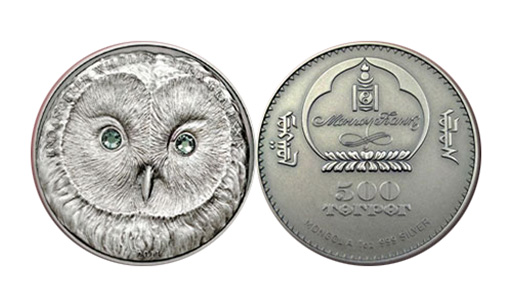
The Ukraine Bubo

In the United States in 1915 at the San Francisco Panama-Pacific Expo, the first $50 gold coin was released in commemoration. Mintages were 1,509 of the $50 Gold Octagonal and 1,510 of the $50 Gold Rounds. Due to cost, few sold and approximately 1,017 $50 Gold Rounds were destroyed.

What coins with animals fascinate you?
I most like the DoDo bird!
Now we can't see a real DoDo bird, but can find it on a 1971 MAURITIUS silver coin.
*I bought this coin in 2018 from NorthEast.
The following was written by Brian.
I recently came across the term 'haymarks' and was a bit mystified as to what that could mean. I searched a bit and found that while most agree that the term refers to older British coins, there is quite the variance when it comes to what they are and how they are produced. Check out the Fourpence, and you'll see clearly that there is something sort of streaky going on with the surfaces throughout the fields and across the devices.

What the hay, I say?
A few sources returned mixed results…
From a British coin site:
Hmking - haymarking. These terms refer to flan surface faults resulting from metal mix. They are essentially dark scars caused during and not damage subsequent to minting.
But this explanation from an old Heritage Auction does seem to have some validity to it: "probably net-graded to a "62" because of the entirely normal black streaky flecks in the metal, sometimes called "haymarks," caused by the alloyed silver containing tin, which came in part from Midlands and Welsh mines.
Further complicating matters, various coin forums on this subject find a number of British coin dealers "don't use this term" and "I am British and I call them hairlines" which is totally ridiculous because that's like saying Santa Claus doesn't exist and neither do run-on sentences.
Some say it is merely a language thing where haymarks is just a word used in Britain for hairlines.
Or it could all just be a bunch of hooey! Feel free to weigh in with your expertise on this subject should you want to. We would be glad to hear your thoughts!
Click the link below to read an article by Tom Caldwell and Chris Maisano about the Classic Silver Commemorative market.
https://www.greysheet.com/news/story?title=seizing-the-opportunity-classic-silver-commemoratives
The following was written by Christy.
The Story of Ted Binion - Part 2
Ted was found dead when Sandy arrived home in the early afternoon of September 17th. At first glance, the scene of the body was unremarkable. This looked like a cut and dry drug overdose, so the police did not take any special care at the scene to protect any pieces of evidence from being contaminated. Ted’s body was taken to the coroner who ruled it a drug overdose, with not much clarity if it was intentional or not. Time of death was near noon.
Soon thereafter, things started to get suspicious. In the early morning hours of September 19th, just two days after Ted’s death, his partner and friend Rick Tabish was found digging up the silver vault that only he and Ted had the combination for. Rick had a briefcase with him. Inside they found a love note from Sandy and information on how to sell silver coins. He was promptly arrested.
The Binion family had suspicions about Sandy’s possible involvement with Ted’s death. Detectives started looking into her behavior on the day Ted was found. A few things stood out to them. There was video footage of her at the hospital. The detectives noticed that although her reactions seemed appropriate for losing someone close to her, she seemed to be able to turn her reactions on and off. Almost as if they were rehearsed.
There were other strange occurrences that seemed to sprout up. Many of the various safes in the house had been completely emptied out at some point. Sandy had called their cleaning lady that morning and canceled their scheduled services for that same day. Ted’s realtor had called the house on the day in question. Sandy answered the phone and told the realtor that Ted was not available, and he was “out of it.” The time of the phone call was right around the estimated time of death. Shortly after the phone call, Sandy left the house to run errands before coming home to discover the body.
The body was re-examined. A few things that had gone under the radar were now being looked at more closely. There was bruising on his face and torso that now seemed more sinister. The medical examiner also determined that there was reason to believe that Ted was face-down for some time after death, but he was found face-up.
On May 18th, 2000, Sandra Murphy and Rick Tabish were tried and convicted of murdering Ted Binion. The jury determined that the suicide had been forced and they were sentenced to 20 years to life in prison.
The court proceedings did not end there. Four and a half years later, in 2004, Sandra and Rick were granted a re-trial on the basis that jurors were not properly instructed on how to deliberate, as well as Rick having multiple charges lumped into the trial that should have been separated into different trials. The defense attorneys argued that most of the evidence against the pair was circumstantial and there was a lack of evidence that anything had been forced upon Ted.
The verdict on the murder charges was overturned on November 23rd, 2004, but both were convicted on lesser charges. Murphy was released on time served, and Tabish continued to serve his sentence until 2010.
What about Ted’s treasure? Some remains unclaimed at the courthouse. Most of what was in the vault was recovered and given to his Daughter. She has offered some of it for sale to the public. You can see these labeled as “Binion Collection” on NGC certified coins. A lot of Ted’s treasure is still unaccounted for. There are rumors that the strange mounds on his property still hold his missing treasure trove. As recently as 2019, a man was arrested for attempting to dig up the rumored silver, the whereabouts of which will have to remain a mystery for now.

Ted Binion

Ted Binion's property in Pahrump, NV.

Sandy Muprhy and Rick Tabish during their trial.

Binion Collection Morgan Dollar released for sale to the public.

Sandy Murphy and Rick Tabish.
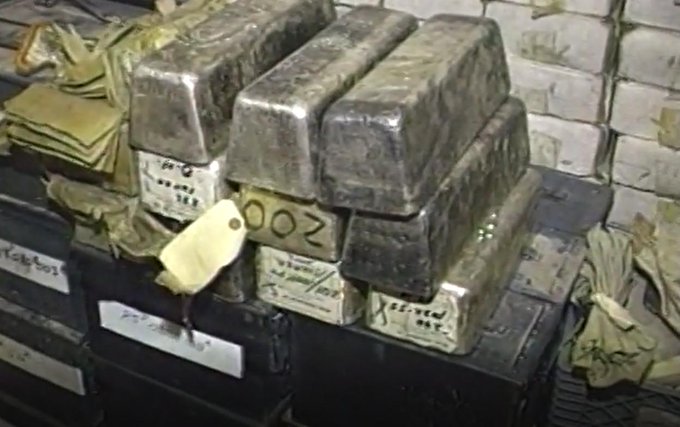
Part of Ted's recovered silver hoard.
Great article Christy on the Binion Hoard. I thoroughly enjoyed reading it.
The following was written by Christy.
The Story of Ted Binion - Part I
To understand the story of Ted Binion, you must start with his family life and where he came from. Ted Binion was the son of Benny Binion, an extraordinarily successful and wealthy Casino owner. He owned and operated the Binion Horseshoe Casino and was regarded as a pioneer of Las Vegas. It went on to become one of the biggest and most successful casinos in all the city.
Benny found himself in legal troubles with tax evasion, and in 1964 his two sons, Jack and Ted had to step in to run the Casino. Ted was only 21 years old at the time.
Ted continued in his father’s footsteps when it came to legal issues. Over the years running the casino he had built himself a reputation as a partier and a playboy. He had a rampant drug addiction to heroin and Xanax, and he liked to associate himself and party with very influential people, including those in organized crime. In 1986 he was arrested on drug trafficking charges, marking the beginning of a long list of troubles he found himself in.
In 1996 he was banned from entering the casino and court ordered to undertake mandatory drug testing. He went great lengths to try to avoid testing, at one point shaving off all of his body hair to evade certain types of tests. In 1997 his gaming license was suspended as a result of him not living up to the agreements of the court, and in 1998 his gaming license was permanently revoked due to his ties with the mob.
Ted married his wife Doris in 1980, but their relationship was just as rocky as his professional life. There were rumored affairs on both sides and ultimately, they filed for divorce. Around the same time as the divorce, Ted met Sandra Murphy at a Gentleman’s club and they quickly became a couple.
Ted had an affinity for silver, both in bar form and silver dollar coins. His love of stockpiling silver and stacking coins went so far that he had housed a giant vault in the basement of the casino for his collection. He was not shy about his collection and was known to brag about his hoard, telling anyone and everyone who would listen about his stockpile.
When things went south with his dealings in the casino, he only had two options; he could sell off his collection, or he would have to find a new place to keep it. Rick Tabish, the owner of trucking company MRT Transport, had become fast friends with Ted. With the issue of moving the silver, they became business associates. A 12-foot deep vault was installed in one of Ted’s properties in Pahrump, NV, a suburb about 60 miles west of Las Vegas. Rick handled transporting the hoard to the vault. Only Rick and Ted held the combination to his underground bunker. In total, the hoard amounted to about six tons in silver bullion, casino chips, paper currency and over 100,000 silver dollars, which included many Carson City silver dollars. Ted also hid his money and silver in secret locations around his home in Las Vegas. There were safes scattered about the property inside and out. The only person who knew of every location was Ted himself.
On September 17th, 1998, 12:00 PM, Ted was found dead in his home by his live-in girlfriend Sandy. When medical examiners arrived, they found him lying on his back. Nearby they found drug paraphernalia and an empty bottle of Xanax. At first glance this seemed like a standard overdose, accidental or intentional, but was it really?
Stay tuned for the next installment!
The following was written by Marne.
Being the Northeast photographer with no coin images to share with you is quite frustrating! Though not coins, I would like to share with you some photos from my honeymoon trip to New Zealand this past October/November. It was a colorful autumn here, and a sunny springtime there. The flight was long, but the food and flight attendants on New Zealand Air were wonderful. We were kept full on champagne and snacks most of the flight there.
New Zealand is known as 'The land of the Long White Cloud', and it's easy to see why when the clouds stretch in long strands across the snowy volcano formed mountain peaks.

Our first adventure was a cross country train ride from Auckland to Wellington. It’s hard to get photos from a fast-moving train, even a sightseeing one. We did enjoy meeting many people who had been keeping the bar car busy during the long trip.
The hills looked like soft velvet, and the views looked like landscape paintings.




The next day we ferried to the South Island on the fancy InterIslander. This is where I learned to order my coffee as ‘flat white with 2 sugars’, and that beans in tomato (pronounced Ta-Mahh-Toe) sauce was served with breakfast. The shore arriving looked like something out of a dream.

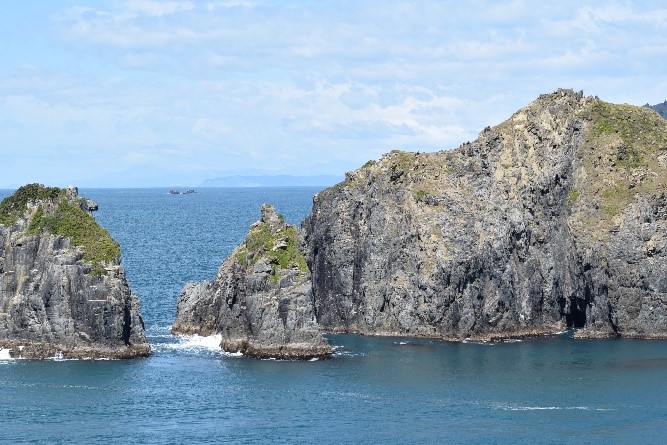


The South Island was full of beauty, lots of sheep, charm, and character. We quickly had to adapt to driving on the ‘wrong’ side of the road AND other side of the car! We searched for Kiwi but had to visit a sanctuary where photos were not allowed in the Kiwi habitat. We made friends with the other birds there as well. We visited wineries in the infamous Marlborough region, and stayed in unique AirBnBs!





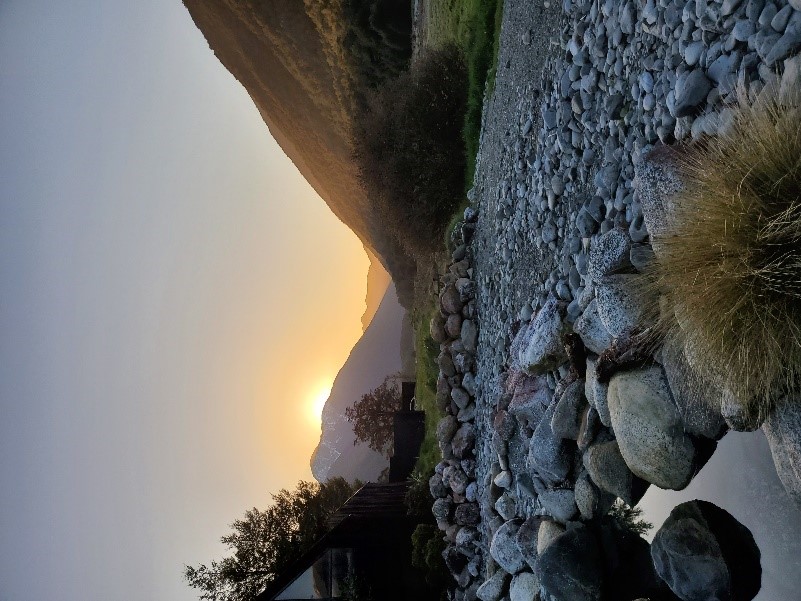
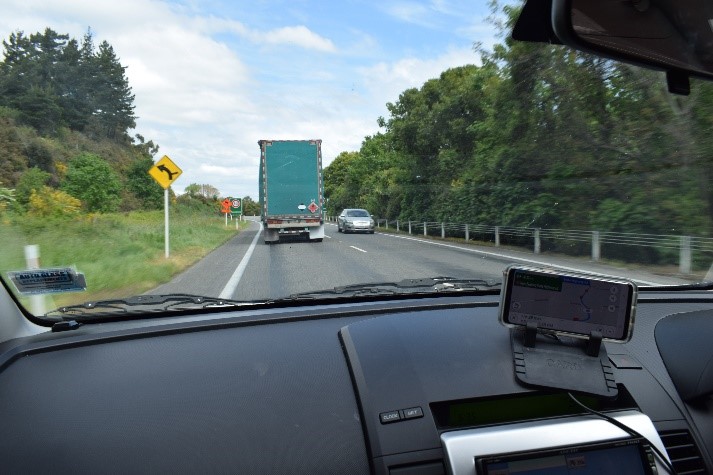



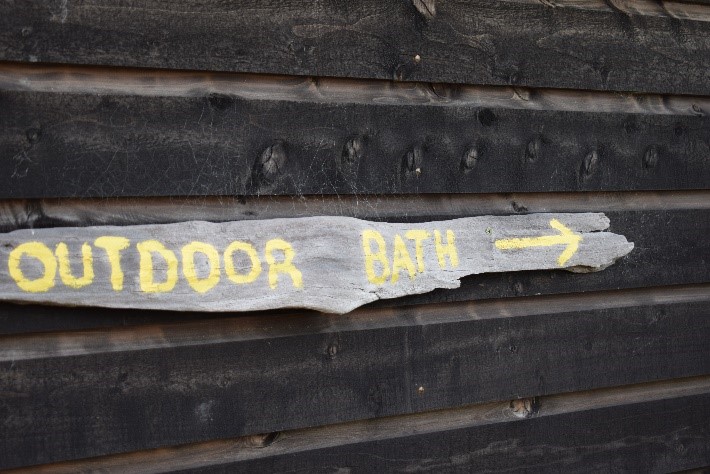







Once back on the North (big) Island, we went to the Hobbiton Movie Set Tour. I am a huge fan of the Hobbit, and it was amazing and fun to be immersed in that fantasy world! We even found a farm stay nearby that resembled a hobbit hole! Starting a coal stove is NOT easy! The pond had a loud screeching water fowl resident that surprised us, and the stone shower was amazing. Running water but NO electricity, candles only! It was incredible.
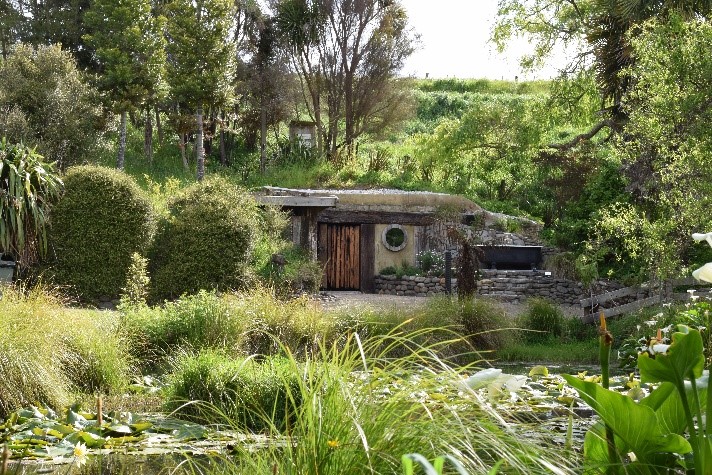



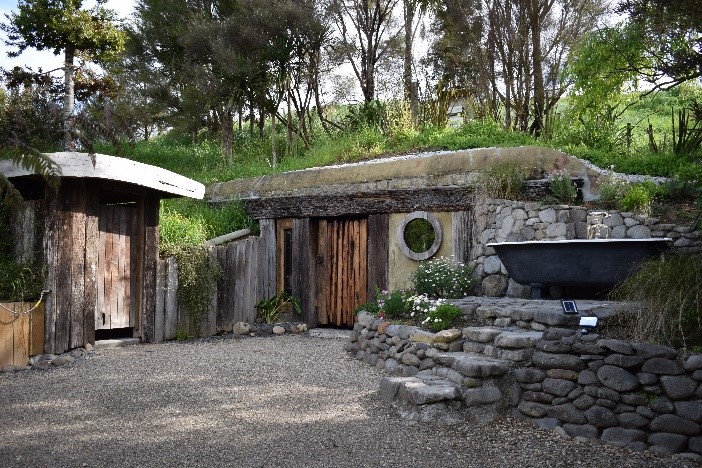
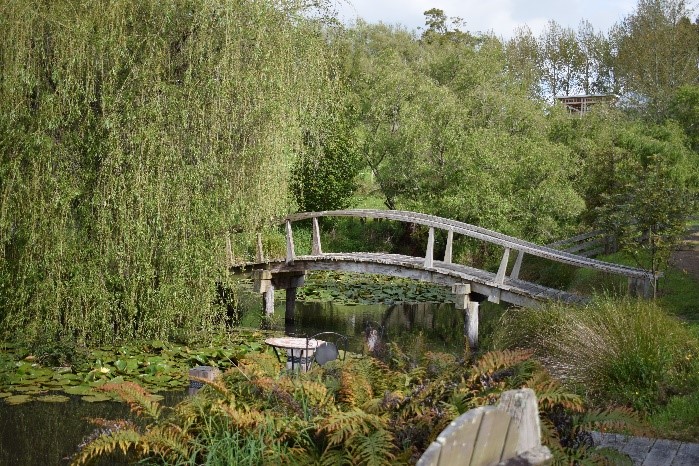










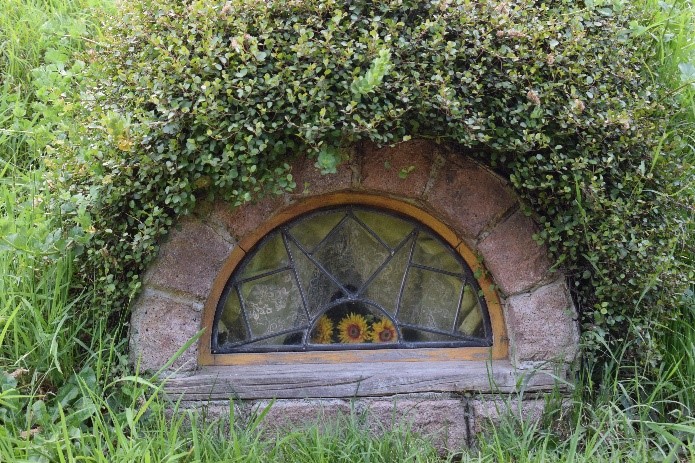

We had a most magical time, and even though we are all stuck at our homes right now, I hope these memories of mine took you there and you enjoyed them!
~Marne
Beautiful pictures. What an amazing trip to visit the Hobbit movie set !!
“It's a dangerous business, Frodo, going out of your door," he used to say. "You step into the Road, and if you don't keep your feet, there is no knowing where you might be swept off to.”
The following was written by Christy.
Greetings from my remote shipping department. In the Before Times, even with a small crew here at Northeast, there was never a dull moment. Between the ever-present game of What- is-Brian-Eating, or keeping a running tally of every time Tom says “Tom,” and trying to decode my cryptic emails, it was always bustling and busy with orders to get shipped out. These days I do as much as I can remotely, and believe me, my bosses have tried really hard to make this possible for me. Sometimes we have to get creative and I have to write a blog post. These are truly tough times, people.
Working at home is just as strange as it is interesting, though. Instead of getting sidetracked by office banter, I now find myself chasing after my dog at a moment’s notice because he got into the laundry again. Have you ever tried working from home with a high-energy dog? They don’t like losing your attention. He’s learned about four new tricks ever since I started working from home, so I guess you can say he also puts in a good shift every day.
As the saying goes, you don’t know what you got ‘til it’s gone. I didn’t realize how much of the little things in the office I would miss until I wasn’t in there with the rest of the team. Running jokes just aren’t the same through messenger, and now it’s so quiet I’ve started responding to myself when I think out loud just to fill the silence. There are some perks to working from home though. Namely, I have access to my air fryer. My questionable wardrobe choices aren’t subject to the judgment of my peers, and I’m now testing the boundaries of how much coffee is too much coffee. I’ve also discovered just how much wildlife lives in the woods outside of my home. I didn’t know we had turkeys!
Throughout all of this, I am happy that we’ve managed to go through the changes that keep us safe and healthy, as well as busy! We hope you are all doing the same and finding creative ways to keep yourselves busy. Feel free to comment on this blog and share with us what you've been doing during all of this.
I now turn the conversation to my favorite subject: food!
There’s no doubt that you’ve been curious from time to time just what exactly it is that we eat at these coin shows. “What does Brian eat?” has unquestionably been a nagging question for you readers. Well, I’m hoping I can answer this burning question and any others you may have.
Breakfast is relatively easy as many options are available either inside the hotel or on the walk to the convention center. However, getting in meals at these convention centers, let alone nutritious meals, can be quite the daunting challenge. We try to let the trade show coordinators know that those little snack packs that are included on our table at some shows...well, sometimes that is lunch for three people, so keep ‘em coming. When it is crazy busy, we don't often have time to pick up a lunch, never mind eat it. With the shows going sometimes until 8:00 PM, this can be a long time going without sustenance. Insert pitiful violin music
While there are indeed other 'options' available at coin shows (many of them which are chosen much to my astonishment by throngs of people), it seems better for you (and the environment for that matter) to not eat at all. I’ll bet a Nathaniel’s foot long is great if you’re on Coney Island or at a BBQ at home, but the ones that roll around on those hot grease-laden tubes for days on end make me want to start a Dalai Lama-style fasting on the double.
Perhaps the biggest challenge faced at some convention centers is a policy of not allowing outside food or drink onto the bourse floor. While I have never seen the drink rule enforced*, I (and many others) certainly have been stopped trying to bring in boxes of food, which apparently, is a major crime. Let’s take a look at some of the major criminals of our time:
1) Al “Scarface” Capone - tax evasion (some hint that he was involved in other unlawful activities as well)
2) Ted “The Unibomber” Kaczynski – responsible for more than a dozen terrorist bomb attacks that killed three people and injured 23 others
3) Brian “The Mule” Alty – apprehended carrying unlawful and possibly nutritious contraband into known convention centers with intent to consume/distribute.
Now, there is a way around this (do not try this at home): one can simply get an unmarked bag large enough to put the illegal lunch items in and stroll right past security (think Andy Dufresne from the Shawshank Redemption walking into the Bank of Portland to withdraw the warden’s money). I can’t help but feel a little like Jason Bourne steadfastly avoiding the convention center Polizei. “They can’t search the bags without a warrant” I remind myself as I smugly traipse through their thin line of defense and across the goalmouth of the Bourse floor to victory!!!
I then deliver the goods to the fine people at Northeast Numismatics (and sometimes Bill Shamhart).
So, this ended up being a teaser. Tune in next time and I’ll regale you all with what and how we eat at these shows (and even at our office). It’ll be sure to put a smile on your face.
For now, be well, be safe, be informed and try to help others!
*I defy anyone including weapon-toting law enforcement to take away my morning cold brew iced coffee (two creams, no sugar if you’re buying next time). They would have to pry it from my cold, dead hands. Think Michael Douglas/Falling Down on steroids.
The following was written by Brian.
I miss the road. There, I said it.
We’re already (or should I say only?) two coin shows down due to COVID-19 and we’re not out of the woods yet. This could be the summer that wasn’t.
Before this whole mess started, it was a fairly grueling road schedule; Winter Fun in Orlando, St. Louis Show, Mid America Show in Illinois, followed by Long Beach Expo, followed a couple days later by the ANA in Atlanta. For this very busy January/February schedule we *should* have been rewarded with the Whitman Expo in Baltimore followed by Central States. Those two shows, as you may well know, have been cancelled. If the Summer Fun and Whitman Shows are cancelled (not to mention the many smaller shows we attend in between), we are talking half a year worth of shows cancelled. And I already miss it.
I miss getting up earlier than usual and going to work and then going straight to the airport and straight to the hotel and straight to bed and then waking up and going straight to the show for 10 or 11 hours - lather, rinse, repeat for 5 days. I actually miss that.
I’m the guy at Northeast that hits the bourse floor with suitcases full of great coins to sell while Chris and Tom are busy manning the table and buying as much as possible. I miss the rush of selling a bunch of coins to someone I didn’t expect to sell any. I miss the thrill of finding that new dealer and forming a relationship in which the potential for years of business will develop. I miss skipping lunch* to hit as many tables as I can. I miss the camaraderie, the laughs and the stories of all my dealer friends, many of whom I can truly call good friends.
I miss seeing fresh material and interesting coins for 10 hours a day. It’s funny, I am told by collectors (with other vocations) that I am lucky to be able to go to all these shows and see so many great coins. To that I say, you’re right! I am lucky! And I miss it.
I miss collectors coming up to our table with their ‘1943 copper cent’ asking us to verify its authenticity**. I miss getting room service instead of going out somewhere nice all because I’m too tired from the long show***.
Joking aside, this challenging time certainly puts a lot into perspective and one thing I know for sure - I am lucky to do what I do. I sure do miss the shows and I can’t wait to get back to it.
* I don’t miss this at all.
** I don’t miss this at all.
*** I don’t miss this at all
Brian, You've written an unusually effective piece. Many of us out here can relate.
Greetings everyone. I sincerely hope every one of you is safe, healthy and getting through this mess with as little hardship/inconvenience as possible.
And as little *boredom* as possible.
Me? I'm the furthest thing from bored right now. There's always plenty to do at Northeast even if we're not in the building, so hopefully I can alleviate some of your boredom with a Northeast-style 'day in the life' of the sales director.
I've been filling my days with a boatload of social media, customer correspondence, dealer networking and washing my hands. I could fill literally months’ worth of posts, whether on Instagram (@nencoin) or Facebook (www.facebook.com/northeastcoin) alone. Please follow us on both if you're not already! Thanks to a robust inventory, it would take years for me to run out of items to talk about and showcase. And though I'm quite busy with all of this, I welcome your input as to what you think an online coin company can be doing ITCT.
Perhaps more interesting than the above work/task tidbits is how it all plays out in a work from home (from here out 'WFH') environment. First off, setting work/home life boundaries when WFH is easier said than done. Pre-COVID, I would typically rise each morning early due to a fairly long but not unreasonable commute. Now, I get up and immediately start in on what I didn't finish the night before (which went much later than a 'normal' workday because I had no commute home and I'm not going anywhere anyway any time soon). We're on week two of the state-mandated lockdown and already days are blending from one to the next, but it's not all that bad because I'm pretty sure it's Friday. My guess is that by the time I have a solid WFH daily routine/schedule, it'll be time to go back to the office (God-willin' and the creek don't rise!), but it's a fluid situation and we shall see.
Secondly, it has occurred to me that some things that naturally occur at the office don't necessarily translate to WFH; for instance, drinking plenty of water throughout the day. Hearing our "bubbler" (as we New Englanders like to call it) or water cooler (as everyone else in the country calls it) elicits a Pavlovian-type response to get up and go refill many times throughout the day, but the absence of that at home results in having to set reminders throughout the day to drink more water or else become dehydrated. It's a fluid situation. : )
There are many other relatively minor concessions that are made in the WFH environment (to go along with, admittedly, decided advantages), and though I'm not quite ready to pull out what little hair I have left, I will concede that separate work and life spaces is probably for the best. I'm already welcoming a return to the office and seeing my mates and looking at actual coins again!
Until next time, remember, we're all in this together, separately, in these challenging times.
Brian Alty
Director of Sales

You are not the only place that calls it a bubbler. Here in Wisconsin it is also known as a bubbler and some of the best pizza around can be found at a bar in Bay View (within the city of Milwaukee) called "The Bubbler".
We stand corrected! Perhaps we should have said that here in New England, or at least in the Boston area, we call it the Bubblah. R's don't always flow off the tongue here. : )
The following was written by Tom.
We returned this past weekend from the 56th Annual Greater American Coin Fair in St. Louis, MO. This show, which is one of our favorites, takes place directly across from the airport, which is about a 3-minute shuttle ride.
The word vintage comes to mind when considering how best to describe this show, as it is held in a 19th century Hilton Hotel with its walls and corridors adorned with old framed TWA posters of stars from another era; stars such as Marilyn Monroe, Cary Grant, Bob Hope and other lesser knowns. They are shown departing on TWA flights when the airline first flew into St Louis in the early 1960’s.
St. Louis is one of those shows that gets a good mix of regional and national dealers who can easily fly in for a quick visit and fly home. It’s also a hot spot for collectors (who have been known to drive for several hours) with money burning a hole in their pockets to buy for specific needs, or with product ready to sell to eager buyers. Few are just browsers, but all participants seem to have the same goal in mind.
We always see many of our faithful customers; often those who primarily see our inventory online and are now getting a first-hand look. We also tend to meet new clients anxious to do business. We can thank Mike Orlando for many of these new customers. Mike has managed this show for decades, doing an excellent job with his friendly coin club volunteers.
While we fully appreciate what this show has to offer, there is one minor downside. The Greater American Coin Fair has (easily) the most cramped aisles of any show we regularly attend. Never fear though, each table comes faithfully stocked with a jar of Vaseline, a can opener, and the jaws of life to get in and out of the booths.
The Fair takes place in two small rooms, with the bourse floor right off the lobby. A narrow back up table is shared with the dealer behind us and our table is in the middle of a row. If either of us wants to get out, we have upwards of ten people to slink past as we make our way down to the end of the row. Brian and I, however, figured out a better way. Turns out, crawling under the table to get in or out of the booth is much mor efficient, which we proved about two dozen times. Still, this show remains one of our favorites with its down home, friendly feel. We look forward to it every year and this year was no exception.
From the get-go, dealers packed the room and trading began immediately. In this type of atmosphere, it is much more likely that dealers will come to your table to buy your coins, rather than waiting for you to come to them. The general public traffic over the next couple days was robust and it was very nice to put faces to names with some of the customers and smaller dealers that we have been working with recently.
Overall, we were happy with the retail business we did and for the opportunity to buy fresh, different material that we sometimes don't see at the usual major shows we attend (i.e.., Baltimore, Long Beach, ANA). We have been busy this week listing our new purchases from the show.
On Friday night, with a hankering for Indian food, Brian and I took a shot at a little place called Gokul, as it had many positive reviews. From this point forward, I'll never forget that Gokul is located in "The Delmar Loop" area of St. Louis, as our Uber driver mentioned this fact upwards of 57 times. Upon arrival at the restaurant, Brian spotted this sign on the window. I was delighted; Brian not so much. Still, it was very good (editor’s note: so says Tom).

There were far too many St. Louis Blues hockey jerseys and way too much Kansas City Chiefs gear (Kansas City, Missouri, that is). Being sports fans in New England, we’ve been pretty spoiled, so it was a tad painful to see all of the constant reminders of the teams that bested us these past hockey and football seasons. But we dealt with it alright and are certainly looking forward to attending this show again.
We'd like to give a big shout out to Ralph, a customer of ours from Baton Rouge, who helped us kick off the carnival season by sending us this King Cake! As is our custom when any goodies show up, and particularly with King Cakes, we got right to work demolishing it. Dotty, who is new to this tradition, was excited to get the baby, particularly when she learned that it mean good luck for the rest of the year. She was a little less enthused, however, once she found out it also means she has to buy the next cake. : )



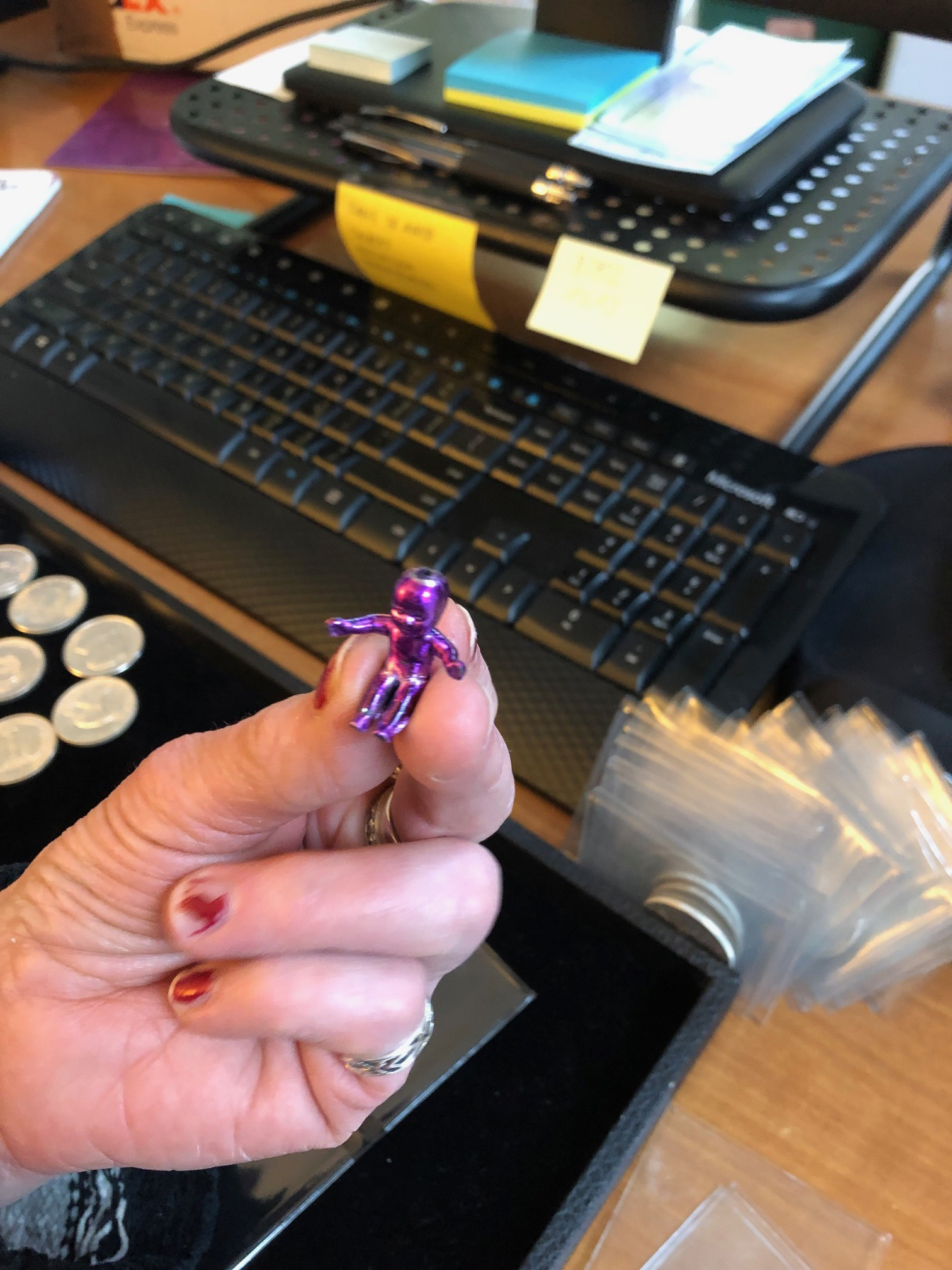
The following was written by Tom.
This is an old New England saying, as the weather can sometimes vary tremendously within any 24-hour period. Last weekend this was certainly the case, with a record setting temperature for the month of January of 74 degrees. January is a time when we can potentially have several feet of snow. It was a pleasure going out for my weekend walk over the old North Bridge, through the town forest Fairyland, around Walden pond, and up and over Fairhaven Hill and back home in short sleeves and shorts. This is simply unheard of in the month of January in these parts. A day or two later we had temperatures in the low 30’s with several inches of snow, and as you can see, I built a snowman with my grandson Fergus. This past week we have had some 10 to 15-degree days, tomorrow rain is forecasted, followed by sunny warmer weather the following day. We never know what to expect.
Speaking of hot and cold, the recent FUN show in Orlando was one of our hottest and most active, as Brian, Chris, Steven, and I were busy doing pre-show business, seeing clients and dealer contacts, as well as seeing many long-time website customers. The constant activity of buying and selling, meeting new customers, and dealer-to-business, continued nonstop up until shows ended on Saturday. We always love starting off the new year with this popular event, and certainly all anticipations were met. I made every winter FUN show since 1972 and I’d never thought of missing one. Yikes - that’s 48 years! Hard to believe. And by the way, we also managed to get some time in at the NYINC world show a few days later. No rest for the weary!
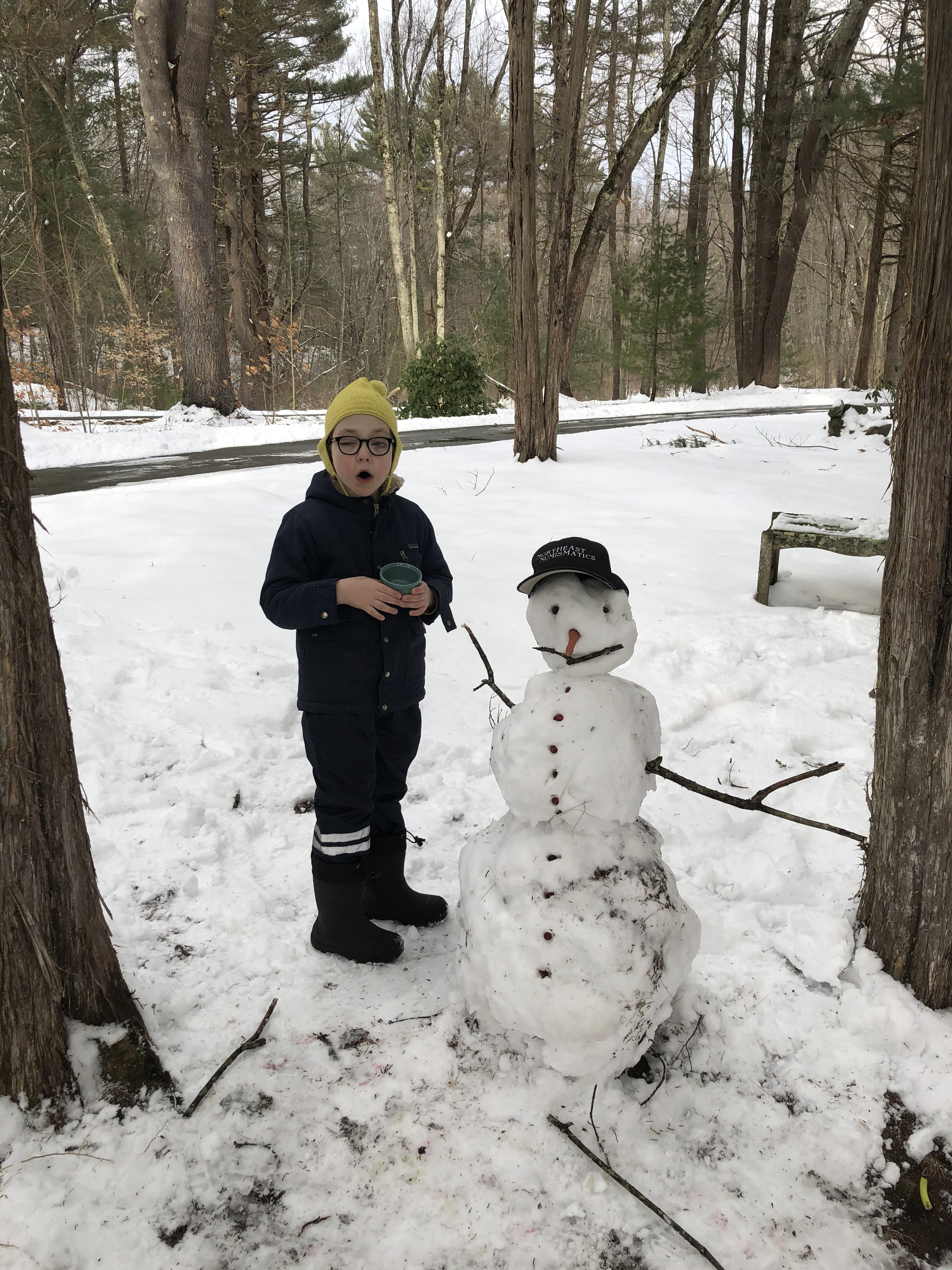

The following was posted by Chris.
Check out this find at a wine store near me this past weekend. Mercury Head Cabernet. Really high star rating, but also really expensive. I couldn't help myself and had to buy it. (Then explain to my wife when I brought it home that this nice wine is NOT for drinking!)
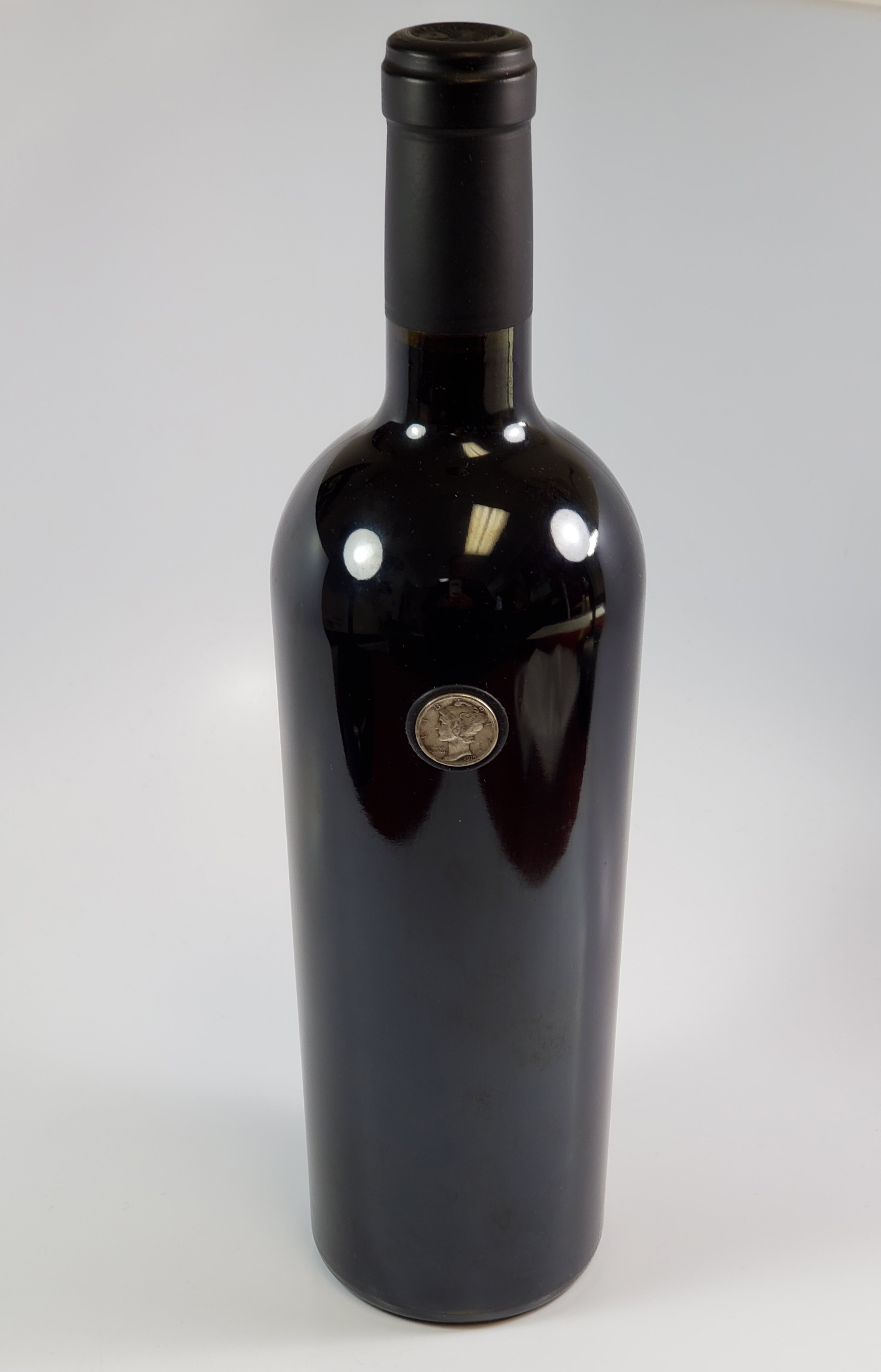
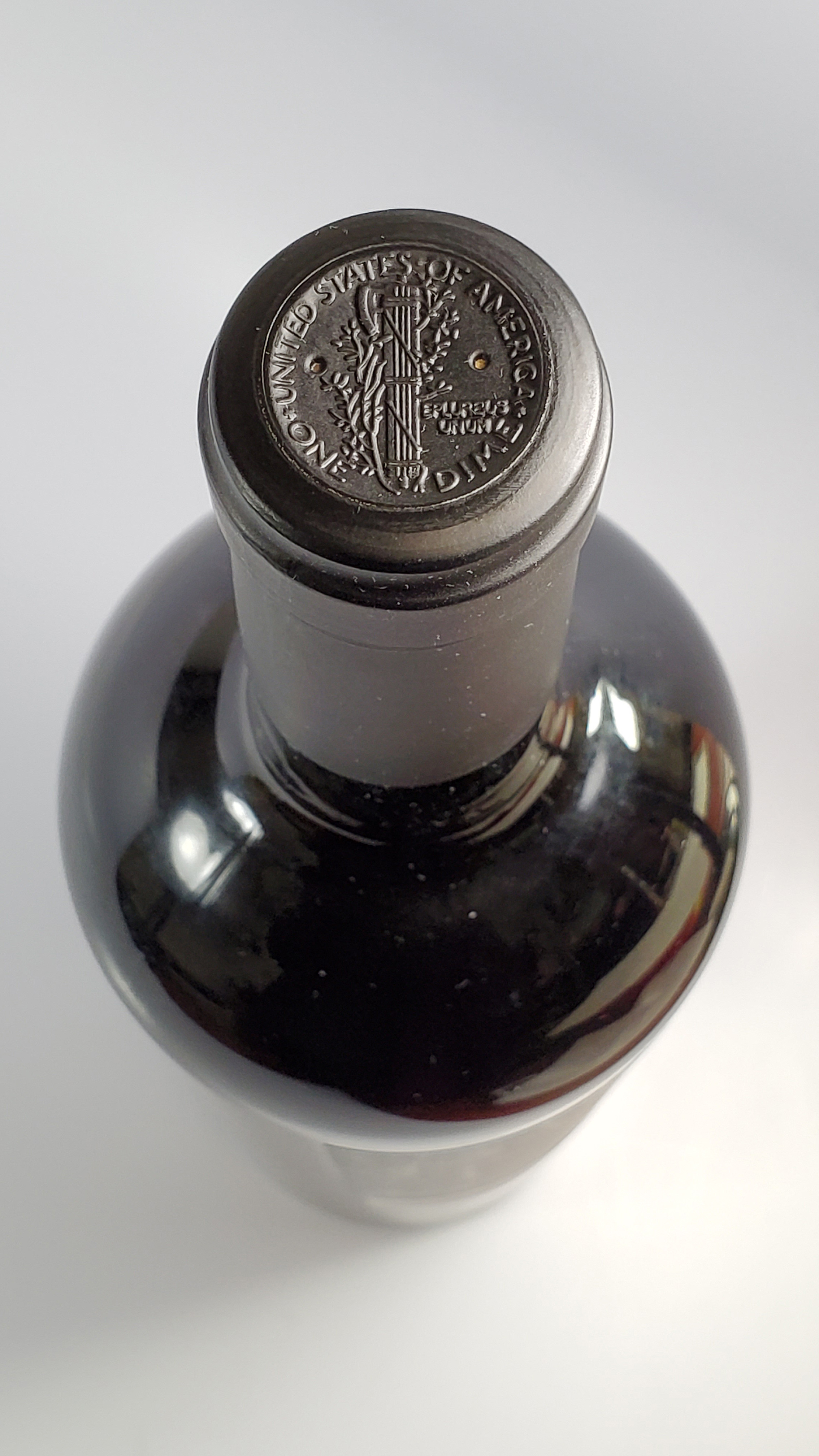

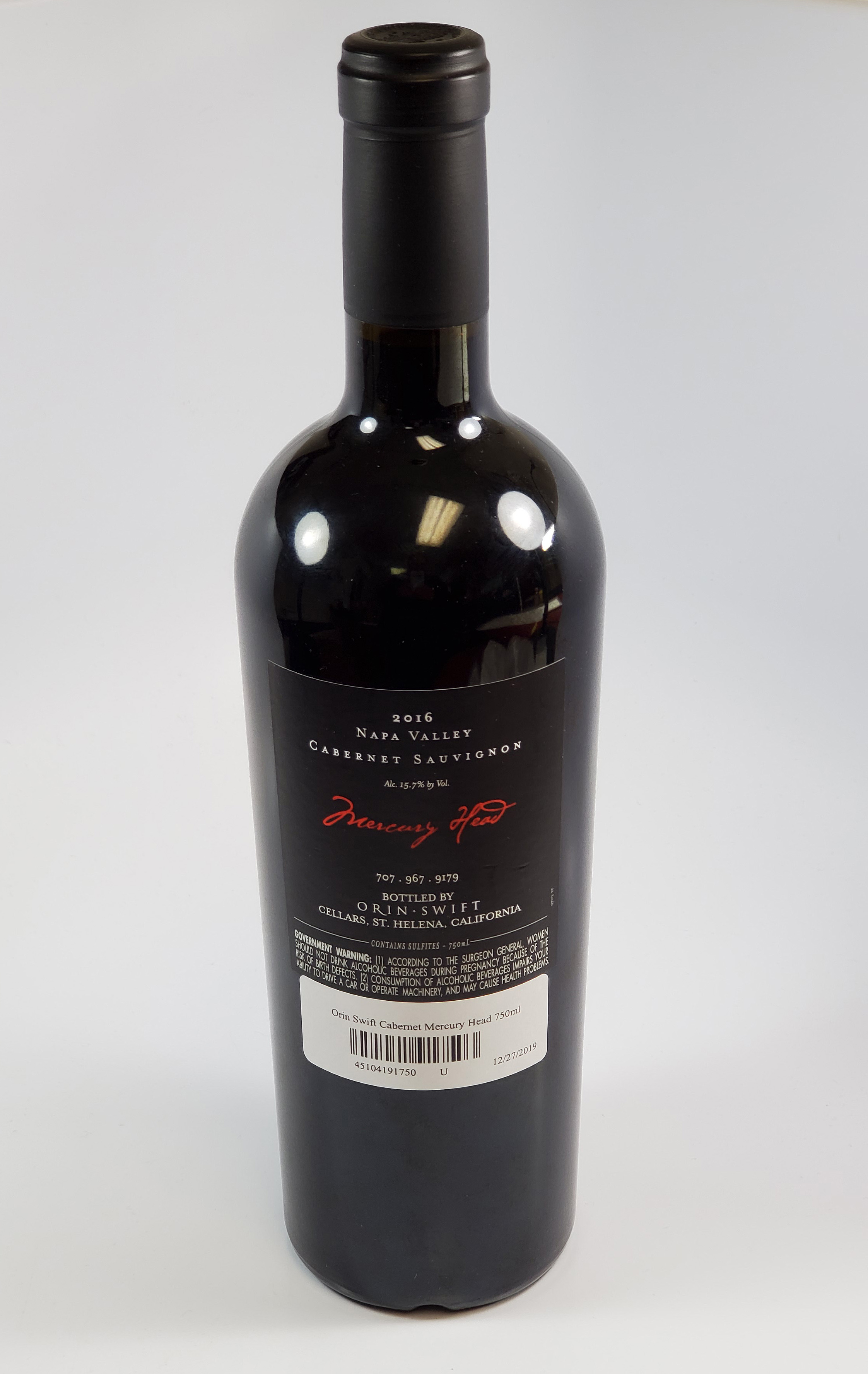
Nice replica!
No replica! That's an authentic 1919 dated Mercury Head dime.
Now, if you could only find one with a 42 over 41!
No doubt!
From all of us here at Northeast, we wish you and yours a very Happy Thanksgiving!

The Lutes and Wing Set:
1943 Coppers that Popularized Numismatics
A miracle was forged from America’s darkest years of conflict. During World War II, the United States Mint altered Lincoln cent production to suit the needs of a desperate nation, but transition was not seamless. The result was a spectacular numismatic legend. The 1943 cent should only have been struck from steel, yet a rare few were accidently made using copper planchets. Pocket-change discoveries of the error would hit like bolts of lightning across the country as millions lusted for the pride, money, and fame they would bring. But just twenty-six examples of this enigmatic off-metal issue ever materialized. Two are here today, united together in a unique, special-purpose NGC holder.
Ignited by the attack on Pearl Harbor, our country was whipped into a frenzy of patriotic fervor. In 1942, alternatives to the copper cent were explored to save materials necessary for war. Cent production waned in the latter months of that year, as copper was diverted from the Mint to munitions factories for use in jacketed bullets and brass shell casings. The coining presses remained silent until February 12th, 1943 (Lincoln’s birthday), when Mint Director Nellie Tayloe Ross ordered production of steel cents at the Philadelphia Mint. Along with the scrap drives, strict rationing, frequent blackouts, and war bonds came a new type of coin.
Conflict ended in 1945, and American GIs returned home to enjoy the postwar boom. Amidst the excitement, one Massachusetts high schooler’s chance discovery left the nation shocked. Seventeen-year-old Don Lutes Jr. of Pittsfield had found a 1943-dated copper cent in his cafeteria change. The Treasury Department denied his discovery, writing that “copper pennies were not struck in 1943,” but renowned numismatist Walter Breen would confirm the authenticity of Lutes’ coin. Lutes had struck the jackpot with his unique error. He received hefty offers for the 1943 copper—including an enticing $10,000—but refused to sell. Lutes finally parted ways with his discovery last year, and Northeast Numismatics acquired the coin.
The public was enthralled by Lutes’ story. People across the country from all walks of life began to feverishly search for their own ‘golden ticket’ 1943 copper. Rumors circulated that Henry Ford would trade a brand-new sedan for one of the errors. Ambitious marketers exploited the situation by selling copper-plated 1943 steel cents as novelties, creating a plague of false flag discoveries that continues today. Each discovery of a genuine example was highly publicized by the media. All the enthusiasm helped contribute to numismatics’ golden age of the 1950s and 1960s, when the ‘hobby of kings’ became as much a part of American life as baseball and barbecues.
Don Lutes was not the first collector to find a 1943 copper cent. Fourteen-year-old Kenneth S. Wing Jr. of Long Beach, California identified a 1943-S (San Francisco Mint) example in circulation during 1944. Wing did not publicize his find, and its existence remained essentially unknown to the numismatic community for many years. Wing was told privately in a 1948 meeting with the Superintendent of the San Francisco Mint that his find was likely genuine, yet the Treasury refused to recognize its authenticity. Smithsonian Curator Vladimir Clain-Stefanelli wrote in 1957 that “The authenticity of this piece is in my opinion beyond doubt.” In 2008, Wing’s family sold the coin to an Orange County dealer, and Northeast Numismatics recently purchased it at auction.
Our NGC two-coin set, containing both the Lutes and Wing specimens, is immensely significant. There are only nineteen known 1943 coppers from Philadelphia and six from San Francisco. Obtaining specimens from both mints is a daunting challenge for even the most deep-pocketed of collectors. A single 1943 Denver copper is known to exist. It became the most valuable Lincoln cent ever after selling in 2010 for a record $1.7 million and will likely not be available again for a very long time. In addition, both the Lutes and Wing specimens are discovery coins -- the first of their kind to publicly surface (a highly desirable fact for collectors). Both coins are exceptionally well-preserved, showcasing minor handling that is consistent with the grade along with rich, glossy chocolate-brown surfaces.
At the heart of the lore that propelled the 1943 copper cent to its celebrity status, these two coins popularized numismatics. They transcend our hobby and would serve as the keystone of any first-rate collection.
Written by Benjamin Simpson
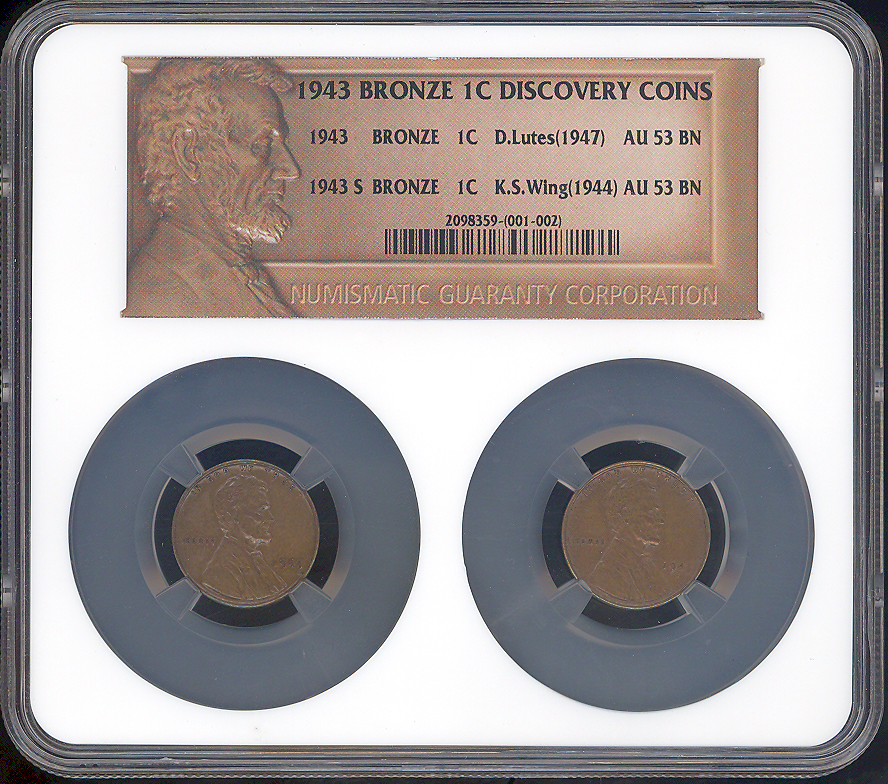
Hard at work...
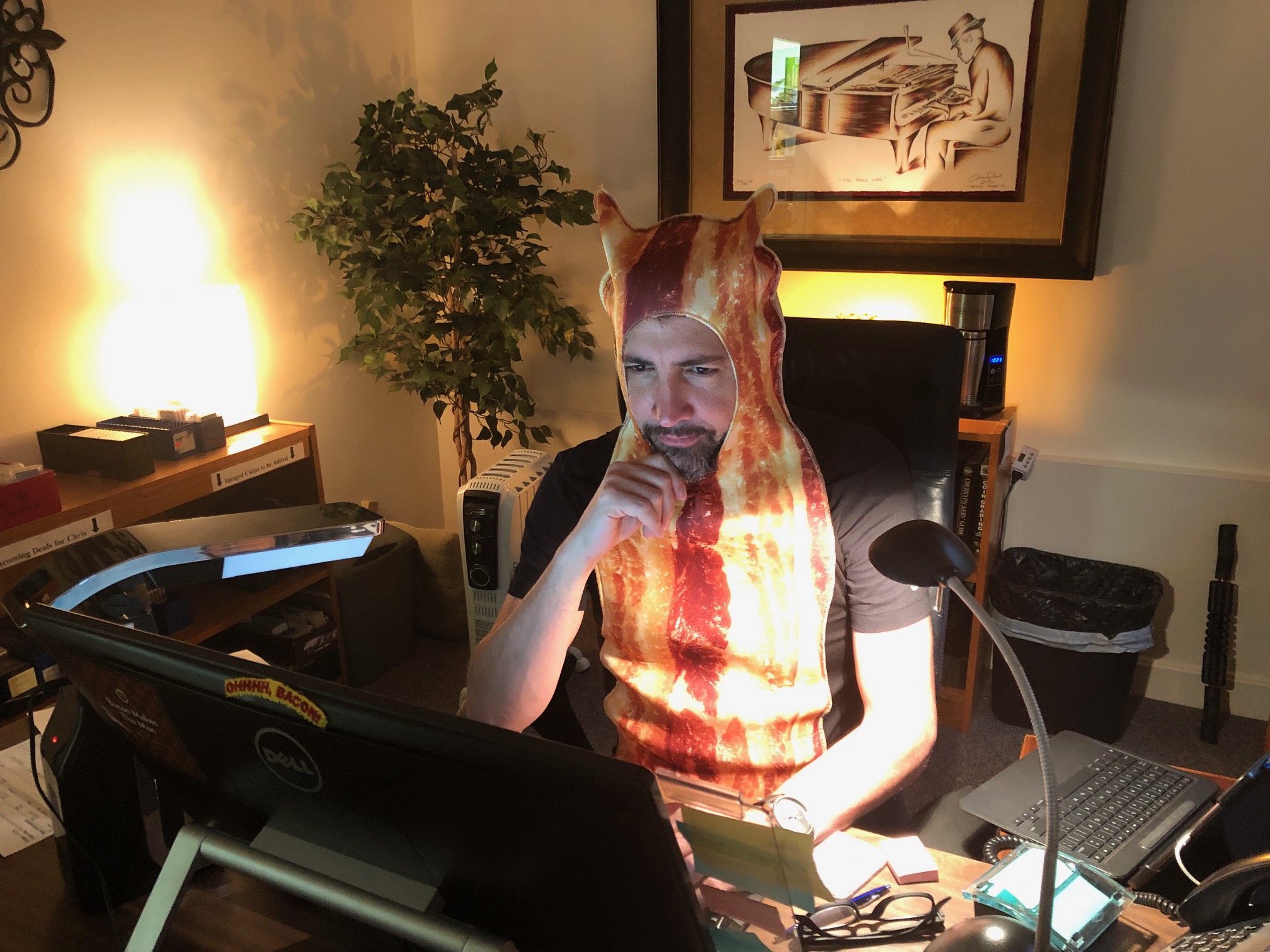

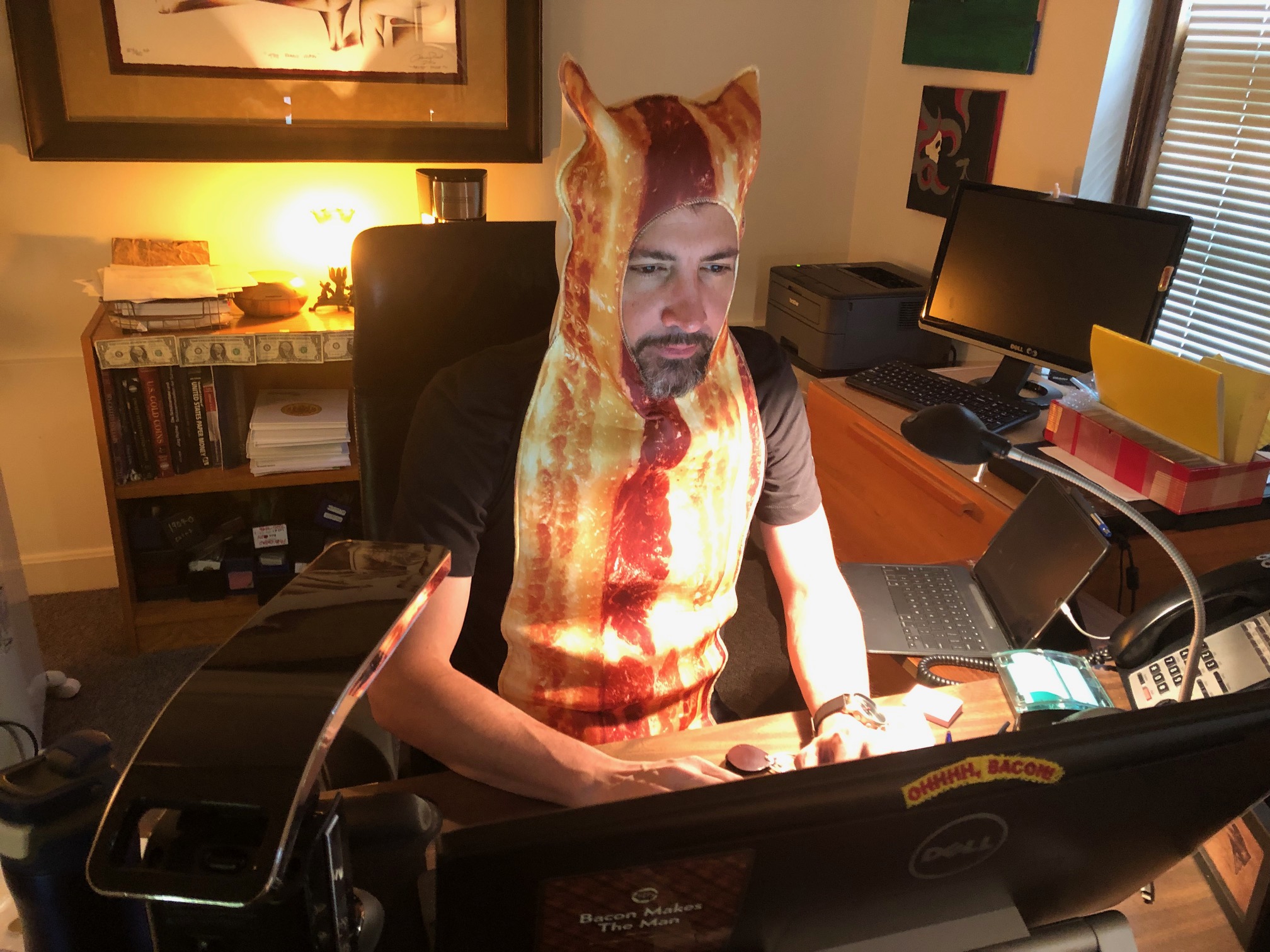
Chris would like to give a special Halloween shout-out to his friend Dave in CA.
Nintendo anyone?

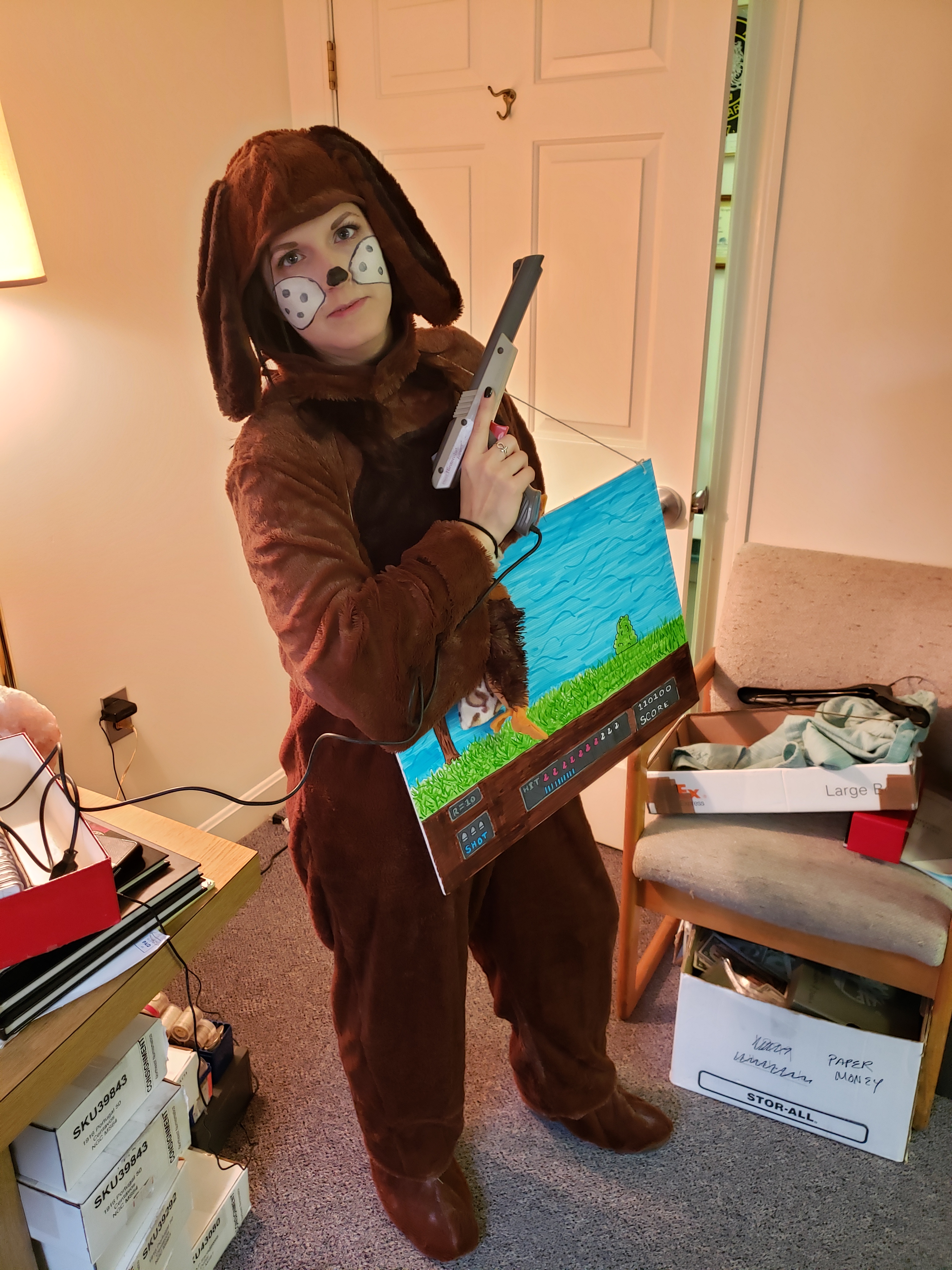

WOW! The Northeast TEAM is the Best...they are a real 'hoooowl'...
And..."may you have a fang-tastic evening, ghoul-friends! :)
LOL! Thank you, Pat! You too.
This video was shot at the ANA World's Fair of Money in August of this year.
The following was written by Brian:
Yes, I'm asking that question in my very best Jerry Seinfeld voice. Hairlines on coins can be a somewhat confusing topic.

Here's how a typical conversation can go with my boss:
Me: Do you think this would grade proof 63?
Tom: No, too many hairlines. Looks like it would grade proof 62.
Me: Okay, how about this coin? What do you think it would grade?
Tom: I think it would 'no grade'. It would likely go into a Details holder. Too many hairlines.
Ummm, excuse me?
Are we saying some hairlines are better than others? Are not all hairlines created equal? What's The Deal With Hairlines Anyway?
Hairlines are basically tiny, usually shallow, incuse scratches on the surface of the coin from handling, a small amount of circulation or cleaning.
Let's be clear - hairlines are never inherently a good thing, but they *are* acceptable in some cases and not in others. It all boils down to how the hairlines were created. One way is via cleaning a coin (this is the less than acceptable manner, btw). We all know cleaning coins is bad, right? Ok, good, just making sure we're on the same page. Cleaning, as we know, diminishes the luster of a coin. Dimished luster decreases the eye appeal of the coin. Decreased eye appeal lowers the value of the coin (although you can definitely score a better date coin for less $ if you don't mind the cleaning). Here's an example of a harshly cleaned coin that exhibits plenty of hairline scratches and thus would not be considered worthy of grading:

With proof coins, the extent of hairlines is one of the main determinants in grading. You probably won't find much in the way of hairlines on high grade proofs, but you might see a good amount on lower grade examples. Here is a coin graded Proof 61. As you can see, a good amount of hairlines are present, but that is a result of basic handling, album slidemarks, etc.

Please keep in mind that because of the immensely varying degrees, the assesment of hairlines and grade assignments are best left to the experts at the third party grading companies. Please also keep in mind that none of this has to do with die polish, which (and you can thank me later) we'll get into next time. Thanks for reading.
A Swedish 2 Daler and a German 1/32 Ducat. Wow!

Lol
The following was written by Tom:
Seeing a couple of recent articles on E-Sylum reminds me of something I noticed years ago in the way that proof mintages have been reported in the Red Book and the way they are reported now. Look at an old Red Book and you will note that the mintage figures reported for business strikes do not distinguish whether the amount listed includes proofs or not. Next, compare any given coin's mintage figures in early editions with more recent ones, and you'll see that all business strike mintages are lower - by the amount of the proof mintages. So the mintages did not really change; they are simply reported more accurately today.
There are, however, instances where some mintages did truly change (sort of)...
Take the case of an 1879 quarter in proof which early editions of the Red Book report at 250. Back in the day (in the early 1970’s) when I was first traveling to coin shows, it was well known that something was wrong with this mintage figure. There were way too many on the market; pretty much an equal amount of the 1870 as other comparable years of the era. We would advertise them as “the lowest reported mintage figures” of the series, which at 250 pieces simply did not compare with all others from 1858 to 1891 - those with much higher published figures. Who were we to question the Red Book's reporting? Well at some point this figure was indeed questioned and now the figure listed is 1100 proofs. So, were 850 pieces suddenly minted over a century later? Was a hoard discovered? No, of course not.
As another example, this past week we had a client interested in an 1858 Seated Dollar in proof that is on the market, and he mentioned there were 210 pieces minted. Correcting him (or so I thought), I said there were only 80 pieces (it takes a real old-time coin weenie to remember random mintages). Later, I was curious if this might be a case of changing mintages. Sure enough, the 80 piece number I recalled was correct in my ‘early Red Book mindk' only to be changed to what is now considered more accurate - 210 as reported in recent editions.
The reporting of mintage figures in the 19th century, proofs in particular, was not always accurate. Through research, new information comes to light and new documents discovered. Though mintage figures do not technically change, they do become more reliable and accurate.
I think the more reliable way to compare mintages is PCGS/NGC population report.
However, I also found some more number changes in the Red Book related to Proof 1913 Nickels.
Mintages first appeared in the 16th edition (1963), the numbers were unchanged through 1966 and showed: *2,594
The asterisk indicated this was the total for both Type 1 and Type 2.
From 1967 - 1974, the number changed to *3,034 (also for a total for both Type 1 and Type 2)
Starting in 1975, they listed the numbers for each
1,520 Type 1
1,514 Type 2
Which totals the 3,034 that was listed from 1967-1974.
What is interesting is going through these daily totals in the Mint daily records as they do indicate the number of proofs.
They also have a specific entry for the total Type 1 numbers, showing the last day of delivery was May 9th.
These numbers are 20,992,000 regular coinage and 1,520 proofs.
The daily break down is:
Mar 5: 1,000
Mar 20: 300
May 4: 220
Total: 1,520
For Type 2, the daily break down is:
May 27: 250
Oct 14: 110
Nov 20: 285
Dec 2: 233
Dec 24: 196
Total:1,074
If you add these (1,520 and 1,074) you get 2,594, which is the number in the 1963-1966 editions.
I wonder where the other 440 came from?
We are reviving this blog post from several years ago because, well, it's funny. And we welcome your participation!
Some of you are probably familiar with the popular Chuck Norris jokes. Ones like these:
Chuck Norris sleeps with a pillow under his gun.
or
Chuck Norris was an only child...eventually.
Well, one evening (years ago) after work a few of us here met for Mai Tais at the Chinese restaurant below our (at the time) office. We began scratching out some coin-related Chuck Norris jokes. Easy to do after a potent Mai Tai. For those who appreciate the regular Chuck Norris jokes, we invite you to read on and add any that you can come up with.
*Chuck Norris' coins consistently grade MS71.
*All of Chuck Norris' coins come back from CAC with a platinum sticker.
*Chuck Norris doesn't submit to PCGS or NGC. They submit to him.
*Chuck Norris made the Seated Liberty stand up.
*The Sheldon Scale is being changed to suit Chuck Norris. Gem coins are no longer MS65; they are CS65, or Chuck State 65.
*If Chuck Norris doesn't get the grades he wants, it's the graders who end up in the body bags, not the coins.
*Poorly struck coins are actually just coins that Chuck Norris squeezed too tightly.
*The Greysheet Ask price is irrelevant to Chuck Norris because Chuck Norris never asks for anything.
*Chuck Norris achieved the number one Registry Set ranking for Morgan Dollars even though he's never bought a Morgan Dollar in his life.
*Chuck Norris cracks out coins barehanded...with one hand.
*PCGS blackout dates to not apply to Chuck Norris.
The following is a guest post from Alex Lemaire.
There are many ways to collect coins. One of the most popular is coin hunting with a metal detector. In this short article, I will give you few tips to collect more coins using this device.
Tools needed
In addition to the detector, you need a digging tool, a pouch, and a screwdriver. The latter will help you in coin popping.
Some machines are capable of estimating the depth of the buried metal object. These indicators are calibrated with coin-sized objects. Therefore, if you think the coin isn’t very deep. Pop it up with a screwdriver to preserve the grass.
Old coins are precious. You don’t want to damage them with your digging tool. To avoid this problem you have to determine their exact location. This is why you need a pinpointer. It is also important to dig slowly.
Places to hunt
There are many locations where you can find coins. I can’t list all of them here. So I’ll give some tips for coin hunting in three common places.
*Parks are the most obvious places where you can hunt for coins. In most cases, you don’t need permission to use your metal detector. However, I recommend you check your local laws.
Scanning an entire park isn’t practical. Therefore you need to start with spots where you are most likely to find lost coins. Trees shades and park benches are good places to start with. People lose coins when they sit. Sandboxes, slides, and swings…are good spots too. You can find some cheap coins lost by kids.
Make sure you carry a trash bag with you to remove any sharp metal object you find. This way, you hunt coins and you help to make parks safer for kids. Use small digging tools (trowel not a shovel) and fill the hole you dug.
*Another common spot to hunt is sports fields. Always dig the surroundings not the actual playing field.
As always, start with the bleachers and trees where spectators set their lawn chairs to watch the match. Sidelines, along the fences and behind the home plate (in the case of baseball fields) are very good locations too. People will lose coins when they are jumping and cheering players.
Don’t forget to hunt for coins near concession stands and the parking lots. Coins spill out of pockets when people buy something or reach out for their keys.
*You may not find many coins in open fields. But, they will certainly be older and more valuable. To find good locations, you need to do some research before going for a hunt. This means that you need to check old plat maps, county atlas, old aerial photos… They are easily accessible in local libraries and local museums or online.
You need to look for is old structures (houses, Barnes, churches…) that no longer exist. You will find very precious coins around them.
To conclude, coin hunting is an easy and enjoyable hobby. You need nothing more than basic tools. And to make your hunts more successful, target areas with a lot of human activity.
About Alex Lemaire: Alex is passionate about unearthing history and collecting coins and relics. He thinks that metal detectors are time machines that help us know more about our ancestors’ lifestyle. You can follow him on his blog at Metaldetectorplanet.com.
The following was written by Brian.
Mintage or Survival Rates? What's More Important?
One of the first questions collectors ask me about a coin they are considering is "what is the mintage?". Of course, if I do not have the answer off the top of my head, I'll look it up. However, the research doesn't and shouldn't end there. One of the oft overlooked aspects of coin availability is survival rate.
Survival rate is an estimate of the number of coins believed to exist for any particular issue. One good example of a coin with misleading availability is the 1932 Saint Gauden's Double Eagle. The coin had a mintage of 1,101,750. It shouldn't be too difficult to get your hands on one of those, yes? Well, no, as that particular issue was ordered melted by the US Government. In fact, most 1932 double eagles were melted following the abandonment of the gold standard in the 1933 by President Franklin Delano Roosevelt. As some of those coins eventually came out of the woodworks, what came to be was a coin with a high mintage, yet an incredibly low survival rate. Estimates are somewhere around 175 mint state graded coins and literally zero known in circulated grades.
Another good example is the 1876-CC 20 Cent piece. Coin mintage was 10,000, which is by all standards low, but the survivability of around 16 known is shockingly low. In a letter dated March 19, 1877, the Director of the Mint (Henry R. Linderman) ordered the Superintendent of the Carson City Mint (James Crawford) to melt down all Twenty Cents still on hand at the time. Presumably, many, if not most of the 1876-CC Twenty Cents were included in the melt. An estimated 16-20 1876-CC Twenty Cents are known today.
So word to the wise; be sure to check survival rate before considering a coin too expensive when it shows a high mintage. There could be more to the story.
The following was written by Brian.
I often overhear the question 'how is a PL/DMPL coin created'. I have heard everything from die polish to early die state and everything in between as reasons, but the truth is that it is the complete die preparation (not just simple polishing) that creates these eye appealing and in-demand coins.
The creation of DMPL and PL Morgan Dollars mostly occurs in the production process of the individual dies that are used to strike the coins. Dies were made individually from a so-called master hub with all of the major design elements which are then transferred to the individual dies. These dies are then basined, which is where the prooflike factor comes in. During this process the dies were placed against a zinc receptacle that contained water and fine grind particles that were slowly revolving, continually polishing the die. Depending on the amount of time the die was polished a prooflike or even deep-mirror prooflike die could be produced. Q. David Bowers proposes in his Guide Book of Morgan Silver Dollars that the dies that struck DMPL coins were inadvertently polished for too long, but this is merely a theory that has not been confirmed. It is possible that some dies were polished longer than others on purpose, perhaps to show off the quality and workmanship of the employees at the various mints.
As you can see in the images below from PCGS (www.pcgs.com/news/a-look-at-pcgs-designations), the mirrors can be highly reflective and when the devices are frosty enough, it gives the appearance of cameo contrast and in my opinion warrants a premium.

The following was written by Chris.
We deal a fair amount in Swiss Shooting Medals. I love the unique and often ornate designs of them. In fact, I have several in my personal collection. While finally getting around to going through a small lot of them that we bought several years ago, I came across this medal.


I could not find a listing of it in the Richter catalog. Granted, it's not actually a shooting medal. Thanks to my quite rusty skills in the German language that I acquired back in college (well, that and Google translate), I determined that the medal commemorates the inauguration in 1939 of the Swiss Shooting Museum. The legend on the medal is in both German and French.
Some further research brought me to this website. This museum is located in Bern, and as you can see it is indeed the one depicted on the medal. I plan on contacting the museum to see if they have seen many of these inauguration medals. If not, I think it would make for an interesting donation for their display.
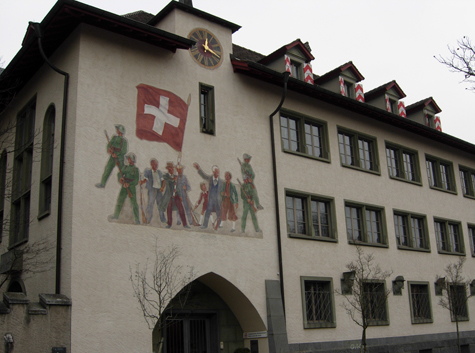
For further information on Swiss Shooting Medals, head on over to Shootingmedals.com. If you'd like to view our current selection of Shooting Medals, you'll find them in the medals section of our inventory.
Update 7/3/2019:
I reached out to the museum to see if they were familiar with the medal. They of course were and had an example on display and another in their archives. I asked if they would be interested in having a third for their collection and they were delighted. The director of the museum, Regula Berger, sent us a very nice note along with several post cards from their museum.
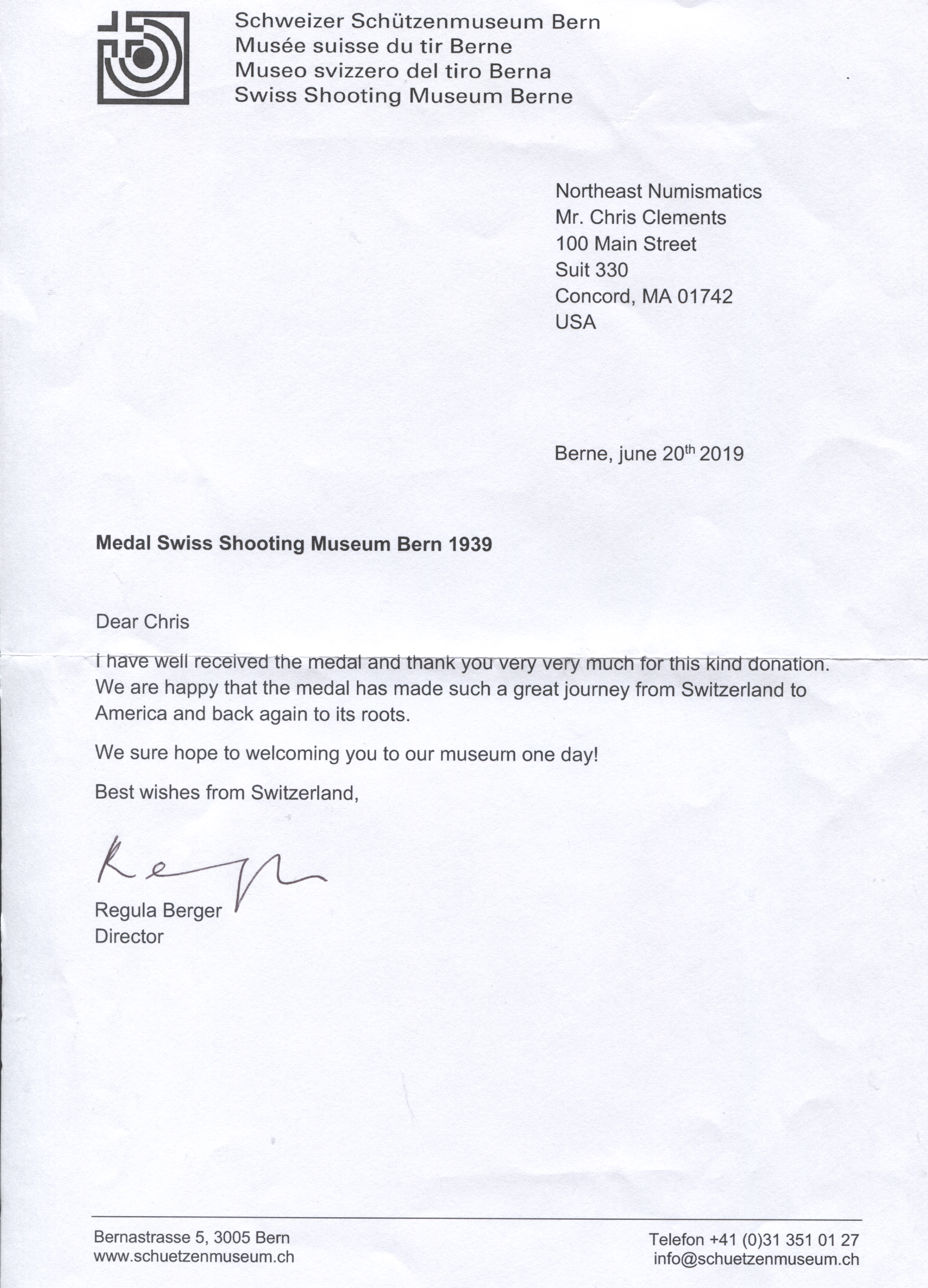

Chris, I'm with you with regard to Swiss Shooting Medals, especially certain of the Beautiful Women set.
The following appeared in a recent E-Sylum article:
Jeff Burke submitted this article on his quest to choose and locate a great Saint-Gaudens $20 gold piece for his collection. Thanks. -Editor
“My Quest to Select One Saint-Gaudens Double Eagle Type Coin”
by Jeff Burke
Introduction
Learning more about Saint-Gaudens double eagles has sparked the bibliophile in me! My ongoing fascination with Saint-Gaudens double eagles (SGDE) started with reading books about the 1933 double eagle. I had the privilege of seeing the 1933 Farouk double eagle specimen at the New-York Historical Society in August 2013 (see my “Star of the Show: A 1933 Double Eagle,” in The Nebraska Numismatic Association Journal, vol. 57, issue 4 (October/November/December 2013), pp. 16-19, for more details).
Curious to learn more about these fabled coins, I read Selling America’s Rarest Coin: The 1933 Double Eagle, David Alexander, 2002; Illegal Tender: Gold, Greed and the Mystery of the Lost 1933 Double Eagle, David Tripp, 2004; Double Eagle: The Epic Story of the World’s Most Valuable Coin, Alison Frankel, 2006; and Striking Change: The Great Artistic Collaboration of Theodore Roosevelt and Augustus Saint-Gaudens, Michael F. Moran, 2007. I also devoured A Handbook of 20th-Century United States Gold Coins: 1907-1933, David W. Akers, 2008; A Guidebook of Double Eagle Gold Coins, Q. David Bowers, 2004; Renaissance of American Coinage: 1905-1908, Roger Burdette, 2006; and Collecting and Investing Strategies for United States Gold Coins, Jeff Ambio, 2008.
Possessing a large disk of Saint-Gaudens gold has always been visually appealing to me. I previously had a 1922-S PCGS MS 63 double eagle and a 1910-D NGC MS 64 double eagle in my collection. I traded these double eagles for other coins and hadn’t owned a Saint-Gaudens $20 since 2015. To my surprise, I really missed owning one! Perhaps owning a gold coin makes me feel special. I also love the design.
Conducting Research
After contemplating the possibilities, I decided to pursue a better date SGDE in a higher grade. My focus narrowed to an examination of 1923-D double eagles: “A choice or gem specimen is usually a treat to behold, the very definition of eye appeal!” (David Bowers, in reference to the 1923-D double eagle, A Guidebook of Double Eagle Gold Coins, p. 266). I discovered that 1923- D double eagles are plentiful, but have a much smaller population compared to common date SGDE. Here is another reason why I chose this particular coin: “...As most examples (1923-D) are boldly struck and show radiant luster, this date (and mintmark) is often chosen to represent the type if just a single coin is desired.” (Jeff Garrett, Description & Analysis for the 1923-D Saint-Gaudens double eagle, NGC Coin Explorer).
The next step was to order and read Saint-Gaudens Double Eagles: As Illustrated by the Phillip H. Morse and Steven Duckor Collections, by Roger Burdette, ed. by James L. Halperin and Mark Van Winkle, published by Heritage Auctions in 2018. Despite not having a table of contents or index for quick reference, it was a joy to read! My favorite portions were “Background” about United States International Gold Shipment and the engaging Chapter Six - “Lost and Found - Survival of U.S. Gold Coins.” It took Burdette five years to research this masterpiece and another year to write it. (See Wayne Homren’s review of this volume in The E-Sylum, vol. 21, Number 28, July 15, 2018, for more information). This tome is well worth the money!
I learned “...it is estimated that out of 70,290,930 Saint-Gaudens double eagles manufactured between 1907 and 1933, only 2,966,565 coins, or four percent, survive in all states of preservation.” (Burdette, Saint-Gaudens Double Eagles, p. 612). The 1923-D is the last mint marked coin in the Saint-Gaudens $20 series readily available to collectors before surviving populations dwindle and prices escalate. (Burdette, p. 397). The 1923-D saw extensive shipment overseas. “Most pieces seemed to have been preserved in foreign holdings, most likely in Argentina or Brazil (accepted as legal tender), where it was common practice to leave U.S. gold untouched in its original bags.” (Burdette, p. 397).
Making the Purchase  I worked through my old 2007 list of 31 favorite coin dealer websites and other numismatic websites to examine 45 to 50 specimens of 1923-D double eagles. After perusing numerous dealer websites on the Certified Coin Exchange, e-bay and other sites, I kept returning to a 1923-D NGC MS 65* Star Designation double eagle that I saw on the Northeast Numismatics online inventory. Unfamiliar with the NGC Star notation, I conducted some research. According to the NGC Census as of March 21, a total of 1,389 SGDE are listed with the Star Designation, which is 0.14% of SGDE graded by NGC.
I worked through my old 2007 list of 31 favorite coin dealer websites and other numismatic websites to examine 45 to 50 specimens of 1923-D double eagles. After perusing numerous dealer websites on the Certified Coin Exchange, e-bay and other sites, I kept returning to a 1923-D NGC MS 65* Star Designation double eagle that I saw on the Northeast Numismatics online inventory. Unfamiliar with the NGC Star notation, I conducted some research. According to the NGC Census as of March 21, a total of 1,389 SGDE are listed with the Star Designation, which is 0.14% of SGDE graded by NGC.
Tom Caldwell founded Northeast Numismatics in Concord, Massachusetts, in 1964. “Tom is a firm believer that an educated collector is necessary to a strong and sustainable coin market, and has taken great efforts to teach youngsters (and elders) the essentials of coin collecting.” (Northeastcoin.com). Providing numismatic education can help collectors learn more about their collecting interests and encourage others to explore the wonders of our hobby.
I am thrilled to own this beautiful coin! Did it spend decades in Brazil or Argentina? I wanted to keep this 1923-D double eagle next to me forever so I could admire it at my leisure. Reluctantly, I put it in a bank safe deposit box for safekeeping.
Note: Chris Clements of Northeast Numismatics kindly provided obverse and reverse images of my double eagle to accompany this article. Thanks also to Paul Sandler for fielding my questions about Saint-Gaudens double eagle NGC Star Designation coins.
Talk about buying (and reading) the book before the coin! Congratulations on your well-thought-out purchase. Great coin! -Editor
Beautiful coin and great story of how you arrived at this specimen.
Well worthy of the Star designation.
The following was written by Tom:
It’s hard to feel any more patriotic than today, which is Patriots' Day here in Massachusetts. Right here in Concord Center is not too far away from where it all started in 1775 with the “shot heard round the world,” which was the start of the American Revolution. From our office window we have a birds-eye view of the annual celebratory parade. Minuteman groups along with marching bands, scout groups and more make their way along the parade route while thousands of visitors who have come from near and far, watch and celebrate the spectacle.
Speaking of history, the Caldwell family has a long history of involvement in the festivities. Back in the 1960’s I used to march in the parade as a Boy Scout. As the Bicentennial approached, my parents joined the local Minuteman group and also marched in the Concord parade. Later, my two children marched while they were involved in the Scouts.
About halfway through the parade route is the Old North Bridge, at which you’ll find Daniel Chester French’s Minuteman statue. This statue is memorialized on the Concord-Lexington Silver Commemorative Half Dollar (see below). The parade makes a ceremonial stop for speeches as well as a crowd favorite - the reenactment of the famous battle between the British and Colonists at the bridge.
Back in the day as a kid, never would I have thought Concord would become home to my family as well as Northeast Numismatics. Happy Patriots' Day!


I enjoyed your piece, Tom.
Excellent! Glad you enjoyed it.
After placing a 1943 Copper Cent (PCGS XF45) last year with a customer of ours, we picked up this discovery piece (NGC AU53) earlier this year. The following is an article that appeared in the recent CPG Coin & Currency Market Review. Click the link below the blurb to read the article in its entirety.
The Mystique of the 1943 Bronze Cent Spans Time
April 5, 2019
By Joshua McMorrow-Hernandez, Editor
In the 110-year history of the Lincoln cent series, few issues have captured more six- and seven-figure prices, let alone more attention from the general media, than the 1943 Lincoln bronze cent. The origins behind this fantastic transitional off-metal error, a 1943 Lincoln cent intended to be struck on a zinc-coated steel planchet but instead manufactured with a bronze planchet used in striking 1942 Lincoln cents, are somewhat mysterious. What numismatists know is perhaps 20 or fewer bronze planchets from the 1942 run of Lincoln cents were struck as 1943 Lincoln cents, which were supposed to be struck on steel planchets to help save copper for World War II artillery purposes.
Click here to read more.

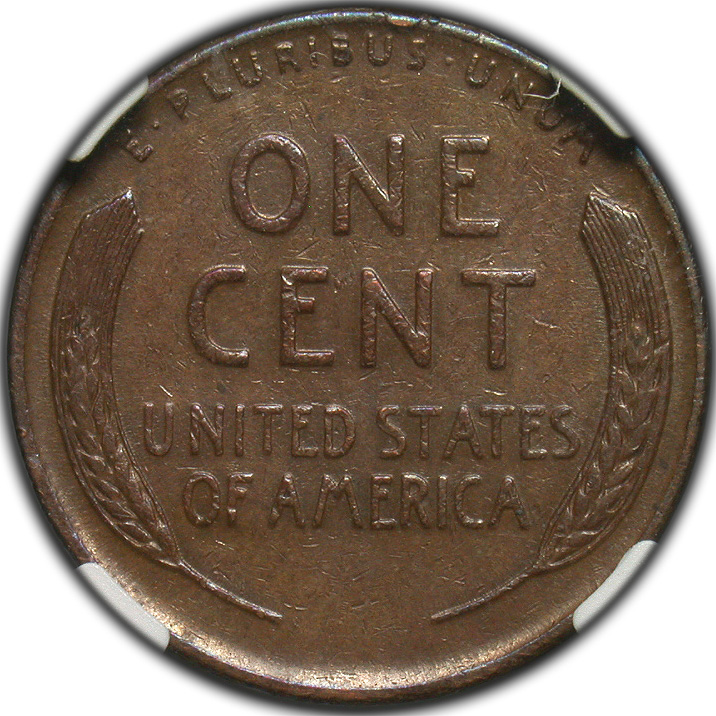
The following was written by Brian:
We have a wonderful customer named Paul from right here in Massachusetts that we have been doing business with for the last couple of years. Paul is 92 and is a spry, fiery sort. We all love him here at Northeast and hope he lives well into his 100's. Paul has been collecting for just shy of 75 years and has built an impressive collection of Lincolns, Flying Eagle Cents, Walkers and Mercury Dimes, among other types. Actually, Paul completed his Walking Liberty Half Dollar set with us.
A few months ago, after purchasing a 1942/41-D Mercury Dime from us, he proudly mentioned that he then needed only one coin to complete the set - the elusive key date 1916-D. We did have one at the time, but unfortunately for Paul it was Mint State and as you can imagine just a bit outside the range with which he was comfortable paying. He asked if we could try and locate one in Fine condition. With that, we added Paul's wish to our want list and sure enough, Tom from our office found just such a coin later that week. I called Paul and he said that he hadn’t been feeling so good lately, although he did seem to perk up when I gave him the news that we had located a 1916-D Mercury Dime NGC F12. Paul said that if he "makes it through the night" then he would call us the next day. Sure enough, we got the call the following morning and Paul was feeling markedly better and that he was ready to buy the coin and finally complete his set. He sounded like he was beaming at the prospect of finally reaching this life-long numismatic goal.
We all like stories that have a happy ending like this one, but remember, you don't have to be 92 and on your last coin in order to give us your want list. Perhaps we can make it happen for you whether you're just starting out or finishing up your collection.
Congratulations to Paul!
The following was written by Tom:
Several months ago, Ernie Botte from EBW Enterprises, who conducts very successful monthly local shows in New England, asked me if I would be interested in conducting a one-day coin grading seminar at his semi-annual regional November show in Manchester, New Hampshire. Unfortunately, the reason Ernie was asking was that Charles Browne, who would normally have done the seminar, passed away earlier this year after a long and courageous battle with cancer. We knew Charlie as a friend, fellow coin dealer, and all-around good guy for over 40 years. We grew up in the business together. He was known for generously providing his time to the annual ANA grading seminar in Colorado Springs every summer. Charlie worked for a time at PCGS as a grader and he dealt in coins, working for several dealers and himself throughout the years. A friend and mentor to many, Charlie always had a smile and a kind word. He is dearly missed by all. In his honor, the ANA has set up a program to raise funds for a scholarship for a young numismatist for every year of Charlie’s volunteer years of service. Please click here to learn more.
Having been in the business for over 50 years, I know how to grade coins. We do it every day as we evaluate and purchase raw coins in collections and spend tens of thousands of dollars annually in grading fees at the third-party grading services. In order to make good buying decisions, we need to know what we are looking at when viewing raw and certified coins alike. However, having never been a teacher, the prospect of running a class was a little intimidating to say the least. Agreeing to do so, I partnered with Dave Pepi from Pilgrim Coin to conduct a 90-minute class on the last day of the show.
The 20 or so students that awaited ranged from a 12-year-old whose birthday was that day and had asked specifically to attend this class as a gift with his dad, to a couple of local vest pocket dealers, including retirees looking to expand on their grading skills.
In advance, I made many notes to which I could refer. When the class kicked off, we explained and discussed how our grading system originated and evolved into what we use as today’s standard:
Starting in the early 20th century, grading was strictly adjectival and primarily used only Good, Fine, Extremely fine, and Uncirculated. Numerical grading then came into play when Dr. William Sheldon came up with the 1 to 70 scale in 1948, for usage primarily with large cents. In the 1960’s more intermediate adjective grades were added and came into common usage. Only in the mid 1970’s did numerical grading start to become popular. This was largely value driven. As prices were increasing, and collecting and numismatic investing became more popular, the need to further pin point grades became necessary. This was the era when the first grading service started. ANACS, which was owned by the parent organization the American Numismatic Association, started in the mid 1970’s with paper certificates showing black and white photos of the obverse and reverse of the coins. Next, NCI improved on this concept in the early 80’s with color certificates. At this time both ANACS and NCI had split grades; meaning the obverse could be MS63 and reverse MS64.
Then in early 1986, PCGS started up with NGC following in mid-1987. With the innovation of these grading services we finally had our encapsulated grading services that we depend on and universally use to this day. Other interim grades such as XF45 and AU53 were added into the lingo and became commonly used. Later, plus signs and stars on grading inserts were sometimes used for coins when deemed appropriate. Again, this was largely value driven and used for coins that were exceptional.
By this point in the seminar the students had heard enough about the history of grading and were more than ready to get down to business.
Making sure everyone had a suitable magnifier (our Northeast magnifier was handed out to anyone in need), forty certified coins were chosen from our inventory. We then placed stickers over the grades on the holders and had the eager students split up into four groups. Ten coins and a list were provided to each group to review. Dave and I then roamed around and observed their grading techniques. They were first instructed on how to properly use a magnifier. Then they learned about tipping the coin as you view it in order to take the strike and luster into consideration. Does the coin have bag marks? If so, how does this affect the grade? If the coin is toned, is the toning original? Is it ugly, attractive, or just average and how is this taken into consideration at when a final grade is arrived? Grades were then revealed, and we had a discussion on why X coin was X grade. Next, the groups of coins were exchanged with other students so that each group had the opportunity to grade a total of 20 coins.
In the end my pre-seminar notes were little used or even needed. Everyone seemed satisfied with our instruction, with many having picked up some pointers while others were perhaps still more than a bit confused, which is completely understandable. Learning how to become an expert grader does not happen overnight. Emphasis was made on looking at coins to see how they are graded. Go to shows, get confidence in your local dealer, look at auction catalogs, and look at online images (so excellent these days). The more you see, especially in person, the more you will understand about grading.
The Great Concord Bank Robbery of 1865: A Forgotten Saga of Action, Deception, and $310,000 in Stolen Securities
By Benjamin Simpson

Recreation of the robbery; photograph taken in the 1890s. Illustration from Langdon W. Moore: His Own Story of His Eventful Life.
The office of Northeast Numismatics is in Concord, Massachusetts. Concord has witnessed great battles, championed its revolutionary writers, and produced many famous politicians since the town was founded almost 400 years ago. Countless historians have written about the Battle of North Bridge, the town’s bold participation in the Underground Railroad, or other notable occurrences. But up until now, one fascinating story has remained lost to history for many years. There is a small brick building with a Doric portico located in Concord Center about a block from our office. Today it is a shoe store, but most ‘Concordians’ don’t know that 153 years ago the building was the site of one of the largest and most remarkable bank robberies of 19th century America.
The Robbery:
On two o’clock of September 25th, 1865, cashier Mr. Cheshire returned to the Concord National Bank after his lunch break to discover that the safe key was missing. Immediately assuming the worst-case scenario, he closed the bank, calmly informed the town police, and telegraphed bank president George Heywood in Boston.
It took six hours for Heywood, who had a second key, to return to Concord by train and unlock the safe. When he did, the group of officers and bank officials who had gathered under candlelight discovered the safe had been cleaned of the $310,000 in bonds and paper money it contained, equivalent to approximately $5 million today when adjusted for inflation. A valuable silverware set belonging to one of the churches in Concord was also missing.
The robbery shocked Concord and the nation. As a cost-cutting measure, both banks in town, the Middlesex Institution for Savings and the Concord National, shared the same vault. The thieves had effectively robbed two banks at once. There was no FDIC or deposit insurance back then, and until the money could be recovered, anyone who had a bank account in Concord was left with nothing. Records show that famous Concord writer Ralph Waldo Emerson did his banking at the Concord National during the time of the robbery. The New York Times published an article on the 26th of September announcing the robbery, and the story was in the Chicago Tribune by the 27th. Flyers listing the stolen bonds and currency, like the one illustrated below, were quickly circulated throughout New England with the hope that somebody would identify the serial numbers of the stolen bonds. A $20,000 reward was posted by Heywood for “the recovery of the stolen property or conviction of the thieves.”

“Bank Robbery” poster printed only a few days after the robbery, listing the serial numbers of the stolen bonds and announcing a $20,000 reward for their return. Author’s collection.
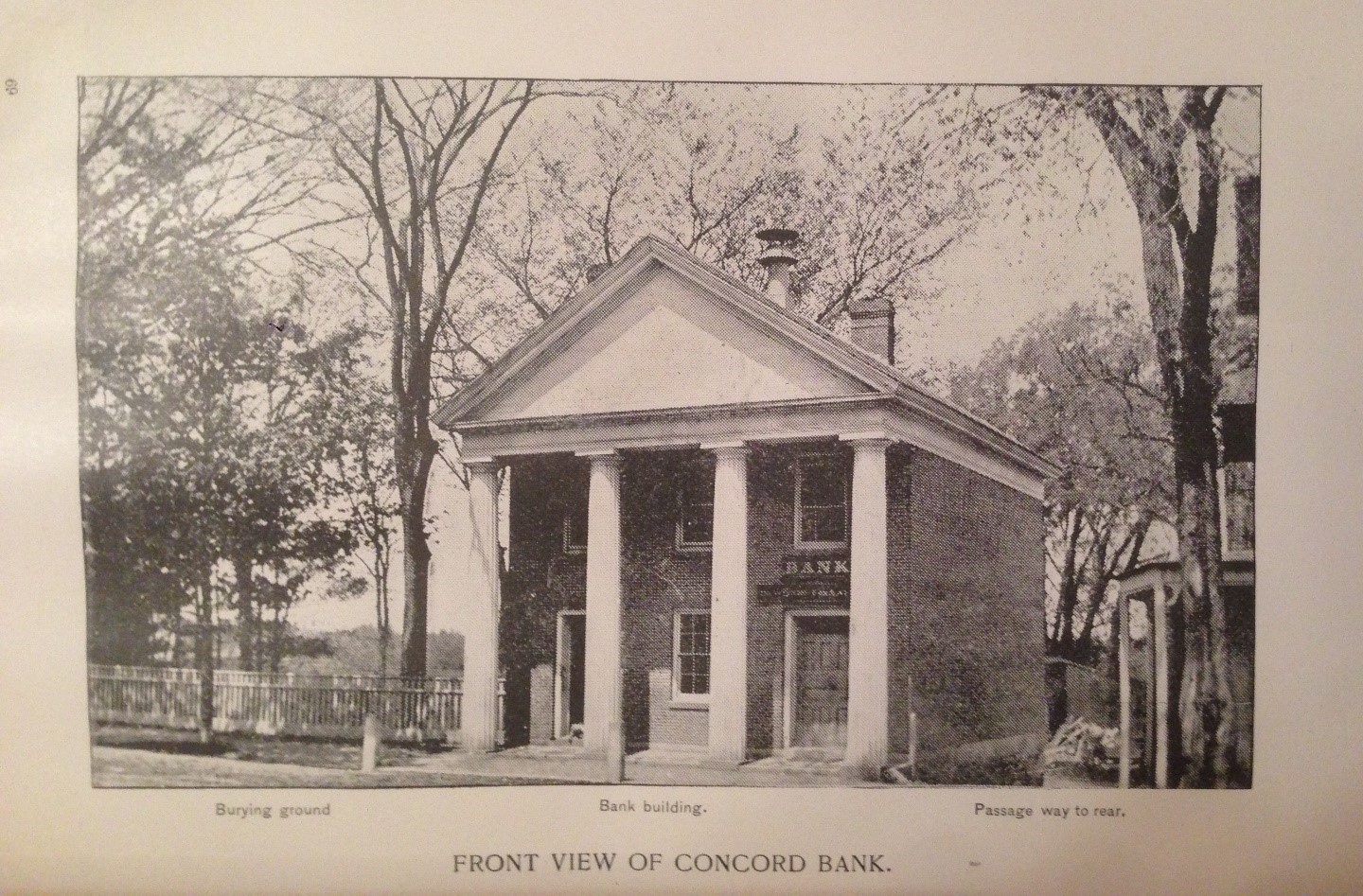
The Concord National Bank building, built in the 1830s and seen here in the 1890s. Illustration from Moore’s book. Langdon W. Moore: His Own Story of His Eventful Life.
Detectives originally thought that the robbery was an inside job because none of the locks on the doors or the safe had been broken, but Heywood insisted that all his employees were loyal and above suspicion. There was only one witness. A 12-year-old girl, the cashier’s niece, visited the bank shortly after noon. She saw a stranger inside who told her the bank directors were in session and could not be disturbed.
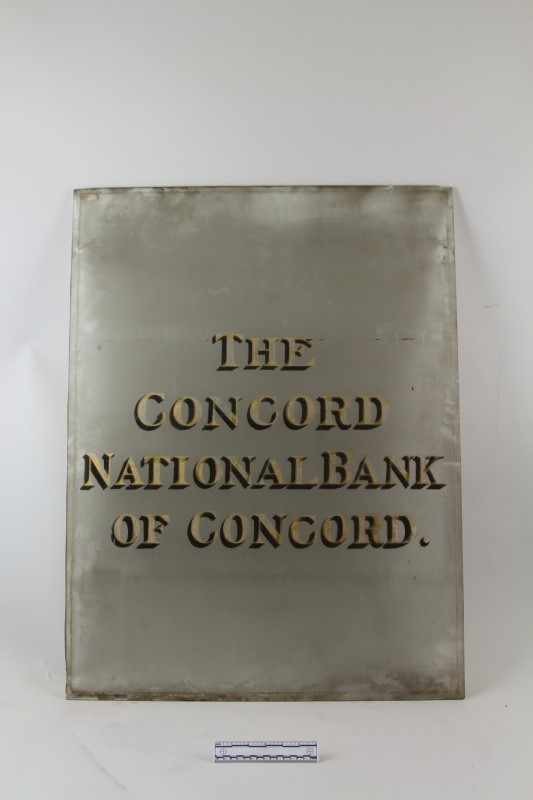
Window from the old Concord National Bank building. Currently in the Concord Museum collection. Photo courtesy of David Wood.
With a $20,000 reward being offered (worth over $300,000 today), every police department in the country was hunting for a lead. After about a month of waiting, the policemen in Fitchburg made a breakthrough for the case. Charles O. Brockway, the boss of a gang of counterfeiters, was serving out his sentence in the Fitchburg Jail when he received news of the robbery. Brockway made a deal with the authorities to reveal the names of the robbers in exchange for his freedom and one thousand dollars cash, provided that the information was accurate.
Brockway told the investigators that Langdon W. Moore and Harry Hunt, currently living in Framingham, had robbed the Concord National Bank. He knew it was them because he had worked with Moore and Hunt in the past, and upon learning their whereabouts, Brockway understood that their visit to the area at the time of the robbery was not a coincidence.
The Thieves:
Langdon W. Moore was tall and well-built. He always wore elegant attire and behaved like a gentleman. When people saw him, they often thought he was a wealthy merchant or retired banker. Indeed Moore was wealthy, but his true occupation was much more exciting. Moore was, at various times in his life, a gambling hall owner, a manager of a counterfeiting ring, and a professional bank robber. Unlike most criminals of his day, Moore never carried a gun, and he never intentionally robbed from the poor. He did, however, always carry at least a thousand dollars of cash on his person.

Portrait of Moore taken in the late 1850s or early 1860s, New York. Illustration from Moore’s book. Langdon W. Moore: His Own Story of His Eventful Life
Moore was born in the town of East Washington, N.H. during 1830. He spent his boyhood in Newburyport, Mass. and worked as a farmer’s assistant. When he was sixteen years old, Moore moved to Boston so he could earn higher wages. He became a cashier for various businesses, including his father’s grocery store in East Boston. After losing all his savings during his first experience gambling, Moore moved to New York City, where he made a living by playing poker in underground gambling halls.
During the 1850s, a private bank could issue their own paper money if they had enough gold on hand to cover any redemptions. These banknotes circulated freely, and often one bank would accept the notes from another at full value. Moore began to meet banknote counterfeiters while gambling in New York City. These counterfeiters would print fakes of a certain bank’s issues and quickly trade them in before the authorities caught on to the fakes. Moore began working as a counterfeiter, and by the late 1850s he ran a large New York counterfeiting operation. Moore was very good at printing fakes, and he hired about a dozen people to redeem them for him.

Ten-dollar Obsolete banknote from the Concord Bank in Massachusetts (would later become the Concord National Bank), 1838; obsolete notes like these were the type that Moore and his partners counterfeited. Several thousand dollars of them were stolen in the robbery. Tom Caldwell’s collection.
Moore made a lot of money from his illegal activities, but one of his closest accomplices was arrested in late 1864, and the police were close on his trail. That was when Moore decided to sell the gambling house he had been operating, abandon his counterfeiting venture, and buy a farm in Natick, Mass. until things cooled down in New York. He brought several of his cronies from New York with him, who, being total strangers to the local police, successfully posed as farmhands.
With nothing to do in Natick during March of 1865, Moore planned to rob a bank. He taught himself how to pick locks and practiced breaking into a safe that he had purchased. Moore originally planned to rob a bank in Francestown, NH, but he decided not to because he knew some people who lived nearby. On the way back home from Francestown, Moore stopped for lunch in Concord and visited Concord National Bank. There, he exchanged a $100 note for twenties, carefully observing the cashier as he unlocked the front and inner doors of the safe to make change. It was an older model from the 1830s that Moore knew how to break into. Moore had found his bank; he partnered with an Englishman named Harry Hunt, an expert safe cracker and lock picker, and they began planning the robbery.

Photographs of Langdon Moore and Harry Hunt around the time of the robbery; illustration from Moore’s book. Langdon W. Moore: His Own Story of His Eventful Life.
The two men visited Concord late the next night, watching the bank and taking note of any movement that occurred in town. This was the first of many times when they returned in the dead of night. They started by creating a mold of the lock on the front door. Next, they made a mold of the lock on the bank’s second door, and then they began with the ten locks on the outer and inner doors of the safe. Night after night, they would secretly visit the bank, enter it, and laboriously mold the locks. The visits got so regular that Moore and Hunt began to store tools behind the very vault they were robbing. They had several close calls, including one time when a chamber pot was emptied on Moore in the alley next to the bank and another when Moore accidently dented the front door. The damaged door would have surely alerted the cashier if Moore had not wedged the pieces of wood back into place. However, despite some close calls, their daring persistence paid off. After five weeks of nightly visits, Moore and Hunt had a complete set of keys for the bank, and the two burglars could steal the contents of the vault whenever they wished.
Moore waited to make his move until the afternoon of September 25th, when he knew the bank would receive a large delivery of bonds worth $75,000. Hunt sat across Main St. in a stagecoach while Moore strolled through the graveyard next to the bank, pretending to read the epitaphs on the headstones. Once the cashier closed the bank for lunch and walked home, Moore used his set of keys to enter the front door. He proceeded to unlock the second door and the vault doors with ease. Aside from the incident with the cashier’s niece, the robbery went smoothly. Nobody noticed the formally dressed man wearing a top hat low over his face as he casually walked away from the bank with an old burlap farm bag over his shoulder. Moore lighted a cigar, strolled down to where Hunt was waiting for him, tossed the bag into the back of the stagecoach, and said, “All right, Henry. I guess we can go home now.” Everything had gone according to plan. Back at the farm, Moore sold the carriage and shot the team of horses that had been used in the escape, thus hiding all evidence of the robbery. He even prepared an alibi in case the police caught on. Right after he returned from the robbery, Moore sent for a doctor. The doctor came, observed Moore (who was genuinely sick at the time), and prescribed him some fever medicine. Moore began to laboriously edit the serial numbers on the bonds so they could be redeemed. He gave Hunt his 1/3rd cut of $103,000, who subsequently departed.
The Chase:
The police were quick to pursue the lead Brockway had given them. They were delayed in obtaining a search warrant for Moore’s farm in Framingham, but investigators surrounded it anyway, discreetly examining Moore’s every movement. After spotting a policeman hiding in the woods, Moore quickly sold the farm to his brother and left for New York to avoid arrest. However, the New York Police Department began spying on his apartment and following him through the streets. Another one of Moore’s accomplices turned on him, and the New York police had enough evidence to bring him in. Moore left New York and purchased a farm in Paulsboro, New Jersey (ten miles south of Philadelphia) to escape arrest once again. There, he hid the stolen bonds under a pile of manure in the barn.
On January 23, 1866, five months after the robbery, Moore was peaceably arrested by the New York Police Department at his farm in New Jersey. The detectives thoroughly searched his property for the stolen money, but in an act of astonishing good fortune for Moore, they failed to locate the hidden sack of bills. A few days later, several bank officials from Concord made the train ride down to New York to negotiate with Moore. With all the money still missing, they were left with no other option but to agree not to press charges if Moore returned the funds. The $203,000 in securities was repaid, and Moore never had to serve a day in prison. The stolen set of silverware was also returned to the Concord minister, and Moore claimed that had he known whom it belonged to, he never would have taken it.
The Conclusion:
Langdon Moore would continue to lead a life of crime for another thirty years, robbing banks and stealing valuables. The Concord robbery cemented his reputation as a highly skilled burglar. He served out two sentences for other crimes, one of which was coincidentally served at the Concord State Prison about three miles from Concord Center. As an elderly gentleman in the 1890s, Moore reformed from any illegal activities, wrote a 650-page autobiography describing his exciting life of crime, and began giving lectures. He dedicated three chapters to the Concord National Bank robbery, the first and largest of the many bank robberies that he committed. These chapters have proven to be an invaluable resource for me in retelling his story. On a side note, Moore was a coin collector. While I was unable to discover any details about the coins he had, Moore says in his book that he owned “$100 face value in rare old coins” at the time of the Concord robbery. Moore lived out his days in New Jersey, where he passed away in 1910 at the age of 80. Although he was quite well known during his lifetime, Moore’s story is all but forgotten today.


Moore’s 650-page autobiography and a portrait of him taken at the time of publishing in 1892. Author’s collection.
As for the English safe-cracker Harry Hunt, we will never know his fate. He split from Moore after the bank robbery. One Boston newspaper hypothesized that Hunt took a steamer to Germany, were he could have sold the bonds without being caught. Alternatively, he might have returned to his native England or perhaps traveled north to Canada. None of his $103,000 share was ever recovered, but neither the Concord National nor the Middlesex Institution for Savings folded from the loss.
The Concord National Bank thrived under the leadership of President George Heywood after the robbery, and his son, Charles Fay Heywood, expanded the bank in 1915 by building a larger and more modern structure next-door at 52 Main St. (today a Bank of America branch). George M. Brooks, the president of the Middlesex Institution for Savings, was elected to the U.S. House of Representatives in 1869. He resigned in 1872 and served as judge of probate in Middlesex County until his death in 1893. Unhindered by the robbery, The Middlesex Institution for Savings would grow out from its single location in Concord to become Middlesex Savings Bank, and it currently operates 22 branches across the county.
As one unnamed journalist noted in the Boston Daily Advertiser after Moore had been arrested, “The same amount of energy, industry, and shrewdness, employed in any reputable way, would have surely brought [the robbers] the wealth they coveted, without the crime or the risk.”

The second Concord National Bank building in the early 1930s, today a Bank of America branch. The old bank building on the right became a barber shop.

Ten-dollar Concord National Bank note, early 1930s; notice the signature of C. Fay Heywood as cashier. Author’s collection.
Additional Illustrations of Concord: Then and Now
While the clothing, cars, and businesses have changed in Concord center over the past 100 years, many of our buildings have remained the same.


Main St., looking East, during the 1890s vs. today.
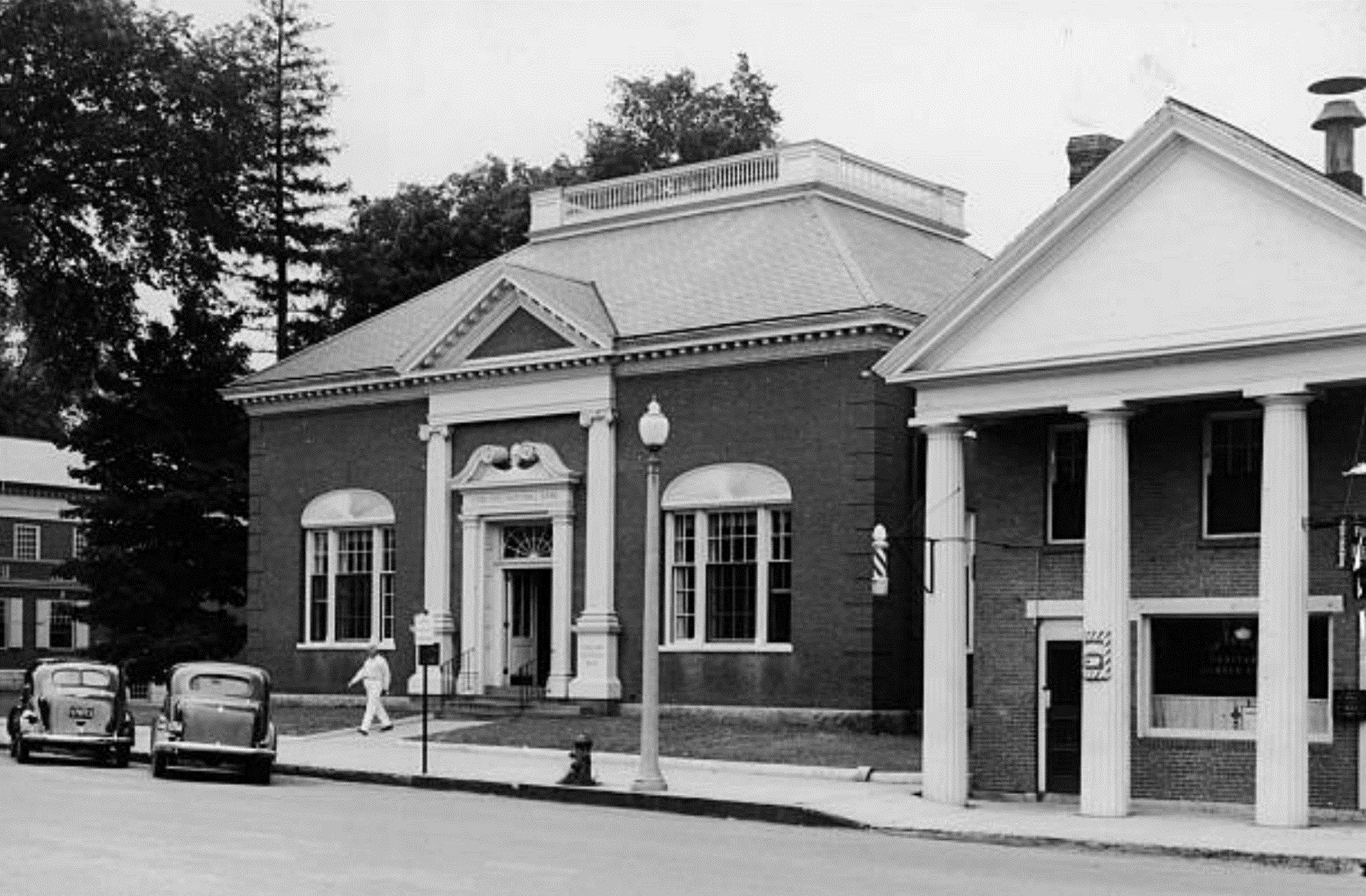

The second Concord National Bank building in the 1930s vs. today.


The second Middlesex Institution for Savings building in Concord, shortly after the Hurricane of 1938 vs. today.


The old Concord National Bank building as a barber shop in the 1930s vs. a shoe store today.
This was a great post and a fine distraction. The primary reason I collect coins is for the history they represent. You've brought an era to life when America was still young and even localized it. Thank you for the post. Looking forward too others!
The following was written by Tom:
We recently purchased not one, not two, but three 1792 Half Dismes! This is one of the most exciting offerings we have had in in very long time. All three came from a collection purchased in southern California on a recent buying trip. We had been aware of these three pieces for over 20 years and our long-time client finally decided to let them go.
Historically, it does not get any better than the origins of these rarities. As George Washington noted, “There has been a small beginning in the coinage of Half Dismes.” This was said in his fourth annual address to Congress on November 6, 1792. Earlier, Thomas Jefferson had recorded the striking on July 13, 1792, mentioning “1,500 Half Dismes have been delivered”. Deeply steeped in coin lore, it has been said that the silver to mint these pieces were from Martha Washington’s silverware. Even though this story has since been discounted, you would be hard pressed to find any coin that is more connected to our nation’s origins.
Most of these Half Dismes have been long lost or destroyed, with fewer than 300 known to exist today. A very small number are known to exist in high grade. Low grade damaged pieces are sometimes encountered. What made our acquisition most delightful is that the coins are nice quality, mid-grade circulated specimens with no problems. Graded decades ago, they are residing in old green PCGS holders. We now just have one of these left, which can you view here.
Oh, from this same collection we also acquired three 1796 Small Eagle Draped Bust Quarters as well as a 1796 Small Eagle Draped Bust Half Dollar.
Such a stunning coin. Wondered if you had your own "wish list" of coins you'd like to list that you haven't handled before?
Tom has always thought the coolest coin to own would be a 1913 Lib Nickel. This interest goes all the way back to 1967 when he recalls the McDermott specimen making headlines in Numismatic News by selling for close to $50,000. (Images from National Numismatic Collection.)

While Chris has handled several proof British Gothic Crowns in his career (one of the most beautiful coins ever created, in his opinion), he has always wanted the opportunity to own the stunning PCGS PR67 specimen that Goldbergs sold back in 2009. (Images from Ira & Larry Goldberg Auctioneers.)

Chris has also never had the opportunith to offer a 1934 $5,000 Federal Reserve Note or a National Gold Bank Note, both of which remain on his "bucket list" of items to hopefully acquire. (Images from Wikipedia.)


The following is a guest post written by Jody from Washington.
I am not a professional numismatist, rather a student of money and part time collector. Growing up I was intrigued by coins as my father would often talk about his assemblage. I never had much of a collection until a couple of years ago when I walked into my local coin shop looking to invest in silver eagles. I asked a lot of questions but to be honest, a lot of it went over my head.
The coin shop owner showed me a raw gold Half Eagle Indian, which he said was cleaned and thus would sell to me for melt value. That day would forever change me as I would become fixated with quarter and half Eagle Indians. The design alone was intriguing as was the idea of something old and then there was the gold.
I dove head first collecting Indian Quarter Eagles since it only consists of 15 coins with one key date. Like many before me, I turned to eBay as a source. I began searching and buying raw specimens that looked good on the screen. I bought from trusted dealers with good feedback and took their word for grade, as I had no idea what to look for.
After a few months of buying on eBay and local shows, I succeeded in completing the set with the exception of the key date, which is the 1911-D. I decided to step up my game and traveled to the Long Beach Expo. As you can imagine, I was instantly overwhelmed with the sheer size of the show, but at the same time I was excited to begin the hunt for my key date.
It was at this show that I would deepen my knowledge from so many folks willing to share their wisdom and years of expertise. It was also the first time I started to question my own purchases. I found many dealers only dealing in graded coins, which made me wonder if my collection was lacking long-term value. In addition, I found very few raw coins, at least of the gold Indian variety.
I was only at the show for one day. With limited time I began to look for an education rather than coins. That is when I met fellow Indian collector and Indian expert Allan Schein who authored the book, “The Gold Indians of Bela Lyon Pratt.” Allan not only educated me, he point blank told me I needed to be buying the highest graded coin I could afford, he also explained the epidemic and ever increasing market of counterfeit coins. In my mind I thought for sure I was sitting pretty safe with my collection as I had bought them from legitimate dealers, albeit via eBay.
I headed to the ANACS booth as they did not require a membership for grading and my main goal was see where I stood with my collection. I submitted twenty gold Indians, which was scary for a first timer. This was my collection and I am handing it over to a complete stranger. Oh well, it must be legit right?
Four pain staking weeks later, the package finally arrived from ANACS, and I could hardly wait to see the results. Upon opening the sealed box, I first read the grading sheet summary. Looking down the list of grades, MS61, AU50, AU58, N9, N9, N9…. Um what is N9? It didn’t explain what N9 was and I noticed several coins in the box were ungraded. I called ANACS and I couldn’t believe my ears. COUNTERFEIT! That’s right, I had 6 counterfeit coins, all of which were common dates and the majority were AU or worse. I was mortified and felt taken advantage of, but at the same time I felt relieved to learn this valuable lesson so early on in my collecting adventures rather than 20 years down the road. A lesson hard learned.
Today, the vast majority of my purchases are graded by NGC or PCGS and I sleep well knowing my coins are legitimate and what they are valued at. I also feel assured in knowing that some day my children will have no question what they are as well.
I learned that utilizing expert graders takes a lot of the long-term risk out of owning and selling coins. I still occasionally buy raw coins, but only in-person and after careful consideration, they will ultimately end up being graded. As for the counterfeit coins, I was able to get my money back on all of them. You can imagine some of the dealers were just as shocked as I was.
My ANACS submission report

A counterfeit $2 1/2 Indian


A CAC approved 1908 from my collection

I enjoyed reading your comments. I too am apprehensive about turning over my Morgan set for 3rd party grading. Not because I don't trust them, but because I don't want to find out some of my collection includes cleaned or counterfeit coins! After many years, I completed my Morgan set, year, mint mark and key varieties and about 1/2 are "raw" having started this collection when I was young and cash was tight. I think you've inspired me to submit the set so there is not confusion. Best of luck and thanks for your post.
The moral of the story: generally stay away from raw coins. And never, absolutely never, buy raw coins on ebay. Why so many do completely baffles me. I honestly just don't get it.
I enjoyed this post, as I enjoy all the posts here. And I greatly sympathize with the author. I knew exactly where they were headed, almost from the very beginning. There's no question they learned a valuable lesson.
Many collectors including myself have found amazing raw coins on eBay! If you know how to grade and can recognize cleaned coins, there are many opportunities to buy coins below market value, then submit for grading to confirm. But of course there is a learning curve.
Tom and Brian from our office will be setting up shop at the 2018 Best Years Expo at Gillette Stadium in Foxboro, Massachusetts. Home to the five time Super Bowl Champion New England Patriots, Gillette will host The Best Years Expo on October 20th.
The Best Years Expo provides attendees with a host of options to help them celebrate, learn, and experience life in their 50s, 60s, 70s, and beyond. Close to 50 vendors will be in attendance. Guests will enjoy a day of celebrity appearances, seminars, vendors, activities, giveaways, and more!
So to our New England customers, come on down to the stadium and see us. We encourage you to bring any coins you might like to sell. Hope to see you there!

The following was posted by Brian:
We have a wonderful customer named Paul from right here in Massachussetts that we have been doing business with for the last couple of years. Paul is 92 and is a spry, fiery sort. We all enjoy his conversation and enthusiasm for life and his coins. Paul has been collecting for just shy of 75 years and has built an impressive collection of Flying Eagle Cents, Lincolns, Mercury Dimes, and Walkers (among other types). In fact, Paul recently completed his Walking Liberty Half Dollar set with us.
A few months ago after purchasing a 1942/41-D Mercury Dime from us, he proudly mentioned that he now needed only one coin to complete the set - the key date 1916-D. We did have one at the time, but unfortunately for Paul it was mint state and a bit outside the range with which he was comfortable paying. He asked if we could try and locate one in Fine condition.
With that, we added Paul's wish to our want list and sure enough, Tom from our office found just such a coin. I called Paul and he said he hadn't been feeling so good lately, although he did seem to perk up when I gave him the news that we had located a 1916-D Mercury Dime NGC F12. Paul said that if he "makes it through the night" then he will call us tomorrow.
Sure enough we got a call the next morning. Paul was feeling much better and was ready to buy the coin and finally complete his set. He sounded like he was beaming at the prospect of finally reaching this life-long numismatic goal. Congratulations to Paul!
We all like happy ending stories like this one, but remember - you don't have to be 92 and on your last coin in order to give us your want list. Perhaps we can make it happen for you whether you're just starting out or just finishing up your collection. Email us at info@northeastcoin.com or give us a call at 800.449.2646 and let us know how we can help you.
The following was written by Tom:
Early last year we acquired a certified 1943 Copper Lincoln Cent in XF condition. This was the first 1943 Copper that I have had the privilege to own and offer in my entire 54-year career. This rarity is among the most desirable and rarest United States coins and it is known among veteran coin collectors and non-collectors alike, as it frequently makes the news.
All coin dealers, ourselves included, receive phone calls and emails on a regular basis from the public with claims that they have a genuine piece. In most cases, simply taking a magnet to the coin will prove that the coin in question is just a copper coated specimen of virtually no value, thereby immediately dashing dreams of riches. Occasionally more sophisticated counterfeits surface that demand more attention to disprove authenticity. With only about 20 known pieces, the chances of finding a genuine piece are, needless to say, astronomically slim.
We enjoyed the pride of ownership of our piece while displaying it at regional and national coin shows, where it garnered a lot of attention and comments from collectors (and dealers!) who had never seen such a piece in person. Some folks even asked to take photos and/or hold the coin, figuring another such opportunity would never arise. We were very happy to oblige.
After offering the 1943 Copper for sale on our site (www.northeastcoin.com) for much of 2017 without a sale, we decided to take it off the market and perhaps bring it out for display again at some later date. While packing for the recent ANA Money Show that was held in Philadelphia, we decided this might be a good opportunity for the collectors in the City of Brotherly Love to view the coin, so we brought it along.
One of the collectors attending the show, Willie (a client of ours whom we see at every ANA), came by the table and expressed interest in the coin, saying he had always dreamed of owning one. We then recalled last year that Willie had mentioned he was anticipating the sale of his restaurant and if it happened to go through he would consider the purchase of our piece.
Well, the timing was right for Willie this year!
As we are always willing to work with clients on a layaway basis for big and small purchases alike, we were able to come to an agreement with him on the 1943 Copper. We are thrilled that our rarity has found a new happy home. Congratulations Willie - sometimes dreams do come true. Enjoy!
Is this the same one in the news this past week with an estimated auction price greater than 1,000,000?
Hi. No, this is not the same piece.
Our in-house variety specialist and intern, Benjamin Simpson, recently discovered an interesting item. He wrote the following post:
Benjamin found a perpetual calendar ferrotype located at the bottom of a grimy old box in Tom’s office. While it may not look very attractive or special, the medallion is a rare relic of Civil War era America, and highly collectible.
The silver plated brass medallion was manufactured by Ellis and Read of Springfield, Mass during the Civil War. It features an inlaid ferrotype of Major Gen. Benjamin Butler on the obverse, and a perpetual calendar on the reverse. The calendar can be used to determine what days of the week correspond to any date, past, present, or future.
Benjamin Butler, whose photograph is encased in this brass medallion, was a famous general, politician, and businessman of the 19th century. Born in 1818, Butler was a native of Lowell, Massachusetts. He studied to be a lawyer at Colby College and began a career in politics as a democrat after graduating. He entered the Lowell militia in 1840 and rose to the rank of colonel by the beginning of the Civil War. Butler was promoted to major general in 1861. He oversaw the 1862 Union occupation of New Orleans while simultaneously making himself a fortune by manufacturing war supplies in Lowell (Butler used his position in New Orleans to ensure that his textile factories got a steady supply of cotton). After the war, Butler was elected Governor of Massachusetts, and he unsuccessfully ran for president in 1884. Butler died in 1893.
Little is known about Ellis and Read of Springfield, who manufactured these political medallions during the civil war.
Several varieties of the Ellis and Read perpetual calendars are known to exist, including variants that feature ferrotypes of Abraham Lincoln, Ulysses S. Grant, George McClellan, and other prominent political figures of the time. They are all highly sought after by collectors and can sell for thousands at auction. There are no Benjamin Butler medallions known to exist, nor have they been listed in any catalog of American political exonumia. Therefore, we believe we have a unique discovery piece for the series of perpetual calendars. You never know what you will find by doing a little digging through Tom’s cluttered office!

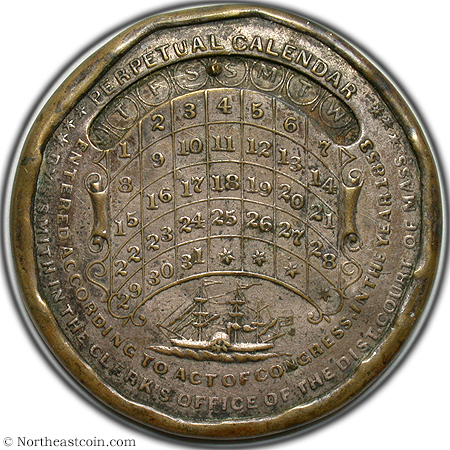
Tom - was reading your blog , and my wife Jackie is now retired from the Butler middle school in Lowell Ma, and we found this very interesting . Benjamin Butler 's portrait hangs in the the school library .
Glad you enjoyed it!
This is from a 2004 E-Sylum article. What a neat story!
The E-Sylum: Volume 7, Number 44, October 31, 2004, Article 24 FIRST AND ONLY NUMISMATIC BOOK IN BRAILLE? Rich Mantia writes: "I just read an issue of The E-Sylum while jumping around on the internet and one of the articles caught my attention. The question was posed as to the thickest numismatic book and I'm reasonably sure that I own it. I realize that pages and paper thickness matter, but for shear thickness it would have to be my copy of the "Redbook". Yes, The Guide Book of United States Coins by R. S. Yeoman. I own the 1969 edition which was typed in braille and is to the best of my knowledge unique. The book is slightly thicker than 12 inches. It was so thick when typed that it couldn't be bound in one volume. It takes nine volumes to create the single book. Page counts vary from volume to volume while the cover size remains at 11 1/2 by 12. It is considered to be one book because it is fully transcripted from the regular 1969 edition. This was done in 1969, not recently. I also believe that it is the only numismatic book that was ever written in braille. On the lighter side, it is not this thick from ever having been water logged." [If the date were April first I'd be certain this was a joke. Blind numismatists? This sounded to me like something cooked up after drinking one too many steins of German beer after a Milwaukee Central States coin convention. Of course, one needn't collect or even see coins to appreciate their history. When I asked for more information about the edition, Rich sent pictures along with the following note. -Editor] Rich Mantia writes: "I don't mind giving more information about my "Redbook". I first became interested in "Redbooks" when I read an article by Ginger Rapsus in the September 1988 issue of "The Numismatist". I didn't start to collect "Redbooks" actively until several years later, but I'm blessed with a good memory and I referred back to the issue when I wanted to collect on a serious level. I'm aware that the value in any collection is in its completeness as well as condition and I decided to start with the rare copies first. I used the article as the basis for my collection and I've collected every item listed in it as well as some items that aren't listed. I purchased the braille "Redbook" some years back in a private transaction for a substantial price that I shall keep to myself. I have sent along some photos of it which help verify its existence. In the photos one can see that the book was transcribed for Davyd Pepito who was a member of the Covina Coin Club. It was done by Ms. Lois Kelly of the San Gabriel Valley Transcibers in Covina, California over a period of 3 months in 1969. The page counts vary from volume to volume, but on average it took 4 braille pages to equal 1 printed page. My guess is that there are about 1000 pages in the 9 volumes total. The 9 volumes combined weigh more than 26 pounds. The book has only been displayed a few times at some regional shows over the years and I have no desire to bring it out for more displays because it doesn't look as impressive as a showcase full of rare coins. It is rather bland in its appearance, because after all it is page after page of impressed bumps with no inked words to accompany. To my knowledge it is unique in that it is the only "Redbook" to be in braille and also the only numismatic book ever written in braille. More than anything else the greatness of Mr. Richard Yeo stands out because it is his book that stands out as being the one that reached into the darkness of a blind childs' life and helped him enjoy a hobby that we take for granted. Perhaps Davyd Pepito can be known as a pioneer coin collector who loved coins without ever seeing them and his name should be chiseled in stone on the new A.N. S. building as prominently as the scholars of the past. I hope this helps answer your questions."
“I am in no rush to sell, but I am 102.”
So began our discussion several months ago with a New York City gentleman named Charles, who wanted to sell his lifetime collection of coins and currency. As we got to know Charlie, we learned about how he had considered selling his collection to other dealers or liquidating it in an auction. He ultimately chose Northeast. Although our company may have seemed young to Charlie— Northeast has only been around for a little over 50 years when compared to his 102— he understood that it would be important to work with the most reputable and time-tested company he could find.
After many emails, visits and phone calls, our combined efforts for a deal came to fruition yesterday. I woke up with Russell early to catch a 4:00 AM flight for LaGuardia. The trip was not pleasant. With no window and a location in the last row next to the bathroom, we had been assigned the worst seats on the airplane. They could not recline, so we were unable to catch any rest before the long day ahead. After landing, we navigated through the construction at LaGuardia and took a chain of shuttle busses before we reached our rental car-- a Chevy Suburban SUV. Russel and I arrived at our client’s apartment in the city to make our 10:00 a.m. appointment without issue, and we were very thankful to have beaten the infamous New York City traffic. We were astonished to find that the twenty-two-story apartment building had only ten parking spots, but mercifully there was one open for us.
For several hours, Russell and I confirmed the collection was as expected from the inventory list sent to us by Charlie. The collection included 19th century type coins, dollars, proof and mint sets, gold and silver eagles as well as other bullion, paper money, and much, much more. After doing quite a bit of addition, we valued the collection in the high six figures. Not surprising considering that it was the summation of a century of coin collecting. Next, we did some paperwork and loaded up our SUV for the trip home. Our vehicle turned out to be just what we needed, as a smaller car would have required us to make two trips!
The traffic made the drive slow through much of New York and Connecticut, but eventually Russell and I made it back to our office to unload our “newps” in the early evening. After a well-deserved Mai Tai and dinner at Chang An, we were home by 9:00 p.m. Just a typical 17-hour day in the life of a coin dealer!
Next comes the inventorying, cataloging, imaging, sending in for grading and listing on our site. Stay tuned!
Oh, and it goes without saying, but Northeast is always in the market to buy. We are interested in singles, rolls, partial or complete sets, raw or certified or anything else numismatic, and would love to hear from you. Our needs are great and constant. Let us know when the time comes to consider cashing in.
-Tom
Great story. Wonder if any single coin was the collector's favorite.
Good question. Surprisingly, the only piece we recall him mentioning more than once was a pattern dollar.
Fascinating story, and engagingly written. Well done, Tom--and good luck Northeast!
Thank you, Dave!
It's why I give you my business whenever possible. Great story and keep up the great work.
Thank you, Jody!
Ah, the New York traffic -- remember it well from my days driving a cab in the Big Apple a quarter-century ago (Hey, I only got held up twice -- I consider myself lucky!) What a terrific story. Imagine starting a collection -- if he started at, say, age 10 -- in 1927. The coins he must have spent as pocket change that today would be worth thousands of dollars. And the coins he must have come across as a collector back in the day (and the low prices -- compared to today at least -- he must have paid for so many of them!) Thank you for sharing. - Rob
Thanks for reading, Rob!
Tom, just reading this..... excellent writing, a great story and I strongly concur, a Chang An Mai Tai sets a rough day straight!
The following was posted by Tom.
Normally with a heading like this, you would expect us to be discussing or offering new material: Perhaps recent purchases from a show, coins returning from the grading services, or purchased collections. This is a different story.
Last fall we got a call from the Concord Museum’s curator, David Wood. The Concord Museum www.concordmuseum.org has an impressive collection of historical, literary, and decorate art treasures. One area that was missing from the museums holdings was numismatic items. David discussed the desire to add numismatics to its collection and how Northeast could help with that. We happily agreed to make a donation to the museum.
We came up with a group of gold, silver, and copper coinage, as well as tokens, Colonials, and paper money from late 18th to early 19th century. These are currently a small part of a much larger current exhibit called “Fresh Goods: Shopping for Clothing in a New England Town.” This current exhibit runs thru July.
Our home town museum reflects our rich history, from the beginnings of the American Revolution with the “Shot Heard Round the World” at The Old North Bridge (not far from our office) thru the literary era of Thoreau, Emerson, Hawthorne, Alcott and others. Northeast is proud to be a part of this history.
If you are ever in our home town, we hope you will plan a visit to the museum. And be sure to let us know when you’re in town, as a visit to Concord would not be compete without a visit to Northeast Numismatics!





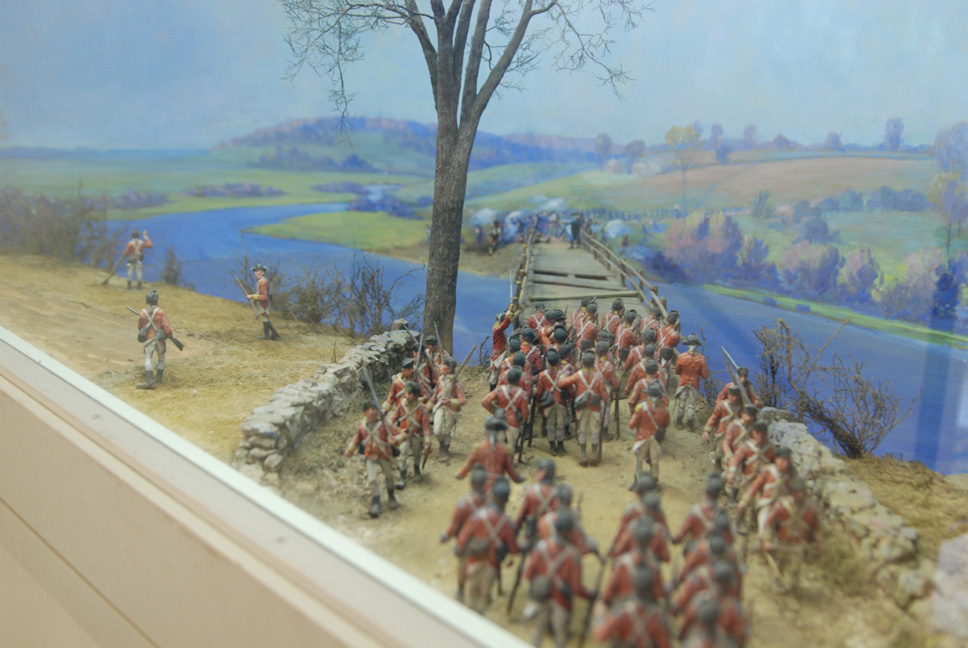
A magnificent artifact of wartime cent production, this unique, eight-foot strip of webbing has a most unusual story.
A building contractor from the Denver area gained possession of the punched strip more than thirty years ago. Someone delivered a large quantity of the webbing to his work yard, thinking that he could find a use for the ‘scrap metal.’ The contractor decided to reinforce the walls of a house he was building with the strips, forever sealing them in plaster.
The contractor only had two strips left when he learned about their numismatic importance. He cut the shorter strip in two, mailing half to the Smithsonian and half to the ANA Museum, and kept the longer, eight-foot strip for himself. Once word spread about the contractor’s discovery, he was visited by two agents from the Denver Mint Police, looking to reclaim what may have been stolen property (any strips of webbing are technically property of the U.S. Mint). They dropped the case after concluding that it was impractical to dismantle the house or recycle his strip for steel.
This strip of webbing has been preserved nicely, and exhibits no rust or tarnishing of any sort. With only one rung broken in the nearly 1200 that make up the strip, it is remarkably well intact. There are a few minor bends, which do little to distract from the wow-factor of the piece. It is fully original and unrestored.
It is impossible to discern the date and mintmark on the coins minted from most other strips, yet due to the steel composition and discovery in the Denver area, we are very confident that this strip was used in the production of 1943-D cents.
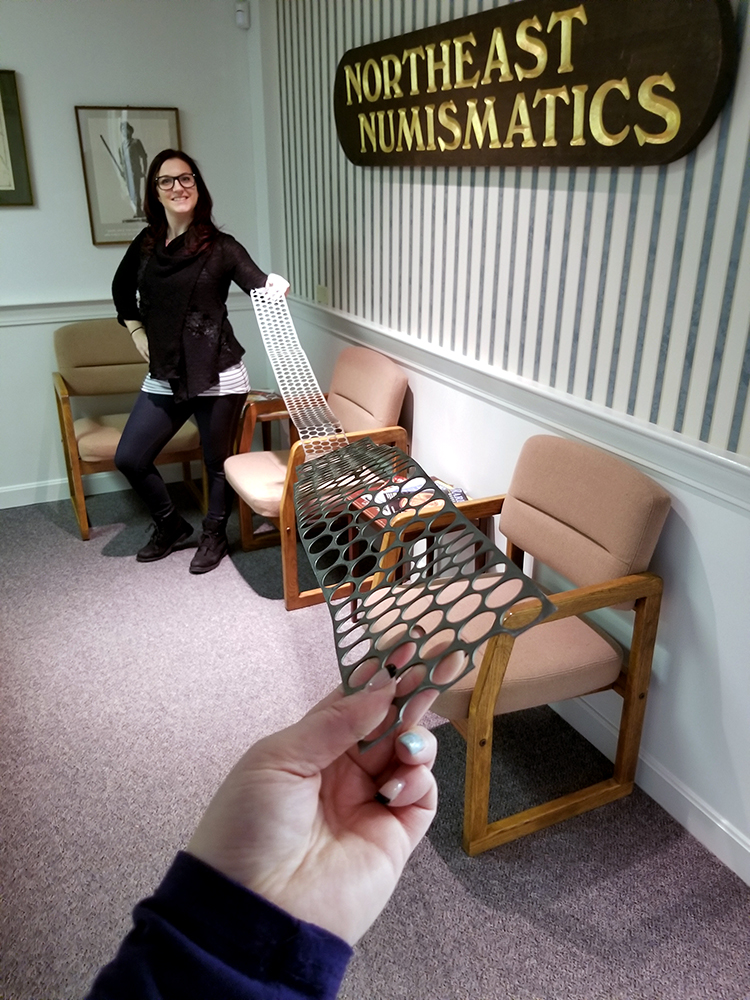

Tom wrote a guest article for the E-Sylum. Here's something you can consider regarding your already-read coin publications that you receive in the mail:
As we age we inevitably end up going the doctor’s office more often, at least I do. When I remember I have been bringing a recent copy of The Numismatist with me, not to read while I wait for my appointment but to leave in the waiting room. The hope is that someone will view and possibly take up our fine hobby. It may never happen but it is a small effort to encourage a future numismatist.
We all lament at the fact that our collector base is aging and I suspect that the majority of ANA members are just tossing their month-old copy and not building a library so why not do so? If everyone made this small effort there would no doubt that it would have the desired result with some. It is certainly better than having your copy sit on your shelf never to be viewed again or automatically going to the recycling bin.
Sounds like a great idea!
My wife and I regularly drop off recent copies of Coin World during doctor visits. On several occasions I've observed they are quickly picked to read and provide a welcome change from the usual medical stuff. The monthly issues go to the local library
Our annual tradition - a Paul's Pastry king cake!

Brian hard at work describing a coin for a customer.

A little touch of NOLA in Chris' office.

Very nice office space!
Thank you, Panda!
...which we are very disappointed about. Unfortunately no one guessed the exact final score of the game in our contest. Not too surprising, however, considering what the score was (41-33).
We have already contacted the ten contestants in our contest whose guesses were closest to the final score. The closes was by R.C. of Maryland who guessed Eagles 42, Patriots 35.
Thank you to all who participated. We have confidence in Bill and Tom getting us to another Super Bowl, so hopefully this won't be our last such contest!
Super Bowl LII features the New England Patriots, who are going for their sixth Super Bowl title, against the Philadelphia Eagles on February 4th. To celebrate one of the greatest spectacles in sports, we at Northeast Numismatics are hosting another Super Bowl contest on our website.
If anyone guesses the exact final score of the game, they have a chance to win a $500 gift certificate to Northeastcoin.com. We are also awarding ten $50 gift certificates.
For further details and to participate, just click the link below.
Good luck!


Still waiting for Black Friday deals
Stay tuned...
happy thanksgiving from a Western Mass Easthampton and Hatfield Native. Now living in Virginia Beach.
A 1918-S Standing Liberty Quarter PCGS MS65 FH just sold for $72,000 in a Heritage auction. Can anyone explain why?
Doesn't make any sense, that coin is probably at retail $10K. Only guess is someone is completing a high grade set and would do anything to claim best collection?
We agree, Rick. Very head-scratching for sure. If we learn any new information on this particular sale, we'll be sure to post it here.
The buyer think it's a 1918/7-S
We did hear from another dealer that perhaps at least two of the bidders thought it was a late die-state 1918/7-S. We are doubtful of that scenario.
The image below was taken from a particular numismatic item. The first person to guess what item this image was taken from and the date on the item wins it! Be specific. To take a guess, click the COMMENT ON THIS POST link in the lower right corner. Only guesses received via comments to this blog post will count. Good luck!

Hi. Great contest! I believe the image is of Queen Adelaide, the wife of Britain's King William IV, and is from the reverse of an 1831 medal commemorating his coronation. The Royal Mint issued three versions of the medal designed by Chief Engraver William Wyon -- one in bronze, one in silver, and one in gold. From the appearance of the photo in the blog, I'm guessing that it's from the bronze issue.
CORRECT! Nice job, edavies. We will be in touch to discuss sending your medal to you.
Some of you may be familiar with the story of the RMS Republic which sank off the coast of Nantucket, Massachusetts in 1909. It is reputed to have 150,000 U.S. gold coins buried with it. The History Channel did a special on the shipwreck called Billion Dollar Wreck about the ongoing attempt to locate and salvage the gold.
Tom was featured in the special as their numismatic expert. Enjoy!
We have clearly fallen asleep at the wheel in regards to keeping our blog up-to-date. Well, alseep is not really the correct word. We've found ourselves so busy as of late attending coin shows and processing our new purchases and the blog has suffered because of this.
For those that followed our blog, we truly apologize for this. We will have a worthwhile post tomorrow (including video!), so stay tuned. And thank you for your patience!

You have probably noticed an On Hold indicator next to some of the coins in our inventory. We are sometimes asked by our customers what that means, so we figured it'd be worthwhile to post an explanation.
There are a few reasons why a coin might be marked On Hold. If someone has recently placed an order for the coin through our website and we have not yet had a chance to change the indicator to sold, then the coin status will show as On Hold. Another possible reason would be that a customer has specifically asked us to put a coin on hold for a short time while they make a decision about the piece. And lastly, we sometimes send coins out to other dealers on memo (consignment). When that happens, the coin will show On Hold.
It's important to note that just because a coin is on hold for someone, it does not necessarily mean that you don't have a chance to acquire it. If you see a coin on hold that you would like to consider purchasing, simply click the On Hold link. You will be prompted to enter your email address and any comments you might have. We will receive the notification that you are interested and will see if there's a way to make that coin available to you. Even if it ends up selling to another customer, we can make a note in our system that you are interested in the piece in case it is returned.
If you have any additional questions about this, or anything else at all pertaining to our website, please don't hesitate to ask. Email us at info@northeastcoin.com or call us at 800.449.2646.
The following was written by Chris.
To be blunt, the Central States show is probably my least favorite show of the year. I find it overly long for the amount of business that is usually done there. It’s typically one of the weaker shows of the year, and the location is far from ideal. While it’s convenient and very secure to have the hotel attached to the convention center, there is literally nothing else in the area within walking distance. If you want to eat anywhere other than the hotel restaurant, you have to Uber there. Schaumburg is inconveniently far away from Chicago, so trips into the city during this show rarely happen. (If there is a positive to the location, because there’s nowhere to go, more dealers than usual congregate in the hotel bar in the evenings. You can find yourself having conversations with dealers that otherwise you may normally not have the opportunity to socialize with.)
Having just complained for a paragraph about the show, I am happy to report that this particular Central States was great for us! I checked our Central States show sales going back to 2012, and this show actually doubled each one of them! I’m sure if I continued going back through the years, I’d find the same results. We sold multiple big-ticket items ($20k+ coins), which was great and also encouraging. It was still the usual struggle for Margie to get some of the dealers to look at our inventory, but most eventually relented and then proceeded to buy several coins from us. And just as importantly, buying was good. We came home with at least four double row boxes of new coins.
While I would grade the 2017 Central States show an A-, I heard mixed reviews from other dealers about the show. A few well known national dealers who used to take tables stopped doing so and just walked the floor, or just didn’t show up at all. Maybe it’s my imagination, but the width of the aisles on the bourse floor seem to be increasing. One might speculate that this is because fewer and fewer people are taking tables. I dunno.
As for the coin market, my personal experience with buying didn’t really indicate any changes occurring. Prices remain unchanged for the typical material I come home with. However, there are two positive things worth mentioning. First, we did find the big-ticket sales encouraging. Second, I spoke to a dealer friend of mine who had spoken to one of the bigger dealers in the industry and that particular dealer was very optimistic about the market. Yeah, I realize this pretty much qualifies as hearsay. But considering the source, I know the information was sound. Granted, I don’t know the details, like the “why” part of the optimism. I will be interested to see if their optimism holds at the next show and hopefully spreads!
Here's a neat letter and item we came across that was buried in our office.


Many of you are probably already familiar with the famous Sacagawea Cheerios Dollar. For those who are not, definitely read on!
5,500 Sac Dollars were struck in 1999 and delivered to General Mills to distribute in cereal boxes in an effort to generate interest in the new dollar coin. It turned out that the Sac Dollars later struck for circulation exhibited a slightly different design, namely in the eagle's tailfeathers. The tailfeathers on the Cheerios Dollars have intricate detail, whereas the regular issue pieces have tailfeathers with no detail.
We found an article from 2007 which mentioned an actual sealed box of Cheerios that had the Sac Dollar promotion logo on it sold on eBay for a little over $200! What would YOU do if you had a sealed box from back then? Open it or sell it?


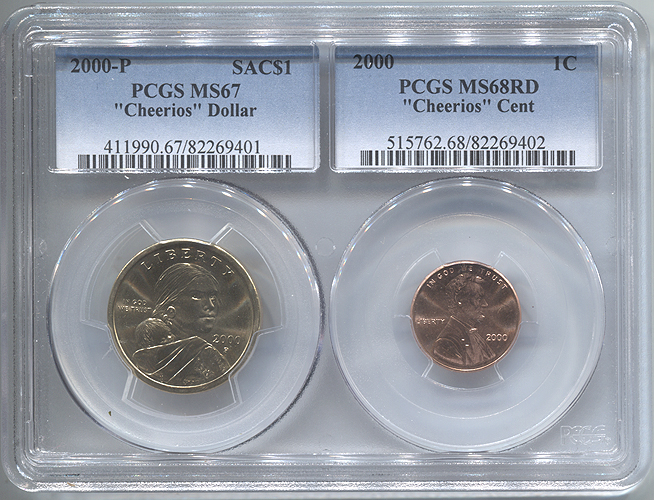
Open It.
The image below is a close-up of a small area of an ecapsulated numismatic item. The first person to guess what item this image was taken from wins it! To take a guess, click the COMMENT ON THIS POST link in the lower right corner. Only guesses received via comments to this blog post will count. Good luck!

Liberty silver dollar
From Northeast: Sorry, no. Please be more specific with your guesses.
The 30th Anniversary PCGS Medal
From Northeast: Correct! That sure didn't take long. Congratulations! Please email your contact information to info@northeastcoin.com and we'll ship it out to you.
For those interested, here is what the entire medal looks like.

The following was posted by Chris.
I often get asked by customers if I have a personal coin collection and if so, what's in it. I thought I'd take advantage of our blog to post some selections. The majority of my collection is comprised of medals, mostly 19th and early 20th century European medals. While my expertise is primarily U.S. coins, I have always appreciated the intricate designs of medals.I also have several world coins and some U.S. coins in my collection. Here are some highlights you might enjoy seeing.
1861 Great Britain Halfpenny NGC PF66 RB (Definitely one of my favorites. Finest RB of the date.)
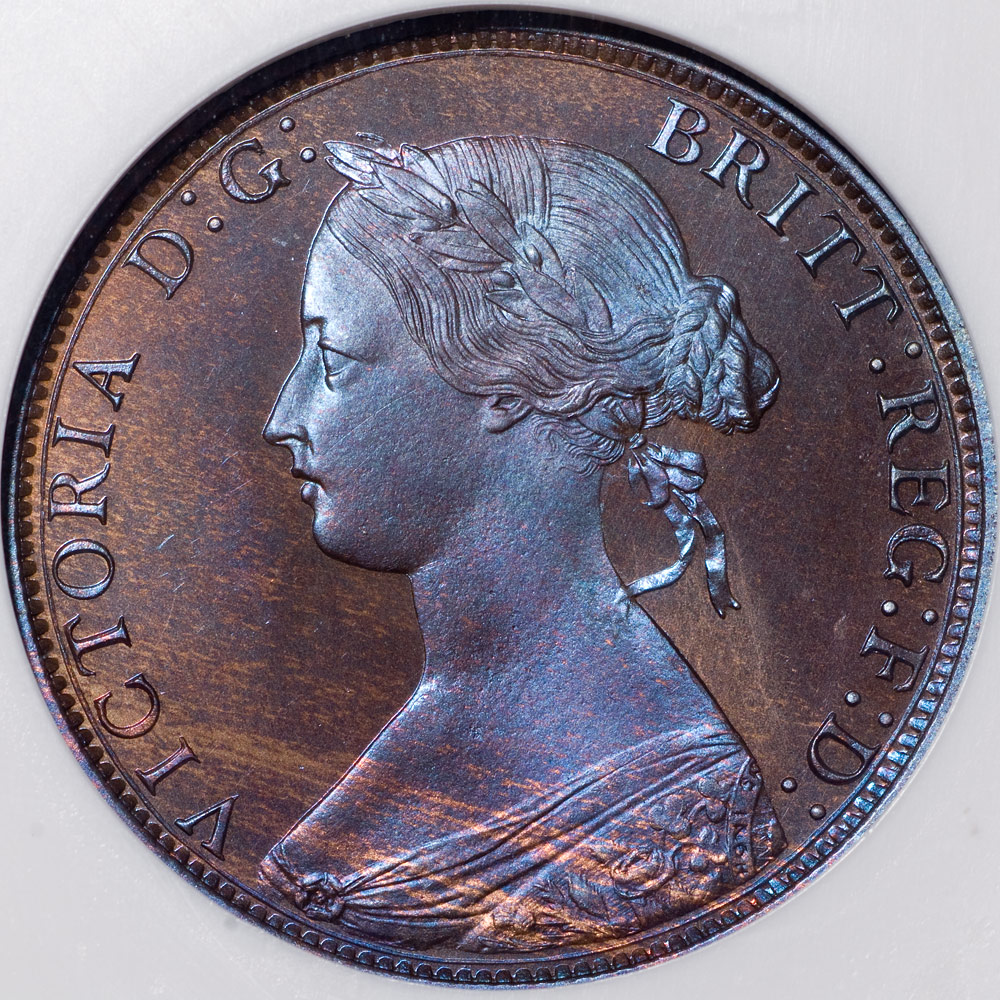

1877-A France 5 Francs NGC MS66 (Semi-PL, tied for finest graded.)

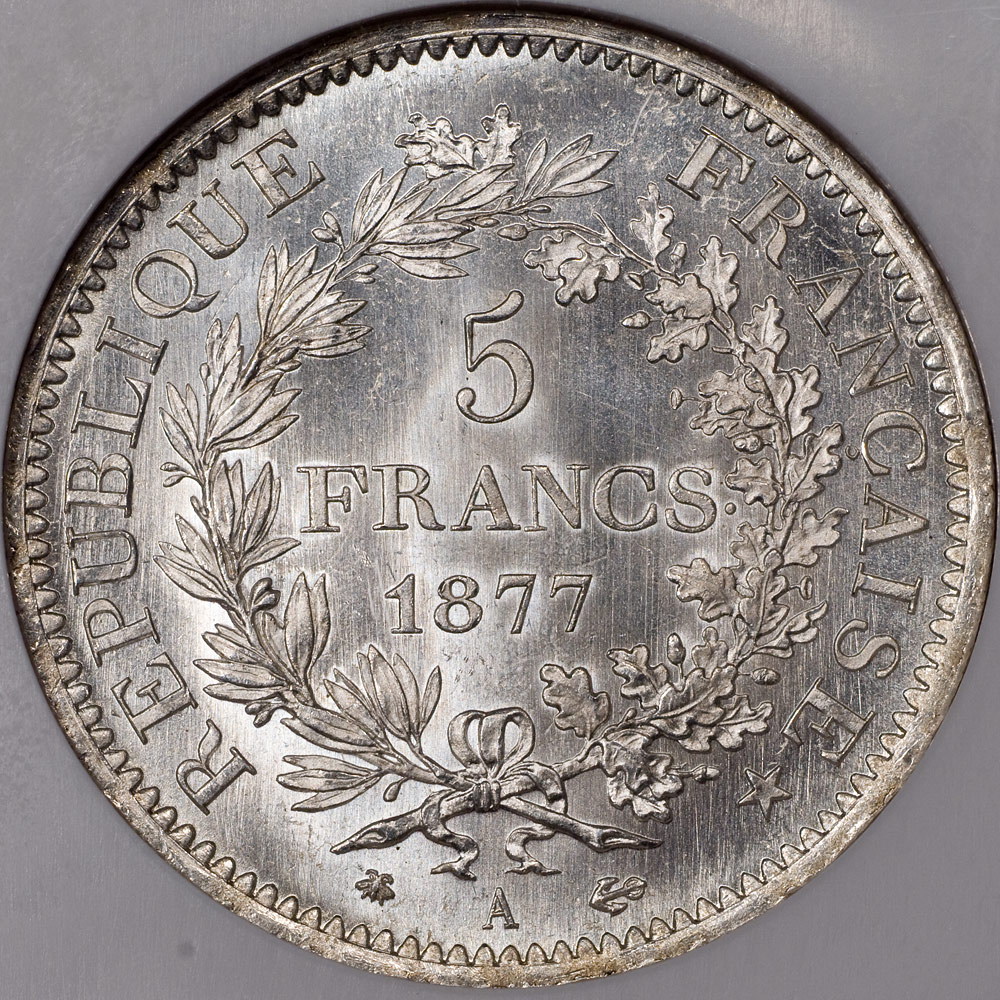
1904-A Germany Mark NGC MS67 (I'm always a fan of attractive toning.)


1909 Germany Saxony-Leipzig University NGC MS67 (Amazingly, there is one finer, which I'd love to see.)


1902 Great Britain Halfpenny High Sea Level NGC MS66 BN (Not an exciting coin, but I like high-end/finest graded material.)
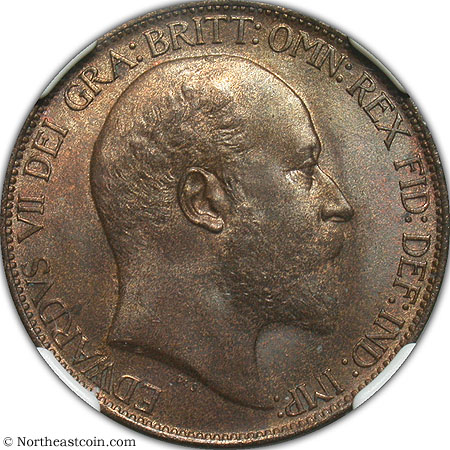
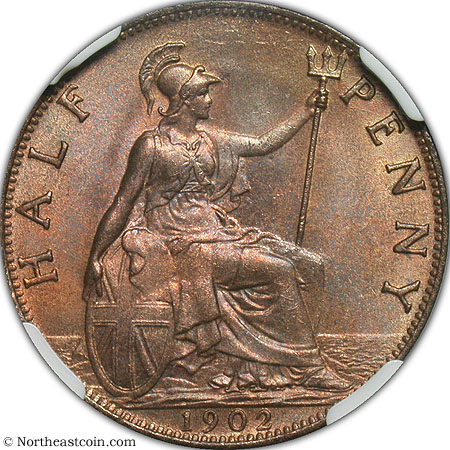
1894-A German New Guinea Mark NGC MS65 (Semi-prooflike. One of my favorite designs of any coin.)

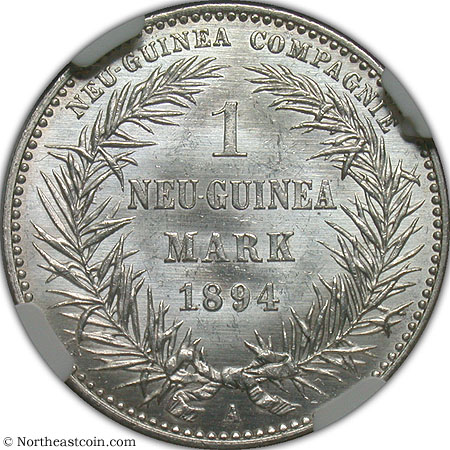
1913 France 2 Centimes NGC MS63 RB (Nothing special. Just cool color.)


1842-Ng MA C.A.R. 8 Reales 42/37 PCGS AU50 (Many collectors love the sun design and I am no exception.)
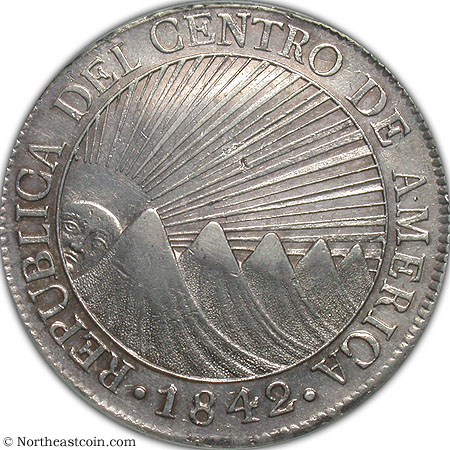

1797 Great Britain SOHO "Cartwheel" Twopence NGC PF63 BN
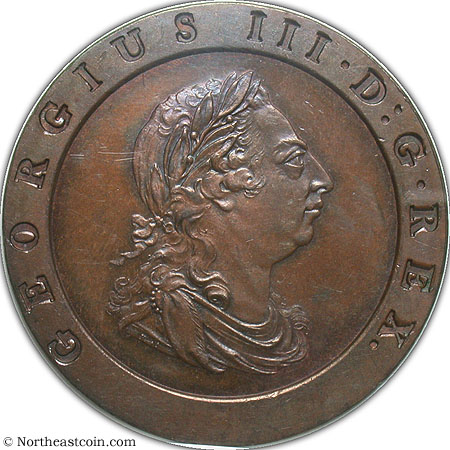

1883 Hawaii Quarter PCGS MS64 CAC (The most prooflike example I've seen!)

France World War I Medal (Somewhat eerie but impressive design. Uninscribed reverse.)
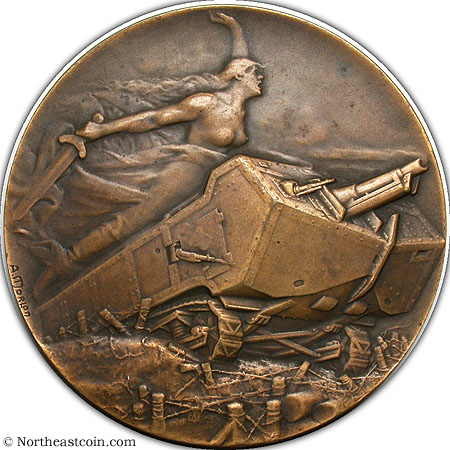
1828 Germany Alexander Humbolt Geographer (Exquisite high relief design.)


1825 Germany Fredrich Blumenbach Anthropologist (I like the reverse design. Knocked it out of an NGC MS65 holder.)


1881 Austria Marriage of Prince Rudolph and Princess Stefanie of Belgium (Amazingly intricate design. Big fan of original cases.)


1837 Great Britain Royal Academy of Arts Award Medal (Awarded in 1874. Features the Belvedere Torso. It took me a few years to pry this out of the hands of a former colleague.)


1893 Columbian Exposition Medal (Struck/pressed in wood!)


New Orleans obsolete and national bank notes (I was born in Louisiana and moved up to MA from the NOLA area, so I have several of these in my collection.)


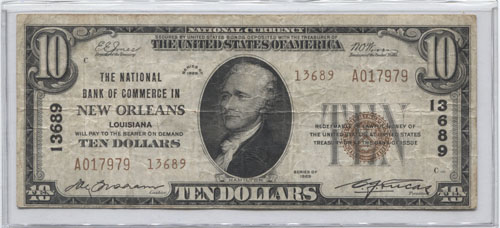
I agree - some of the designs on the medals are stunning. Thanks for sharing.
Beautiful medals. Also outstanding examples of them. Stunning was the right descriptor. There is so much discusssion about the lack of art in today's really clip-art style or disproportionate art for the planchette and the return to the"Renaissance Era" of US coinage. We don't need to go back, as technically incredible and artistic these older medals and our older coinage were, but go forward to our current medallic artists and sculptors and let them create. You can see the evidence in modern International coinage and medals that range from classic to very modern, but are still stand- alone works of art. We have plenty of great artists in the US and should tap into that pool of talent. Thanks for sharing these rareties and beauties with us.
An interesting coin we just sold is the 1945 No "AW" Walking Liberty Half. As far as diagnostics are concerned, this is more correctly known as a die state, rather than a true variety, as polishing of the die to remove clash marks or erosion lines obliterated the designer's monogram.


The one we just sold is the first non-proof No AW Walker we've offered and the only 1945 issue we've even heard of.
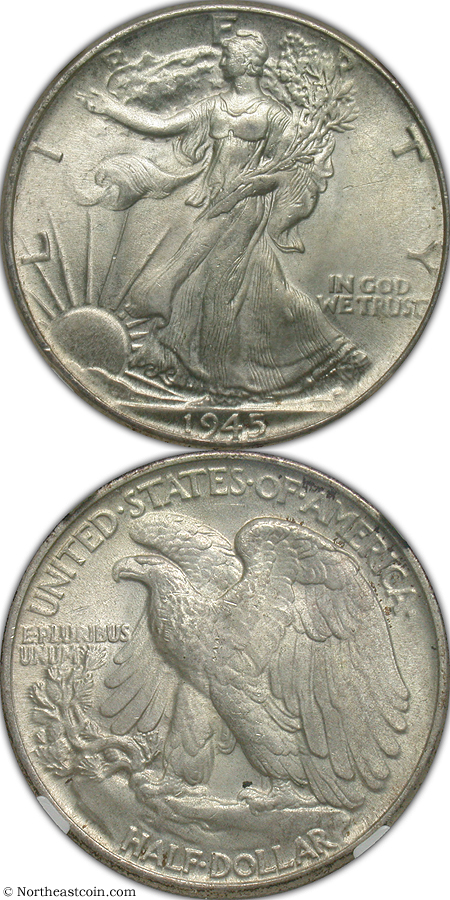
We celebrated Mardi Gras today at the office, complete with King Cake (from Paul's Pastry, of course!), beads, masks, and doubloons.
Here's our King Cake (decorating by Helen).
Chris and Marne getting into the spirit.

Thanks for the masks and King Cake, Marne! Hopefully someone else will get the baby this year so you don't have to buy again!
Brian grading some Mardi Gras Doubloons before deciding which ones to submit.
Christy in "costume" also.

Mardi Gras update. Marne got the baby...AGAIN. Three years in a row!
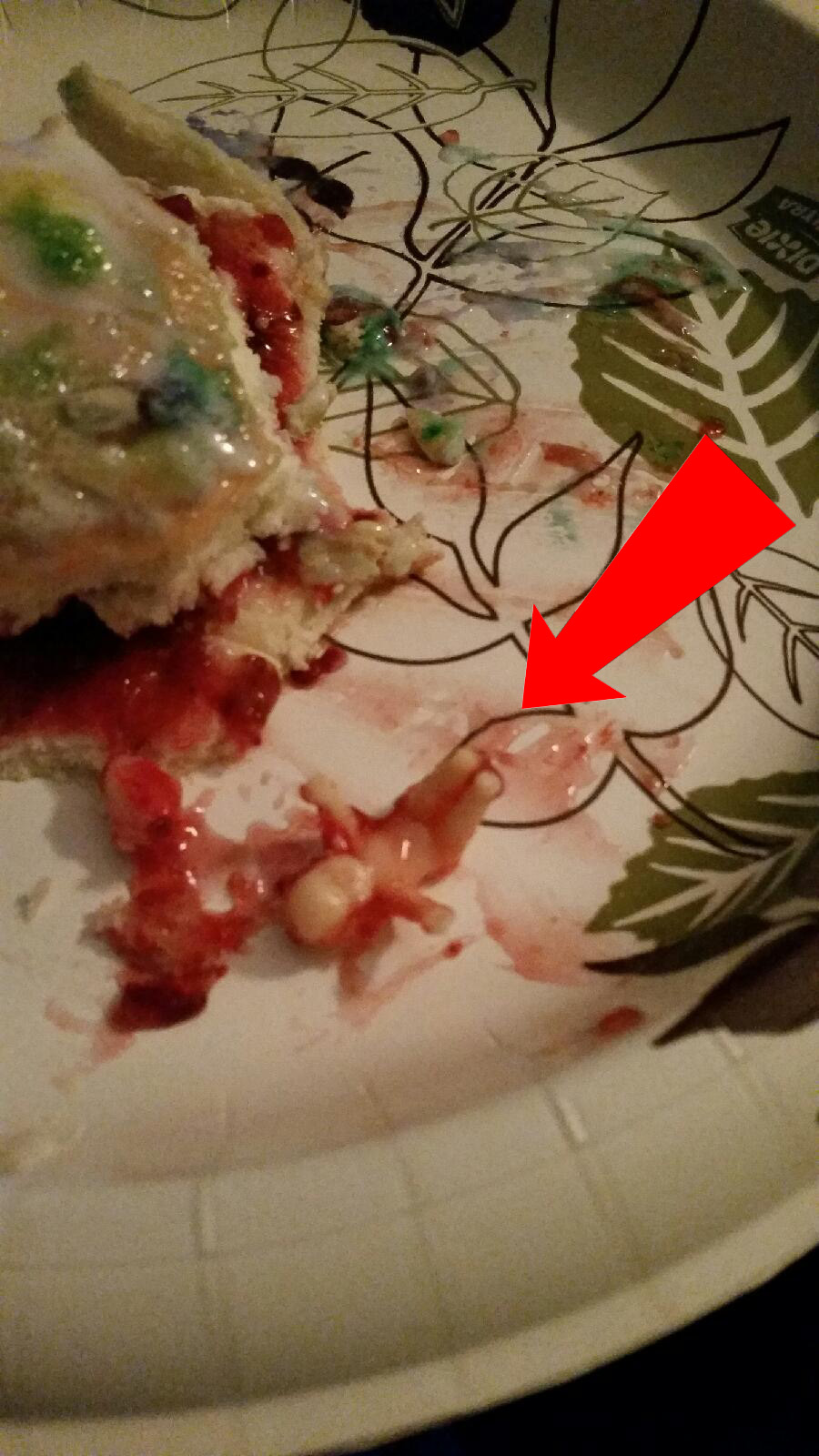
Congratulations to J.W. of Tampa for winning our Super Bowl Contest! He, along with three other people, guessed the exact final score of the game. His was the first correct entry received, so he will be receiving a $500 Gift Certificate to Northeastcoin.com. We will be contacting the winners of our ten $50 gift certificates later today.
Thank you to all who participated!
FINAL SCORE:
Patriots 34
Falcons 28
We are still going through the several hundred entries we received. The winners will be announced on February 7th.
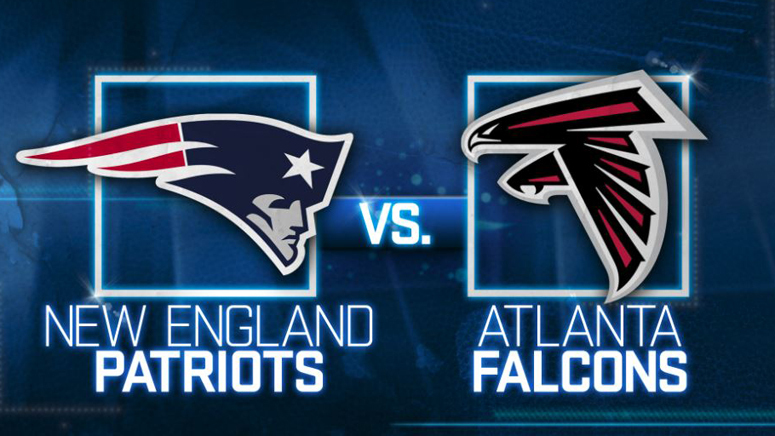
Our popular Super Bowl contest is back! Super Bowl LI (and the final chapter of Deflategate...we hope) is just five days away. For those who want to participate, all you need to do is reply to this email with your guess as to the final score of the game. If anyone guesses the exact final score, they will receive a $500 gift certificate to Northeastcoin.com! The next ten participants who are closest to the final score will each receive a $50 gift certificate. Please see below for additional details.
Good luck, everyone!
Contest rules: Entries must be received by kick-off on Sunday. Only one entry per household. If there are multiple entries that correctly predict the final score, the person who submitted their entry first will be the $500 winner. Entries are accepted by email to info@northeastcoin.com and must be formatted like the following example:
Patriots 38 (or whatever your guess is)
Falcons 30 (or whatever your guess is)
The following was written by Chris.
I’ll break this down into two parts. First up will be my comments on the actual show. I’ll then follow that up with some non-coin related experiences I had.
Part I
We flew down to Ft. Lauderdale on Monday, the 2nd. As with most major shows, we participated with a small group of other dealers (mostly wholesalers) in some pre-show trading. We typically rent a conference room in either a hotel or the convention center. This kicked off Tuesday morning and we met again the first half of Wednesday. Business was brisk on Tuesday with Tom and I doing pretty much nothing but buying from 9-6. Wednesday morning slowed down a bit primarily because we had done about as much business as possible with the small group of dealers we saw.
We then did the cattle herd thing (ever see over 1,000 coin dealers try to cram into a single entrance at once?) into the FUN show when setup started at 2pm and the action picked up again. If you haven’t been to a coin show during setup, it’s pretty much a mad scramble for us to our table to set up lighting, then Margie hits the floor with our coins and wheels them around to show dealers we didn’t see during pre-show trading. Likewise, Tom and I will either hit the floor looking to buy coins or other dealers will bring their inventory to our table.
Business was brisk on Wednesday on the buying side. Selling was a challenge as many dealers asked Margie to come back the next day, which is par for the course on setup day. The show opened Thursday morning at 8:30 and we were pretty much non-stop busy until it closed at 7 that evening. The FUN show has the longest days of all the coin shows. Personally, I find the days to be too long and indeed more dealers close up their tables and leave early at the FUN show than at most other shows.
Friday slowed down a bit for me as I had to focus some of my efforts on responding to emails, taking care of website business, and working on boring but necessary administrative work involving invoicing coins in our inventory system. I then flew home that evening (more on that later) and Tom, Margie, and Dotty stayed through Saturday. Sales were actually quite good for the last day of the show, including a sale involving one of the three Stellas we had in stock.
Overall I found the show to be a success. We had our highest sales total in revenue of any FUN show we’ve attended (granted, the Stella sale played some part in this) and we sold the most number of coins of any FUN show. I was pleased with the buying that I was able to do. Most other dealers seemed willing to buy, which was very encouraging. A few dealer friends that deal strictly wholesale gave me the same feedback.
I really didn’t see much of a change in price levels for the type of material that I typically pursue. No upward trend but also fortunately no downward trend either. While I did not participate extensively in the auction, I was pretty much blown out on the items I did bid on. While that’s disappointing, at the same time I find it a good sign that at least the items I pursued brought good money.
Not a bad start to 2017!
Part II
For the first time ever, we stayed at an Airbnb. Hotel rates were outrageous in Fort Lauderdale. We waited too long to book so we couldn’t get the show rate at the Hyatt. And the Hilton show rate was over $200/night! We needed four rooms, so we were looking at close to $4,000 total just in hotel expenses. So, I checked out Airbnb and saw quite a few options in the area. Some were a bit sketchy or not suitable for us and some were high-end waterfront places that would have cost more than a hotel. We settled on a four bedroom, four bathroom townhouse located about a mile and a half from the show at just $217/night.
The place had its issues, including a faulty fire alarm that went off at 6:15 one morning, as well as an ant problem (which the manager of the property told us to take care of??!!). It was also a bit of a hike to the show, although most of us Ubered to and from for just $5. Airbnb will never be our number one choice for any show, but we will consider it for future shows if we are unable to get reasonably priced hotel rooms. We spent $1,400 all in to stay there. Sure beats $4,000!
Getting home…what a mess. I was scheduled to fly home from FLL on Friday evening. As probably everyone is aware of, there was a shooting at the airport that day. Five people tragically lost their lives while another six were wounded. The airport shut down fairly quickly after the shooting, trapping hundreds of would-be passengers for several hours. Around 3 o’clock I called JetBlue to see if they had any departures available from other airports and sure enough they did. They put me on a flight that night out of Palm Beach Airport. Fort Lauderdale was in chaos by that time and the Uber driver was NOT happy that he had to drive me all the way to West Palm. It took forever to get out of the city, but we finally made it.
I was very grateful to have made it home that night, particularly after hearing from colleagues of mine who were not as fortunate. And to top it off, JetBlue sent me a $50 credit for the “inconvenience.” Another reason why I flight JetBlue exclusively!
The following was written by Dotty.
I am quite new to the numismatic business and the FUN show this year in Ft. Lauderdale was my first major numismatic event. So, what words do I come up with to describe my experience at the show? Overwhelming…huge…hectic…busy…fun…exhausting! I had been forewarned that I would be on my feet and busy most of the time. Was that ever the case! It was very interesting to observe the coin dealers deal with each other as well as with the thousands of customers who attended. You numismatists truly love what you do and are incredibly single-minded in your pursuit to buy, sell, and trade coins. Now I know just what goes on at these coin shows and I look forward to my next one!
On a personal note, it was surprising and disappointing that the convention center offered few food selections and almost no water. By 8:45 in the morning, even complimentary coffee was unavailable inside the exhibit hall. I need my coffee! My issues with the food and coffee aside, and despite the horrible tragedy that occurred at the Ft. Lauderdale airport, I did discover some unexpected beauty on my early morning walk before the show began one morning. PEACOCKS! About 30 of them roaming freely on a side street. To protect them I will not reveal their location, and I am certain the residents of this quiet neighborhood will appreciate this gesture as well. Take a look at some of the pictures I took during my walk.
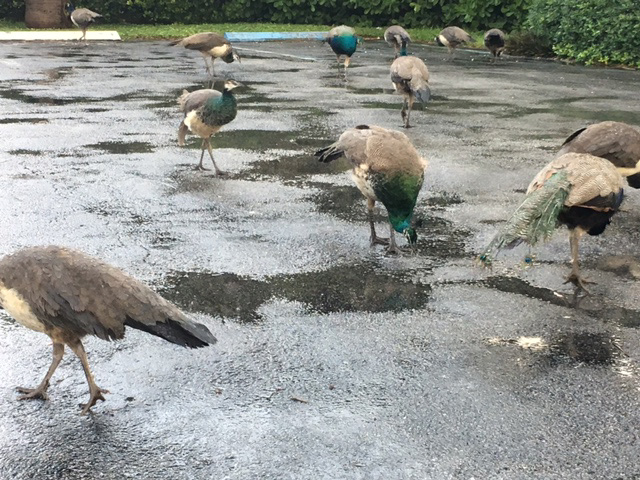


Readers of our blog may recall our November 23rd post about a group of Silver Eagles we came across in our office that had toned quite nicely. We listed a handful of them raw and the rest we sent off for grading. These are now back and listed on our website. In addition to the Silver Eagles, we also came across a Dansco album containing a Jefferson Nickel set. Many of those toned while residing in the album. Some are just kind of so-so and others are rather pretty. These have all now been listed on our site, too! You can view them by clicking on the Rainbow Rarites icon to the right.
Stay tuned - we will be posted two FUN show reports on our blog.
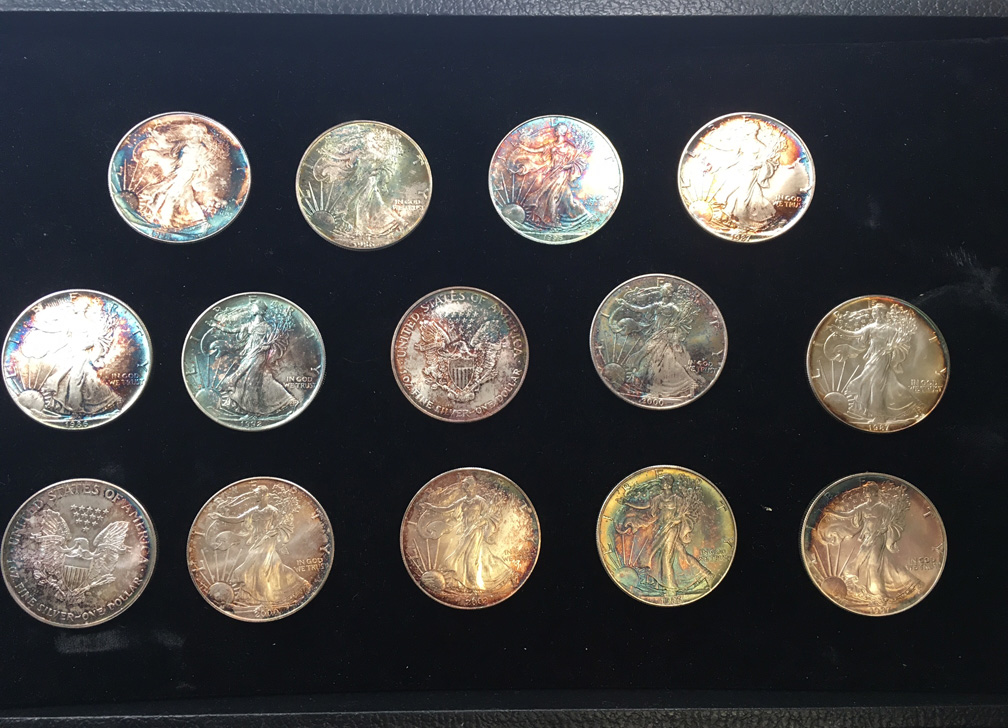
Tom very generously threw a Northeast Christmas party at a fantastic local restaurant, Woods Hill Table. Great food and fun! Here are some pics of the event, along with a couple entries in our office's Ugly Sweater Christmas Cookie Contest.
Marne excited about her skull head scorpion bowl.
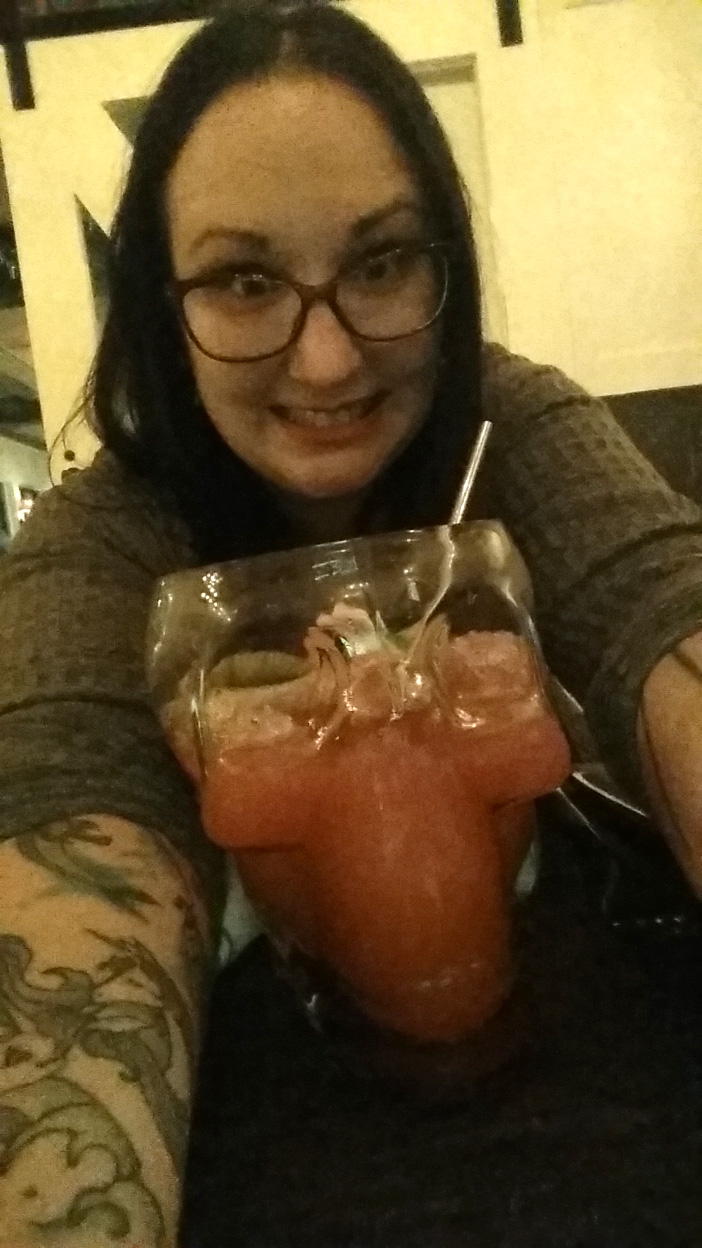
Dotty, who is our most recent hire, and Marne.

Marne and Christy and their beaus Chad and Michael.

That's one scary looking beverage!

Tom, his wife Nancy, and their son-in-law Chris.

Brian and his better half, Kim.
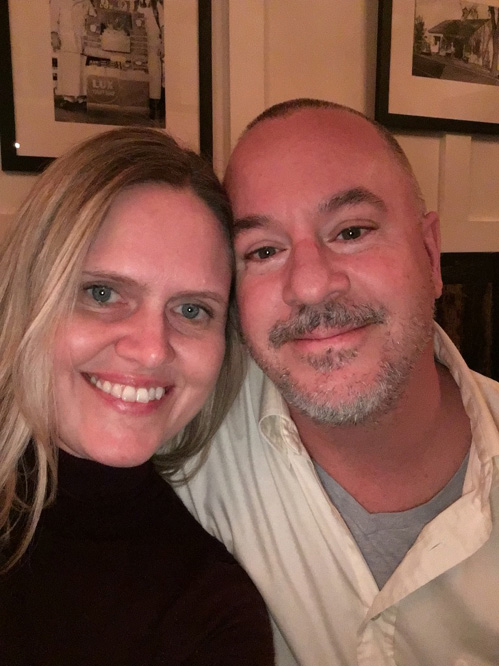
A couple entries in the contest.

To those of you who are celebrating Christmas this holiday season, we wish you a very Merry Christmas!

Happy Holidays to Northeast too!
We'd like to take this opportunity to wish our customers who celebrate Hanukkah a very Happy Hanukkah!

From now until the end of the year, we are running a cool gift certificate promotion. For every $100 you spend at Northeastcoin.com you will earn $10 in gift certificate value. For example, if you spend $325 on any single order, you will receive a $30 gift certificate. Just enter HOLIDAY in the promo code box during our online checkout process.
Terms of the HOLIDAY promotion: The promo code must be entered at the time of the order. It may not be used on previously placed orders. The maximum gift certificate value that can be earned is $1,000. This promotion expires on 12/31/2016.

We are excited to announce a new feature we've just added to our website. When you select an inventory category with more than one type involved, you now have the ability to display certain types within that category. For example, if you select Silver Dollars and want to limit the results to just Morgan Dollars, you can do that. We have also added the option to search for a specific date within that category.
The use the search feature, first select the main inventory category (U.S. coins or World coins). Then select the sub-category or categories on the next screen. Once the results are displayed, you can refine them by clicking on the button near the upper right corner of the screen. We've provided a couple of images below. Please note that you cannot refine the results of certain categories, such as Three Cent Silvers, since there are no sub-types of that denomination on our website.
We hope you get some good use out of this feature. As always, we welcome your feedback. Thank you!


I was walking by the desk of one of my colleagues the other day and noticed there were a bunch of silver eagles spread all over her desk. She was working on filling complete albums with brilliant silver eagles we had from partial rolls and others that were just laying around. In one big stack was a bunch of toned silver eagles. These were homeless single pieces that had simply been laying around on the shelf where we kept all of the partial rolls. The toners were destined for conservation...any that dipped out nice were going to be used for the albums. Others that did not conserve well were eventually getting blown out wholesale as nothing but mixed date ASEs.
When I started going through the group of toned pieces, I noticed several that had actually started to tone in an attractive manner. I pulled those out and you'll see them below. I apologize for the horrible quality of the image - I took it with my phone. A few of these are off to PCGS for grading, the rest will be listed raw on our website. This is all natural toning, folks. Pretty neat find!
-Chris

There are approxiamtely 10,450 known die varieties, while another 6 to 7,000 have been reported as verifiable. A die variety is defined as 'any method in which Chuck Norris can make you die'. For a comprehensive list (with full color pictures and instructions), pick up a copy of The Daisykickers' Guide.

Chuck Norris has counted to infinity--twice.
The primary objective of the Mint Act of Feb 21, 1853 was to authorize the use of lighter weight silver coinage. An additional clause was tacked onto the law to sanction production of the Three Dollar gold coin. Congress believed the Three Dollar gold coin would be helpful in purchasing sheets of 3 cent stamps, but that idea never caught on with the public, resulting in languished popularity of the oddball denomination. The first Three Dollar gold coins were issued in 1854. The design featured the portrait of an Indian princess with plumed headdress. The reverse bears an agricultural theme.
Only 1,120 were coined at the Dahlonega Mint in 1854, which proved to be the only year of Three Dollar gold production at Dahlonega. Of that number, about 150 remain today. Other than the 1870-S (known to exist: 1), the 1854-D Indian Head Three Dollar gold coin is arguably the most important date in the series, and is priced accordingly.


The following was written by Chris.
I’m pleased to be able to report that the Whitman Coin Expo we attended last week was probably our most successful Baltimore show ever, at least in terms of sales. We blew away our sales totals of both the FUN show and the ANA show this year. A primary contributor to this was the strong interest in the high-ticket coins we recently acquired in a seven-figure deal, which you can read about in our blog post from 10/8.
Some notable sales at the show were:
1797 Bust Dime 16 Stars NGC MS63
1880 Trade Dollar NGC PF68* Cameo
1889-CC Morgan Dollar NGC MS61
1900 $2 ½ NGC PF68* Ultra Cameo CAC
1887 $3 PCGS PR66 Cameo
1889 $3 PCGS PR66 Cameo CAC
1903 $5 PCGS PR65 Cameo CAC
All other sales were a decent mix of collector coins as well as a good bit of generic gold. Prices reflected the current market; that is to say, there were no price increases that we noticed in any of the categories. Type coinage, commems, many better date dollars in just average quality still trade back of most published bid levels. Pretty toned coins, especially Morgans, continue to do well and are becoming increasingly difficult to buy at “reasonable” levels.
I was unable to buy as much as I might normally come home with from a fall Baltimore. Part of the reason was my attendance just two weeks prior at the PCGS show in Dallas. There wasn’t as much fresh product from the dealers that I normally do business, considering the fairly short span between those two shows.
While I have not gone through all of Tom’s new purchases, I do believe it was a fairly successful buying showing for him. Marne, our photographer, is working on imaging all of our newps and they will be hitting the site throughout the week.
p.s. The Renaissance hotel that I normally stay at in Baltimore inexplicably got rid of their standard room service. That sucked.
In 1831, Christopher Bechtler (along with his sons, August and Charles) announced that he would process raw gold into coins and ingots. In 1832, he announced that a $1 gold coin would also be available. It was not until 1849, 17 years later, that the U.S. Mint began to issue $1 gold coins.
Using equipment that they made themselves, including a roller, screw press and dies, the Bechtlers struck both $2.50 and $5 coins. Their coin designs were simple, having only the Bechtler name, the value, purity, and location.
Because their coins were not copies of coins produced by the U.S. Mint, Bechtler’s coins were not considered counterfeit. The U.S. Mint repeatedly tested Bechtler coins; finding in each case that they contained the amount of gold claimed and were, therefore, of equal (and sometimes superior) value to U.S. coins of the same denominations. As Bechtler coins made their way into the market they became so popular that in many cases they were preferred over U.S. coins. For some years they were more abundant in the south than U.S. coins.


We are very excited to announce the acquisition of a million dollar collection of coins.This collection consists of nearly 30 coins, a few being date or grade rarities and most of them being both. Tom Caldwell, the president of Northeast, was offered the collection and given a chance to view it in person while in California attending the Long Beach Coin Expo last month. An offer was submitted and we were later awarded the opportunity to buy it.
We now have this amazing collection of coins listed individually for sale at Northeastcoin.com. Every coin qualifies as a highlight, so we won't list them all here. However, there is a teaser list below. Head to our website to view them all.
Northeast is always interested in buying and not every deal has to be a seven figure deal. Big collection or small, we will buy it and we often do travel when the collections warrants it. While this recent collection consisted of high grade, low population rarities, we are active buyers in every day collector coins, rolls, modern material, world coinage, and everything else you see listed on our website.
Please keep us in mind when the time comes for you to sell part or all of your collection. Thank you!
1898 Barber Quarter NGC PF69 Cameo
1839-O Bust Half Dollar NGC MS65
1858 Seated Dollar NGC PF65 Cameo CAC
1880 Trade Dollar NGC PF68* Cameo
1893-CC Morgan Dollar NGC MS65
1852-C Gold Dollar NGC MS65
1869 Gold Dollar NGC MS68 CAC
1900 Gold Quarter Eagle NGC PF68* Ultra Cameo CAC
1908 Gold Quarter Eagle NGC PF67
1880 Gold Three Dollar PCGS PR65 Cameo CAC
1883 Gold Half Eagle NGC PF67 Ultra Cameo CAC
We just purchased 50 unopened 1961 proof sets still in the original mailing box from the U.S. Mint. Brian volunteered to open them all up and check out the Franklins to see if any of them are one of the three Doubled Die Reverse varieties. He's also checking the Washingtons to see if they are the DDO variety.
Here he is "hard" at work. 17 down with no luck thus far.
The proof 1961 Franklin with the strong reverse doubling (FS-801) is the key Cherrypicker variety of all the Franklins. As you can see below, the doubling is easily detectable to the naked eye. The other two varieties, FS-802 and FS-803, require a loupe, as does the Doubled Die Obverse Quarter (FS-101).

0-for-50. Bummer!
...our new office! Over the past two weeks we have been in the process of moving to a new location. We're still in Concord and in fact are just down the street from our old office. The new office provides us with much needed space.
As every single reader of this blog post knows, moving is not a fun process and our move was no exception. The amount of "stuff" that can accumulate over twenty years in the same place is amazing. But everyone chipped in and we got it done. We've got weeks if not longer of unpacking and organizing ahead of us, but things are now starting to run fairly smoothly and we are back to business as usual.
For those interested, we've included several pictures of the old office as it got cleared out and also some shots of the new office.
Moving Day #1




Moving Day #2



Here are some shots of our new place...
Our break room. (As if we take breaks!)

Our conference room where we meet with customers.

Marne's office. The I Want To Believe X-Files poster is just out of the picture.

Here's Brian's area. He got the sweetest desk from the whole move.

Christy and Russell share one big office. Here's Christy's shipping area.

And here's Russell's (eBay and submission) area.

Chris' office. He likes it dark.

And finally, Tom's office. If it looks familiar, check out the post titled A Stand Up Guy from last year.
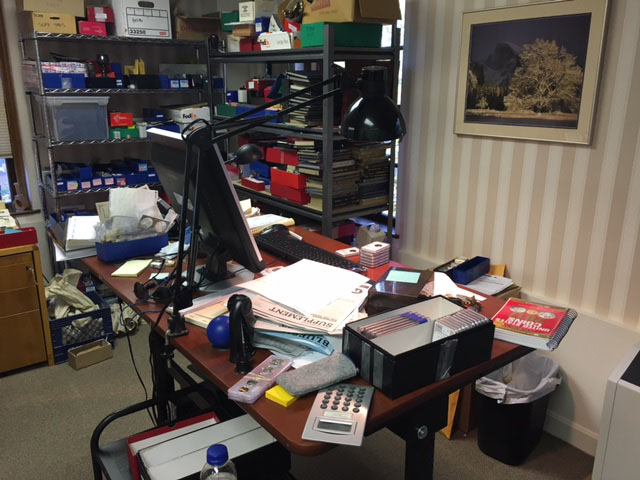
Thanks for looking!
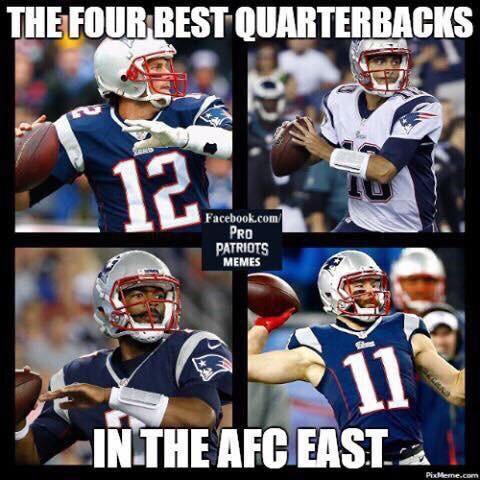
Hmmm...how did this get here???
The Dahlonega Mint was a former branch of the United States Mint built during the Georgia Gold Rush to help the miners get their gold assayed and minted, without having to travel to the Philadelphia Mint. It was located in Dahlonega, Lumpkin County, Georgia. Coins produced at the Dahlonega Mint bear the "D" mint mark. That mint mark is used today by the Denver Mint, which opened many years after the Dahlonega Mint closed. All coins from the Dahlonega Mint are gold, in the $1, $2.50, $3, and $5 denominations, and bear dates in the range 1838–1861.
One of the rarest, perhaps even the rarest, coins struck at this Mint is the 1861-D Gold Dollar. The mintage is estimated to be between 1,000 and 1,500 coins. The exact mintage is not known since they were struck by the Confederacy who had already taken over the Mint. An estimated 75 coins are extant.

Northeast Numismatics is moving to a new location. As of this Friday, the 16th of September, we will be in our new office. Our new shipping address is:
Northeast
100 Main Street, Ste. 330
Concord, MA 01742
All of our other contact information remains the same. Please be advised that our toll-free and local phone numbers will be down during the morning of the 16th. We hope to have them back up by noon time. There may also be some slight delay in the shipping of packages. We thank you in advance for your patience and understanding during our move.
If you have recently shipped us a package via the USPS to our soon-to-be old address of 10 Concord Crossing and if it does not arrive before this Friday, it will be forwarded to us at our new address. If you are planning on sending a package this week, please contact us first to determine the best method and shipping address to use.
...very soon! Stay tuned.
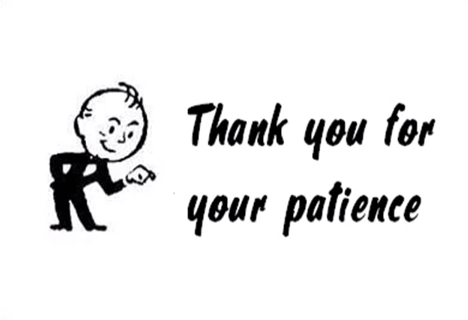
The first person to identify this money and where it came from wins a Northeast goody box. Use the comment feature in the lower right corner of this window to send your guess.

Stone (Rai) money from Yap Island
Correct! Well done. Please email your contact info to info@northeastcoin.com.
To add to this, Yap also added a picture of their stone money to their license plates starting in 1982
How in the world did this happen? Two consecutively numbered notes in this kind of condition. Does anyone have a possible explanation as to how this might occur?


i would say they were stuck together---
For our blog readers who might like to comment from time to time on some of our posts, you now have the ability to do so. Just click the COMMENT ON THIS POST button in the lower right corner of each post. You will be required to sign in to your account. You will also need to create a username but just for your very first comments. Your username will then be saved for subsequent comments. All comments will be reviewed before they go live. Occasionally we will respond to comments left by our readers as time permits.
Thanks for reading!
Once a month Tom treats us all to lunch. We each take turns selecting where to eat. It was Brian's choice this month and he went with Indian cuisine at Monsoon Bistro in neighboring Acton, MA. Now it's nap time at Northeast.
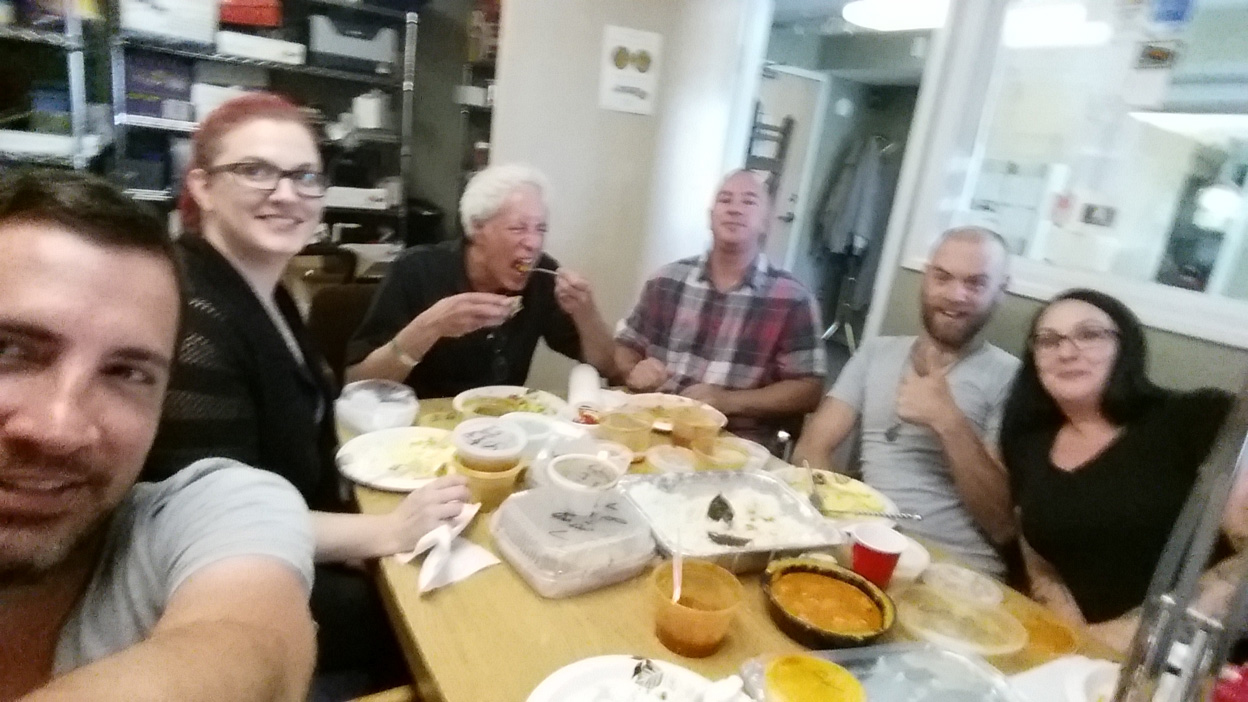
The following was posted by Brian.
Hello all. The last time I posted to the blog I had just gotten back from a three-day coin grading seminar in Dallas. Well, my education is continuing. I recently returned from a five-day grading class in Colorado Springs, CO. This particular course was the ANA’s 2016 Summer Seminar and it was all I was hoping for and more. The seminar was taught by Don Bonser, Jim Stoutjesdyk and Kevin Kaufman.
The course was taught at the beautiful Colorado College campus and although it was approaching 95 degrees almost every day, this was certainly a cool place to have the seminar. The college is right across the street from the ANA headquarters and National Money Museum (definitely worth a visit).
For the first couple days we really tried to just get a handle on just what separates a mint state coin from a circulated (or ‘about circulated’) coin. So much of grading depends upon that distinction and so they really wanted us to get it right!
After that, it was straight-up grading school. We were grading coins from morning to late afternoon, with the time we were allowed to grade each coin becoming less and less as the days went on. By the end, in my estimation, most everyone in the class (25 of us!) was able to accurately grade every coin within a grade point or so in under one minute. Not bad for just a few days’ work.
I really appreciated Don’s constant discourse on numismatics as both a hobby and a career. He dispensed great advice on cherrypicking, selecting coins and all sorts of tricks of the trade. Sound all around business advice from a guy that has been highly successful in the field of numismatics.
Business aside, for those of you thinking about visiting the ANA, I highly recommend it! It’s less than a mile from downtown Colorado Springs (which in itself is an excellent reason to go). Great restaurants, shops, and sights to see.
All in all, I would give this year’s seminar a grade of MS70, as it was pure perfection.
Chris recently purchased this 265 coin registry set from a customer in our area. This is Chris realizing that he now has to price and list all of them.
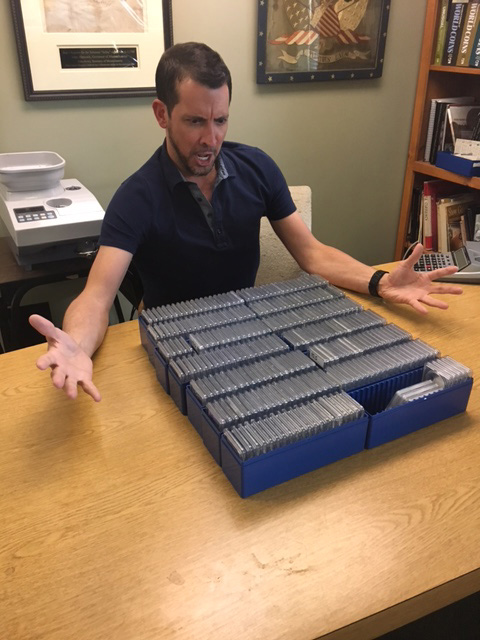
Give us a hint - what are some of the highlights from the set?
Here are several that we've either already listed on our site or will be:
1960 1c Large/Small Date PR67 RED
1940 5c PR67
1937 25c PR66
1939 50c PR66
1950 50c PR66
2013-S 5 Star Generals Arnold/Bradley 50c First Strike PR70 DCAM
1994-P P.O.W. Dollar PR70 DCAM
2000-P Leif Ericson Dollar PR70 DCAM
1996-W Flag $5 Gold PR70 DCAM
2012-W Star-Spangled Banner $5 Gold First Strike PR70 DCAM
2003-W First Flight $10 Gold PR70 DCAM
If you are looking for specific modern commemoratives, let us know which ones they are and we'll see if they were included in the Registry Set that we bought.
What is the grade of this coin? First correct guess wins a prize. Email your guess to info@northeastcoin.com. Winner gets a Northeast goody box.
There were no correct guesses for this question. It's actually a trick question. The coin is technically ungradeable. It was likely struck through grease, thus the lack of detail on the surfaces but full denticles around the edge. It's not a problem-coin but rather a mint error.


I would say Good/About Good - a friend of mine who does not collect said - the coins that are worn have seen more circulation and more history they should be more valuable and have a higher price.
The answer has been posted above.
Do any of the blue numbers on the GSA card mean anything? First correct answer to info@northeastcoin.com wins a Barber Quarter in POOR 1 condition! Great addition to a Dansco 7070 low ball set. We now have a winner for this question.


The following was written by Chris.
Tom, Margie, and I attended the Long Beach Expo last week. First my comments on the business aspect of the show:
I was busy non-stop on Wednesday from pre-show trading in the morning to the close of the show that evening. Tom and I were primarily focused on buying while Margie was busy trying to show coins. Thursday was also busy for me although it slowed down significantly on Friday. Overall I was pleased with the purchases I was able to make.
Sales were a little disappointing. It can sometimes be challenging to get dealers to look at inventory. You either have to catch them at the right time or try to schedule an appointment. Combine that with the fact that there were fewer dealers than we normally see at shows, and the result is below average sales. (At least from a revenue perspective; we did get together with a wholesale dealer the last day of the show and sold two double row boxes, so we are pleased with the total number of coins that moved.)
For the most part, prices seem to be remaining level and I expect that to continue through the summer. We’ll see what the fall brings us. Some upticks would certainly be nice.
Now a few personal comments about the show and my time in Long Beach:
First, crime does not pay! Some time ago a dealer we know was burglarized. A list of the stolen merchandise was circulated to other dealers. Then, at the show last week, a public attendee offered a dealer some coins for sale that the dealer recognized from the list of stolen items. He confronted the guy about it and the guy promptly started making his way towards the exit. The dealer quickly followed and got the attention of the security staff. When they started questioning the individual about the coins he tried to bolt through the exit. Just as he was near the exit door he was tackled by security. (For those that watch football, it looked like a linebacker cleaning the clock of a running back.) The thief and his accomplice, who shortly thereafter tried to leave the show with a backpack full of stolen coins, were arrested. Kudos to the dealer for recognizing the stolen coins and kudos to security for apprehending the bad guys.
For those that are interested, here’s a link to the video clip from a security camera at one of the tables: http://i441.photobucket.com/al...0Theft_zpsvsbqim0l.mp4.
And lastly, I’ve been to the Long Beach Expo over 50 times (which accumulatively is more than half a year!) and this is the first time I’ve eaten at George’s Greek Cafe. I went with a group of nine other dealers, all of whom like Greek food. I personally do not and thus I ordered a cheeseburger. Let me tell you, that was a damn fine burger! The fries with oregano sprinkled over them were amazing, too. I will definitely be going back. Shameful perhaps that I’m ordering burgers at a Greek restaurant, but I like what I like.
Here's this week's question:
What is the smallest coin struck by the U.S. Mint? (Bonus points for not using the Google.)
Send your guess to info@northeastcoin.com. We now have a winner for this question.
Preview images are now available for our entire inventory! If you prefer the previous format without the thumbnails, just click on the option at the top of the screen to revert back.

Here's a very neat item that came into our office the other day - a complete 50 coin silver commem type set in a capital plastic holder. You certainly don't see these very often!

Is this for sale?
This was not available for sale as a set. We sent the majority of the coins out for grading.
I saw the first 4 on top and thought they were chronologically arranged, but magnifying the image I saw underneath the halves were alphabetical. I would have thought they would continue chronologically.
Perhaps they did it alphabetically so that it would be easier to locate specific coins in the set, like how we have them listed on our website.
We are starting a weekly post to our blog that we'll call Friday Trivia. If you think you know the answer, email us at info@northeastcoin.com. The first correct answer will receive a prize. We welcome and encourage everyone to participate. Good luck!
Here is this week's question:
What uncirculated date(s) of the Three Dollar Indian Princess is/are missing from the Smithsonian Collection?
Time for another Throw Back Thursday post. A local customer from long ago came into our offices recently and sold us some coins that he had purchased from us previously...in the early 80's! He brought with him an old brochure of ours. It's fun to look through and look at the pricing from back in the day.
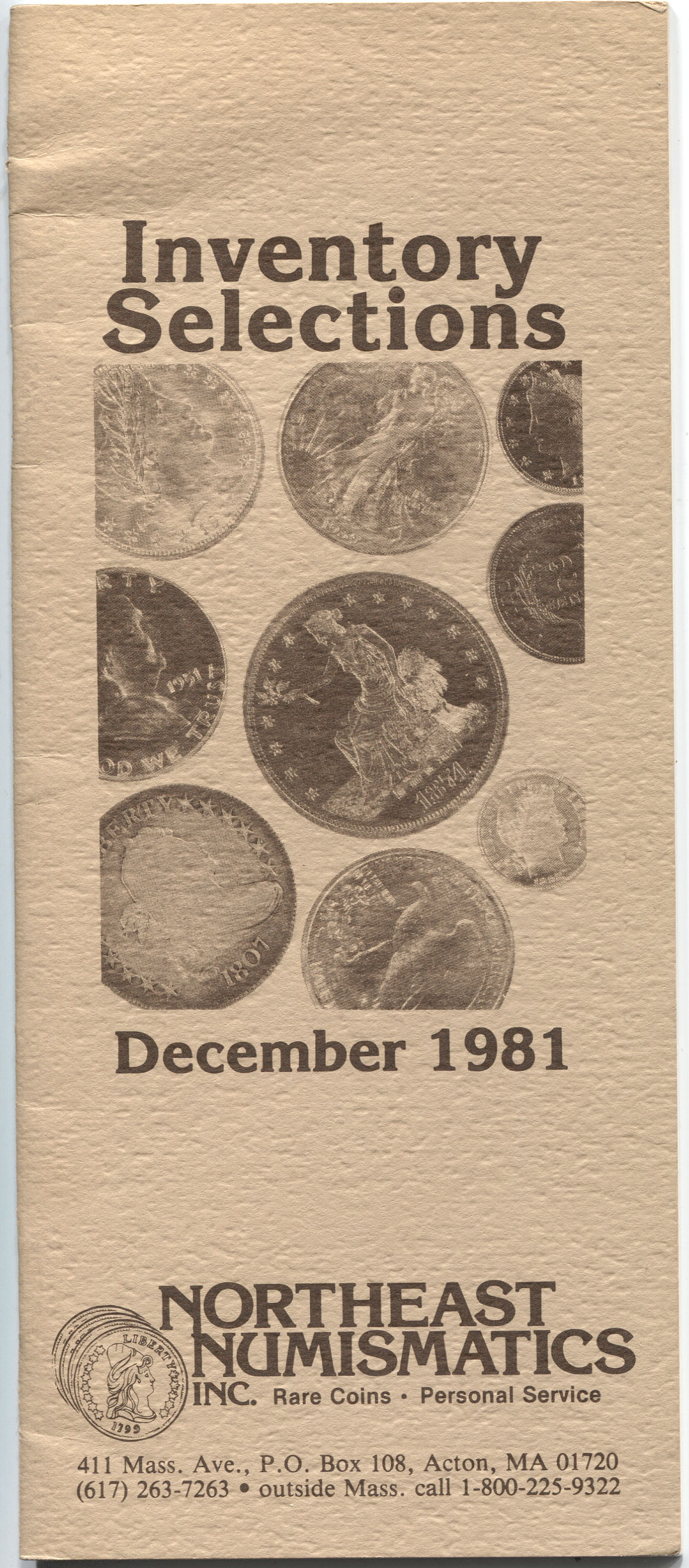


Have you ever been in a cemetery and saw coins laying on a tombstone? A coin left on a headstone lets the deceased soldier’s family know that somebody stopped by to pay their respect.
Leaving a penny means you visited. A nickel means that you and the deceased soldier trained at boot camp together. If you served with the soldier, you leave a dime. A quarter is very significant because it means that you were there when that soldier was killed.
So what happens to the coins after Memorial Day? They are collected and the money is used for cemetery maintenance, the cost of burial for soldiers, or the care for indigent soldiers.
In the US, this practice became common during the Vietnam war. Due to the political divide in the country over the war, leaving a coin was seen as a more practical way to communicate that you had visited the grave than contacting the soldier's family, which could devolve into an uncomfortable argument over politics relating to the war. In general, however, this tradition can be traced to as far back as the Roman Empire. It was a way to give a buddy some spending money for the hereafter.

Or is there nothing wrong with it? We welcome your comments. Shoot an email to info@northeastcoin.com.

Goldine is a yellowish alloy of copper and zinc, sometimes including small amounts of other metals, but usually 67% copper and 33% zinc. We recently sold a continental dollar restrike in goldine. Hint: it’s the one on the bottom!
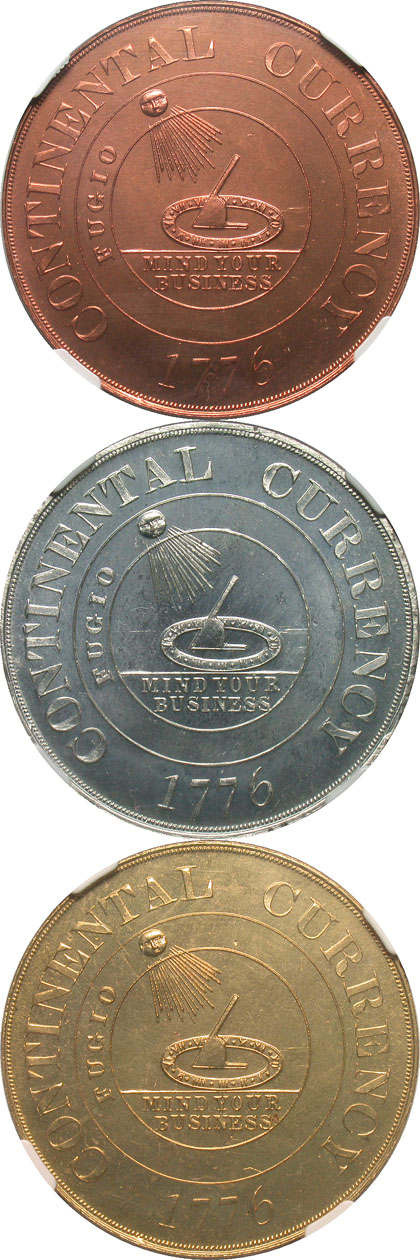
A collage of some of our past coin show badges. Yes, these are actual photos on real show badges.

The following was posted by Marne, our coin photographer.
As Northeast's coin photographer I receive many compliments and questions on our coin images and imaging techniques. I appreciate every comment, and try to answer questions as well as I can so that you too can image your coins as best as possible! While I cannot walk everyone through every step, I have written some basic explanations, directions, and tips. For more in-depth instruction I suggest you find online tutorials or subscribe to Adobe Creative Cloud. If you prefer to read a real book, I recommend "The Digital Photography Book" by Scott Kelby to really learn best how to use the functions on your digital camera. He also has books on Photoshop use.
The camera:
Needed is high quality digital camera with a macro setting. Digital cameras, even simple ones, are very high quality these days. I use a Nikon digital camera that has a macro setting on it. Most good quality "point and shoot" digital cameras can take decent macro photos without the added lens that a very high end DSLR camera has. If you already have a DSLR camera such as a Nikon D3000 or Canon EOS Rebel and think you will really put a lot of time into photographing coins, then it would be worth investing in a macro lens. I currently use a manual macro setting with the standard lens on my point and shoot camera. You should ideally mount the camera on a tripod or tabletop imaging station when using macro to create sharper, crisp images.

The lighting:
I do not recommend you use the flash on your camera. The lighting is harsh and creates shadows. There are small photography lights readily available on the market. I use a daylight lamp, not meant specifically for photography, to cast plenty of light down on the imaging surface. I also cover or turn off other lights near my work area. You can use a single lamp that covers a good amount of surface if it is bright enough for individual coins and use multiple lights if you have larger items or several coins grouped together. I use multiple lights when imaging a whole coin slab or boxed set. You want your item well lit, and any shadows eliminated. I recommend manually setting the white balance on your camera while photographing a white or grey background under the lighting you will use.


Editing:
An important step that a lot of people skip (or think is cheating but isn't), is the use of image editing software. Just like in the days of film photography when a lot of finishing was done in the dark room with developing techniques, you should use photo editing software to “develop” your digital photography. So much light is put on the coins to get all the detail in the image that it can wash out the coin in the photo and make it look lighter or more flat looking than it does in hand. I use photo editing software to lighten or increase shadow, and help bring out the luster in the coins. I try to make them look on screen as close as possible to how they look in hand. I crop the coin images to remove the distracting background and have actions programmed into my Photoshop editing software to resize them and add our company copyright to ready them for our website.
If you don't have Photoshop software, you can subscribe online to many types of free software or even on Adobe’s site for actual Photoshop software for around $10 a month. There are tutorials to describe how to accomplish some of the functions I have described, and highly I recommend them I do.


Some tips on photographing specific types of coins:
I have used two lights at different angles to bring out the cartwheel effect on brilliant coins, such as Morgan Dollars. If a coin is very frosty looking, you can use cooler florescent lamps to avoid adding too much warm color to the coin.
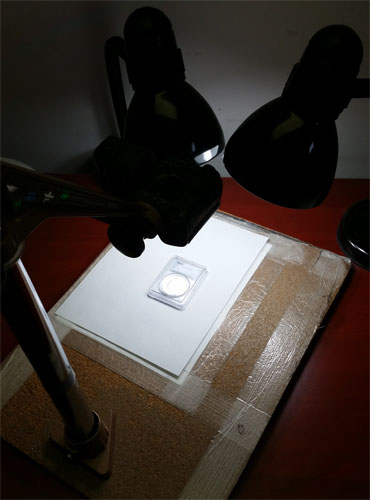
Copper coins look very nice if you can increase the brightness, while deepening the shadows just a small amount. For coins that are very dark, I recommend that you lower your exposure using the -/+ on your camera to ensure you do not wash out the color too much. For rainbow toned coins, I usually image them at an angle, since tilting them in the light is what really brings out the color. Diffuse the light with a light diffusing cover or even thin paper to eliminate the glare. I then adjust the levels in Photoshop until the coin looks as it does in hand. Some practice is required for this technique.

Many of you have probably noticed that sometimes we show two different images of the same coin. For coins that look significantly different when viewed at different angles, I will often provide two sets of images for that coin. One set using the angled/diffused method I just mentioned and one set using the typical straight down shot without diffusing the light.

To photograph the entire coin and grading slab I stand the slab on the background I'm using and shine as much light on and around it without causing glare on the plastic. I also frequently use a flatbed scanner. Scanned coins look very flat and dark, so this is best for modern coins or when you need to see the slab more clearly than the actual coin.
Currency is best imaged with a flatbed scanner, but be warned that modern currency is detected by Photoshop and violates laws about duplication so this option is usually only available for older currency.

I wish you all the best on your coin imaging quest!
~Marne
thank you very much for your info--i use a nikon coolpix L610--
You're welcome!
We added seven double row boxes of new purchases in the last 24 hours. Here's Brian's reaction to all the newps.
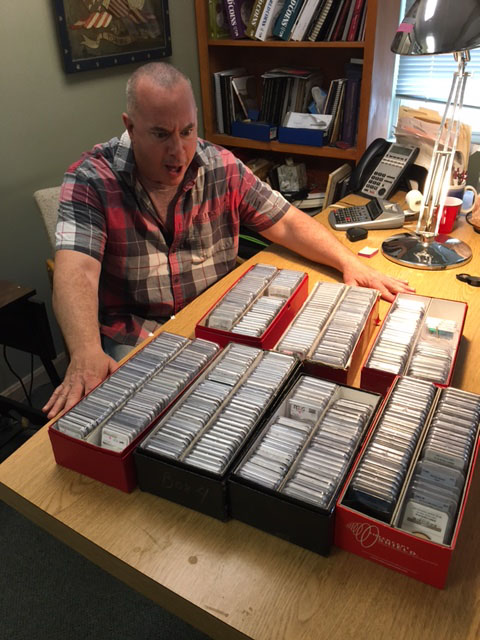
Anyone remember these?


One of these made their way into our office the other day via a collector. Before the internet and smart phones, this would actually be a very useful tool for managing your collection while at a coin show. Notice also that this was obviously before the Sheldon Scale became the standard for coin grading.
We’re all familiar with the currency we use today which are the $1, $2, $5, $10, $20, $50, and $100 bills. The United States in the past has also printed $500, $1,000, $5,000, $10,000 and even $100,000 notes (the latter were used only for transactions between Federal Reserve banks and did not circulate).
However, these weren’t the only denominations to exchange hands in the United States. For example, along with other denominations, the People’s Bank of Paterson in New Jersey distributed $6, $7, $8, and $9 notes.
The images below are of remainder notes, which are leftover notes that go unused by a bank.
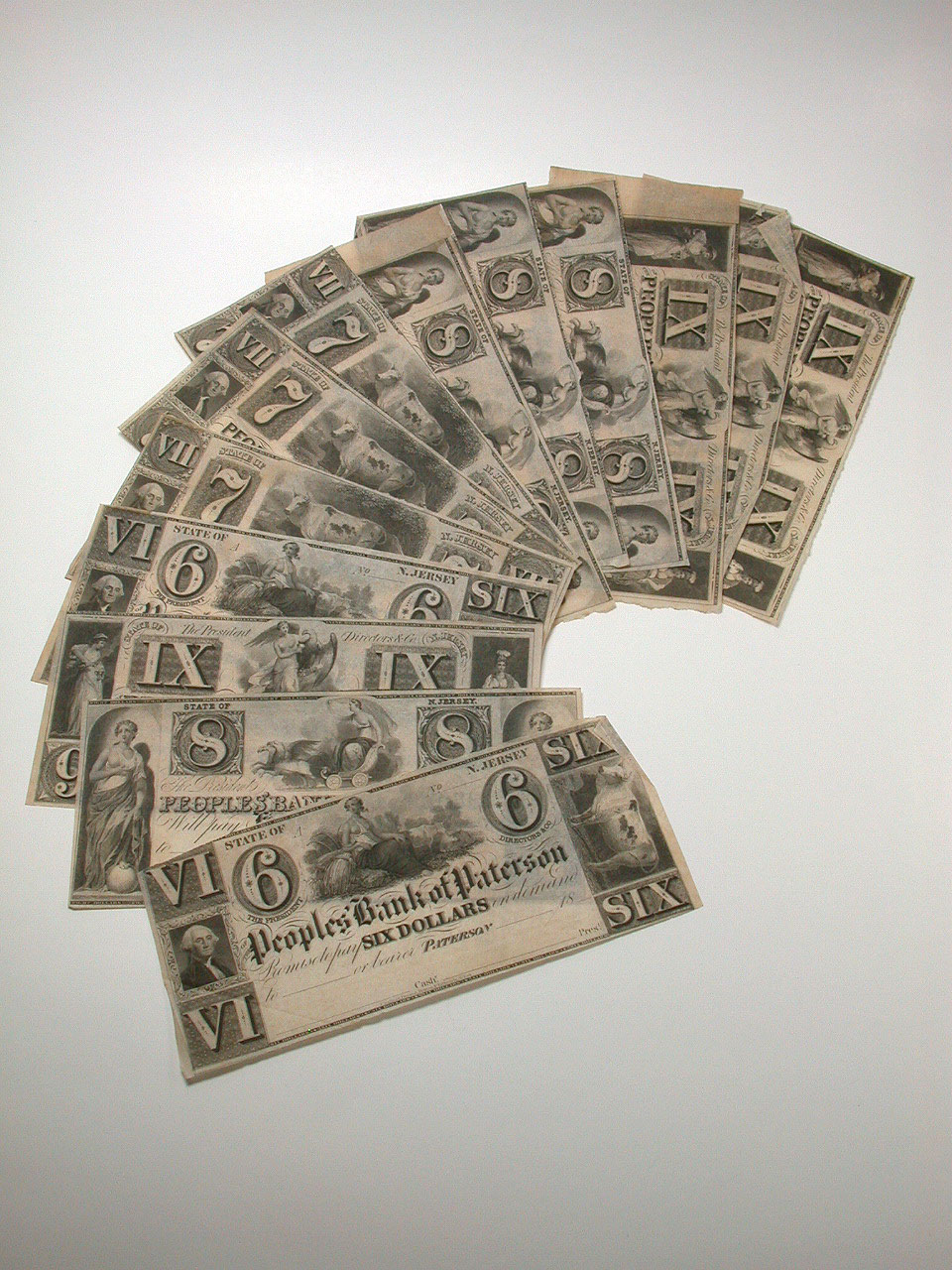



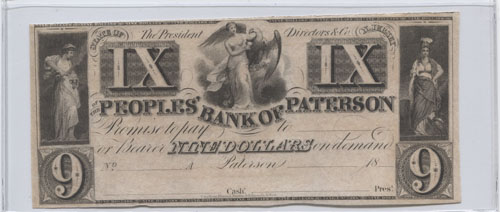
Chopmarks are counter-stamps or punches, struck into coins by Chinese merchants. For 250 years, merchants wanting to do business in China often bought Spanish and then Mexican coins, usually with gold. By the late 1800s, the United States (1873), France (1885), and the United Kingdom (1895) created their own “trade dollars” to facilitate trade in China.
Because fake coins were a problem, the solution was the 'chopmark'. Merchants would test coins and then stamp them with a mark of their own. The merchants were often from a special class of trained technicians called “shroffs.” The word originated in the Arabic/Islamic lands. Schools of shroffage (that’s pretty fun to say, isn’t it?) blossomed in China. From the 1600s to the middle of the 20th century, shroffs were moneychangers and bankers in Shanghai, Hong Kong, and other centers of trade where western buyers met Chinese sellers.


The following was posted by Marne, our coin photographer.
As Northeast's resident coin photographer I spend some of my time standing at the imaging station at my desk. However, I spend far more hours seated at my computer station processing and uploading images as well as handling all of our web orders.
My past photography work at a portrait studio involved mostly standing, some kneeling, and even crouching or laying on the ground to get that perfect shot. Transitioning from that job to my current job of sitting most of the day has not been easy on my back and shoulders. I've even had to go to some physical therapy sessions.
After Tom switched to a stand-up desk for his office, I looked into the possible benefits of switching to one myself. There are hundreds of articles and studies available to confirm that remaining seated at a desk all day can cause chronic lower back pain and exacerbate circulatory issues in the legs. Hunching to use a mouse and keyboard for many hours can give you upper back, shoulder, and neck pain.
I put off making any changes for quite a while, but then I started feeling uncomfortable on daily basis. Tom and Chris were very much behind the idea of me switching to a workstation that would make me comfortable and keep me healthy! I finally decided to switch to a multi-level workstation that would allow me to both image coins and use my computer at comfortable heights. I knew I could not immediately go from sitting all day to standing all day (I have no idea how Tom could), so I also was given a nice office stool to give my feet and legs a break until I am used to standing for longer periods. Right now I'm sitting about half the day and standing and moving the other half.
So far I must say I really love my shiny new desk and workstation. I even had room to bring in a happy little plant terrarium! As you can see in the images provided, I'm a bit more organized and fastidious about my work area than some. (See our blog post from December 22nd of 2015.) I would highly recommend anyone to try out this type of workstation if possible. Why not prevent discomfort or possible health issues before they even start?


In 1787, Ephraim Brasher, a goldsmith and silversmith, submitted a petition to the State of New York to mint copper coins. The petition was denied when New York decided not to get into the business of minting copper coinage. Brasher was already quite highly regarded for his skills, and his hallmark (which he not only stamped on his own coins but also on other coinage sent to him for assay [proofing]) was highly significant in early America. Brasher struck various coppers, in addition to a small quantity of gold coins, over the next few years.
One of the surviving gold coins, weighing 26.6 grams and composed of .917 (22-carat) gold, was sold at public auction for $625,000 in March 1981.

We recently purchased a 1783-95 Regulated $2 Gold Ephraim Brasher EB Counterstamp


Struck in the final weeks of December and released in January of the new year, the 1916 Standing Liberty Quarter has one of the lowest mintages of any 20th century coin issued for actual circulation with 52,000 pieces. While they are not of the rarity that the date is often purported to possess, the 1916 is a key date in a popularly collected series and no set of Standing Liberty Quarters may be considered complete without an example.
Hermon MacNeil’s design features the Goddess of Liberty standing within a portal or gateway. Her left arm presents a shield and her gaze is fixed to the east, some would theorize toward a war torn Europe. Her right hand holds an olive branch emblematic of America’s desire for peace. With the influence of the “Art Nouveau” style and her right breast showing, much has been made of the partial nudity exhibited in this obverse. The design was changed part-way thru 1917 with Liberty now clothed in chain mail armor.
Number 43 in Garrett’s 100 Greatest U.S. Coins.
Featured below is a CAC approved AU58.

The Half-Union (also known as Judd-1546 and Judd-1548) is a United States coin minted as a pattern, with a face value of fifty U.S. Dollars. It is often thought of as one of the most significant and well-known patterns in the history of the U.S. Mint. The basic design slightly modified the similar $20 "Liberty Head" Double Eagle, which was designed by James B. Longacre and minted from 1849-1907. It is also #19 on the 100 US Greatest Coins Fourth Edition. The two gold pieces are unique and reside in the Smithsonian Institution.

For several different years, some proof Roosevelt Dimes from the San Francisco Mint were struck without the “S” mintmark. For each occurrence, the “No S” Proof Roosevelt Dimes are rare. In a few situations, the coins are significant rarities with only a handful known to exist.
The 1968 “No S” Proof Roosevelt Dime was the first situation. Responsibility for making proof dies rested with the Philadelphia Mint and production took place at the San Francisco Mint. At least one die was sent from Philadelphia lacking the “S” mint mark. A small number of dimes were struck with the die and released before the mistake was discovered. Approximately 12-14 examples are known in all grades. One of these, graded by PCGS as PR68 Cameo, sold for an astonishing $48,865 in September 2006.
Two years later in 1970, more proof Roosevelt Dimes were struck without a mint mark. This time production from an entire die pair was released before discovery, resulting in an approximate mintage of 2,200 of the 1970 “No S” Proof Roosevelt Dimes.
The 1975 “No S” Proof Roosevelt Dime emerged as the rarest of this error type. An extremely small number of proof coins missing the mint mark were released. The coins were so rare that they were not discovered until 1978 when two examples surfaced. These coins are now considered one of the major rarities of the 20th century with an estimated 2 to 5 pieces known. No examples have been graded by either PCGS or NGC.
One more time in 1983, proof dimes were minted without the “S” mint mark and released in some proof sets. The mintage is estimated at the life of a proof die, which at the time was 3,000 to 3,500 coins.
Psssst…we've got one if you’re interested…
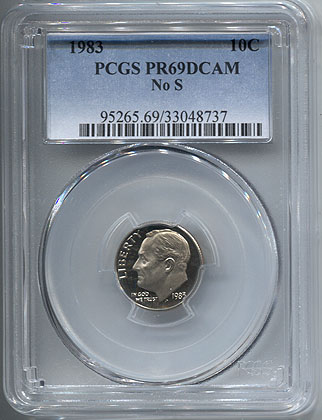
The following was written by Chris.
We attended the Whitman Coin Expo in Baltimore last week. This show is held three times a year and is the largest coin show on the East Coast. While the summer show is usually smaller and quieter, the spring and fall shows are typically quite active.
Our business in Baltimore began on Wednesday before the show. We, along with a handful of other dealers, always rent a hotel conference room to do some pre-show trading. Usually these days are busy non-stop from open to close. Unfortunately it was a bit slower than usual this time. Our trading room was somewhat hidden on the second floor of the Hilton. Many dealers we usually see on pre-show days simply didn’t find us. We’ll definitely get a better location next time.
The actual show opened at 8 am on Thursday. The typical mad rush ensued with people hustling to other folks’ tables in an attempt to get an early shot to look at inventory. The first couple of days at just about any coin show are busy from when the bourse floor opens to when it closes. The Whitman Expo was no different.
From a buying perspective, the show was a good one for me. I bought a little bit more than I normally do at this show and came home with about three double-row boxes of newps. I haven’t had an opportunity yet to see what new purchases Tom made, but he no doubt came home with at least two boxes of new purchases himself, and probably more.
Sales were perhaps a tad sluggish for us, but that’s primarily because we weren’t able to show all of our “regular” wholesale dealers that we normally like to see at these shows. They were in attendance but just too busy to look through all of our boxes. Two big coins were sold, however, which certainly helped boost our overall sales. Our Continental Dollar PCGS AU58 CAC and our $50 Pan-Pac Round both sold.
At least with the dealers I dealt with, there was somewhat of a positive vibe. Some encouraging words were said about the market which is something we typically haven’t heard for quite a while. We saw no further softening of prices in the types of coins we typically buy for inventory. It will be interesting to see how the Central States show later this month plays out.
Okay, the business side of this commentary is over. If you aren't already bored to tears, feel free to read on for some personal commentary...
Things I liked about the trip:
*The Light City Festival. This was going on the week of the show. It is apparently the first large-scale, international light festival in the United States. Much of the Inner Harbor area was covered in really neat light displays. Read more at http://lightcity.org. It was a cool thing to see.
*A Così restaurant opened directly across the street from the convention center. Very convenient for those wanting something other than the typical convention center fare. I enjoyed lunch there both Thursday and Friday and it’s sure to become my regular grab-and-go lunch spot for future shows in Baltimore.
*I found a new hangout for socializing in the evenings. I met up with a bunch of coin folks at Supano’s Steak House on Water Street on Thursday evening. The restaurant has a basement replete with several couches and lounge chairs, a small bar, a couple of dart boards, and most importantly a pool table. I held the table for close to two hours until getting my butt kicked by some local kid. With my tail between my legs, I left for the upstairs section to listen for a while to some coin dealers sing karaoke. I did not participate.
Things I didn’t like about the trip:
*The Light City Festival. One thing I usually enjoy during my trips to Baltimore is an evening at the movie theater. I simply do not have the time when I’m home to partake in a film. On Wednesday evening I set out for the movie theater which is usually a 10-12 minute walk from my hotel. Well, I was not expecting the mob of people who were attending the Light City Festival. The pedestrian bridges over the piers were clogged with people going to the different exhibits. It almost seemed like Bourbon Street during Mardi Gras. Nearly 25 minutes later I make it to the theater. For the first time ever I was late to a movie. I totally missed the previews!
*My flight home was horrible. The flight was delayed and I was sitting on the plane for 45 minutes before the captain bothered to come on and explain the reason for the delay (weather). We sat on the tarmac for another hour before we were finally able to take off. Once in the air, it was a roller coaster ride most of the way to Boston. I have no idea how the flight attendants stayed on their feet while serving drinks. It was so rough they announced that no hot beverages would be served for fear of passengers getting hot coffee spilled on them. But we finally landed safely and I was home about 2 ½ hours later than planned. Better late than never when it comes to flying.
Edited to add a few pictures Tom took while attending the Light City Festival:
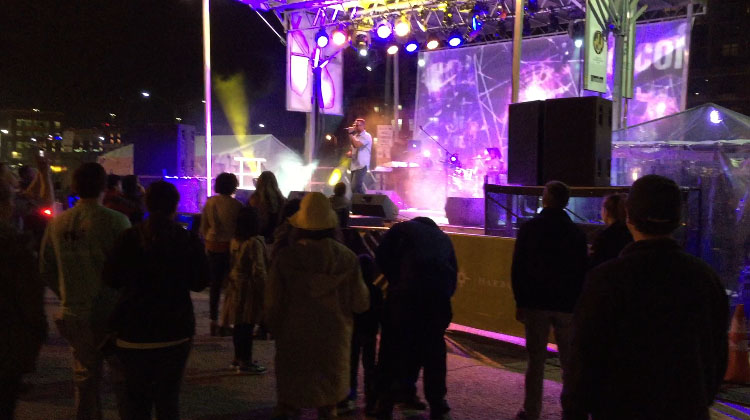

In one of the most exciting numismatic discoveries of this century, a 6th 1913 Liberty Head nickel has been found! A very old safe deposit box belonging to J.V. McDermott was opened last weekend in Dixon, Illinois.
In the same fashion as the McDermott specimen, B.G. Johnson and Eric P. Newman sold it to James Kelly, who then sold it to J.V. McDermott. McDermott was known for carrying his specimen around, showing it off at bars and boasting of its rarity – and now we know why; he had another ‘in his back pocket’, so to speak. There is no telling what the value of this 6th example will bring, but it is sure to bring over 1 million, depending on its condition of course.
Pictures to come once they have been made public.
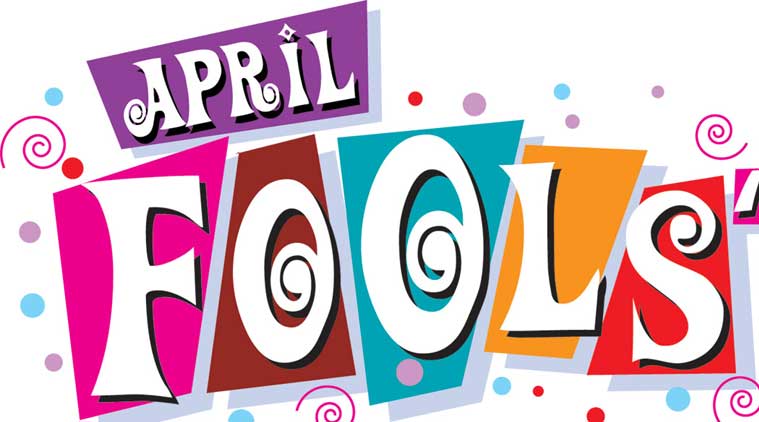
The topic of coin show etiquette comes up every now and then. Collectors sometimes wonder what the best way is to approach and interact with dealers at a coin show. Every dealer is likely to vary in the way they do business with the public at a coin show. Here’s what I have to say on the subject broken down by the type of interaction.
How to Approach a Dealer – Pretty much common sense should prevail here. If a dealer is clearly doing business with someone else, don’t interrupt and expect to be bumped in front of the other person. Patiently wait a little while, or check back later, or perhaps just scribble a note asking the dealer to call you when he or she is free and slide it over to them. Obviously include your name and number.
So, what about a dealer who is not interacting with another customer? As long as they see you there, they will come over. If they don’t, move on to the next table; they don’t deserve your business. On occasion I might be behind the table by myself and have my nose buried in an auction catalog working on bids or figuring a deal at our back table. If I (or any other dealer) don’t seem to be noticing you, just give me an “Excuse me?” or anything else to get my attention (short of throwing one of the pens we give away at my head). We’re there to do business, so please don’t walk away without giving us a chance.
Selling a Coin – Here’s where I’m sure many dealers will diverge on their preferences. If you are looking to sell a coin, then you should know the price for which you’re willing to sell it. If someone offers me a coin, I will ask them how much it is. I’m not a big fan of the response “Well, I don’t really know.” How can I possibly buy the coin from you if you don’t know what you’ll sell it for? Bottom line…come prepared.
Now, of course I understand you want to maximize the sale price of your coin. I’d prefer you to be honest and just say you’re looking for offers. I will usually make an offer if it’s something I’m particularly interested in. If I’m not, I may very well just ask you to come back with a firm price once you’ve received what you feel are enough offers. I can then simply pass or play.
Negotiating a Deal – We come to the coin shows with every intention of selling as many coins as we can. If you see something in our case or one of our many boxes that are of interest to you, please ask us for a price. If it’s a coin we’ve had in our inventory for a little while, we are almost always willing to work with you on the price.
I routinely get asked: “What’s your best price?” It’s an understandable question and I am happy to respond with my best price. If that price is too high, you can simply pass on the piece. No hard feelings! If the price is acceptable to you, we should have a deal! What I (and many other dealers) find annoying is continuing to hammer me for a better price when I’ve already quoted it. Perhaps some dealers like this little game, but I certainly don’t. Ask my best price too many times and I may very well raise it over what I initially quoted you.
Don’t Walk Behind a Dealer’s Table Without Permission – Self-explanatory.
Don’t Transact Business at a Dealer’s Table Without Permission – You shouldn’t expect to be able to take up the front of a dealer’s table so that you can transact business with someone other than that dealer. I know this sounds like common sense, but you’d be surprised at what some folks do at these shows. If someone just wants to quickly show you a coin, then ask the dealer if it’s okay to use their light for a moment. As long as I have a light not being used by someone else at that moment, then I’m always happy to oblige. But if it goes further than just looking at a coin, then you should find somewhere else to transact your business.
We are flying down today to Baltimore for the Whitman Coin Expo. We're doing a day of pre-show business tomorrow before the show starts on Thursday. If you plan on attending, you'll find us at table 844. Hope to see you there!

Kellogg & Company was one of the private minters that helped fill the need for coins in commerce in California when the United States Assay Office was being established. There are two designs that imitate the U.S. Liberty $20 gold coin. They have the date 1854 or 1855 and the legend SAN FRANCISCO CALIFORNIA TWENTY D. appears around an eagle with outstretched wings and a shield on its breast. Sun rays with stars are above the eagle’s head. Kellogg & Company dissolved in 1854 but was reestablished as Kellogg & Humbert at which time a $50 gold coin was produced.

Not to be confused with Kellogg's cereal...

The following text was found on an online coin forum. The medal that is imaged is ours.
On August 26, 1933 Senator Huey Long was attending a party at the exclusive Sands Point country club on Long Island, New York, which is not far from New York City. Huey got shall we say "loaded" and as a result had to perform a bodily function as is often necessary for those who overindulge. The story varies, but one version was that upon entering the men's room Huey found that every stall was taken. Somehow he ended up relieving himself on the pant leg and shoes of another gentlemen who was using the facility. That gentlemen responded by landing a well-placed roundhouse punch giving the Louisiana senator a shiner, aka a black eye.
The owner of Colliers Magazine was so pleased by this incident that he offered to raise funds to award Long's assailant a gold medal for his deed. A gold medal was stuck by the Medallic Art Company, which is well known among numismatists for their more distinguished products. I have read that a black tie affair was held at the American Numismatic Society headquarters on the night that the medal was unveiled. In addition to the gold medal a few silver and a larger number of bronze medals were produced.

The Lafayette dollar was a silver coin issued as part of the United States participation in the Paris World's Fair of 1900. Depicting Lafayette with George Washington and designed by Chief Engraver Charles E. Barber, it was the only U.S. silver dollar commemorative prior to 1983, and the first U.S. coin to depict American citizens.
The Lafayette dollar is interesting for several reasons. Some 50,000 pieces were prestruck in December 1899, using five different die pairs. As it was not legal to strike a coin in advance of the date shown on the dies, the Mint circumvented the question by stating that the coin really had no date (which brings up another question: was it legal to mint a coin without a date?). On the reverse of the Lafayette dollar appears the inscription PARIS 1900, which was not the date of the coin, according to Mint officials, but, rather, was the date at which a statue, also depicted on the reverse, was to be erected in Paris.
Another interesting thing about the Lafayette dollar is that only 36,000 were distributed. Most of the rest of the 50,000 mintage went to the melting pot, some of them not until the 1940s. Had collectors of the 1930s and early 1940s known that the Treasury Department had on hand thousands of Uncirculated Lafayette dollars there would have been a great rush to buy them, but no one was aware of this, and only after they were melted was the situation disclosed in a government report! What a numismatic shame.

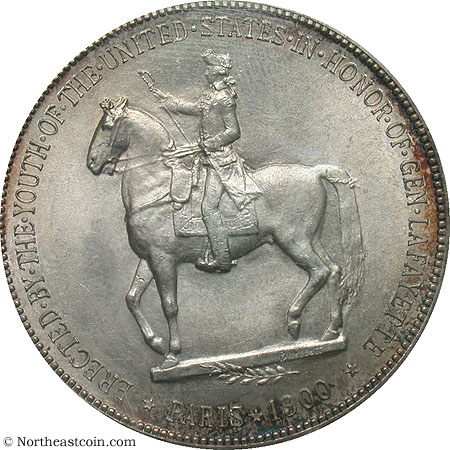
With coin collecting enjoying a growth spurt during the mid 1930s, the sale of proof coins resumed in the spring of 1936. The Philadelphia Mint, which had been vexed by the textured and uneven fields of the newer coin types introduced starting 1909, abandoned the matte proofs of that period and polished the dies to a semi-brilliant finish. The first pieces sold, however, were not as fully brilliant as the Indian Cent proofs, and collectors registered their dissatisfaction. The majority of 1936 proof cents were thus subsequently coined from dies more aggressively polished.
These early 1936 proofs actually possess greater detail, as the gentler polishing of the dies did not efface the shallower features of the design. The satiny or semi-brilliant proofs, sometimes called Type 1, are more scarce than the brilliant issues but not as popular with collectors. Fully red gems are in very short supply.


A partial collar strike is when the collar die (edge die) does not fully engage the edge of the planchet. The collar die's purpose is to engage the rim of the planchet so it doesn't spread out from the striking pressure (broad strike) and to impart edge reeding to coins like U.S. dimes, half dollars and quarters.
If a planchet is jammed and tilted in the coining chamber or the collar itself is damaged, then it strikes the wrong area of the edge, and this results in what looks like a dual rim, part of the coin to be spread out or both. Also, it can look like railroad tracks if the coin has edge reeding. This is called a railroad rim.
Most often a partial collar strike will look like a line running around half the coin's rim but more severe anomalies can occur and some will display half the reeding missing.



The following was posted by Brian.
Hey y’all. The Kay Bailey Hutchison Convention Center in Dallas, Texas was the site of the 2016 ANA National Money Show last week and with over 500 dealers in attendance, it turned out to be quite a busy show for me.
With Chris and Tom manning our booth, it was my chance to hit the floor. Now, this being the first show that I have truly worked sales, I must admit it was interesting and eye-opening for me. I got the customary “come back later” responses when offering our coins to view, but to my surprise they all actually meant it! Almost every dealer was happy to look at our wares; some quickly, some slowly, but all were impressed with the quality and diversity of our inventory (I made several sales too!) It was great to finally meet so many dealers that I previously had only spoken with on the phone. It was also nice to branch out a little and do some business with dealers that Northeast has never done business with before. I’m told it may not have been the busiest of shows overall, but I made it a point to be busy anyway and it was worth it.
Not only did I attend the show, but prior to it I was fortunate enough to take in a two-day grading seminar taught by Rod Gillis and Sam Gelberd of the ANA. Finally, the mystery of coin grades and grading was much less of a mystery (see our February 25th blog post). You might think that two 8 hour days of coin grading would be tedious, but this was a fun class! We had laughs, we had some fierce competition between the teams, and great stories were shared by students and teachers alike.
And with that, I’ll end with a quote from my seminar that I really enjoyed: “We don’t really own these rare coins; we are merely their custodians for a little while.”
Here's some of the bounty I received from my grading class...
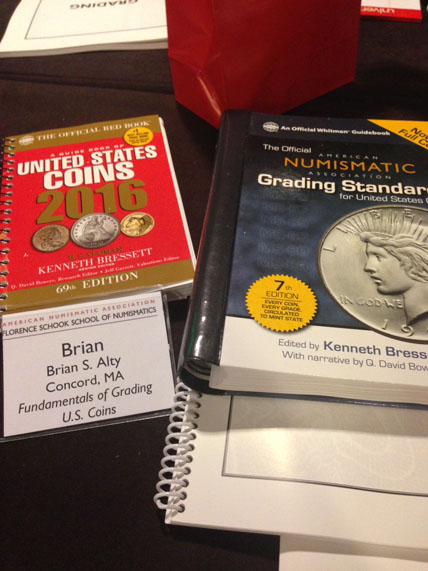
Here are some pictures I took of the impressive Dallas Cattle Drive Sculptures right by the convention center...


Racketeer Nickel
Because the first 1883 Liberty Head ‘V’ nickels did not contain the words ‘FIVE CENTS,’ and also because the coins are about the same diameter and look somewhat similar to the then-circulating $5 Liberty gold coin, some people took it upon themselves to gold-plate 1883 no-cents Liberty nickels and try to pass them off as $5 gold coins. Apparently, this was a somewhat pervasive problem at the time and the United States Mint soon added ‘FIVE CENTS’ to the reverse of the coin under the ‘V’ to ward off any further counterfeiting attempts.
There has been a story circulating for some time that a person named Josh Tatum was one of the most notorious of the Liberty nickel gold platers. It’s said he was a deaf mute who gold plated hundreds of 1883 nickels. He would go into a store to purchase items that were 5 cents or less and then pass off his gold-plated nickels to the cashier. Without saying a word, he would wait for the cashier to return his change and would usually get $4.95 in return. Eventually, he was tried in a court of law for fraud. However, the charges were dismissed because he never actually asked for change and nobody could testify against him!
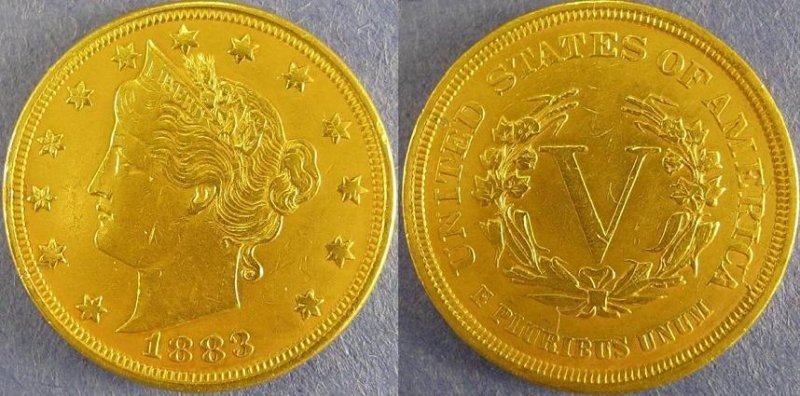
The silver center cent is an American pattern coin, one of the precursors to the large cent and an early example of a bimetallic coin. Less than a dozen specimens are known to exist today, and they generally fetch substantial prices; an uncirculated silver center cent sold at auction for $414,000 in January 2002. That price was eclipsed by an example graded PCGS MS61 offered at auction in April 2012, with a price tag of more than $1 million. It is also listed at #40 in the 100 Greatest US Coins – Fourth Edition

Hi folks. We've just launched a new feature on our website that we think you will all appreciate. As you'll see from the first image below, there is now a WATCH THIS COIN button on the coin item screen. If you see a coin you really like but want to take some time to consider buying it, or if you want to tag it just to look at it from time to time, click that button. To access your Watch List, simply login to your account and click on the Watch List tab as shown in the second image below. If you have any questions or comments about this feature, shoot an email to info@northeastcoin.com.


The following was posted by Brian.
“Is it solid for the grade?” “Does this look more like a 64 to you?” “Do you think this could CAC?” These are just some of the many questions I get quite often from our customers. And as much as I have poured myself into learning about coins for the first year and a half I’ve been with Northeast Numismatics, I’ll be the first to admit that, well, I’m just not sure…yet. While I am quite comfortable and capable discussing the visual attributes of a coin with our customers (luster, toning, mirrors, eye appeal, etc.), I currently need to refer questions pertaining to technical grading to either Tom or Chris. Grading remains a mystery to me.
For the first year or so in this business, I have asked seasoned numismatists for their recommendation on books I can read to learn about grading. I really just wanted to know how to tell an AU58 from an MS62 from an MS64 and so on and so forth. There are indeed some good resources out there for grading. But looking at pictures of a coin in a grading book can only help so much. Some of the best advice I received from a dealer was this: “Look at as many coins as possible. Just keep looking and looking and looking.” This is not unlike a poker player needing to see about a million hands before getting any good at it. Aside from this sound wisdom, the overwhelming majority of numismatists kept telling me the same thing: “Get thee to a grading class.”
And so it shall be, for I am soon off to Grading School. I’m looking forward to not only one but two grading seminars this year. First I’m off to Dallas in early March for a two-day intensive grading seminar taught by Rod Gillis and Sam Gelberd from the ANA. I will then be attending a week-long session at the ANA Summer Seminar in Colorado Springs.
I’m extremely excited for this next chapter in my short numismatic life! But unlike the end of a great book, I’m looking for this grading mystery to end. I’ll be sure to fill you in on the next chapter soon.
Oh and I almost forgot…“Do you think this would CAC?” Well, some mysteries were never meant to be solved…
Battle Creek Collection of Morgan Dollars
The coins of the Battle Creek Collection resided in ten $1,000 bags. Until March 1964, it was possible to redeem silver certificates with US silver dollar coins, and many collectors thus acquired original bags of Morgan dollars. The Battle Creek Collection bags were tagged with both original Philadelphia Mint tags and seals dated 1885 (2 bags), 1886 (2 bags), or 1887 (6 bags). Additionally, each had a supplementary tag from the Detroit Branch of the Chicago Federal Reserve bearing dates in the 1920's.
The bags had resided in the estate of a collector, and upon his passing his executor invited several coin dealers to make purchase offers on the group. The bags were sewn sealed, and dealers present were required to bid "blind," meaning they could not examine the coins prior to purchase. The bags were slit in their presence to prove that they did, in fact, contain silver dollars.
Here is one we just sold…
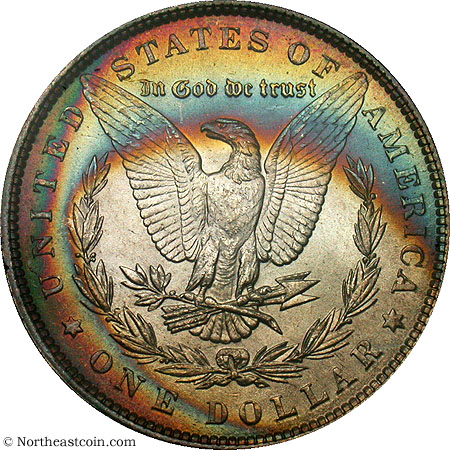
Battle Creek Collection Mint Bag tie:

This seal secured the contents of a Philadelphia Mint bag of 1886 Morgan dollars, many of which now reside in the Battle Creek Collection.
When speaking to the House of Representatives in November 1792, President Washington mentioned the "want of small coins in circulation" and stated that he had begun work on establishing a U.S. Mint and that some half dismes had been produced already. At this point, most of the personnel had been hired, but the Mint's buildings and machinery were not yet ready. As a result, the half dismes, which had been struck in or around July 1792, were produced using the private facilities of local craftsman John Harper, although under the auspices of official Mint personnel. In his personal log book, Secretary of State Thomas Jefferson recorded the receipt of 1,500 specimens on July 13.
Because of President Washington's connection with these early coins, numismatic folklore holds that the portrait on the obverse is that of First Lady Martha Washington and that some of the coins were struck using melted-down silverware from the Washington household. However, there is no solid evidence for either of these assertions.
Collectors sometimes have trouble pronouncing the word disme. Is it ‘diz-mee’? Is it ‘dime’ like we pronounce it today? Actually, it is neither. Disme is a French word pronounced “deem”.
Shown below is the finest known example, graded MS68 by NGC.

And here (below) is a 1792 Half Disme that we currently have in our office. It's part of a large estate that we are in the midst of appraising.
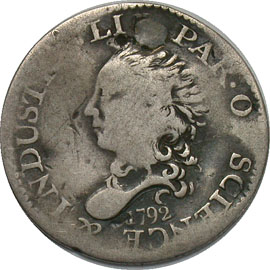

The Washington quarter is the present quarter dollar or 25-cent piece issued by the United States Mint. The coin was first struck in 1932; the original version was designed by sculptor John Flanagan.
As the United States prepared to celebrate the 1932 bicentennial of the birth of its first president, George Washington, members of the bicentennial committee established by Congress sought a Washington half dollar. They wanted to displace for that year only the regular issue Walking Liberty half dollar; instead Congress permanently replaced the Standing Liberty quarter, requiring that a depiction of Washington appear on the obverse of the new coin. The committee had engaged sculptor Laura Gardin Fraser to design a commemorative medal, and wanted her to adapt her design for the quarter. Although Fraser's work was supported by the Commission of Fine Arts and its chairman, Charles W. Moore, Treasury Secretary Andrew W. Mellon chose a design by Flanagan, and Mellon's successor, Ogden L. Mills, refused to disturb the decision.
The new silver quarters entered circulation on August 1, 1932; and continued to be struck in silver until the Mint transitioned to copper-nickel clad coinage in 1965. A special reverse commemorating the United States Bicentennial was used in 1975 and 1976, with all pieces bearing the double date 1776–1976; there are no 1975-dated quarters. Since 1999, the original eagle reverse has not been used; instead that side of the quarter has commemorated the 50 states, the nation's other jurisdictions, and National Park Service sites—the last as part of the America the Beautiful Quarters series, which will continue until 2021. The bust of Washington was made smaller beginning in 1999; in 2010 it was restored to bring out greater detail.


When the Lincoln one-cent coin made its initial appearance in 1909, it marked a radical departure from the accepted styling of United States coins, introducing as it did for the first time a portrait coin in the regular series. A strong feeling had prevailed against using portraits on U.S. coins, but public sentiment stemming from the 100th anniversary celebration of Abraham Lincoln's birth proved stronger than the long-standing prejudice.
For much more on the subject… www.treasury.gov/about/education/Pages/lincoln-cent.aspx
“Things may come to those who wait, but only the things left by those who hustle”


The New Orleans Mint operated in New Orleans, Louisiana, as a branch mint of the United States Mint from 1838 to 1861 and from 1879 to 1909. Coins minted in New Orleans have the ‘O’ mint mark. During its years of operation, it produced over 427 million gold and silver coins of nearly every American denomination, with a total face value of over US$ 307 million.[3] It was closed during most of the American Civil War and Reconstruction. After it was decommissioned as a mint, the building has served a variety of purposes, including as an assay office, a United States Coast Guard storage facility, and a fallout shelter. Since 1981 it has served as a branch of the Louisiana State Museum. Damaged by Hurricane Katrina in 2005, after over two years of repairs and renovations, the museum reopened in October 2007.
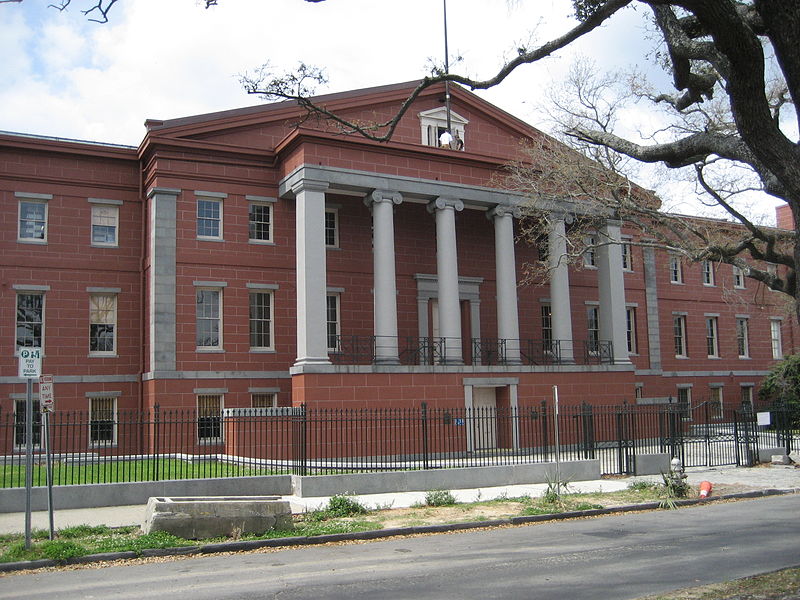

Margie took some pictures at the Long Beach Expo last week.
Here's Tom somewhat inundated with new purchases:
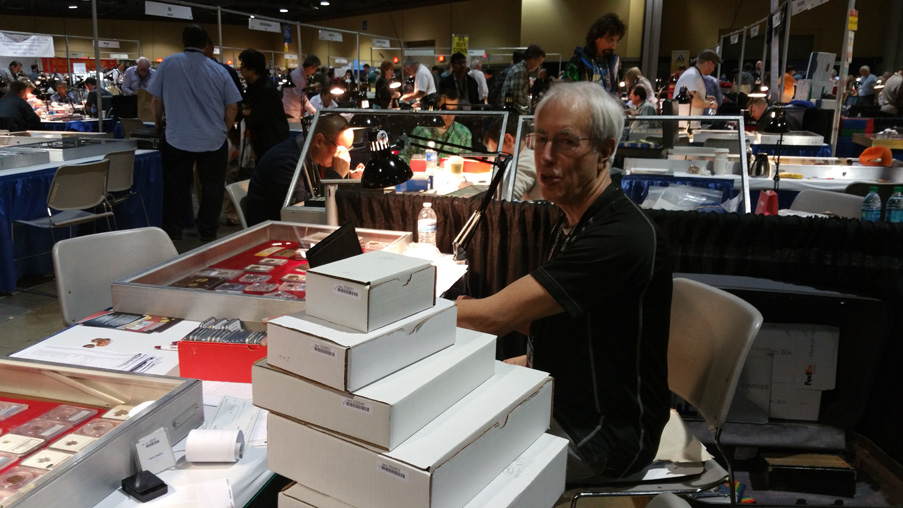
As you can see, Tom brings his organizational skills to the coin shows (see our December 22nd blog post):



We ordered a King Cake from Paul's Pastry in Picayune, Mississippi. (Picayune happens to be where Chris went to high school.) Yummy!
In honor of the holiday today, here's a numismatically related Mardi Gras item:
A So-Called-Dollar (HK-626) struck in 1892, Augusta GA.
Here are the details…
Obv. Crowned male head facing l.; to l. Augusta, Ga.; to r. Jan. 1892; above bust, around Carnival & Mardi Gras; below King Cotton; beaded border.
Rev. Jester or clown doing jig or dance (it looks like a jig to me); in r. background is group of tunic-clad soldiers holding shields and long upright lances; in l. background is two-horse chariot carrying two men, one holding high a banner; above all Souvenir of Our Carnival; beaded border.

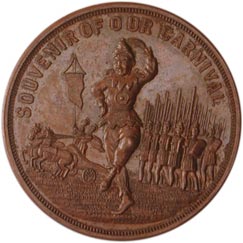
Yesterday Brian was wondering what the difference was between semissis and tremissis was…and so here it is…
The Byzantine Gold Solidus is a coin from the ancient Byzantine Empire. The word Solidus is a Latin word meaning 'solid'. The plural of Solidus is Solidi (from which the phrase ‘do me a solid’ was perhaps born). Solidus was introduced by the great emperor Constantine in 309-310. The coin was produced and used through the whole Empire of Byzantine. The Solidus is a solid and pure gold coin with high purchasing power. These coins were usually marked as wealth and were never used by the common citizens. Solidi were primarily used to make military payments. During the campaigns against the 'Vandals' the Solidi were paid to the Roman soldiers to arrange for transport and house.
The term 'Soldier' derived from the Solidus, to describe the persons who were paid by Solidi. The coins introduced by Constantine had a value of 1/72 of a Roman pound that comes around to 4.5 grams. The thickness of the coin was less than aureus.
The Solidus was produced in two forms, 'semissis' and 'tremissis'. The half Solidi were known as 'semissis' and one third Solidi were known as 'tremissis'.
The Constantine coinage collapsed during the barbarian invasions in the early 5th century. By the time of Anastasius in 491, only the solidus, semissus (1/2 solidus) and tremissis (1/3 solidus), and a tiny copper coin called the nummus (1/7200 of solidus) had survived. In 498, Anastasius introduced a series of multiples of the nummus. The most important of these is the follis (worth 40 nummi). The follis was used extensively for the next 6 centuries and its creation is considered a good starting point for the history of Byzantine coinage.
Northeast Numismatics is pleased to offer both semissis and tremissis on a regular basis should you be interested.
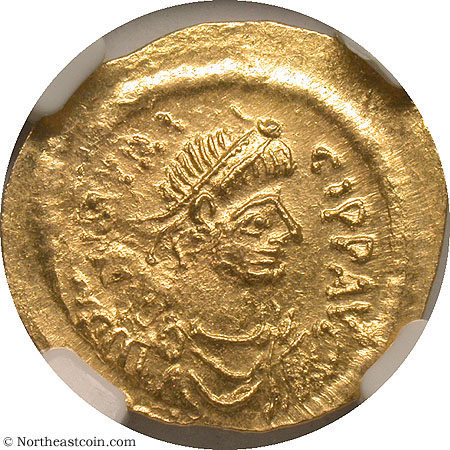
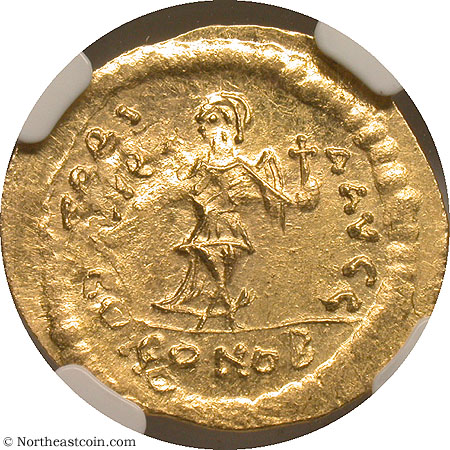
The 1804 Silver Dollar is one of the rarest and most popular of all American coins, despite the fact that none were made until 1834 and several were even made many years after that. Mint reports from 1804 show a delivery figure of 19,570 Silver Dollars, but numismatists believe these were all leftover coins dated 1803. Certain qualities of the known 1804 Silver Dollars (and other facts concerning their history) indicate that the first 1804 Silver Dollars were struck in or about 1834, when orders came from the State Department for special sets of coins to be struck for diplomatic purposes. Later restrikes were made sometime after 1857 (a unique example shows the undertype of an 1857 Swiss Shooting Thaler!).
It is also currently #1 in the 4th Edition of 100 Greatest US Coins.
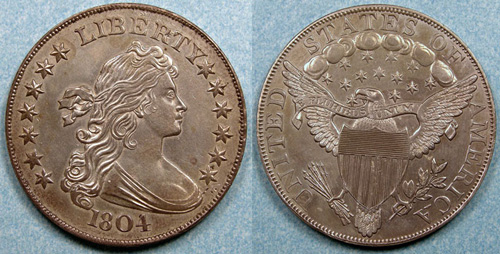
Lapping is one of several names, including die polishing and die filing, for the fine abrading used to finish a die when it is first produced or, more frequently, repaired. At the time of production, a die usually has some inherent flaws from nicks and scratches to swelling and cracks. The tiny flaws, like a random scratch in the dies, may usually be corrected by minor polishing with a fine grain abrasive such as steel wool or emery. The fine markings etched on the die by the abrasive are called “die finish lines” or “lapping lines,” though usually “die finish” refers to a finer grain than “lapping lines,” which are more likely caused by a file or something of heavier grain. The abrasives may also be used to smooth out rust or damage on a well-used die, or to smooth over a small crack. Occasionally, dies will be “lapped,” thus effacing details, and re-engraved or repunched. Misplaced dates and the like show only light remnants of the errantly placed punch because most details were simply “lapped” away. This term is most often used in reference to mid 19th-century coinage it seems, though you can undoubtedly see fine lines of “die polish” or “die finish” on coins in your pocket change.

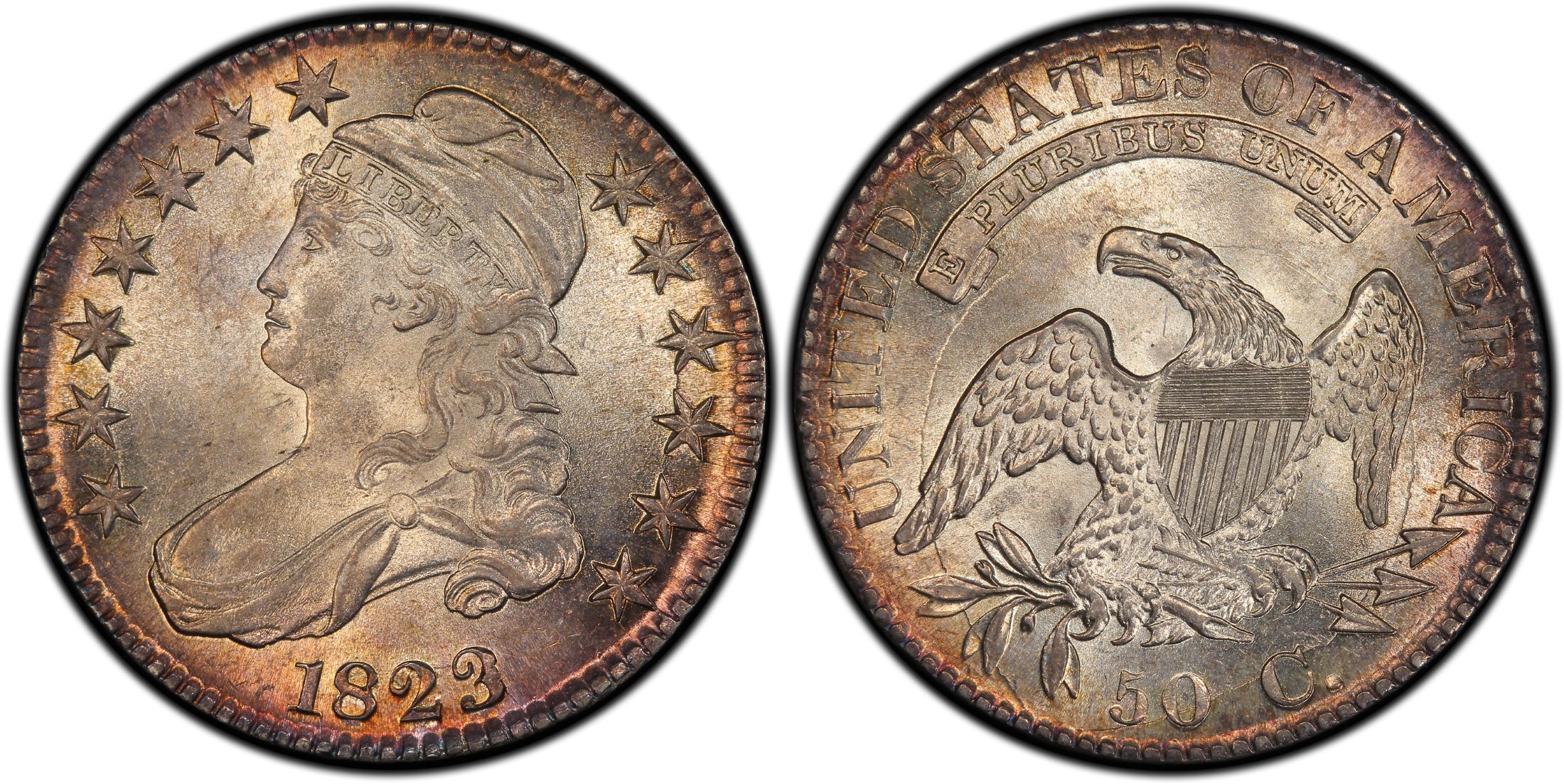
The so-called "Booby Head" of 1839 is a modification of the bust of Liberty that shows one of her hair strands curling around the truncation of the bust. In real life, this is anatomically impossible and it is doubtful that a sculptor would add such an unusual feature to a physical bust. The nickname was first applied by Dr. Montroville Dickeson in 1859, then standardized in 1868 by Ebenezer Locke Mason, Jr. It has been in use ever since and is one of the more distinctive varieties in the Matron Head series of Large Cents.

The following was posted by Margie Sheaffer. Margie has been working coin shows for Northeast for the past several years.
I have always been a “Glass Half Empty” sort of person. It especially rears its ugly head whenever I fly the not-so-friendly skies. To my delight, it looked like my first flight in 2016, to the 61st FUN convention in Tampa, WOULD be a friendly experience. First of all, I boasted a record driving time to Philadelphia airport from my home – just 70 minutes! Secondly, I got through the security line in less than five minutes. And lastly, I boarded the plane so quickly it made my head spin.
I never make New Years resolutions; however, this year I made an exception. I vowed to read more, write more and most importantly, chill out more. This was to be the first time in four years that I did not bring my Kindle on a plane trip. Plus, Tom and Chris would be glad that I was determined to chill out. When Tom suggested that I memorialize some of this year’s F.U.N. experience, I knew that my resolution to write more was a good decision.
Oops… I spoke too soon about my Tremendous Travel experience. At 8:30 am as I sat on the plane that was to have departed at 7:55 a.m., the co-pilot comes on the intercom declaring “The gas tank is leaking and we are not sure how long it will take to repair”. So I declared to myself on the inside: “Please chill out, please chill out, please chill out. Perfect weather…check. First flight out…check. No problems with security…check. No traffic driving to airport…check.” I then declared to the passengers next to me “I rarely fly anywhere that I don’t have at least a one hour delay,” to which a woman next to me declared “Please give me your phone number. I want to make sure I never fly on the same plane you’re on.”
As we finally departed for Tampa at 10:00 am, I closed my eyes and in an A-PLUS chilling mode I asked myself if I ever thought, at my long-in-the-tooth age, that I would be having the time of my life working for and with Tom of Northeast Numismatics. I’ve known Tom for over 35 years. I met him in the 1970’s while working for a Beverly Hills coin dealer. His dry sense of humor has always kept me on my toes. That is why I like to use the chat acronym LAHW when defining my time at Northeast. No, it’s not Let’s Always Have Worries (which could fit my MO). LAHW stands for Laughs and Hard Work.
Within an hour of the convention opening to the public on Thursday, the 7th, the bourse room was so full of activity and the aisles were so crowded, I was tempted to ask Tom for a Segway to steer my way around the floor. I could have maneuvered around the convention space like Paul Blart Mall Cop.
At home I’m lucky if I log in 1,000 steps per day on my pedometer. During the week of F.U.N. I recorded over 14,000 steps per day visiting with and doing business with many coin dealers. With over 600 dealers set up and anxious to do business, I was quite busy showing coins to as many people as possible.
We had a pretty good amount of traffic at our table. I met some interesting, as well as eccentric, collectors that came to our table to introduce themselves, look at (and sometimes buy!) our coins and to compliment Chris on our website. It was a pleasure to see new faces at our bourse table.
Saturday afternoon I departed the bourse floor to catch a ride to Tampa International Airport to start my trip home. There have been conventions in the past that I am ready to catch that plane to Philadelphia. At times I have left a little earlier than I needed to. (Shh…don’t let Tom and Chris know this.) The 2016 F.U.N. show was great upbeat show and was not one of those shows that I was ready to sneak out of early!!!
If the quantity of retail and wholesale business done during the F.U.N. show is any indication of the business that will be done for the rest of the year, then 2016 should prove to be a great year for dealers and collectors alike!


1823 Capped Bust Half Dollars : Patched 3
This variety of the 1823 Capped Bust Half Dollar features the "Patched 3" in the date. The broken 3 was repaired with a patch placed in the middle of the "3". This resulted in a blunt punch bump that filled in the center gap on the outside (right side) of the "3" - to connect the two broken parts.

The difference between the normal 3 vs broken 3 vs patched 3 vs ugly 3 vs tampered 3 is depicted below in the example comparison image of all 5 major varieties:

We typically do not remove coins from their holders and resubmit them to the grading services in an attempt to maximize a grade on a coin. (Folks who specialize in this are known as crack out artists.) Recently, however, we had a major crack out session. We acquired a complete 144 coin silver commemorative set graded by ANACS, with nearly all of the coins in old white holders. The set was purchased from a dealer who years ago dealt primarily in ANACS coins back when this grading service enjoyed more popularity.
For a short while we attempted to sell the commems in their ANACS holders as a single set, but it generated little interest. You can see from the mounds of plastic in the pictures below what our next course of action was. Russell from our office bought a drill press vice and went to work on the set. He then wrote all the coins up on several submission forms and sent them off to NGC.
Stay tuned, as we will have an abundance of freshly graded commems available in the near future!
The following was posted by Carol McCarthy, Tom’s sister-in-law from Florida who occasionally works the F.U.N. show with us.
While working for Northeast during the show this past week, I had a great time. F.U.N. moved to Tampa this year to a beautiful location overlooking the Gulf of Mexico. Hotels, restaurants and parking were easily accessible.
The show was well attended by both dealers and collectors. It was an extremely busy show for us. Collectors were seeking us out to find a rare piece they needed. More than once I heard “If anyone is going to have what I need it will be you guys. You have stuff you just don’t see anywhere else.” This was great for me (for I only work at the F.U.N. show), because I got introduced to some coins I found fascinating. I held in my hand an Alexander the Great gold coin dated 336-323 BC! Just think of the stories that coin could tell.
Many people from all over the country and the world attended. We at Northeast were happy to meet some of our longtime customers face to face. It’s always nice to put a face with a name and a collection. Thank you to all who stopped by!
The organizers of the show did a great job in holding workshops, seminars and exhibits for all to enjoy. Overall, the show was a pleasure and truly lived up to its name…F.U.N!
We've just added a new feature to our website which allows you to share a coin of interest with a friend. When viewing an image of a coin, simply click the TELL A FRIEND button and enter in your friend's email address and any comments you might have. We'll then email your comments and a link to the coin to whomever you choose.

Lincoln cents made from 1909 to 1958 were designed by Victor D. Brenner. His initials V.D.B. were on a limited quantity of the 1909 cent making it one of the most sought after 20th century coins.
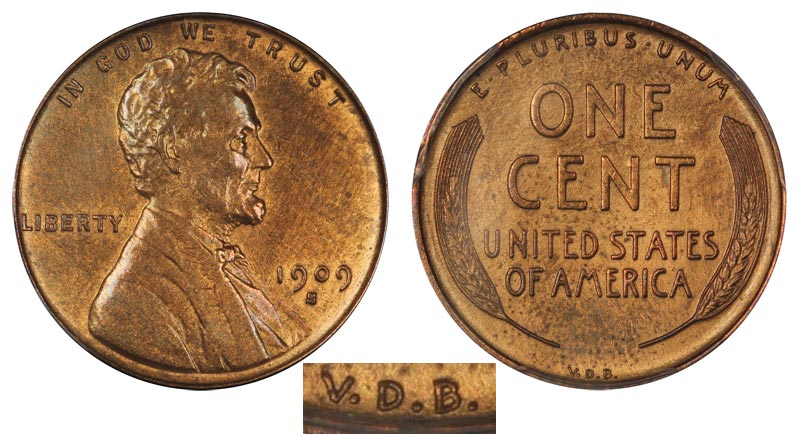
Bar Cent –
A token that was struck in this country shortly after the War of Independence, it is so called because it carries a series of bars on the reverse side. On the obverse of the coin is the lettering "U.S.A." in script, without any further design or date.
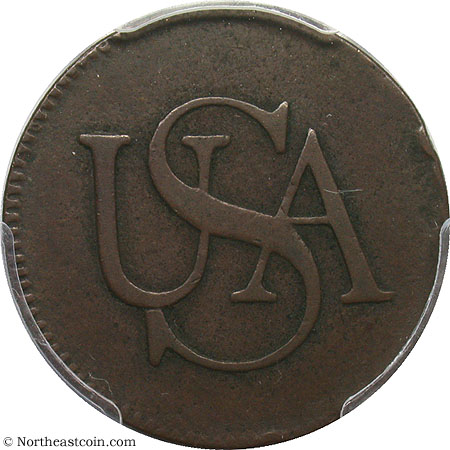
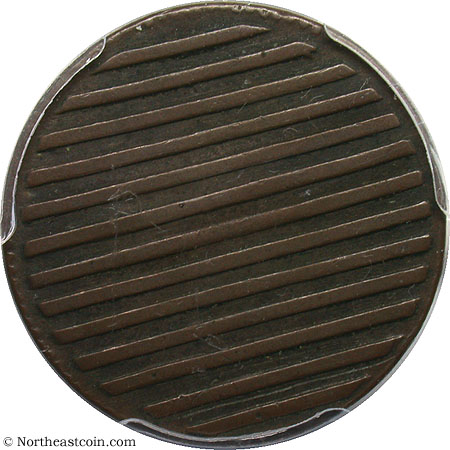
A common joke (and truth) in the industry is how much coin dealers like to eat. We are no exception. Here at Northeast we enjoy a monthly free lunch day courtesy of Tom. Each month a different employee gets to pick the location we eat. This month Christy, our shipping manager, picked Indian food from Monsoon in Acton, MA (www.monsoonbistro.com). If Chris looks perplexed in the photo below, it's because he is perplexed. Not a connoisseur of Indian food, Chris was completely clueless as to what he actually ordered and is opening one of the cups of food with much trepidation.
We also recently had our company Christmas party at arguably one of the finest restaurants in MetroWest Boston. You'll find a photo below of everyone from the company including Tom's wife, Nancy, enjoying a wonderful meal at 80 Thoreau here in Concord (www.80thoreau.com). Great food and great company.


Don’t ever let it be said that Tom Caldwell isn’t a stand up kind of guy. We are not talking just about Tom being a man of his word, but also about the merits of working at a stand up desk. A couple of years ago Tom heard about the advantages of standing rather than sitting. Studies have clearly shown there are health benefits of sitting less. Among these benefits are decreases in obesity as well as a decrease in the risks of cardiovascular disease, some types of cancer, and diabetes. After learning this, Tom ordered a stand up desk in early 2014 and has not looked back.
It is a fact that most office workers spend close to six hours a day sitting at their desks. Coin dealers are no exception, whether it’s in the office or at a coin show. Many office workers today get the majority of their exercise during the work day going outside for a smoke break, taking bathroom breaks, or going to the lunch room. Tom has always been fairly active, whether it’s biking, swimming, or running. But as a professional numismatist, it can be quite a challenge not only maintaining any sort of exercise regimen but also avoiding sitting on your butt all day.
This changed when Tom’s new stand up desk arrived. He now spends no more than two to three hours during the work day sitting, and that’s only when it’s absolutely necessary. Meeting with clients, figuring deals, grading, and other similar tasks certainly require at least some chair time.
Against his staff’s objections, an image has been posted of Tom’s office including his stand up desk. He insists there is organization in the chaos that you see. Actually, one additional benefit to a stand up desk is now Tom can use his chair for storage. If you have any questions for Tom about his stand up desk experience (or about his organizational skills), he can be reached at tom@northeastcoin.com.


Any defect of a coin which was caused by the planchet being imperfect prior to the coin being struck.

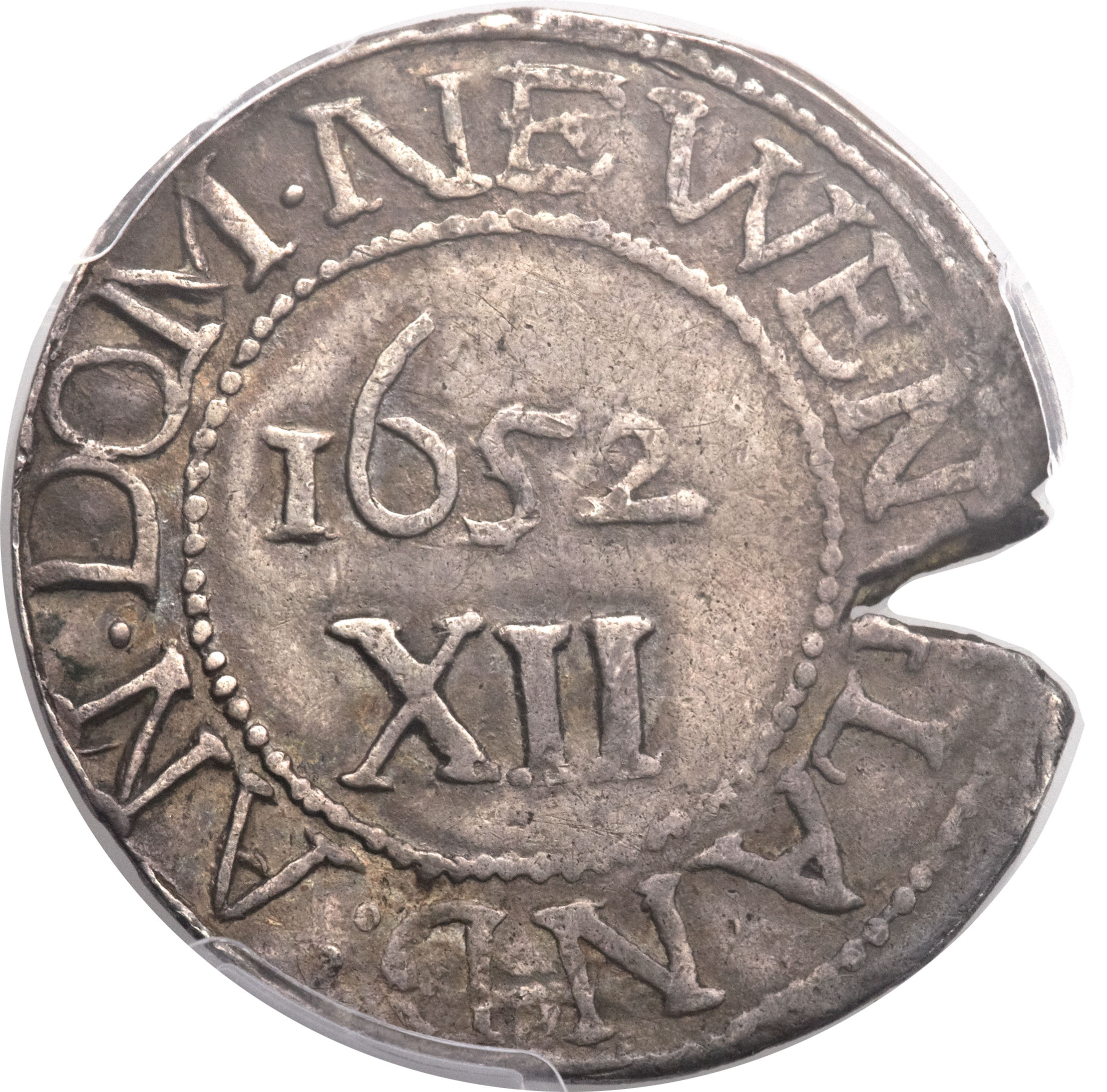
Hi folks. We recently sent out an email announcing a holiday promotion. For those that did not receive the email, please read on. If you'd like to be added to our email list, please go to www.northeastcoin.com/mailinglist.jsp.
We are pleased to be offering this exciting holiday promotion. Between now and the end of the year, spend $500 or more on an order at Northeastcoin.com and receive a $50 gift certificate to spend on a future order. Spread the holiday cheer and savings by giving this as a gift to your favorite coin collector. (Even if that's you!) Just use the promo code HOLIDAY during the online checkout process. We don't mean to be Grinches, but there are of course some terms, so please read them below.
Whatever holiday you may be celebrating this season, we hope it's a joyful one for you and your family. We also extend our best wishes for a Happy New Year!
Terms: The promo code HOLIDAY must be used at the time of the order. It may not be used on previously placed orders. HOLIDAY may only be used once and is limited to one per household. The $50 gift certificate promotion ends December 31st.
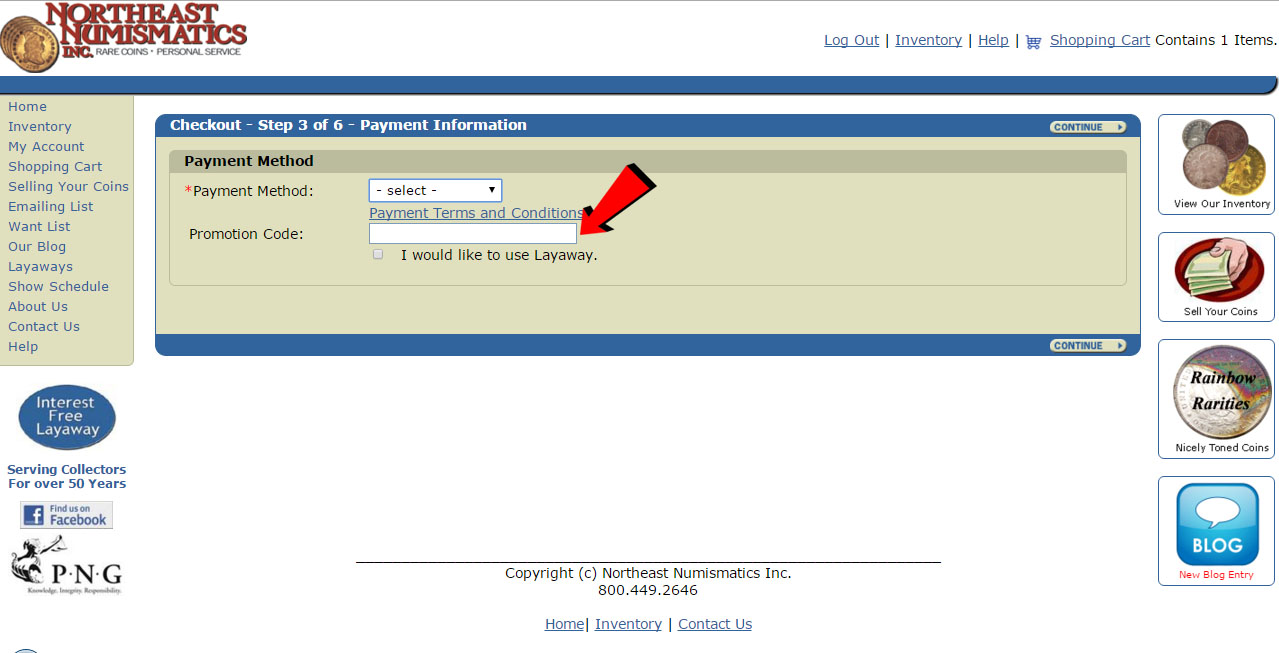
1849 $5 Mormon Five Dollar. Beginning on September 28, 1848, returning Mexican War veterans began showing up at Salt Lake City with gold they had mined on the American River in California on their journey home. The gold dust was most welcome in the Mormon community, as virtually no hard currency was available in the region at that time. However, problems with inaccurate weighing and loss made gold dust less than ideal as a medium of exchange. A mint was soon established in Salt Lake City, under the authority of the Mormon Church. Dies were forged by blacksmith John Mobourn Kay and the first gold deposit was made on December 10, 1848. By 1849, the Mormon coinage program was in full swing, with coins issued in two and a half, five, ten, and twenty dollar denominations. The coins were readily accepted in the Mormon community, but outside assays found them underweight and of improper fineness, so they were only accepted at a steep discount outside the Salt Lake Valley. All the Mormon issues are scarce-to-rare today.


Fasces is a bound bundle of wooden rods, sometimes including an axe with its blade emerging. The fasces had its origin in the Etruscan civilization, and was passed on to ancient Rome, where it symbolized a magistrate's power and jurisdiction. The image has survived in the modern world as a representation of magisterial or collective power. The fasces frequently occurs as a charge in heraldry, it is present on an older design of the United States ten cent coin
The Mercury Dime's reverse depicts a fasces, symbolizing unity and strength, and an olive branch, signifying peace.
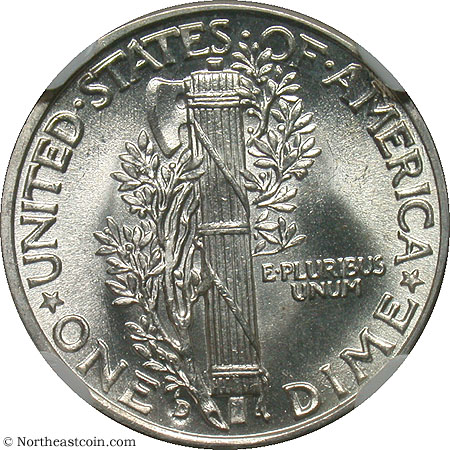
From NGC's website: Numismatic Guaranty Corporation (NGC) has adopted a convention for the certification of shipwreck coinage. This is the SHIPWRECK EFFECT designation. Exposure to saltwater has an irreversible effect on the surface condition of immersed coins, and in most cases this prohibits NGC from rendering a precise assessment of a coin’s condition.
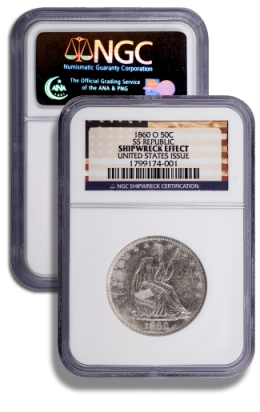
Coloring acquired from the bag while a coin was stored. Cloth coin bags contained sulfur and other metal-reactive chemicals. When stored in bags for extended periods, coins in close proximity to the cloth often acquire beautiful red, yellow, blue and other vibrant colors. Sometimes the weave of the cloth is visible in the toning. Some coins have crescent-shaped toning because another coin was covering part of the surface, thus preventing toning. Bag toning is seen most often on Morgan silver dollars.

Anyone see this yet?

Not to take away from Brock Osweiler's performance; the guy straight up owned the Patriots in the fourth quarter. But the choice by SI to choose a photo with a potential (i.e. probable) missed call in the background is curious.
Fresh coins going out for grading. We'll list 'em when they come back!
.jpg )
Polyvinyl Chloride is a somewhat active chemical found in some types of plastic coin flips. PVC will cause some coins to tone or turn green over time. The effect is often removable from silver coins, but PVC has been known to wreak havoc on copper, and to a lesser extent nickel coins, especially if the coins have been stored in warm or damp places over long periods of time.

Non-circulating legal tender. These coins are issued in "limited editions" for collectors, and sold for far more than their face value. While these coins are technically legal tender, their bullion value usually far exceeds their face value.

Coin of exceptionally high condition, such as Gem Uncirculated or Gem Proof. Gem coins have grades of 65 and higher. The term Superb Gem is often used to describe coins with grades of 67 and higher.
We'd like to wish you and your families a very Happy Thanksgiving! Our office will be closed Thursday and Friday and will reopen on Monday, the 30th.

Some of you are probably familiar with the popular Chuck Norris jokes. Ones like these:
Chuck Norris sleeps with a pillow under his gun.
or
Chuck Norris was an only child...eventually.
Well, one evening after work a few of us here met for Mai Tais at the Chinese restaurant below our office. We began scratching out some coin-related Chuck Norris jokes. Easy to do after a potent Mai Tai. For those who appreciate the regular Chuck Norris jokes, I invite you to read on and add any that you can come up with.
*Chuck Norris' coins consistently grade MS71.
*All of Chuck Norris' coins come back from CAC with a platinum sticker.
*Chuck Norris doesn't submit to PCGS or NGC. They submit to him.
*Chuck Norris made the Seated Liberty stand up.
*The Sheldon Scale is being changed to suit Chuck Norris. Gem coins are no longer MS65; they are CS65, or Chuck State 65.
*If Chuck Norris doesn't get the grades he wants, it's the graders who end up in the body bags, not the coins.
*Poorly struck coins are actually just coins that Chuck Norris squeezed too tightly.
*The Greysheet Ask price is irrelevant to Chuck Norris because Chuck Norris never asks for anything.
*Chuck Norris achieved the number one Registry Set ranking for Morgan Dollars even though he's never bought a Morgan Dollar in his life.
*Chuck Norris cracks out coins barehanded...with one hand.
*PCGS blackout dates to not apply to Chuck Norris.
There is no explanation for this.


A system of grading which was originally introduced by the late Dr. William H. Sheldon, for the purpose of grading large cents. The system was adapted to all coins in the early 1970's. The Sheldon Scale, as used today, incorporates numerical grades I through 70 to correspond with various descriptive grades as follows:
Poor-1
Fair-2
Almost Good-3
Good-4,6
Very Good-8, 10
Fine-12,15
Very Fine-20,25,30,35
Extremely Fine-40,45
Almost Uncirculated-50, 53, 55, 58
Mint State- 60, 61, 62, 63, 64, 65, 66, 67, 68, 69, 70
We are currently set up at the Sunday Westford coin show. A popular attraction for the kids that attend is the free handful of coins they get from the treasure chest at our table. Take a look!
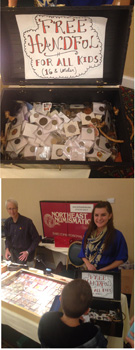
It's been years in the works (not due to technical issues, but rather proscrastination issues), but our blog is finally here. There will be educational posts such as the FYI posts below, coin show reports (some of them live from a coin show), market updates, funny stories, promotions only available to our blog readers, and much more. Please check back often!
We've got another small batch of grading going out today to one of the grading services. Stay tuned!

It’s Superbird!
In 1952, a proof Washington Quarter was produced containing a letter "S" on the eagle's chest on the reverse side of the coin. After its discovery, collectors quickly referred to it as the Superbird Quarter, comparing it to the Superman hero character. In the 1950s, the Superman TV show was so extremely popular that some experts believe that a Mint employee intentionally added the "S' mint mark on the eagle's chest as a way of supporting the Superman show. It's now been over 50 years since its discovery and no further information has developed on how this variety occurred, and more than likely we will just never know. But one thing is for certain - this is a very interesting variety.
The lower die, usually the reverse – although on some issues with striking problems, the obverse was employed as the lower die. Because of the physics of minting, the fixed lower-die impression is slightly better struck than the upper-die impression.








